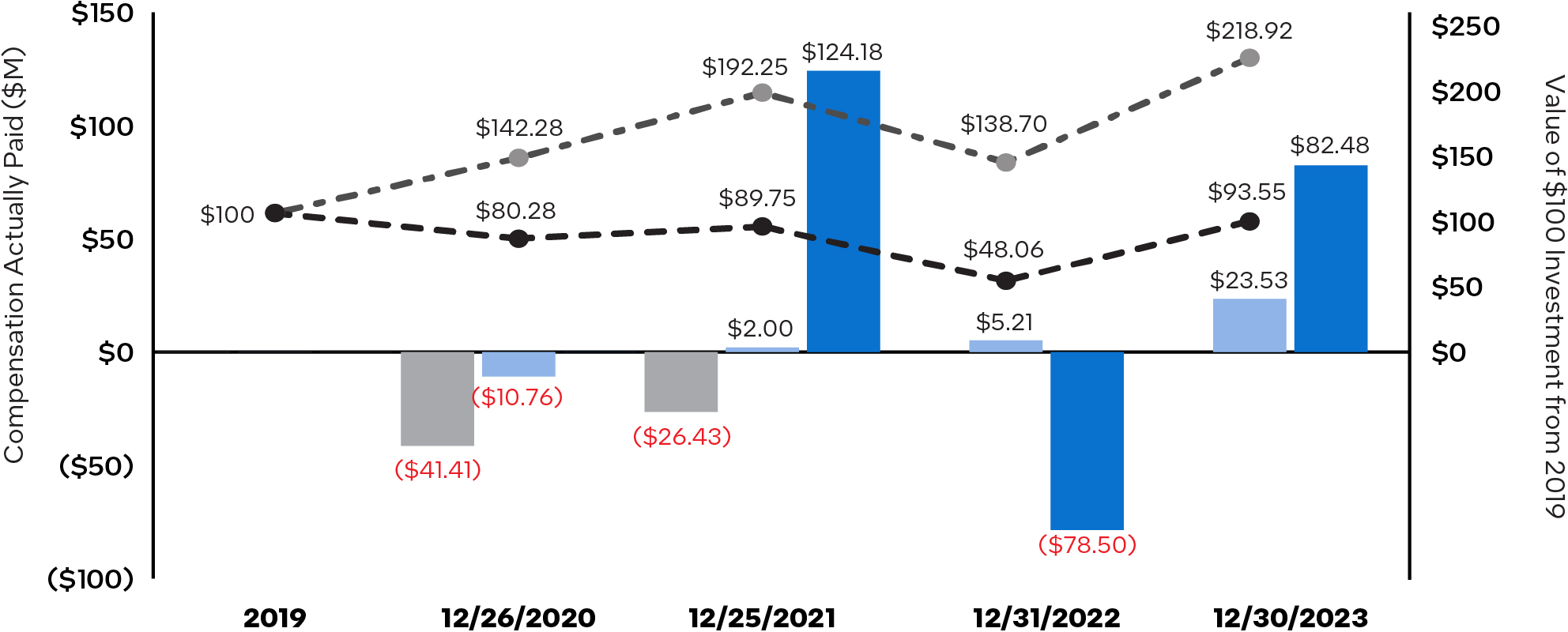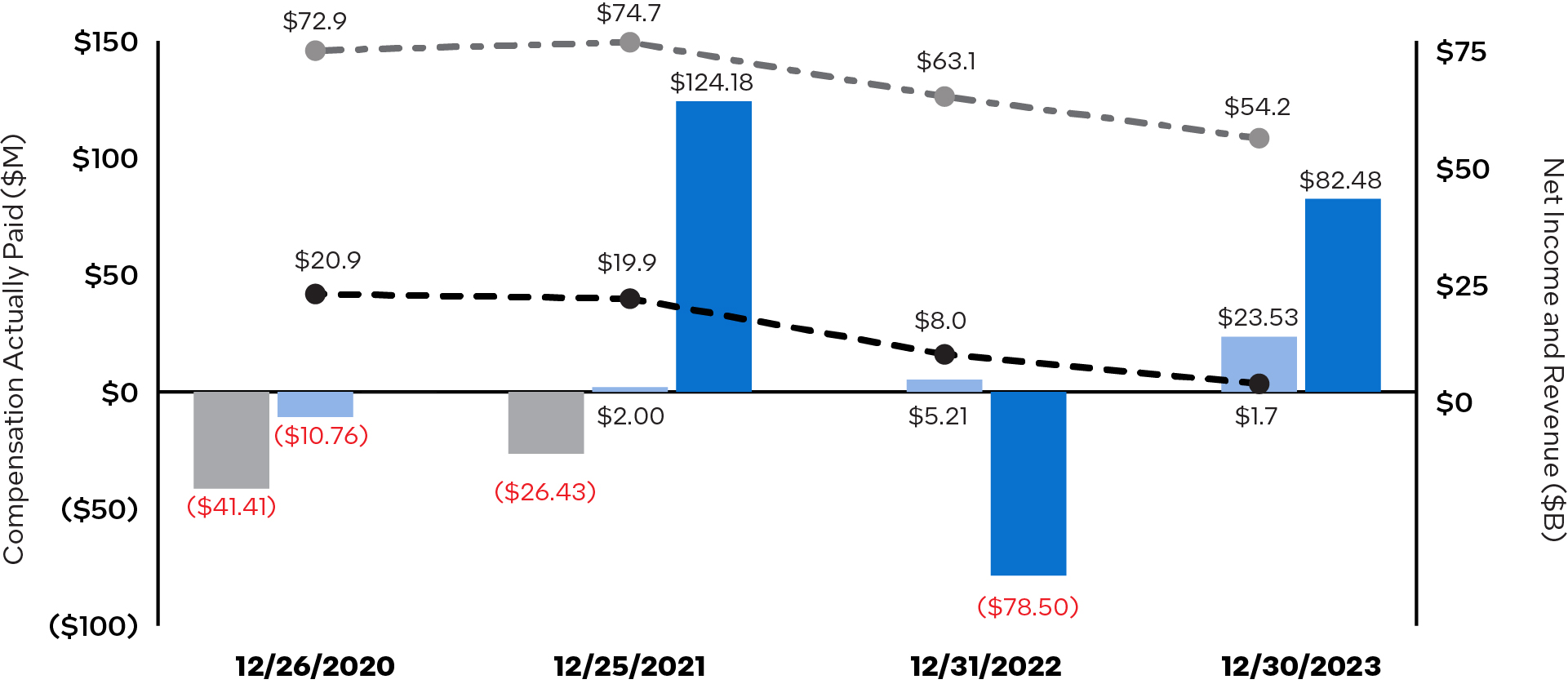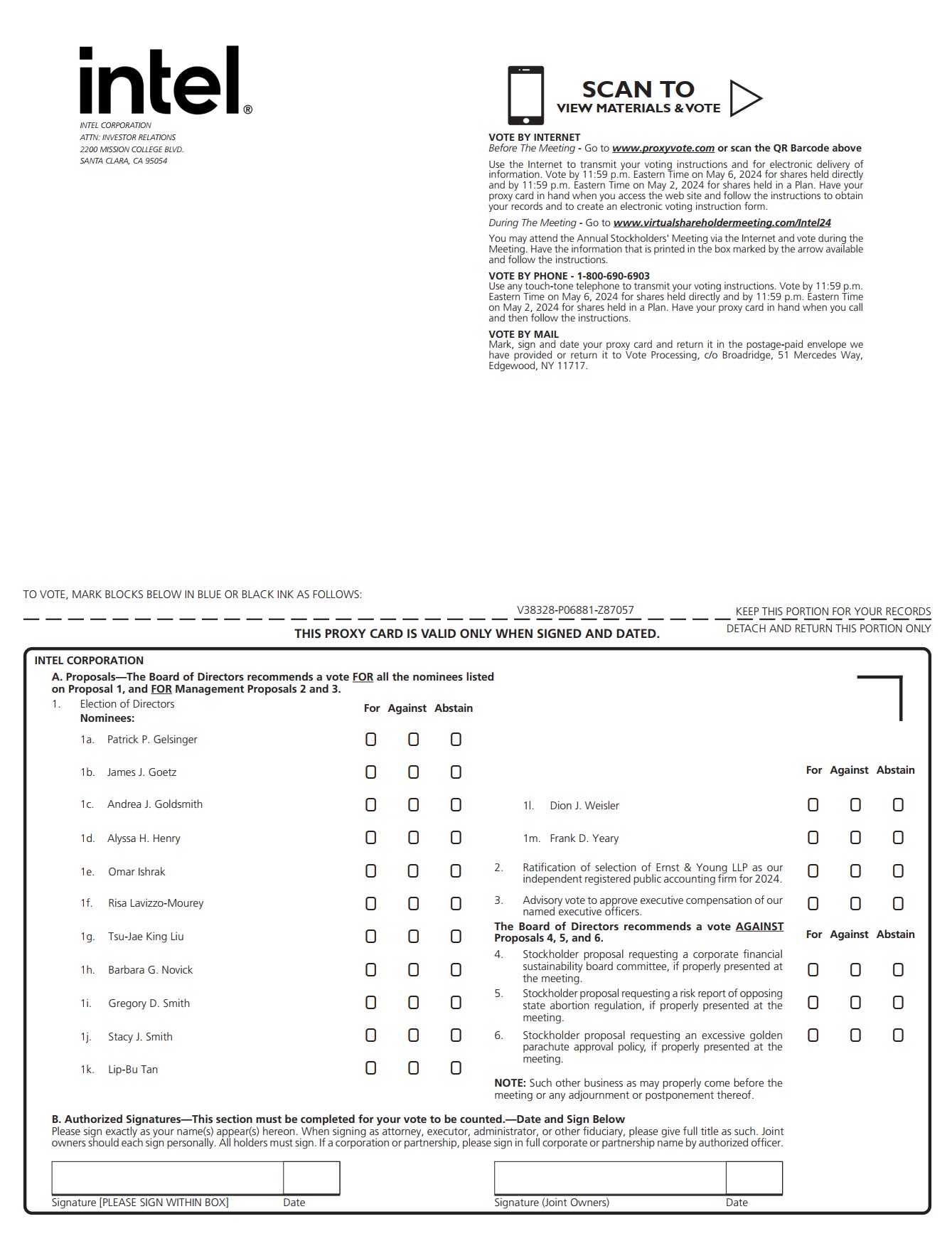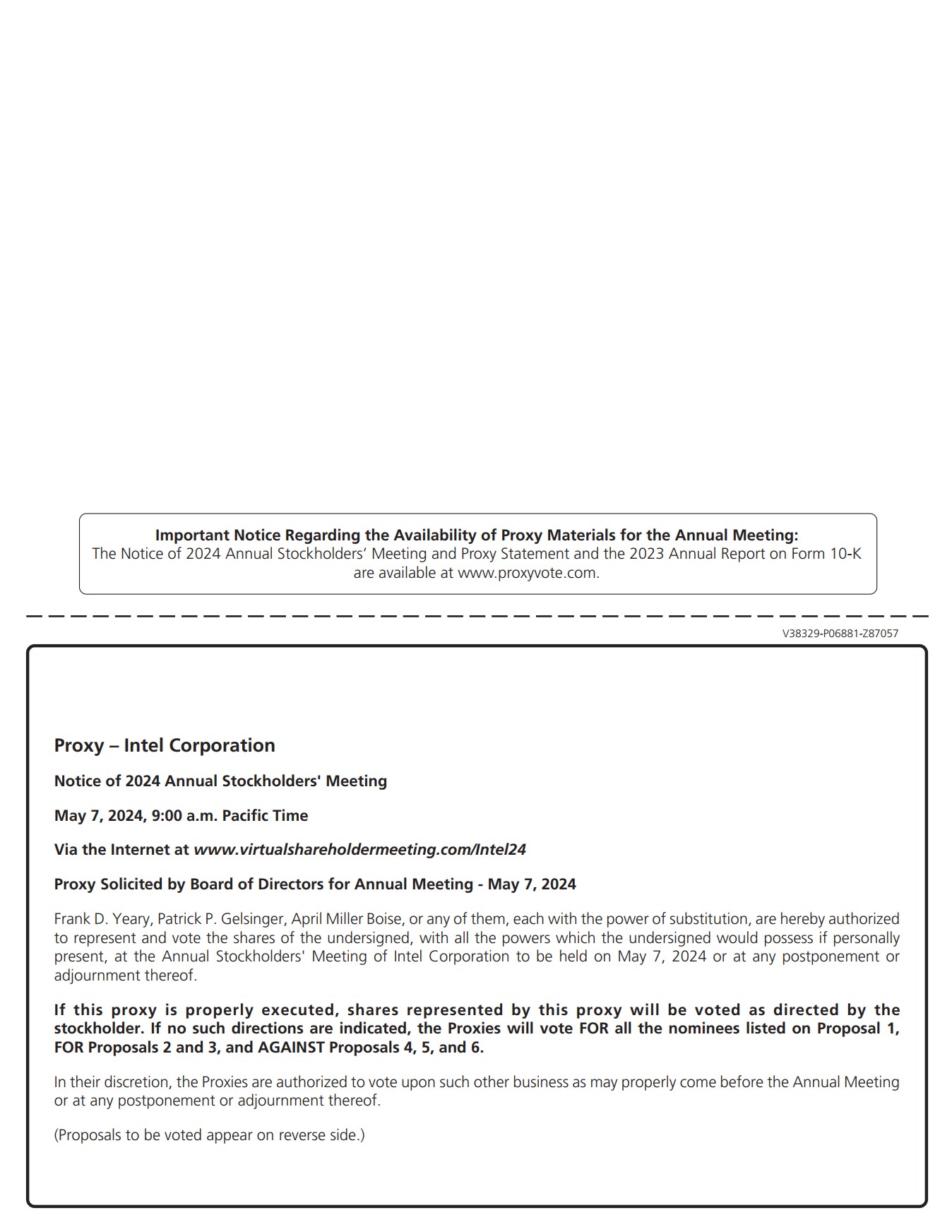0000050863DEF 14Afalse00000508632023-01-012023-12-300000050863intc:GelsingerMember2023-01-012023-12-30iso4217:USD0000050863intc:GelsingerMember2021-12-262022-12-3100000508632021-12-262022-12-310000050863intc:SwanMember2020-12-272021-12-250000050863intc:GelsingerMember2020-12-272021-12-2500000508632020-12-272021-12-250000050863intc:SwanMember2019-12-292020-12-2600000508632019-12-292020-12-2600000508632020-12-272021-02-1400000508632021-02-152021-12-250000050863ecd:PeoMemberintc:StockAwardsAdjustmentsMember2023-01-012023-12-300000050863intc:ChangeInPensionValueMemberecd:PeoMember2023-01-012023-12-300000050863intc:EquityAwardsGrantedDuringTheYearUnvestedMemberecd:PeoMember2023-01-012023-12-300000050863ecd:PeoMemberintc:EquityAwardsGrantedInPriorYearsUnvestedMember2023-01-012023-12-300000050863intc:EquityAwardsGrantedInPriorYearsVestedMemberecd:PeoMember2023-01-012023-12-300000050863intc:PensionAdjustmentsServiceCostMemberecd:PeoMember2023-01-012023-12-300000050863intc:StockAwardsAdjustmentsMemberecd:NonPeoNeoMember2023-01-012023-12-300000050863intc:ChangeInPensionValueMemberecd:NonPeoNeoMember2023-01-012023-12-300000050863intc:EquityAwardsGrantedDuringTheYearUnvestedMemberecd:NonPeoNeoMember2023-01-012023-12-300000050863intc:EquityAwardsGrantedInPriorYearsUnvestedMemberecd:NonPeoNeoMember2023-01-012023-12-300000050863intc:EquityAwardsGrantedInPriorYearsVestedMemberecd:NonPeoNeoMember2023-01-012023-12-300000050863intc:PensionAdjustmentsServiceCostMemberecd:NonPeoNeoMember2023-01-012023-12-30000005086312023-01-012023-12-30000005086322023-01-012023-12-30000005086332023-01-012023-12-30
UNITED STATES
SECURITIES AND EXCHANGE COMMISSION
Washington, D.C. 20549
| | |
|
| SCHEDULE 14A |
(RULE 14a-101)
SCHEDULE 14A INFORMATION |
Proxy Statement Pursuant To Section 14(a)
of the Securities Exchange Act of 1934 |
(Amendment No. ) |
|
Filed by the Registrant ☒
Filed by a Party other than the Registrant ☐
Check the appropriate box:
☐ Preliminary Proxy Statement ☐ Confidential, for Use of the Commission Only
☒ Definitive Proxy Statement (as permitted by Rule 14a-6(e)(2))
☐ Definitive Additional Materials
☐ Soliciting Material under §240.14a-12
| | |
|
|
INTEL CORPORATION
(Name of Registrant as Specified In Its Charter) |
(Name of Person(s) Filing Proxy Statement,
if Other Than the Registrant) |
|
Payment of Filing Fee (check all boxes that apply):
☒ No fee required.
☐ Fee paid previously with preliminary materials.
☐ Fee computed on table in exhibit required by Item 25(b) per Exchange Act Rules 14a-6(i)(1) and 0-11.
Table of Contents
| | | | | | | | | | | |
| | | |
| Index of Frequently Requested Information | |
| | | |
| | | |
| | | |
| | | |
| | | |
| | | |
| | | |
| | | |
| | | |
| | | |
| | | |
| | | |
| | | |
| | | |
| | | |
| | | |
| | | |
| | | |
| | | |
| | | |
| | | |
| | | |
| | Stockholder Engagement | |
| | | |
| | | |
| | | |
| | | |
| | | |
| | | |
| | | |
| | | |
| | | |
| | | |
| | | |
| | | |
| | | |
| | | |
| | | |
| | | |
| | | |
| | | |
| | | |
On behalf of our Board of Directors, we are making these materials available to you beginning on or about March 28, 2024 in connection with Intel’s solicitation of proxies for our 2024 Annual Meeting.
Letter from Your Board Chair
Dear Stockholder,
Intel delivered a series of notable accomplishments in 2023 that are critical to accelerating its momentum and a sign of the transformation that will continue to create stockholder value in the years ahead. The company’s senior leadership team, led by CEO Pat Gelsinger, worked tirelessly in 2023 with a rigorous focus on execution, which included advancing its process and product roadmaps, transitioning to a new foundry model to drive cost competitiveness, and implementing a new strategy to bring AI everywhere.
While we achieved important milestones and delivered on our commitments for the year, we have much more work to do. In 2024, we are laser-focused on delivering leadership products and meeting our financial targets while continuing to transform Intel across every category and segment in which we compete.
| | |
|
Strong Execution of our Transformation and a Clear Vision for a New Intel |
|
Three years ago, we outlined our ambition to revitalize Intel by setting the company on a path to regain process and product leadership, establish an at-scale foundry business, and build manufacturing capacity across a more resilient, globally diversified supply chain. While transformation at this scale takes years, Intel is moving at pace to deliver on this vision.
In 2023, we made significant progress on our goal of delivering five nodes in four years (5N4Y)—bringing process leadership within reach. In fact, we are moving beyond 5N4Y with Intel 14A, which is designed to extend our process leadership into the latter part of the decade. These feats of engineering demonstrate that our transformation has taken hold.
Our rapid progress in advancing process technology enabled the development of leadership products, both for Intel and for our Foundry customers, and significantly expanded our revenue opportunity. Furthermore, we continued to strengthen our ability to expand global manufacturing capacity, supported by anticipated incentives from the US CHIPS and Science Act, the EU, and Israel.
Our strategic progress was underpinned by strong financial and operational discipline. We delivered $3 billion in cost savings for the year and took strategic portfolio actions to unlock significant value for our stockholders, including the sale of a stake in IMS Nanofabrication and the announcement of our intention to independently capitalize Altera®, an Intel company (formerly Intel Programmable Solutions Group).
Letter from Your Board Chair
Looking ahead, our growth opportunity is supercharged by AI, where we have the unique ability to participate across the semiconductor landscape with Intel Products and Intel Foundry. While still in the early stages, we have an unwavering focus on strengthening our market position to capitalize on this vast opportunity.
| | |
|
The Board’s Deep Engagement with Intel’s Strategy and Stockholders |
|
Your board of directors is focused on enabling the company’s transformation in full alignment with stockholders’ interests. In this effort, board members, individually and collectively, are deeply engaged with Intel management overseeing the execution of the company’s strategy. Directors regularly hold in-depth discussions with Intel’s executive team and key business leaders and conduct ongoing reviews of progress across initiatives including 5N4Y, Intel Foundry, and AI strategy. In addition, your board remains focused on capital allocation, liquidity and capital expenditure, and other investment plans, including the ongoing evaluation of potential transactions to unlock value.
The board regularly engages with stockholders, on these issues in addition to execution oversight and sustainability and governance practices as well as executive compensation, among others. In 2023, Dion Weisler and I led outreach efforts to stockholders owning ~68% of the institutionally held shares of the company and met with stockholders representing ~48% of those shares. These conversations are both opportunities to share our thinking directly with owners and for the board to hear and learn from them. This process makes the company better and we remain dedicated to an active and ongoing dialogue.
| | |
|
Governance and Board of Directors |
|
The composition of Intel’s board reflects a diversity of expertise, industry experience, and backgrounds. We maintain a thoughtful director refreshment process to ensure our board continues to comprise the right mix of skills and perspectives to guide and oversee Intel’s transformation. We have added four directors in the last three years, recently welcoming Stacy Smith back to Intel as an independent director. Our director identification process is ongoing as we continually seek highly qualified candidates, focused in areas where additional depth on the board can support current and future company priorities and opportunities.
My strong confidence and optimism in Intel’s future is enabled by the tremendous technical and manufacturing accomplishments of the past few years and, critically, by the many Intel team members around the globe who drove these achievements. As we look ahead, our commitment to work alongside fellow directors to drive amazing solutions for our customers and create long-term value for stockholders is unwavering.
We thank you for your continued feedback, investment, and trust in Intel.
Sincerely,
Frank D. Yeary
Chair of the Board
Introduction to Our Business
| | | | | | | | | | | | | | | | | | | | | | | | | | | | | | | | |
| | | | | | | | | | |
| We are an industry leader and a catalyst for technology innovation and products that revolutionize the way we live. We are committed to harnessing the breadth and scale of our reach to have a positive effect on business, society, and the planet. | |
| | | | | | | | | | |
|  Products Products |  Foundry Foundry | |
| We are focused on designing and developing semiconductor products that deliver leadership performance and end-to-end solutions from silicon through software to serve an increasingly smart and connected world powered by AI ▪PCs ▪Data center ▪Network and edge computing ▪Emerging fields such as autonomous driving | We are the world’s largest US-based, global manufacturer of leading-edge semiconductors, and are utilizing our manufacturing experience, scale, and technologies to create a world-class systems foundry for the AI era for Intel products and external customers ▪Global, resilient, more sustainable, and trusted ▪Offering a full suite of node evolutions ▪Providing full-stack optimization from factory network to software | |
| | | | | | | | | | |
| Our purpose is to create world-changing technology that improves the life of every person on the planet. | Our values guide how we make decisions, treat each other, and serve our customers. They also underpin how we achieve our purpose. More than simply words, our values are the common thread that unites us. | | | Customer First | | | | |
| | | Inclusion | |
| | Fearless Innovation | | |
| | | Quality | |
| | Results Driven | | |
| | | Integrity | |
| | One Intel | | |
| | | | |
| | | | | | | | | | |
Technology Superpowers Fuel Our Strategic Pillars
We expect to see continued demand for processing power over the next decade with semiconductors as the underlying technology powering this digital expansion. The demand for compute is being accelerated by five superpowers, which we intend to harness for our strategy to win by focusing on four strategic pillars.
Technology Superpowers
| | | | | | | | |
| | |
| Artificial Intelligence: Intelligence everywhere, turning infinite data into actionable insight |
| |
| Ubiquitous Compute: Everything we interact with involves computer technology |
| |
| Pervasive Connectivity: Everything and everyone is connected |
| |
| Cloud-to-Edge Infrastructure: Unlimited scale and capacity combined with unlimited reach, while simultaneously addressing the need for lower latency and higher bandwidth |
| |
| Sensing: Through advancements in AI, telemetry, photonics, mapping, and more, machines are adopting human-centric abilities for smarter, more useful data |
| |
Strategic Pillars
| | | | | | | | |
| | |
| Product Leadership | |
| We intend to lead and democratize compute with Intel x86 and xPU. | |
| | |
| Open Platforms | |
| We aim to deliver open software and hardware platforms with industry-leading standards. | |
| | |
| Manufacturing at Scale | |
| Our IDM 2.0 strategy combines three capabilities: our internal factory network, strategic use of foundry capacity, and our systems foundry. | |
| | |
| Our People | |
| Our world-class talent is at the heart of everything we do. We strive to have a positive effect on business, society, and the planet. | |
| | |
Introduction to Our Business
Our Transformation Agenda
Executing to Regain Process Technology Leadership
Closing in on Five Nodes in Four Years
| | | | | | | | | | | | | | |
| Intel 7 | 4th Gen Intel® Xeon® | 5th Gen Intel® Xeon® |
| | |
Intel 4 | First EUV node | Intel® Core™ Ultra |
| | |
Intel 3 | Sierra Forest | Granite Rapids |
|
|
| | | | |
| | Intel 20A | PowerVia + RibbonFET | Arrow Lake |
| | | | |
| | Intel 18A | Clearwater Forest | Panther Lake |
| |
Building a World-Class Systems Foundry
| | |
At Scale, Geo Diverse, and Resilient |
|
Long-standing Sustainability Leadership |
|
Unique Advanced Packaging IP |
|
Expanding Ecosystem with Cadence, Synopsys, Tower & UMC Collaborations |
|
Wafer & Advanced Packaging Customer Momentum |
|
Expanded US Dep. of Defense’s RAMP-C Program, led by Intel on Intel 18A |
|
Multigen Arm Agreement enabling Low-power Compute SoCs on Intel 18A |
| | | | | | | | | | | | | | | | | | | | | | | |
| | | | | | | |
| Creating a Systems Foundry for the AI Era | |
| | | | | | | |
| ▪Leading-edge Roadmap beyond Intel 18A Expected transistor leadership at Intel 18A; Intel 14A expected in 2026 as industry’s first process technology using High Numerical Aperture EUV lithography; glass substrates in development for next generation advanced packaging | | | | Launchpad for participating in 100% of the total addressable market for AI silicon logic | |
| | | | | |
| ▪Specialized Node Evolutions for Varying Customer Requirements Specialized nodes from leading-edge to mature address varying customer requirements such as communications infrastructure, networking, and mobile | | | | |
| | | n | |
| | | |
| | | | |
| ▪Full Stack Optimization from Factory Network to Software Empowers customers to innovate across the entire system through continuous technology improvements, reference designs, and new standards, with security embedded throughout | | | | |
| | | | |
| | | | | | | |
Executing Our Strategies with Financial Discipline
| | | | | | | | | | | | | | | | | | | | | | | | | | | | | |
| | | | | | | | | |
| Smart Capital | | | | Operational Efficiencies | | | | Value Unlock |
▪Capacity Investment Aggressively building out Arizona, Ohio, and Germany manufacturing shell space to meet demand ▪Innovative Growth Financing Working with US + EU governments to benefit from CHIPs incentives, utilizing semi co-investment program (SCIP) capital, and gaining customer commitments (18A prepay) ▪Effective External Foundry Use Disaggregated roadmap | | | ▪Internal Foundry Model 2024 product & manufacturing segment separation to change culture, create the right organizational incentives, and increase transparency to stockholders ▪Operating Expense Efficiencies Met $3B 2023 cost savings goal, and driving towards long-term margin improvements ▪Optimizing Portfolio Exited 10 businesses since Q2 2021; $1.8B in annual savings | | | ▪Mobileye Public Offerings Initial and secondary public offerings raised $2.6B ▪IMS Nanofabrication Partial Sale Raised $1.4B in cash at $4.3B valuation; enables deeper cross-industry collaboration ▪Launch Altera, an Intel Company as a Standalone Business Separate reporting for Altera (formerly PSG) starting in Q1 2024; driving towards partial sale and/or initial public offering |
| | | | | | | | | |
Introduction to Our Business
Our Global Presence
| | | | | | | | |
~125 thousand
employees worldwide | 53 countries in which we operate | $25.8 billion
in gross capital investments in 2023 |
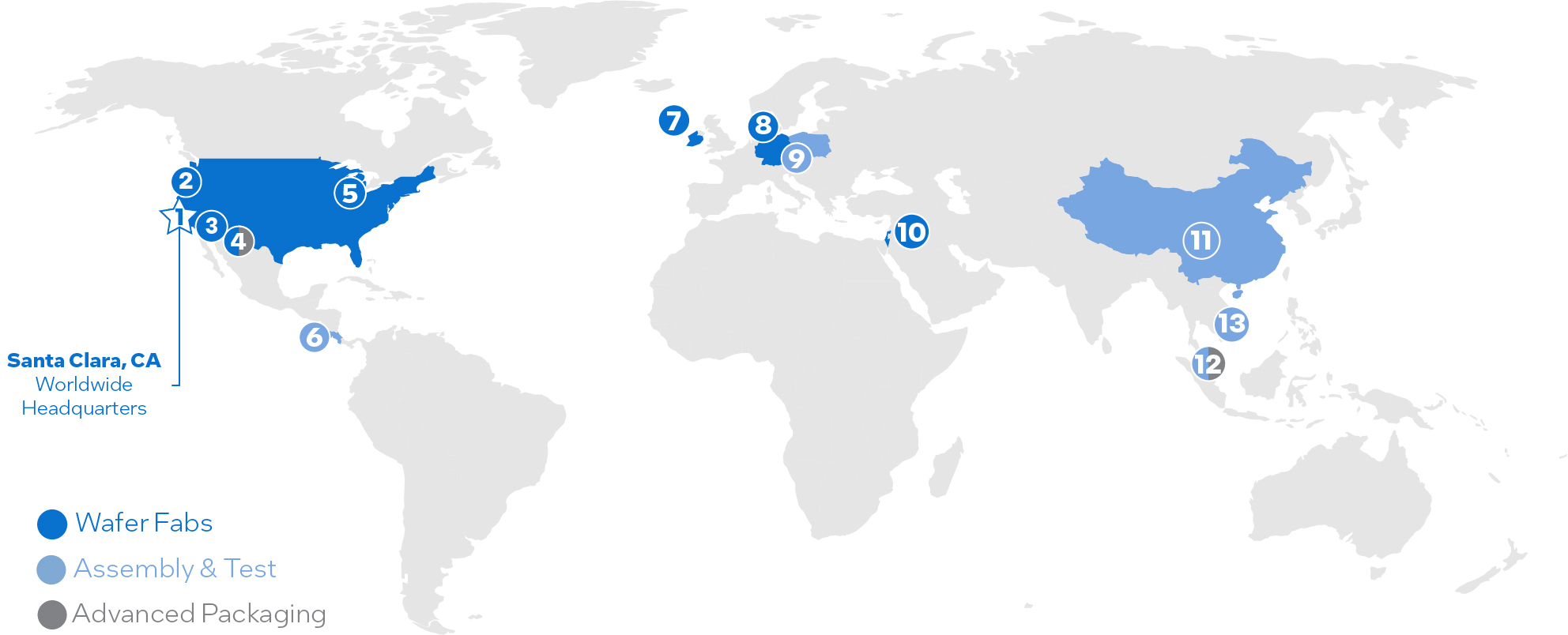
| | | | | |
| United States |
| California |
| Corporate headquarters |
| |
| | | | | |
| Oregon |
| Gordon Moore Park campus - home of Intel’s technology development organization World’s first High-NA EUV lithography tool, planned for use with leading-edge process nodes beyond Intel 18A Planning multibillion dollar expansion to R&D facilities and semiconductor manufacturing capacity Latest Investment: planning phase |
| |
| | | | | |
| Arizona |
| Intel’s largest semiconductor manufacturing facility Expansion of two fabs for future production on Intel 20A and Intel 18A Ongoing Investment: $20B |
| |
| | | | | |
| New Mexico |
| Semiconductor technology development and manufacturing site Expansion providing new advanced packaging capacity Ongoing Investment: $3.5B |
| |
| | | | | | | | | | | |
| | Ohio | |
| | Constructing two new leading-edge fabs at a new US semiconductor manufacturing mega-site Ongoing Investment: $20B | |
| | | |
| | | |
| Central America | |
| | Costa Rica | |
| | State-of-the-art R&D and global services center Assembly & test facility | |
| | | |
| | | |
| Europe | |
| | Ireland | |
| | One of Europe’s leading semiconductor manufacturing facilities New fab opened in 2023 with production on Intel® Core™ Ultra on Intel 4 | |
| | | |
| | | |
| | Germany | |
| | Announced plan to build two new leading-edge wafer fabs Facility: Wafer Fab Planned Investment: €30B | |
| | | |
| | | | | | | | |
| Poland | |
| Intel’s largest R&D facility in Europe Announced plan to build new assembly & test Planned Investment: $4.6B | |
| | |
| | |
| Middle East | |
| Israel | |
| Technology development sites and manufacturing facility Home to Mobileye business Ongoing Investment: $25B | |
| | |
| | |
Asia | |
| China | |
| Assembly & test facility | |
| | |
| | |
| Malaysia | |
| Intel’s 1st international assembly & test facility Building a new advanced packaging facility Ongoing Investment: $7B | |
| | |
| | |
| Vietnam |
| Our largest assembly & test facility | |
| | |
Introduction to Our Business
Our Financial Highlights
| | | | | | | | |
| | |
| Revenue | | |
| |
| 2023 vs. 2022: Lower revenue in CCG, DCAI, and NEX driven by customer inventory corrections impacting demand and volumes. 2022 vs. 2021: Lower revenue in CCG and DCAI, higher revenue in NEX, and lack of NAND revenue compared to 2021 due to the divestiture in Q1 2022. |
| | | | | | | | |
| Gross Margin | | |
| |
| 2023 vs. 2022: Lower GAAP gross margin from lower revenue, higher unit cost, and higher excess capacity charges, partially offset by the sell-through of previously reserved inventory, lower inventory reserves taken in 2023, lower product ramp costs, and the absence of one-time charges recognized in 2022. 2022 vs. 2021: Lower GAAP gross margin from lower revenue, higher unit cost, lack of NAND gross margin, higher period charges from the ramp of Intel 4, and higher inventory reserves. |
| | | | | | | | |
| Diluted EPS Attributable to Intel | | |
| |
| 2023 vs. 2022: Lower GAAP EPS from lower gross margin and absence of one-time gains recognized in 2022, partially offset by lower R&D and marketing, general, and administrative spending, and a higher tax benefit. 2022 vs. 2021: Lower GAAP EPS from lower gross margin, higher operating expenses from additional investment in R&D, partially offset by higher gains on equity investments and a tax benefit. |
| | | | | | | | |
Cash Flow | | |
| |
| 2023 vs. 2022: Lower operating cash flow primarily driven by lower net income, partially offset by favorable changes in working capital and other adjustments. 2022 vs. 2021: Lower operating cash flow driven by lower operating income, partially offset by favorable working capital changes. |
See “Appendix A: Non-GAAP Financial Measures” on page A-1 for a reconciliation of the non-GAAP measures, including Adjusted Free Cash Flow, to the nearest GAAP measure.
Introduction to Our Business
Corporate Responsibility Initiatives
With our corporate responsibility “RISE” strategy, and our 2030, 2040, and 2050 sustainability goals, we aim to create a more responsible, inclusive, and sustainable world, enabled through our technology and the expertise and passion of our employees. Our strategy not only raises the bar for ourselves and our value chain but also increases the scale and global impact of our work through continued collaborations with our customers and a broad range of stakeholders. We aim to harness the power of technology to solve increasingly complex and interconnected global challenges during this decade and beyond. We know that acting alone, Intel cannot achieve the broad, societal impact we aspire to. That is why we regularly engage with investors regarding our RISE goals and progress, including in our governance engagements and ESG Roadshow.
Our world-class talent is at the heart of everything we do. We continue to be inspired by the many ways our employees have driven progress on our goals in the face of a challenging external environment, and by the positive stakeholder feedback and increased interest to work together to accelerate global impact. We are harnessing the breadth and scale of our reach — through people and across the industry — to have a positive effect on business, society, and the planet. For additional details (and any definitions) about our corporate responsibility initiatives, see our Corporate Responsibility Report.
| | | | | | | | | | | |
| | | |
| Responsible Lead in advancing safety, wellness, and responsible business practices across our global manufacturing operations, our value chain, and beyond | Collaborating to Advance AI Safety Thru MLCommons® Working Group, The AI Alliance, NIST, and others RAI Principles Updated and made public | $27M In fees returned to suppliers’ workers (since 2014) 3TG+ Responsible mineral sourcing (Al, Cu, Ni & Ag) |
| | | |
| | | |
| Inclusive Advance inclusion across our global workforce and industry, and expand opportunities for others through inclusive technology, practices, and digital readiness initiatives | #4 Most just company by JUST Capital, leading our industry in 2024 Intel’s AI Global Impact Festival New student award for utilizing AI to promote accessibility | 45+ Employee resource groups, affinity groups, and leadership councils ~$1.6B Diverse supplier annual spending in 2023 |
| | | |
| | | |
| Sustainable Be a global leader in sustainability and enable our customers and others to reduce their environmental impact through our actions and technology | Climate Transition Action Plan Outlines our roadmap, risk management, and transition opportunities 99% Renewable electricity use across global operations | Net Zero GHG emissions commitment for scope 1 and 2 (by 2040) and upstream scope 3 (by 2050) $425M Of green bond proceeds allocated in first-year update to support operational sustainability |
| | | |
| | | |
| Enabling Through innovative technology and the expertise and passion of our employees, we enable positive change within Intel, across our industry, and beyond | ~3.8M Volunteer hours (since 2020) 370 Tech impact projects funded via the Intel RISE Technology Initiative in 42 countries (since 2020) | Improved accessibility Experiences when connecting hearing aids to Intel® Evo™ laptops 5.8M People trained via Intel® Digital Readiness Programs globally |
All tabular data is as of December 31, 2023 or during 2023 unless otherwise noted. Portions of the tabular data are preliminary, with final information to be reported in our 2023-2024 Corporate Responsibility Report. 3TG+: Beyond tin, tantalum, tungsten and gold; Al - Aluminum, Cu- Copper, Ni - Nickel, and Ag - Silver.
Introduction to Our Business
Human Capital Management
Intel’s approximately 125,000 employees are shaping the future with computing and connectivity technologies. Our people and culture are critically important to Intel's success. We strive to attract, develop, and retain the world’s best talent who seek to build transformative products and services that help our customers succeed in an increasingly data-driven world. We are committed to creating an inclusive workplace where the world’s best engineers, technologists, and technicians can fulfill their dreams and create technology that improves the life of every person on the planet. We believe that Intel can be more innovative, agile, and competitive when every employee has a voice and a sense of belonging.
Intel is innovating how we work by fostering a disciplined and efficient, yet flexible, workplace where people are motivated to execute to create world-changing technology. All employees are responsible for upholding our values (see page 6), the Intel Code of Conduct, and Intel's Global Human Rights Principles, which form the foundation of our policies and practices and ethical business culture. For additional human capital related information, see our Corporate Responsibility Report. | | | | | | | | | | | |
| | | |
| Inclusion Inclusion is one of Intel's core values and is at the heart of our culture. We continue to support the inclusion, development, and progression of all our talent. We strive to provide a workplace where everyone has access and opportunity to achieve their best. | 28.1% Women global employees 19.0% Women global senior leadership | 17.0% Underrepresented minorities US employees 8.2% Underrepresented minorities US senior leadership |
| | | |
| | | |
| Compensation and Benefits We strive to provide market-competitive pay, benefits, and services that help meet the varying needs of our employees. We believe that our holistic approach towards pay equity, representation, and creating an inclusive culture enables us to cultivate a work place that helps employees develop and progress in their careers at all levels. | Maintained Global gender pay equity Maintained US racial and ethnic pay equity | Hybrid-first Company Comprehensive Compensation & benefits (structured to meet employees’ varying needs in a market-competitive, holistic package) |
| | | |
| | | |
| Growth and Development We invest significant resources to develop the talent needed to remain at the forefront of innovation and make Intel an employer of choice. We offer extensive training programs, provide rotational assignment opportunities, and continue updating our job architecture to help employees create custom learning programs for building skills and owning their careers. | Employee Experience Surveys Enable employees to provide feedback on the company and work experiences (e.g., learning & development opportunities) | 5.6% Global undesired turnover rate |
| | | |
| | | |
| Health, Safety, and Wellness We provide access to a variety of innovative, flexible, and convenient health and wellness programs, including on-site health centers, and we aim to increase awareness of and support for mental and behavioral health. We continue to build our strong safety culture and drive global expansion of our corporate wellness program through employee education and engagement activities. | 94% Intel® Vitality Program satisfaction rating (95% in 2022) 370K+ Health & safety training courses completed | 41% Wellness program participation rate
(38% in 2022) 92% Break compliance (91% in 2022) |
All tabular data is as of December 31, 2023 or during 2023 unless otherwise noted. Additional details such as the definitions of any terms (e.g., senior leadership, underrepresented minorities, pay equity, undesired turnover rate, etc.) may be found on our corporate responsibility website and will be available in our 2023-2024 Corporate Responsibility Report. Portions of the tabular data are preliminary, with final information to be reported in our 2023-2024 Corporate Responsibility Report.
Meeting Notice and Voting Roadmap
| | | | | | | | | | | | | | | | | | | | | | | | | | | | | | | | | | | |
| | | | | | | | | | The Board recommends that you vote “FOR” each director nominee. | |
| | | | Proposal 1 | | | | | |
| How to Attend Stockholders may attend the virtual annual meeting by visiting www.virtualshareholdermeeting.com/Intel24. For additional details on how to access the meeting, see page 104. DATE: Tuesday, May 7, 2024 TIME: 9:00 A.M. Pacific Time RECORD DATE: March 11, 2024 | | | Election of Directors | | |
| | | |
| | | |
| | | | | | | | | | |
| | | | | | | | | | |
| | | Through regular refreshment, we have built a substantially independent Board that is exceptionally qualified and engaged. We believe our Board possesses the necessary skills, experiences, and diversity of backgrounds and perspectives to effectively oversee our business and strategic evolution and represent the long-term interests of our stockholders. Upon the recommendation of our Corporate Governance and Nominating Committee (Governance Committee), our Board has nominated all 13 current directors for election to serve as directors. See page 25 | |
| | | | |
| | | | |
| How to Vote Please act as soon as possible to vote your shares, even if you plan to attend the annual meeting online. For more information, including if you are a beneficial stockholder, see “Additional Meeting Information” on page 104. ONLINE at www.proxyvote.com. You may also vote online during the annual meeting and/or submit questions at www.virtualshareholdermeeting.com/Intel24. BY PHONE by calling the applicable number. For stockholders of record:
(800) 690-6903 For beneficial stockholders:
(800) 454-8683 BY MAIL if you have received a printed version of these proxy materials. SCAN this code to your phone to receive all of the meeting details. | | | |
| | | | | | | | | | |
| | | | |
| | | Our Board Nominees | |
| | | | | | | | | | |
| | | | Patrick P. Gelsinger Intel’s Chief Executive Officer (CEO) | | Barbara G. Novick Co-Founder, Former Vice-Chairman, and Senior Advisor at BlackRock, Inc. | |
| | | | | | | | | | |
| | | | James J. Goetz Partner at Sequoia Capital | | Gregory D. Smith Former CFO and Executive Vice President of Enterprise Operations at The Boeing Company | |
| | | | | | | | | | |
| | | | Andrea J. Goldsmith Dean of Engineering and Applied Science and Professor of Engineering at Princeton University | | Stacy J. Smith Executive Chairman at Kioxia Corporation | |
| | | | | | | | | | |
| | | | Alyssa H. Henry Former Square CEO at Block, Inc. | | Lip-Bu Tan Former Executive Chairman and CEO at Cadence Design Systems Inc. | |
| | | | |
| | | | |
| IMPORTANT NOTICE REGARDING THE INTERNET AVAILABILITY OF PROXY MATERIALS FOR THE ANNUAL MEETING TO BE HELD ON MAY 7, 2024 The Notice of the 2024 Annual Stockholders’ Meeting and Proxy Statement and the 2023 Annual Report on Form 10-K are available at www.intc.com. Our Board solicits your proxy for the 2024 Annual Stockholders’ Meeting (and any postponement or adjournment of the meeting) for the matters set forth above. | | | |
| | | | | | | | | | |
| | | | Omar Ishrak Former Executive Chairman
and CEO at Medtronic plc | | Dion J. Weisler Former President and CEO at HP, Inc. | |
| | | | | | | | | |
| | | | Risa Lavizzo-Mourey Robert Wood Johnson Foundation PIK Professor Emerita at the University of Pennsylvania | | Frank D. Yeary Principal at Darwin Capital Advisors LLC Intel’s Independent Board Chair | |
| | | | | | | | | | | |
| | | | | Tsu-Jae King Liu Dean and Roy W. Carlson Professor of Engineering in the College of Engineering at UC, Berkeley | | | | |
| | | | | | | | | | | |
Meeting Notice and Voting Roadmap
| | | | | | | | | | | | | | | | | | | | | | | |
| | | | | | | |
| Aggregated Board Snapshot |
| | | | | | | |
| | | | | | | |
Tenure | | | Age | |
4.9 years 8 new directors average tenure in last five years | | 61 years average age |
3 New (≤2 years) | 9 Medium-tenured (3-9 years) | 1 Longer tenured (10+ years) | | 7 ≤60 years | | 4 61-65 years | 2 >65 years |
| | | | | | |
| | | | | | | |
| | | | | | | | | | | |
| | | |
Diversity | | Independence |
10 of 13 directors have diverse backgrounds | | 85% independent |
5 Female (38%) | 4 Racially /ethnically diverse (31%) | | 11 Independent (85%) |
| | | |
4 Born outside U.S. (31%) | 1 Has a disability (8%) | | 2 Not Independent (15%) |
| | | |
| | | |
| | | | | | | | | | | | | | | | | | | | |
Board Skills and Experience |
| | | | | | |
| Semiconductor, Industry and IT/Technical Experience | | | Human Capital
Experience |
| 9 | | | 11 |
| | | | | | |
| Operating and Manufacturing Experience | | | Senior Leadership Experience |
| 5 | | | 10 |
| | | | |
| Emerging Technologies and Business Models Experience | | | Financial
Expertise |
| 10 | | | 5 |
| | | | | | |
| Business Development and M&A Experience | | | Cybersecurity/ Information Security |
| 11 | | | 5 |
| | | | | | |
| Global/ International Experience | | | Government, Legal, Regulatory, and Policy Experience |
| 11 | | | 3 |
| | | | | | |
| Sales, Marketing, and Brand Management Experience | | | Public Company Board Experience |
| 7 | | | 12 |
| | | | | | |
| | | | | | | | |
| | |
| Governance Highlights | |
| | |
| Accountable to Stockholders ▪Annual election of directors by majority vote with resignation policy ▪Proxy access (3%, 3 years, 20% of board) ▪Stockholder ability to call special meetings (15% threshold) ▪No poison pill Stockholder Voting Rights in Proportion to Economic Interest ▪One vote per share, with no dual-class share structure Proactive and Responsive to Stockholders ▪Proactive year-round stockholder engagement with director participation ▪History of Board responsiveness to stockholder feedback Strong Independent Leadership Structure ▪Independent Board Chair ▪Annual review of Board leadership structure ▪Independent directors meet in executive session at least four times annually Practices that Enhance Board Effectiveness ▪Annual Board and committee self-evaluations ▪Annual review of skills, experiences, backgrounds and contributions of individual directors ▪Active Board refreshment process to evaluate and enhance Board skills ▪Director "overboarding" and age (75) limits ▪No restrictions on directors' access to management or employees ▪Board and committees can hire outside advisors independently of management ▪Robust Board-level oversight of strategy, risk management, cybersecurity, human capital management, and corporate social responsibility Management Incentive Structures Aligned with Long-Term Strategy ▪Talent and Compensation Committee annually reviews program design ▪Short- and long-term incentive programs designed to reward financial and operational performance that furthers strategy and aligns with stockholder interests | |
| | |
Meeting Notice and Voting Roadmap
| | | | | | | | | | | |
| | | |
Proposal 2 | Ratification of Selection of Independent Registered Public Accounting Firm | | The Board recommends that you vote “FOR” this proposal. |
| | | |
The Audit & Finance Committee (Audit Committee) considered a number of factors in re-engaging Ernst & Young LLP (EY), including the independence controls in place and EY’s objectivity, track record, global footprint, and deep semiconductor industry knowledge, experience, and expertise. The Audit Committee is directly involved in the annual review and engagement of EY and believes its continued retention is in the best interests of Intel and its stockholders. See page 48 | | | | | | | | | | | | | | |
| | | | |
Proposal 3 | Advisory Vote on Executive Compensation (Say-On-Pay) | | The Board recommends that you vote “FOR” this proposal. |
| | | | |
The Talent and Compensation Committee (Compensation Committee) seeks to design executive compensation programs that are tied to Intel’s financial and operational performance, further our short-and long-term strategic objectives, support our commitment to strong compensation governance and pay-for-performance philosophy, and are responsive to stockholder feedback. In particular, the Compensation Committee has implemented substantial and significant changes to our executive compensation programs over the last few years in response to discussions with our stockholders, including making the CEO new-hire awards from 2021 more challenging to achieve. See page 52 Overview of NEO Compensation
| | | | | | | | | | | | | | |
| | Pay Element | Purpose | 2023 Metrics & Key Features |
| | | | |
| | Base Salary | Designed to be market-competitive and attract and retain talent | Compensation Committee conducted annual review of peer group and market data relating to pay elements |
| | | | |
| | | | |
| | Annual Cash Bonus | Incentivize achievement of Intel’s near-term financial and operational objectives, consistent with Intel’s longer-term goals | Payout opportunity is 0-200% of target based on: ▪For the CEO, four equally weighted (25%) performance metrics: ▪Revenue ▪Gross Margin Percentage ▪Spending Reduction Goal ▪One Intel Operational Goals ▪For other NEOs, five equally weighted (20%) performance metrics: ▪Same four metrics that apply to CEO, plus ▪Individual Objectives and Key Results |
| | | | |
| | | | |
| Performance Stock Units (80% of CEO long-term incentive mix, 60% for other NEOs) | Designed to reward long-term profitability and long-term performance relative to peers, to create alignment with stockholders, and facilitate executive retention | Three-year performance period Payout opportunity is 0-200% of target based on two financial metrics, each with annually set objectives: ▪Revenue Growth Percentage (weighted 60%) ▪Cash Flow from Operations (weighted 40%) Payout adjusted by two modifiers that can each impact the percentage achievement by +/- 25 percentage points: ▪Three-year relative TSR (where target payout requires above median performance compared to the S&P 500 Index) ▪Three-year revenue Payout is capped at target if our TSR is negative |
| | | |
| | | |
| Restricted Stock Units (20% of CEO long-term incentive mix, 40% for other NEOs) | Facilitates stock ownership, executive retention, and stockholder alignment | Annual vesting over three years |
| | | |
Meeting Notice and Voting Roadmap
| | | | | | | | | | | |
| | | |
Proposal 4-6 | Stockholder Proposals | | The Board recommends that you vote “AGAINST” these proposals. |
| | | |
| | | | | |
| |
Proposal 4 | Board Corporate Financial Sustainability Committee |
| |
The Board believes that there is already effective Board and committee oversight of our social and political policy positions and their impact on our financial sustainability. Further, Intel already provides extensive disclosure on the topic. Accordingly, the Board believes this proposal is unnecessary and not in the best interests of our stockholders. See page 98 | | | | | |
| |
Proposal 5 | Risk Report of Opposing State Abortion Regulation |
| |
The Board believes Intel offers competitive compensation, healthcare coverage, and other benefits for employees and already has a robust governance process in place to oversee risk and compliance. Accordingly, the Board believes the proposed report is unnecessary, would be a costly diversion and redirection of corporate resources, and would not be beneficial to our stockholders, employees, and other stakeholders. See page 100
| | | | | |
| |
Proposal 6 | Policy for Excessive Golden Parachutes Approval |
| |
The Board believes that the proposed policy is unnecessary because Intel has already implemented a Cash Severance Policy addressing many of the underlying concerns and stockholders already have a sufficient opportunity to provide input via Intel’s extensive stockholder engagement efforts and stockholders’ annual Say-on-Pay vote. By including equity compensation in the proposed compensation threshold, we believe the proposal may restrict the flexibility of the Compensation Committee and would misalign executive compensation practices by discouraging the use of at-risk, long-term incentive equity awards. This could put Intel at a competitive disadvantage for recruiting and retaining talented executives at a critical point in our transformation. Accordingly, the Board believes this proposal is unnecessary and not in the best interests of our stockholders. See page 102
Corporate Governance Matters
| | | | | |
| |
Proposal 1 Election of 13 Directors Through regular refreshment, we have built a substantially independent Board that is exceptionally qualified and engaged. We believe our Board possesses the necessary skills, experiences, and diversity of backgrounds and perspectives to effectively oversee our business and strategic evolution and represent the long-term interests of our stockholders. What am I voting on? Upon the recommendation of our Governance Committee, our Board has nominated the 13 individuals listed below to serve as directors until our 2025 Annual Stockholders’ Meeting. Each of our director nominees currently serves on the Board and was elected to a one-year term at the 2023 Annual Stockholders’ Meeting, except that Stacy J. Smith was appointed to the Board on March 12, 2024. | ▪Director nominees with diverse leadership, industry, and technology experience ▪11 of our 13 director-nominees are independent ▪Average director tenure of 4.9 years ▪Annual review of skills, experiences, backgrounds, and contributions of individual directors as part of annual director nomination process ▪Active Board refreshment process to evaluate and enhance Board skills, with seven new non-employee directors joining the Board since 2019 |
|
|
Biographical Information. Biographical information for each of the director nominees is included in this section, including a brief description of their occupation, business experience, and primary qualifications, attributes, and skills that the Governance Committee considered in recommending them as director nominees and that the Board considered in nominating them. Independence. Of the 13 director nominees, 11 have been determined by the Board to qualify as an “independent director” under Nasdaq rules, which require that, in the opinion of the Board, such person not have a relationship that would interfere with the exercise of independent judgement in carrying out the responsibilities of a director. Lip-Bu Tan, a non-employee director nominee, served as a member of an advisory committee to the Board prior to joining the Board and currently does not satisfy the Nasdaq independence test due to compensation previously received in that role. The only other non-independent director nominee is our CEO, Patrick P. Gelsinger. There are no family relationships among any of our directors or executive officers. Term and Service. Each director’s term runs from the date of their election until our next annual stockholders’ meeting and until their successor (if any) is elected or appointed. If any director nominee is unable or unwilling to serve as a nominee at the time of the annual meeting, the Board may reduce the size of the Board or may designate a substitute nominee and the individuals named as proxies may vote for the election of any such substitute nominee. Alternatively, the proxies may vote just for the remaining nominees, leaving a vacancy that the Board may fill at a later date. However, we have no reason to believe that any of the nominees will be unwilling or unable to serve at the time of the annual meeting. Voting, Election, and Conditional Resignation. For information with respect to the votes that may be cast and that are required to elect a director nominee, see “Additional Meeting Information; How Do I Vote?” on page 105. If a nominee who currently serves as a director is not re-elected, Delaware law provides that the director would continue to serve on the Board as a “holdover director.” Under our Bylaws and Corporate Governance Guidelines, each director must submit an advance, contingent, irrevocable resignation that the Board may accept if stockholders do not re-elect that director. In that situation, our Governance Committee would make a recommendation to the Board as to whether to accept the resignation, or whether to take other action instead. Within 90 days from the date of the certified election results, the Board would act on the Governance Committee’s recommendation and publicly disclose its decision and rationale. |
|
|
The Board recommends that you vote “FOR” each director nominee. |
|
|
Corporate Governance Matters
Corporate Governance Roadmap
Intel has long maintained strong corporate governance guided by values of transparency, responsiveness, and accountability. These values are reflected in the Board’s composition, skills, practices, structure, engagement and oversight.
| | | | | | | | |
| Board Overview | ▪Intel's Board is composed of 13 highly qualified directors with a diverse mix of skills, experiences, and backgrounds ▪85% are independent, 77% have diverse backgrounds (gender, racial/ ethnic, geographic and/or has a disability), and the Board has an average tenure of 4.9 years and average age of 61 years |
| | |
| | |
| Board Skills | ▪Intel’s Board has the appropriate mix of skills and experiences to oversee Intel's
business strategy and transformation agenda to regain process technology leadership, build a world class system foundry business, and enable customers’ AI solutions, all undertaken with financial discipline ▪Strong history of Board refreshment, with eight directors added in the last five years, enhancing the Board's strategic skill set in multiple areas - semiconductor, industry and IT/technical; operational and manufacturing; emerging technologies and business models; global/international; human capital; government, legal, regulatory, and policy; and financial expertise |
| | |
| | |
| Board Composition and Refreshment | ▪Rigorous and ongoing Board refreshment process, with an annual review of skills, experiences, backgrounds, and contributions of individual directors as part of the annual director nominating process, annual Board self-assessment, and ongoing evaluations of the skills needed on the Board and of potential director candidates ▪Proactive year-around stockholder engagement process with director participation so that the Board receives on-going input from stockholders as part of its robust annual director process for director selection/nomination |
| | |
| | |
| Board Structure and Engagement | ▪Intel's independent Board Chair, Mr. Yeary, is highly qualified to serve in that role and has clearly defined responsibilities ▪The Board has four regular standing committees, with independent and robust committee chairs, and creates other ad hoc committees as business needs arise ▪The Governance Committee regularly evaluates whether committee composition appropriately reflects new perspectives and the right mix of skills and experiences, and made several recent membership changes ▪Our directors attended on average 97% of their 2023 Board and applicable committee meetings and received frequent Intel strategy and business updates |
| | |
| | |
| Board Accountability | ▪Our relationship with our stockholders is important and we conduct ongoing stockholder engagement; in 2023 we contacted stockholders representing 68% of Intel's institutionally held shares ▪Stockholder feedback is communicated to the relevant committees on a regular basis throughout the year and to the full Board at least once a year ▪In 2023 we made several enhancements to our practices and disclosures in response to our stockholders' feedback |
| | |
| | |
| Board Oversight | ▪The Board has robust oversight processes to oversee Intel's strategy, enterprise risk management, and human capital management ▪While the full Board has primary responsibility, it also assigns specific oversight duties to the committees based on their areas of expertise ▪The Board also actively oversees corporate social responsibility matters, with the Governance Committee primarily supporting such efforts ▪Cybersecurity oversight is an important risk that Intel looks to manage, with the Audit Committee and Board receiving regular updates ▪Other important areas of Board oversight are ethics and legal and regulatory compliance |
Corporate Governance Matters
| | | | | | | | | | | |
| | | |
Board Overview Committees Key Qualifications | Age: 63 Director Since: 2021 Committees: None | Patrick P. Gelsinger CEO, Intel Brings 40+ years of semiconductor industry leadership experience, including extensive knowledge of Intel’s operations and culture, where he has served for over 30 years, became Intel’s first chief technology officer, and drove the creation of key industry technologies such as USB and Wi-Fi. |
| |
Public Boards ▪Mobileye Global (Intel subsidiary) | Skills & Expertise |
| | |
| | |
Age: 58 Director Since: 2019 Committees: C M | James J. Goetz Partner, Sequoia Capital Brings a keen understanding of evolving technologies and a strong track record of helping companies capitalize on disruptive innovation as a long-tenured partner at a venture capital firm, as well as substantial operating experience, a growth mindset, and significant private and public company board experience. |
| |
Public Boards ▪Palo Alto Networks | Skills & Experience |
| | |
| | |
Age: 59 Director Since: 2021 Committees: A | Andrea J. Goldsmith Dean of Eng. & App. Sci., Eng. Prof., Princeton Univ. Brings considerable industry and technical understanding as an accomplished academic, engineer, inventor, and entrepreneur (known for her highly acclaimed foundational work in wireless communications), as well as a strong commitment to diversity and inclusion, having advocated for increased diversity in the STEM disciplines. |
| |
Public Boards ▪Medtronic ▪Crown Castle | Skills & Experience |
| | |
| | |
Age: 53 Director Since: 2020 Committees: C M | Alyssa H. Henry Former Square CEO, Block Brings 25+ years of experience in software engineering and development of database and storage technologies, which is particularly useful as Intel moves to being a data-centric company and the next phase of our IDM 2.0 strategy, as well as substantial senior leadership experiences overseeing successful expansions of businesses into other technology services. |
| |
Public Boards ▪Confluent | Skills & Experience |
| | |
| | |
Age: 68 Director Since: 2017 Committees: A G | Omar Ishrak Former Exec. Chair. & CEO, Medtronic Brings substantial experience identifying and developing emerging technologies and overseeing strategic acquisitions through his senior leadership roles in the medical technology industry, as well as a strong track record of building diverse and inclusive workplace cultures and advocating for global partnerships, having served as a member of the Board of Trustees of the Asia Society. |
| |
Public Boards ▪Amgen ▪Allurion Technologies | Skills & Experience |
| | | |
| | | |
| Age: 69 Director Since: 2018 Committees: C G | Risa Lavizzo-Mourey Prof. Emerita, Univ. of Penn. Brings extensive leadership experience as former President and CEO at the nation's largest healthcare-focused philanthropic organization, as well as government experience from her healthcare government appointments and extensive public company board and governance experience. |
| | |
| Public Boards ▪GE Healthcare Technologies ▪Merck | Skills & Experience |
| | | |
| | |
Corporate Governance Matters
| | | | | | | | | | | | | | |
| | | | 85% Independent 61 years Average Age 4.9 years Average Tenure 38% Women 31% Racially/Ethnically Diverse 31% Geographically Diverse 8% Has a Disability 77% Diverse Backgrounds 7 New Non-employee Directors Since 2019 30 Board (5) and Committee (25) Meetings in 2023 97% Average Attendance for Directors at Board and Committee Meetings in 2023 |
Age: 60 Director Since: 2016 Committees: G | | Tsu-Jae King Liu Dean & Eng. Prof. - College of Eng., UC, Berkeley Brings a wealth of industry and technical expertise directly related to Intel's semiconductor device R&D and manufacturing, as well as an innovative spirit, holding more than 90 patents and numerous awards for her research (especially relevant are her contributions to fin-shaped field-effect transistor design, "FinFET"). |
|
| Public Boards ▪MaxLinear | Skills & Expertise |
| | | |
| | | |
Age: 63 Director Since: 2022 Committees: A G | | Barbara G. Novick Co-Founder, Former Vice-Chair., Snr. Adv., BlackRock Brings deep experience in investment, finance, and public policy, as well as broad business acumen, as the co-founder and former leader of the largest global asset manager, enabling her to be a strong advocate for the interests of Intel's stockholders as Intel continues its strategic transformation. |
| | |
| Public Boards ▪None | Skills & Experience |
| | | |
| | | |
Age: 57 Director Since: 2017 Committees: A FE | | Gregory D. Smith Former CFO & EVP, Enterprise Ops., Boeing Brings operational and financial expertise as the former CFO of the world's largest aerospace company, including significant international experience dealing with foreign governments on market access and regulation and business development experience, having overseen the venture capital arm of Boeing. |
| | |
| Public Boards ▪American Airlines | Skills & Experience |
| | | |
| | | |
Age: 61 Director Since: 2024 Committees: A FE | | Stacy J. Smith Exec. Chair, Kioxia Brings deep semiconductor industry; financial and accounting expertise; operating and manufacturing; and sales, marketing, and brand management expertise acquired over nearly 30 years of experience, including as the former Group President of Manufacturing, Ops. & Sales and EVP, CFO & Director, Corporate Strategy of Intel. |
| | |
| Public Boards ▪Autodesk ▪Wolfspeed | Skills & Experience |
| | | |
| | | |
Age: 64 Director Since: 2022 Committees: M | | Lip-Bu Tan Former Exec. Chair. & CEO, Cadence Design Systems Brings software and semiconductor expertise through his leadership of a computational software company providing solutions for the design and development of complex semiconductor chips and electronic systems, as well as deep industry relationships and significant public company board experience. |
| | |
| Public Boards ▪Credo Technology Group ▪Schneider Electric | Skills & Experience |
| | | |
| | | |
Age: 56 Director Since: 2020 Committees: C M | | Dion J. Weisler Former President & CEO, HP Brings technical industry knowledge and a deep understanding of the Intel customer experience as the former CEO of HP, as well as valuable public company directorship experiences and a dedication to corporate responsibility, having championed diversity, inclusion, and sustainability in prior leadership roles. |
| | |
| Public Co. Boards ▪Thermo Fisher Scientific ▪BHP | Skills & Experience |
| | | |
| | | |
Age: 60 Director Since: 2009 Committees: G M | | Frank D. Yeary Indep. Board Chair, Intel; Principal, Darwin Capital Advisors Brings investment banking and global M&A experience through his service as a board member for numerous venture stage companies, as well as corporate governance, stockholder engagement and board best practice experience from his role in founding and leading a major corporate governance advisory firm. |
| | |
| Public Boards ▪Mobileye Group (Intel subsidiary) ▪PayPal | Skills & Experience |
Corporate Governance Matters
Listed below are the skills and experiences we consider important for our director nominees in light of our current business strategy, structure, and market dynamics. The directors’ biographies note each director’s relevant experience, qualifications, and skills relative to this list.
| | | | | | | | | | | | | | |
| Skill and/or Experience | | Link to Strategic Pillars and Transformation Agenda |
| | Semiconductor, Industry, and IT/Technical Experience | | Key to understanding the highly sophisticated design, manufacturing and assembly and test of semiconductor products, our R&D efforts, and the technology ecosystems and markets in which we participate, particularly as we seek to regain process technology leadership and develop a foundry business. |
| Operating and Manufacturing Experience | | Valuable asset in overseeing our large scale global R&D, manufacturing, and assembly and test organization, our significant capacity expansion plans, our IDM 2.0 strategy to run transform the organization, and our efforts to develop a foundry business. |
| Emerging Technologies and Business Models Experience | | Important given Intel’s highly competitive and rapidly changing industry, where emerging technologies, such as AI, and new business models can rapidly disrupt even the most well-thought-out strategy. |
| Business Development and M&A Experience | | Provides insight into developing and implementing business growth strategies, assessing “make” vs. “buy” decisions, analyzing the “fit” of a proposed acquisition, valuing transactions, assessing management’s plans for integration and unlocking stockholder value. |
| Global/International Experience | | Provides valuable business and cultural perspectives for Intel’s global R&D, manufacturing, assembly and test, and sales (with the majority of our revenue coming from non-US sales), with continued international investments and manufacturing capacity expansions. |
| Sales, Marketing, and Brand Management Experience | | Provides expertise and guidance as we seek to grow sales of our products and foundry services, and enhance our brand. |
| Human Capital Experience | | Of importance to attracting and retaining top talent in a highly competitive market for senior technology leaders, including in areas such as high performance and cloud computing and AI, as we seek to deliver on our growth and transformation strategy. |
| | Senior Leadership Experience | | Provides an ability to analyze, shape, and oversee the execution of important operational and policy issues. Positions at businesses or organizations that are global, face significant competition, or involve technology or other rapidly evolving business models are particularly helpful. |
| Financial Expertise | | Knowledge of financial markets and accounting and financial reporting enables oversight of Intel’s capital structure, financing and investing activities, efforts to improve our operational efficiencies, and our financial reporting and internal controls. |
| Cybersecurity/Information Security | | Experience managing cybersecurity and information security risks or understanding the cybersecurity threat landscape provides valuable knowledge and guidance to the Board in its oversight of the company’s broad and significant cybersecurity and product security risks. |
| Government, Legal, Regulatory, and Policy Experience | | Government regulatory and policy experience is valuable as we engage with governments around the world on significant regulatory and public policy issues, including with respect to emerging technology, such as AI, regulations of trade and the semiconductor supply chain. |
| Public Company Board Experience | | Provides understanding of good public company board and corporate governance practices, board dynamics and operations, the board-CEO/senior management relationship, stakeholder expectations and responsiveness, and appropriate oversight as the company undergoes significant transformation. |
Corporate Governance Matters
| | | | | | | | | | | | | | | | | | | | | | | | | | | | | | | | | | | | | | | | | | | | |
| | | | | | | | | | | | | | |
| | | | | | | | NEW2022 | | NEW2024 | NEW2022 | | | |
| | | | | | | | | | | | | | Experience Highlights |
Semi/Ind | | | | | |
| | |
| | | |
| Gelsinger - CEO, Intel Goetz - Partner, Sequoia Capital Goldsmith - Dean, Princeton Engineering Liu - Dean, UC Berkeley College of Engineering Tan - CEO, Cadence Design Systems |
Op/Man | |
|
|
| |
|
| | | | | |
| Gelsinger - CEO, Intel Ishrak - CEO, Medtronic and CEO, GE Healthcare G. Smith - CFO, Boeing S. Smith - Grp. Pres., Manufacturing, Ops. & Sales, Intel Weisler - CEO, HP and COO, Lenovo |
Em Tech | | | | | |
| | | | | | | | Henry - Square CEO, Block and VP, Amazon Goetz - Partner, Sequoia Capital Goldsmith - Co-founder and CTO, Plume WIFI Liu - Dean, UC Berkeley College of Engineering Tan - Chairman, Walden International |
Bus Dev | | | |
| |
| | | | | | | | Goetz - Partner, Sequoia Capital Ishrak - CEO, Medtronic and CEO, GE Healthcare S. Smith - CFO and Dir., Corporate Strategy, Intel Tan - Chairman, Walden International Yeary - Global Head of M&A, Citigroup |
Glob/Int | |
| | | |
| | | | | | | | Ishrak - CEO, Medtronic and CEO, GE Healthcare G. Smith - CFO, Boeing Weisler - CEO, HP and COO, Lenovo; Thermo Fisher, BHP Group boards; Japan and Australia experience Yeary - Global Head of M&A, Citigroup |
Sales | |
|
| | |
|
| |
| | | |
| Henry - Square CEO, Block and VP, Amazon Ishrak - CEO, Medtronic and CEO, GE Healthcare Novick - Global Acct. Mgmt. Group Head, BlackRock S. Smith - Grp. Pres., Manufacturing , Ops. & Sales, Intel Weisler - CEO, HP |
Hum Cap | |
| |
| | | | | | | | | | Lavizzo-Mourey - CEO, Robert Wood Johnson Foundation Liu - Dean, UC Berkeley College of Engineering Novick - Co-founder and Vice Chair, BlackRock Yeary - Vice Chancellor, UC Berkeley |
Snr Ldr | | |
| | | |
| | | | | |
| Henry - Square CEO, Block and VP, Amazon Lavizzo-Mourey - CEO, Robert Wood Johnson Foundation Novick - Co-founder and Vice Chair, BlackRock Tan - CEO, Cadence Design Systems |
Fin |
|
|
|
|
|
|
| | | | | | | G. Smith - CFO, Boeing S. Smith - CFO, Intel Tan - CEO, Cadence Design Systems Weisler - CEO, HP Yeary - Darwin Capital, Principal |
Cyber | | |
| |
|
|
| | | | | |
| Gelsinger - CEO, VMware Goetz - Palo Alto Networks board Henry - Square CEO, Block and VP, Amazon G. Smith - EVP, Enterprise Operations, Boeing Weisler - CEO, HP and COO, Lenovo |
Govt, Leg |
|
| |
|
| |
| |
| | |
|
| Goldsmith - US President’s Council of Advisors, IEEE, National Academy of Engineering Lavizzo-Mourey - White House Health Care Reform Task Force and health care agency deputy admin. Novick - Gov’n Relations & Pub Policy Head, BlackRock |
Pub Co | | | | | | | | | | | | | | Goldsmith - Medtronic, Crown Castle Ishrak - Amgen, Allurion, Medtronic Lavizzo-Mourey - GE Healthcare, Merck Liu - MaxLinear S. Smith - Autodesk, Wolfspeed |
Corporate Governance Matters
| | | | | |
| Board Composition and Refreshment |
The Governance Committee establishes procedures for director nominations and recommends candidates for election to the Board. The committee has a robust and ongoing process to assess the skills and make-up of the Board.
Annual Nomination Process
| | | | | | | | | | | | | | | | | | | | | | | | | | | | | | | | | | | | | | | | | | | | | | | | | | | | | | | | | | | | | | | | | | | | | | | | | | | | | | | | |
| | | | | | | | | | | | | | | | | | | | | | | | | | |
| | | | n | Annual Process for Director Selection/Nomination | | | | | |
| | | | | | | | |
| | | | | | | | | | | | | | | | | | | | | | | | | | |
| | | | | | | | | | | | | | | | | | | | | | | | n | |
| | | | | | | | | | | | | | | | | | | | | | | | | | |
| 6 | | | | | Continuous year-long process involving multiple steps and inputs | | | | | 1 |
| | | | | | | |
Selection of Candidates and Diversity | | | | | | | Evaluation of Board Composition and Tenure |
| | | | | | | |
| | | | | | | | | | | | | | | | | | | |
| | | | | | | | | | | | | | | | | | | |
| n | | | | | | | | | | | | | | | | | |
| | | | | | | | | | | | | | | | | n | |
| | | | | | | | | | | | | | | | | | | |
| | | | | | | | | | | | | | | | | | | |
| 5 | | | | | | | | | 2 |
Check Independence, Conflicts of Interest, and References | | | | | | | | | Obtain Candidates from Various Sources |
| | | | | | | | | | | | | | | | | | | |
| | | | | | | | | | | | | | | | | | | | | | | | | | |
| n | | | | | | | | | | | | | | | | | | | | | | | | |
| | | | | | | | | | | | | | | | | | | | | | | | | | |
| | | | | | | | | | | | | | | | | | | | | | | | | | |
| | | | | | | | | | | | | | | | | | | | | | | | | | |
| | | | 4 | | | 3 | | | | | |
| | | | Evaluate Director Contribution and Value (Board Evaluation) | n | | Assess Board’s Needs Against Candidates’ Skills, Qualifications, and Commitments | n | | | | |
| | | | | | | | |
| | | | | | | | |
| | | | | | | | | | |
| | | | | | | | | | | | | | | | | | | | | | | | | | |
| | | | | |
| 1 | Regular Evaluation of Board Composition and Tenure |
| | | | | |
The Governance Committee and Board undertake an evaluation of the existing and future needs and skill sets of the Board in light of the company’s evolving strategy and risk and return profile. The committee works to build a Board that is refreshed, whenever appropriate, strong in its core competencies, and has the appropriate skill set to advance each of Intel’s strategic pillars. In addition to developing and maintaining a skills matrix, the committee receives input from stockholders through the stockholder engagement process and the vote support each director received during the most recent annual stockholder meeting. The Governance Committee and Board believe that a mix of long-, medium-, and short-tenured directors promotes an appropriate balance of views and insights and allows the Board to benefit from both the historical, institutional knowledge that longer-tenured directors possess and the fresh perspectives contributed by newer directors. As an alternative to term limits, the Board seeks to maintain an average tenure of 10 years or less for the non-employee directors as a group. | Tenure (non-employee director nominees) 5.1 years
average tenure of non-employee director nominees |
| |
| |
The Board believes that its current mix of tenures represents an appropriate mix of new perspectives and deep institutional knowledge. |
| |
Corporate Governance Matters
| | | | | |
| 2 | Obtain Candidates from Various Sources |
The Governance Committee typically retains a third-party search firm to identify potential candidates for consideration. In 2023, the committee retained a leading search firm to generate candidate pools with diverse perspectives, expertise, experiences, and backgrounds important to support Intel’s nearer-term and longer-term Board composition needs and appropriate Board and committee succession plans, which included deep semiconductor industry and financial expertise. The committee reviews the candidate pipeline regularly. Such reviews resulted in the appointment in March 2024 of our newest director nominee, Stacy J. Smith, who was initially recommended to the committee by the retained independent search firm.
The Governance Committee specifically requests that the search firm work with organizations focused on identifying candidates with diverse backgrounds. Intel is also committed to focusing on board diversity more broadly through engagement with key partners. For example, Intel joined the Thirty Percent Coalition (Coalition) in 2018, whose initial focus was on increasing female board representation, and which focus expanded to women of color and currently advocates for gender, racial, and ethnic diversity on corporate boards. Through our partnerships, we aim to not only increase the available talent for our Board, but to also support increased board diversity across our industry.
The Governance Committee also considers suggestions from Board members and candidates proposed by stockholders and employees and evaluates them using the same criteria. A stockholder who wishes to suggest a candidate for the committee’s consideration should send the candidate’s name and qualifications to our Corporate Secretary. The Corporate Secretary’s contact information can be found under the heading “Other Matters; Communicating with Us” on page 110. | | | | | |
| 3 | Assess Candidates’ Skills, Qualifications, and Commitments |
All identified or suggested candidates are vetted by the search firm against the Governance Committee’s criteria. For both new and incumbent nominees, the committee evaluates the skills, experiences, and insights that the candidate brings to the Board and whether the candidate has sufficient time to effectively serve on the Board. Among other factors, the committee considers:
▪the number of public company board, committee, and leadership positions the nominee has and the voting guidelines of our top institutional investors and proxy advisory firms, and
▪the location of the other entities on whose public company boards the nominee sits.
Our Corporate Governance Guidelines contain the following limits on the number of public company board commitments a director may have, including service on our Board and audit committee:
| | | | | |
| Director Category | Board Service Limits |
| Directors who are a sitting CEO or an executive officer of a public company | 2 boards |
| Directors who are not a sitting CEO or an executive officer of a public company | 4 boards |
| All directors | 3 audit committees |
The Governance Committee reviews these guidelines periodically so that they remain appropriate and promote strong governance practices as intended.
All our nominees meet the public company board limitations established by the Board. For incumbent nominees, the Governance Committee also considers:
▪board and committee meetings attendance (see page 33 for more information on director attendance expectations), ▪the time and attention the nominee devotes to fulfilling Board and committee duties,
▪the nominee’s preparedness at and between meetings, and
▪the extent and quality of the nominee’s engagement with management and the Board.
Feedback received during the annual Board evaluations also informs the Board composition process and whether the directors’ skill mix is appropriate. For a discussion of the annual Board evaluation process, see the next page.
| | |
|
Following the reviews outlined above, the Governance Committee and the Board affirmed that each director nominee has sufficient capacity to continue effectively serving on our Board and that their nomination is in stockholders’ best interests. |
|
Corporate Governance Matters
| | | | | |
| 4 | Evaluate Director Contribution and Value (Board Evaluation) |
We are committed to providing transparency about our Board and committee evaluation process. The Chair of our Governance Committee, in collaboration with the Board Chair, is responsible for managing the annual process for evaluating the Board, its committees, and individual directors. From time to time, the Board utilizes the assistance of a third-party facilitator in the evaluation process.
In 2023, the Governance Committee Chair worked with our Chief Legal Officer (CLO) to review prior assessment processes and determine the best methodology. Working together, the Governance Committee Chair and CLO developed focus areas and questions to assess and improve the Board’s performance. The evaluation process in 2023 consisted of two parts:
▪an anonymous written questionnaire that provided for both numeric ratings and narrative responses, and
▪interviews with individual directors conducted by the Governance Committee Chair.
The numeric ratings, narrative comments, and interview feedback were then aggregated and summarized by the Governance Committee Chair, who reported the results to the full Board in executive session and led the discussion of the performance of the Board, committees, and individual directors.
Areas of director feedback included:
▪Board composition (skills, experiences, backgrounds and diversity), focus, and leadership,
▪director appointment process and orientation/education,
▪meeting agendas, content, flow and organization,
▪Board committee structure, composition, and performance,
▪Board culture and effectiveness of Board oversight,
▪CEO and leadership talent development and succession planning, and
▪individual director performance and contributions.
| | |
|
The annual evaluation process provided the Board with valuable insight regarding areas where the Board believes it functions effectively and, more importantly, areas where the Board believes it can continue to improve its effectiveness and oversight. Input in recent years has focused, among other things, on optimization of the Board’s time and the related structure and content of meeting materials to facilitate deeper dives into strategy and key areas of focus such as AI, as well as adding a mix of broad and deep industry experience and expertise to the Board, which has informed our recent Board refreshment efforts. In 2023, the Board supplemented its usual September deep-dive on strategy with additional in-depth sessions with management of each of the company’s key business units, which was attended by a few designated directors. In early 2024, the Board, as part of its regular evaluation of committees and member rotations and skills, changed the composition of certain committees to enable the Audit Committee and Compensation Committee to meet concurrently to increase the time available for discussion in these meetings and in the subsequent Board meeting. |
|
| | | | | |
| 5 | Check Independence, Conflicts of Interest, and References |
All candidates and incumbent nominees are screened for conflicts of interest and independence. Proposed new directors are interviewed by the Governance Committee and members of the Board and references are checked.
The Board believes that a substantial majority of the Board should be independent of management and considers all relevant facts and circumstances in determining independence. For additional information with respect to the transactions considered in its independence determinations, see “Appendix C: Independence Related Matters” on page C-1. Mr. Tan is deemed to not be independent because prior to joining the Board in 2022, he was a member of our Board’s Technical Advisory Committee, and received $125,000 during a consecutive 12-month period in consideration for his services, an amount that exceeds the Nasdaq threshold for an “independent” director. Mr. Gelsinger is also deemed to not be independent because he is our CEO.
| | |
|
The Board has determined that 11 of our 13 nominees are “independent” under the Board’s guidelines for independence, which conform to the published listing requirements of Nasdaq. In addition, all directors who serve on the Audit Committee and Compensation Committee satisfy applicable SEC and Nasdaq committee-specific independence requirements and, in the case of the Audit Committee, applicable literacy requirements. |
|
Corporate Governance Matters
| | | | | |
| 6 | Selection of Candidates and Diversity |
| | | | | |
After the above factors have been evaluated, which includes a review of the backgrounds and experiences of potential candidates, the Governance Committee and the Board will undertake a series of discussions for any Board nomination or new Board appointment. For new Board appointments, select candidates are interviewed by a number of directors. |
Following committee and Board dialogue, a decision is made. Our Board is committed to building a Board with diverse and complimentary perspectives, skills, experiences, and backgrounds to enable the Board to represent stockholders’ interests. In 2014, the Board formally adopted its commitment to actively seek women and minority candidates, as well as candidates with diverse backgrounds, experiences, and skills, for evaluation as part of each undertaken Board search. The Committee also seeks input from the Chief People Officer, who is responsible for Intel’s Global Diversity and Inclusion efforts. The committee assesses its effectiveness in this regard as part of its annual Board evaluation process. | Board Diversity 77% of director nominees have diverse backgrounds (gender, racial, ethnic, geographic, and/or a disability) |
| | | | | | | | |
Board Diversity Matrix | Female | Male |
| Gender Diversity | | |
Directors (13 total) | 5 | 8 |
| Racial/Ethnic/Nationality/Other Forms of Diversity | | |
| African American/Black | 1 | – |
| Asian/South Asian | 1 | 2 |
| White/Caucasian | 3 | 6 |
Directors with a Disability | – | 1 |
| Directors Born Outside of the US | – | 4 |
| | |
|
In the last five years, three of the seven new non-employee directors added to the Board were women. The Board recommends 13 nominees for election. On the following pages, we list the reasons for nominating each individual. |
|
Director Nominees
| | | | | | | | |
| | |
Experience Summary As a seasoned industry veteran with over 40 years of experience in semiconductor, software, and cloud computing and data storage industries and in his role as our CEO, Mr. Gelsinger brings significant senior leadership, global, industry, human capital, sales, operating, business development and M&A, and public company board experience to the Board. Mr. Gelsinger has gained extensive operating and manufacturing, sales, emerging technologies, M&A, and information security experience from serving in a variety of senior management roles, including as CEO and COO, at leading multinational software, information security and computing companies like VMware and EMC. Having started his career at Intel, he has over 30 years of direct knowledge and experience in Intel’s culture, business development, strategy, and growth. Mr. Gelsinger also brings human capital and technical experience from his various senior leadership roles. | Patrick P. Gelsinger CEO Age: 63 Director Since: 2021 Committees
None Birthplace
United States
|
| |
Executive Roles Intel (2021-Present, 1979-2009) ▪Director and CEO (2021-Present) ▪SVP, Co-GM, Digital Enterprise (2005-2009) ▪SVP, CTO (2001-2005) VMware, Inc., a cloud computing and virtualization software and services provider ▪Director and CEO (2012-2021) EMC Corp., a data storage, information security and cloud computing company ▪President and COO, EMC Info. Infrastructure Products (2009-2012) | Other Public Boards Mobileye Global Inc., Intel’s autonomous driving technology subsidiary Notable Affiliations Institute of Electrical and Electronics Engineers ▪Fellow National Academy of Engineering ▪Member President’s National Security Telecommunications Advisory Committee ▪Member |
| | |
| | |
“Semiconductors are essential to maintaining and enabling modern society and there are infinite possibilities as we enter the age of AI. Our strategy for reclaiming process and product leadership, bringing AI everywhere, and driving a resilient, diverse, and balanced supply chain, puts Intel in the position to help define the future of technology.” |
| | |
Corporate Governance Matters
| | | | | | | | |
| | |
James J. Goetz Independent Age: 58 Director Since: 2019 Committees
C and M Birthplace
United States | Experience Summary Mr. Goetz brings to the Board senior leadership, industry and information technology (IT), emerging technologies, business development, and cybersecurity experience from his experience as a partner of a venture capital firm, where he focuses on cloud, mobile, and enterprise technology investments, as well as providing guidance and counsel to a wide variety of internet and technology companies, and his prior work in networks, data security and storage, software, and manufacturing through various senior roles and other board experiences. He assembled and led a team that pioneered end-user performance management. Mr. Goetz’s experience with internet and technology companies brings depth to the Board in areas that are important to Intel’s business as it moves from a CPU to a multi-architecture xPU company, from silicon to platforms, and from a traditional IDM to a new, modern IDM. |
| |
Executive Roles Sequoia Capital Operations LLC, a venture capital firm ▪Partner (2004-Present) VitalSigns Software, a software design, development, and strategy company (1996-1999) ▪Co-founder | Prior Board Memberships Barracuda Networks Inc., a data security and storage company (2009-2017) Ruckus Wireless Inc., a wireless (Wi-Fi) networking equipment manufacturer (2012-2015) Other Public Boards
Palo Alto Networks Inc., a network security solution company |
| | |
| | |
“As a Board, we are focused on evaluating opportunities to unlock value for stockholders, such as the Mobileye initial and secondary public offerings, our SCIP partnership with Brookfield, and the sales of minority interests in IMS and PSG.” |
| | |
| | |
| | |
Andrea J. Goldsmith Independent Age: 59 Director Since: 2021 Committees A Birthplace United States | Experience Summary Dr. Goldsmith brings to the Board industry and technical, emerging technologies, business development, public company, and government/regulatory experience. She is an accomplished academic, engineer, and inventor with more than two decades of experience at Stanford and Princeton in the fields of electrical engineering and applied science, with highly acclaimed, foundational work in wireless communications. Her research, which focused on the fundamental performance limits of wireless systems, especially with regard to 5G wireless, the mobile Internet of Things (IoT), smart grid design, and the applications of communications and signal processing to biology and neuroscience, directly relates to Intel’s data-centric business opportunities. As a Co-founder and Chief Technology Officer (CTO) of Plume WiFi and Quantenna Communications, Dr. Goldsmith gained valuable entrepreneurial, business development, and emerging technologies experience. She has significant public company board experience from her service with Medtronic and Castle Crown and is also an advocate for increased diversity in science, technology, engineering, and mathematics (STEM). |
| |
Executive Roles Princeton University (2020-Present) ▪Dean of Engineering and Applied Science ▪Arthur LeGrand Doty Prof. of Electrical and Computer Engineering Stanford University ▪Stephen Harris Prof. of Engineering (2012-2020) Plume WiFi (formerly Accelera, Inc.), a provider of software-defined wireless networking technology ▪Co-founder and CTO (2010-2014) Quantenna Communications (formerly mySource Communications, Inc.), a silicon chipset producer for high-speed, wireless networking ▪Co-founder and CTO (2005-2009) | Other Public Boards Medtronic plc, a medical device company Crown Castle Inc., a REIT and shared communications infrastructure provider Notable Affiliations US President’s Council of Advisors on Science and Technology ▪Member (2021-Present) Institute of Electrical and Electronics Engineers ▪Fellow ▪Founding Chair, Board Committee on Diversity, Inclusion, and Professional Ethics (2019-2023) |
| | |
| | |
“I am proud of the Board’s strong partnership with the company’s remarkable government affairs and public policy teams. Together, we have navigated global challenges and headwinds, supported unprecedented government investments and incentives catalyzing the industry’s growth, and helped navigate a challenging geopolitical environment.” |
| | |
| | | | | |
A = Audit & Finance Committee | G = Corporate Governance and Nominating Committee |
C = Talent and Compensation Committee | M = M&A Committee |
Corporate Governance Matters
| | | | | | | | |
| | |
Experience Summary Alyssa Henry brings senior leadership, industry and IT, emerging technologies and business models, and information security expertise to the Board from executive experience at a mobile payment processing company, including overseeing its expansion into other technology services for small businesses, and by leading the software development segment of a multinational technology company that focuses on e-commerce, cloud computing, digital streaming, and artificial intelligence. Alyssa Henry’s more than 25 years of experience in software engineering and development of database and storage technologies is particularly useful to the Board as Intel moves from a PC-centric to a data-centric company and into the next phase of our IDM 2.0 strategy. | Alyssa H. Henry Independent Age: 53 Director Since: 2020 Committees C and M Birthplace United States
|
| |
Executive Roles Block Inc. (formerly Square, Inc.), a software, hardware and financial services provider for small businesses and individuals ▪Square CEO (Feb 2023-Oct 2023 (retired)) ▪Square Lead, and Block Infrastructure & Information Security Lead (2021-Feb 2023) ▪Seller Lead (2014-2021) Amazon Inc. (2006-2014), a multinational technology company ▪VP, Amazon Web Services Storage Services ▪Director of Software Development for Ordering | Microsoft Corporation, a multinational technology company ▪12 years of engineering, program management, and product unit management roles - working on databases and data access technologies Other Public Boards Confluent Inc., a data infrastructure software company Recent Public Boards Unity Software Inc., a video game software development company |
| | |
| | |
“We see the AI workload as a key driver of the $1 trillion semiconductor total addressable market (TAM) by 2030. As AI moves beyond the cloud, the Board believes Intel is uniquely positioned to achieve its mission to bring AI everywhere with its broad product portfolio, IP, and ecosystem reach that empowers customers to seamlessly integrate and effectively run AI in all their applications from the cloud, through the network, into the enterprise, client, and edge.” |
| | |
| | |
| | |
Experience Summary Dr. Ishrak brings senior leadership, operating and manufacturing, and international expertise to the Board from his position as former Chairman and CEO of Medtronic and his long history of success as a global executive in the medical technology industry. From his CEO roles at Medtronic and GE Healthcare, Dr. Ishrak has extensive experience identifying and developing emerging technologies and has overseen a number of strategic acquisitions, enabling him to bring business development and M&A experience to the Board. Earlier in his career, Dr. Ishrak held various product development and engineering positions at Diasonics Vingmed and Philips Ultrasound. Dr. Ishrak also provides technical, human capital, and brand marketing expertise from his role as a leader of a global medical technology company. | Omar Ishrak Independent Age: 68 Director Since: 2017 Committees A and G Birthplace India
|
| |
Executive Roles Medtronic plc, a medical device company ▪Chairman and CEO (2011-2020 (retired)) GE Healthcare Systems, a GE Healthcare division and comprehensive medical imaging and diagnostic technology provider ▪President and CEO (2009-2011) Other Public Boards Amgen Inc., a biopharmaceutical company Allurion Technologies Inc., a healthcare company | Recent Public Boards Compute Health Acquisition Corp., a special purpose acquisition company prior to Allurion Technologies Inc. acquisition Medtronic plc, a medical device company Notable Affiliations Asia Society, an educational organization promoting mutual understanding and partnerships globally among Asia and US peoples, leaders, and institutions ▪Board of Trustees Member National Academy of Engineering ▪Member |
| | |
| | |
“The Board recognizes the importance of developing a more global, diversified, and resilient semiconductor supply chain, and Intel has made remarkable progress this year in strengthening its manufacturing capabilities across the US, Europe, and Asia.” |
| | |
Corporate Governance Matters
| | | | | | | | |
| | |
Risa Lavizzo-Mourey Independent Age: 69 Director Since: 2018 Committees
C, and G (Chair) Birthplace
United States | Experience Summary Dr. Lavizzo-Mourey brings senior leadership, strategy, and human capital and talent development expertise to the Board from her leadership of the largest public health philanthropic organization in the US for almost 15 years and, before that, her 15 years of service as a distinguished professor and administrator at the University of Pennsylvania. She also brings to the Board government experience from her roles serving as Deputy Administrator of the Agency for Health Care Research and Quality and as a member of the White House Health Care Reform Task Force. Dr. Lavizzo-Mourey’s board service with other public companies also provides insights into board and governance best practices. |
| |
Executive Roles University of Pennsylvania ▪Robert Wood Johnson Foundation PIK Prof., Population Health and Health Equity (2018-2021 (retired)) Robert Wood Johnson Foundation, nation’s largest healthcare-focused philanthropic organization ▪President and CEO (2003-2017) University of Pennsylvania Medical School ▪Sylvan Eisman Prof., Medicine and Health Care Systems (1995-2001) Other Public Boards GE Healthcare Technologies Inc., a medical technology and life sciences company Merck & Co., a pharmaceutical company | Recent Public Boards General Electric Company, a conglomerate Better Therapeutics, Inc., a prescription digital therapeutics company Notable Affiliations Agency for Health Care Research and Quality ▪Deputy Administrator (1992-1994) American Academy of Arts and Sciences ▪Member National Academy of Medicine ▪Gustav O. Lienhard for Advancement of Health Care Award Recipient and Member White House Health Care Reform Task Force (1993-1994) ▪Member |
| | |
| | |
“Having brought on seven new non-employee directors in the last five years, including most recently Stacy J. Smith, Lip-Bu Tan, and Barbara Novick, the Board is confident it has the right members, skills, and experiences to oversee our strategy and execution.” |
| | |
| | |
| | |
Tsu-Jae King Liu Independent Age: 60 Director Since: 2016 Committees G Birthplace United States
| Experience Summary As a scholar and educator in the field of semiconductor logic and memory devices, who conducts research on advanced materials, process technology, and solid-state devices for energy-efficient electronics, Dr. Liu brings to the Board industry and technical experience directly related to Intel’s semiconductor device research and development and manufacturing. As a Co-founder of Progressant Technologies, which was later acquired by Synopsys, Inc., and while serving on technical advisory boards for multiple start-up companies, Dr. Liu gained business development experience. Her inventions and contributions to the fin-shaped field-effect transistor design, dubbed “FinFET,” have given Dr. Liu extensive experience in semiconductors and emerging technologies. She also brings global and international experience to the Board with her work on establishing strategic international partnerships and agreements for UC Berkeley. |
| |
Executive Roles University of California, Berkeley ▪Dean and Roy W. Carlson Prof. of Engineering, College of Engineering (2018-Present) ▪Distinguished professorship endowed by TSMC, Department of Electrical Engineering and Computer Sciences (2014-2018) ▪Senior International Officer (2016-2018) Progressant Technologies, a start-up developing negative differential resistance transistor technology (2000-2004) ▪Co-founder and President
| Other Public Boards MaxLinear, Inc., a semiconductor products provider for broadband communications Notable Affiliation/Accolade Center for Advancing Women in Technology ▪Board member (2014-2016) Institute of Electrical and Electronics Engineers ▪Fellow National Academy of Engineering ▪Member Silicon Valley Engineering Hall of Fame ▪Inductee |
| | |
| | |
“Understanding the importance of regaining process technology leadership, both for Intel’s own products and its foundry ambitions, the Board has been keenly focused on progress against the company’s five nodes in four years process roadmap and the next steps beyond, as well as how AI can be infused across the spectrum of company products.” |
| | |
| | | | | |
A = Audit & Finance Committee | G = Corporate Governance and Nominating Committee |
C = Talent and Compensation Committee | M = M&A Committee |
Corporate Governance Matters
| | | | | | | | |
| | |
Experience Summary Ms. Novick brings to the Board a deep understanding of the needs and perspectives of investors gained during her more than 30-year career at BlackRock. Ms. Novick also brings to the Board senior leadership, global sales, and public policy experience, having served on the Global Executive Committee, created and led the Global Account Management Group for all client segments, and established and led the Global Government Relations and Public Policy Group to provide a voice for investors. Ms. Novick has substantial human capital experience and extensive expertise unlocking stockholder value from having helped grow BlackRock into one of the world’s largest asset management companies. Ms. Novick’s experience as head of BlackRock’s Global Investment Stewardship Group also provides insight into matters relating to corporate governance and stockholder engagement. | Barbara G. Novick Independent Age: 63 Director Since: 2022 Committees A and G Birthplace United States |
| |
Executive Roles BlackRock Inc., an investment and asset management company ▪Senior Advisor (2021-Present) ▪Head of Global Investment Stewardship (2018-2020) ▪Founder and Head of Global Government Relations and Public Policy Group (2009-2021) ▪Head of Global Account Management Group (1988-2009) ▪Co-Founder and Vice Chairman (1988-2021) | Other Public Boards None Notable Affiliation/Accolade Barron’s ▪Barron’s 100 Most Influential Women in US Finance (2020) Fixed Income Analysts Society Hall of Fame ▪Inductee |
| | |
| | |
“As an investor, I appreciate the significance that the Board places on the voice of our stockholders, ensuring transparency, being good stewards of stockholders’ capital, and mindfully seeking opportunities to unlock value. The Board has worked tirelessly to ensure we are fully engaged in all aspects of the company’s execution against its strategy and transformation agenda.” |
| | |
| | |
| | |
Experience Summary Mr. G. Smith brings to the Board senior leadership, financial, strategic, operational, human capital, and global expertise from his experience as Executive Vice President and CFO of the world’s largest aerospace company, with responsibility for the company’s Enterprise Operations, Finance, Strategy, and Shared Services organizations. He led the company’s global financing arm, Boeing Capital, its corporate audit function, and its environmental, social and governance work. Mr. G. Smith also held a number of other key leadership roles, including Vice President of Finance, Corporate Controller and Chief Accounting Officer, and Vice President of Financial Planning and Analysis. In between his two stints at Boeing, he spent four years at Raytheon Company as Vice President of Investor Relations. Mr. G. Smith brings substantial international and business development experience to the Board from his enterprise performance and strategy role at Boeing. Mr. G. Smith’s portfolio also included Boeing HorizonX, the venture capital arm of Boeing that identifies and invests in start-ups that are developing emerging technologies and businesses in markets such as cybersecurity, AI and machine learning, and autonomous systems, among others. He also has experience in dealing with foreign governments, including on issues related to market access and the regulation of business and investment. Mr. G. Smith also brings operational experience to the Board, by overseeing Boeing’s manufacturing, operations, supply chain, quality and program management teams. | Gregory D. Smith Independent Age: 57 Director Since: 2017 Committees A (Chair) Birthplace Canada
|
| |
Executive Roles The Boeing Company (Boeing), the world’s largest aerospace company ▪CFO and EVP, Enterprise Operations (2020-2021 (retired)) ▪CEO and CFO (Dec 2019-Jan 2020) ▪CFO and EVP, Corporate Development & Strategy (2015-2017) ▪EVP, CFO (2012-2015) | Raytheon Company, an aerospace and defense conglomerate ▪VP, Global Investor Relations (2004-2008) Other Public Boards American Airlines Group, Inc., an American airline holding company |
| | |
| | |
“The company’s financial discipline is critical to it being able to achieve the other elements of its strategy and transformation agenda, and I appreciate the partnership of the Board and management in their extensive discussions about our smart capital and balance sheet management strategies.” |
| | |
Corporate Governance Matters
| | | | | | | | |
| | |
Stacy J. Smith Independent Age: 61 Director Since: 2024 Committees A Birthplace United States | Experience Summary Mr. S. Smith brings an extensive breadth of semiconductor industry, operations and manufacturing, and sales, marketing, and branding expertise, with significant senior executive leadership and human capital experience acquired from numerous roles at Intel, such as Group President of Manufacturing, Operations & Sales (MOS) and Chief Financial Officer, which he held for nearly a decade. He also brings strategic thinking and analytical skills in the context of business development and M&A experience as evidenced from his roles across finance as Chief Financial Officer, Director of Corporate Strategy, and Group President of MOS, in addition to technical expertise from his role as Chief Information Officer. He has a wealth of global experience having led teams across the United States, Europe, Latin America, and Asia. Mr. S. Smith has also served on multiple public company boards for more than two decades and has helped take two companies public. He is currently Executive Chairman of a Japanese semiconductor company, Chairman of the board of a US software company, and is on the Board of a US manufacturer of semiconductors. |
| |
Executive Roles Kioxia Corporation, formerly Toshiba Memory Corporation, a Japan flash memory & SSD company ▪ Exec. Chair & Director (2018-current) Intel Corporation (1988-2018) ▪EVP, Group President, Manufacturing, Operations & Sales (2017-2018) ▪EVP, Operations & Sales (2016-2017) ▪EVP, CFO and Director, Corporate Strategy (2007-2016) ▪CFO (2007-2012) ▪VP Finance & Enterprise Services and Chief Information Officer (2004-2006) | Other Public Boards Autodesk Inc., multinational software product and services company Wolfspeed Inc., a wide-bandgap semiconductor developer and manufacturer
|
| | |
| | |
“I am excited to be back at Intel at a pivotal moment in its transformation as this iconic company accelerates its IDM 2.0 strategy to win in its core markets, grow in emerging compute markets, and become one of the world’s leading foundries.” |
| | |
| | | | | | | | |
| | |
Lip-Bu Tan Non-Independent Age: 64 Director Since: 2022 Committees M Birthplace Malaysia
| Experience Summary Mr. Tan served for 12 years as the CEO of Cadence Design Systems, a computational software company providing solutions used to design and develop complex semiconductor chips and electronic systems. He is also the founder and chairman of an international, venture capital firm and the founding managing partner of two other funds. Mr. Tan brings to the Board senior leadership, global/ international, deep industry and IT/technical, financial and investment expertise, human capital, sales and marketing, emerging technologies and business models, business development and M&A and substantial public company experience that provides insights into board best practices. |
| |
Executive Roles Cadence Design Systems, Inc., a computational software company ▪Executive Board Chair and CEO (2021-May 2023) ▪CEO (2009-2021) Walden International, an international venture capital firm ▪Founder and Chairman (1987-Present) Celesta Capital, a venture capital firm ▪Founding Managing Partner Walden Catalyst Ventures, a venture capital firm ▪Founding Managing Partner | Other Public Boards Credo Technology Group Holding Ltd., a connectivity solutions provider Schneider Electric SE, a digital automation and energy management company Recent Public Boards Credo Technology Group Holding Ltd., a connectivity solutions provider Notable Affiliation/Accolade University of California, Berkeley’s College of Engineering and Division of Computing, Data Science, and Society ▪Advisory board member Semiconductor Industry Association ▪Robert N. Noyce Award recipient, association’s highest honor (2022) |
| | |
| | |
“I’ve been thrilled to engage more closely with management as the company transitions to an internal foundry model to transform its manufacturing group into a world-class system foundry. I look forward to overseeing our continued acceleration of this effort, which is designed to drive greater transparency, accountability, and focus on costs allocation across organizations and increased overall profitability from the implementation of internal transfer pricing.” |
| | |
| | | | | |
A = Audit & Finance Committee | G = Corporate Governance and Nominating Committee |
C = Talent and Compensation Committee | M = M&A Committee |
Corporate Governance Matters
| | | | | | | | |
| | |
Experience Summary Mr. Weisler brings to the Board senior leadership, global/international, industry and information technology (IT), operating and manufacturing, emerging technologies, and cybersecurity experience from his more than 25 years of experience in the IT industry. From his role as the CEO of one of the world’s largest technology companies, Mr. Weisler also has financial expertise and extensive experience managing human capital and executing a business development and M&A strategy. Mr. Weisler also brings valuable governance and board-level experience from his years of service on the boards of multinational companies like HP, Thermo Fisher Scientific, and the BHP Group. | Dion J. Weisler Independent Age: 56 Director Since: 2020 Committees C (Chair) and M Birthplace Australia |
| |
Executive Roles HP, Inc., a computer, printer and related supplies technology company ▪President and CEO (2015-2019 (retired)) ▪EVP, Printing and Personal Systems Group (2013-2015) ▪SVP and Managing Director, Printing and Personal Systems, Asia Pacific and Japan (2012-2013) Lenovo Group Ltd., a technology company ▪VP and COO, Product and Mobile Internet Digital Home Groups (2008-2011) ▪VP and GM, South East Asia (2007-2008) | Other Public Boards Thermo Fisher Scientific Inc., an analytical laboratory instrument manufacturer BHP Group., a mining, metals, and petroleum company |
| |
| | |
“The Board is confident that Intel has the right strategy and that its transformation is taking hold. Pat is reigniting the Intel engine, reinvigorating our engineering community, and attracting talent back to the company. Further, he brought back the Groveian culture that made Intel what it is, and that we know is key to executing against our strategy. As a former Intel customer, I am excited about the opportunities before us and believe our customers will be too.” |
| | |
| | | | | | | | |
| | |
Experience Summary Mr. Yeary’s career in investment banking brings to the Board financial strategy and global M&A expertise, including expertise in financial reporting, experience in assessing the efficacy of M&A on a global scale, and experience attracting and retaining strong senior leaders. At Darwin Capital Advisors, Mr. Yeary has evaluated, invested in, and served as a board member for numerous venture stage companies, giving him firsthand experience identifying and developing effective business models. Mr. Yeary’s experience as Co-founder and Executive Chairman of CamberView Partners and his service on the board of PayPal provide insight into matters relating to corporate governance, stockholder engagement, and board best practices. As Vice Chancellor of a large public research university, where he oversaw changes to the university’s financial and operating strategy, Mr. Yeary gained extensive strategic, operational, and financial expertise. | Frank D. Yeary Independent Board Chair Age: 60 Director Since: 2009 Committees G and M (Chair) Birthplace United States |
| |
Executive Roles Darwin Capital Advisors LLC, a Phoenix, Arizona private investment firm ▪Principal (2012-Present) CamberView Partners, LLC, a corporate governance and stockholder engagement advisory firm ▪Co-founder and Executive Chairman (2012-2018) University of California, Berkeley ▪Vice Chancellor (2008-2012) | Citigroup Investment Banking, an investment banking and financial services company (2001-2008, 1990-1998) ▪Managing Director, Global Head of M&A (2003-2008) ▪Management Committee Member (2001-2008) Other Public Boards PayPal Holdings, Inc., a financial technology company operating an online payments system Mobileye Global Inc., Intel’s autonomous driving technology subsidiary |
| |
Independence Evaluation The Governance Committee and the Board believe Mr. Yeary’s longer tenure contributes to his independence, having overseen multiple leadership transitions such that he is more comfortable challenging management. His institutional knowledge given our technical product offerings and operational complexity, size, and scope, and company experience through multiple industry cycles, provides the Board with an important perspective. |
| | |
| | |
“I am honored to chair this Board as we focus on evaluating available levers to maximize stockholder value and carefully oversee the company’s execution on its strategic transformation. I have also appreciated the opportunity to keep our stockholders informed as part of our extensive engagement efforts and to hear their valued feedback.” |
| | |
Corporate Governance Matters
| | | | | |
| Board Structure and Engagement |
Board Leadership Structure
| | | | | | | | | | | | | | | | | |
The Board’s general policy (per the Corporate Governance Guidelines) is that the Board Chair and CEO positions be held by separate persons to aid the Board’s management oversight and the CEO’s business focus. If the Board Chair were not independent, the Board would appoint an independent Lead Director with robust responsibilities outlined in our Corporate Governance Guidelines. If the Board’s policy were to change, stockholders would be informed of such a change in a press release or through amended Corporate Governance Guidelines published on our website and highlighted in our annual proxy statements, and the Board would welcome stockholder input on such changes. Mr. Yeary currently serves as our independent Board Chair, bringing valuable skills, expertise, and experience to the Board in overseeing Intel’s strategic transformation, including: | | | | | |
| | Chair of the Board Chair of the M&A Committee Frank D. Yeary | |
| | | | |
| | |
| | | | |
| Other Committee Chairs Gregory D. Smith - Audit Committee Dr. Risa Lavizzo-Mourey - Governance Committee Dion J. Weisler - Compensation Committee | |
| | | | |
▪experience unlocking stockholder value developed from over 25 years of finance industry experience,
▪co-founding and serving as Executive Chairman of CamberView Partners, a corporate governance and stockholder engagement advisory firm for public companies,
▪serving as UC Berkeley’s Vice-Chancellor and overseeing its financial and operating strategy changes, and
▪a familiarity with Intel developed from overseeing multiple leadership transitions and industry cycles.
The Board has benefited from having an independent Board Chair, including by helping to facilitate relations between the Board, the CEO, and other senior management; assisting the Board in reaching consensus on particular strategies and policies; fostering robust evaluation processes; and efficiently allocating oversight responsibilities between the independent directors and management.
The Board believes that its programs for overseeing risk, as described in the “Enterprise Risk Management Oversight” on page 40, would be effective under a variety of leadership frameworks. Accordingly, the Board’s risk oversight function did not significantly impact its selection of the current leadership structure. Board Chair Responsibilities
Our CEO has primary responsibility for Intel’s operational leadership and strategic direction, while our Board Chair facilitates our Board’s oversight of management, promotes communication between management and our Board, engages with stockholders as to governance and other board-level topics, and leads our Board’s consideration of key governance matters. As Board Chair, Mr. Yeary’s responsibilities include:
▪presiding over, and developing (in consultation with the CEO, Corporate Secretary, and other Board members) and approving schedules and agenda for, Board meetings;
▪assessing whether information submitted by management enables non-employee directors to effectively and responsibly perform their duties;
▪calling and presiding over executive sessions of independent and/or non-employee directors;
▪working with the Governance Committee to evaluate director candidates and determine Board committee membership and chairs;
▪collaborating with the Governance Committee with respect to the Board’s annual self-assessment and evaluation process;
▪leading the Board with respect to evaluating the CEO’s performance and overseeing CEO succession planning;
▪serving as principal liaison between the Board and CEO, including providing feedback from executive sessions;
▪presiding over stockholders’ meetings; and
▪serving as the Board’s liaison for consultation and direct communication with stockholders.
The non-employee directors periodically assess the Board leadership structure with Board Chair input and will continue evaluating and implementing the structure they conclude most effectively supports fulfillment of the Board’s responsibilities.
Corporate Governance Matters
Board and Committee Engagement
Board Engagement
Meeting Attendance. The Board and its committees met throughout the year on a set schedule, held special meetings, and acted by written consent from time to time as necessary. We expect each director to attend every meeting of the Board and the committees on which the director serves. Each director attended at least 75% of the meetings of the Board and each committee on which the director served in 2023 (held during the period in which the director served), and on average directors attended 97% of their respective Board and committee meetings. The Board held five regularly scheduled meetings and no special meetings in 2023. As shown in “Board Committees” on page 34, standing committees of the Board collectively held a total of 25 meetings (including one meeting of the Mobileye Offering Committee Pricing Subcommittee) during 2023, with each committee holding a number of regularly scheduled and special meetings. The Board’s policy is that directors are expected to attend the annual stockholders’ meeting, and all but one director then serving attended the 2023 Annual Stockholders’ Meeting. Executive Sessions. At each regular Board meeting, time is reserved for independent directors and non-employee directors to meet in executive session without the CEO present.
Board Engagement with Management. The executive leadership team regularly attends Board meetings to present information on our business and strategy, and Board members have access to our employees outside of Board meetings. During 2023, a number of Board members spent significant informal time outside of Board meetings engaging with management, including employees below the executive leadership team. Many Board members also have informally assigned management level “buddies” with whom they connect. Board members are also encouraged to make worldwide site visits to meet with local management; to attend Intel industry, analyst, and other major events; and to accept invitations to attend and speak at internal Intel meetings.
External Perspectives. The Board and its committees also benefit from the counsel, advice, and education of external experts that have provided an “outside-in” perspective to the Board in key strategic areas. Some Board members participate in advisory committees that similarly provide such a perspective (e.g., architecture; technology; and foundry). These engagements augment directors’ experiences as they exercise their fiduciary duties and oversee the company.
Committee Engagement
The Board assigns responsibilities and delegates authority to its committees, and the committees regularly report on their activities and actions to the full Board. The Board’s four standing committees are set out below.
| | | | | |
Committee | 2024 Composition Changes (as of February 1, 2024) |
▪Audit Committee | ▪Dr. Risa Lavizzo-Mourey rotated off |
▪Compensation Committee | ▪Alyssa Henry joined; Barbara Novick rotated off |
▪Governance Committee | ▪Barbara Novick joined; Alyssa Henry rotated off |
▪M&A Committee | ▪None |
In addition, Stacy J. Smith joined the Audit Committee upon his appointment to the Board on March 12, 2024. Each standing committee has a Board-approved, written charter posted in the Corporate Governance section of our website at www.intc.com/board-and-governance. The Board also had established a special committee to oversee Mobileye public offerings, which included a pricing subcommittee that met once in 2023 for Mobileye’s public secondary offering. Each committee has the authority to engage outside experts, advisors, and counsel to assist the committee in its work.
Committee Rotation. The Governance Committee and the Board understand the importance of bringing fresh and diverse perspectives to the Board and its committees, whose composition the committee annually evaluates. When new directors are appointed to the Board, the committee uses the opportunity to reevaluate whether the composition of the Board committees should evolve as well to ensure the appropriate depth of skills and experiences, to be prepared for and plan for any future director succession, and to reflect new perspectives especially in areas critical to the company’s strategic priorities and/or related areas of particular stockholder interest. The above committee composition changes, made as part of the regular evaluation, and rotation, of committee composition, directors’ skills/backgrounds, and service periods, also enabled the Audit Committee and the Compensation Committee to meet concurrently ahead of in-person Board meetings to increase the time available for in-person discussion in such committees and in the Board meetings.
Committee Qualifications. The Board has determined that each member of the Audit and the Compensation Committees is an independent and “non-employee” director per the applicable SEC and Nasdaq requirements, as is each Governance Committee member and each M&A Committee member other than Lip-Bu Tan; and that each Audit Committee member is sufficiently proficient in reading and understanding the company’s financial statements to serve on such committee.
Delegation of Authority. The Compensation Committee can designate one or more members to perform duties on its behalf, subject to Compensation Committee reporting or ratification, and can delegate to other Board members or company officer(s), the authority to review and grant stock-based compensation for employees who are not executive officers.
Corporate Governance Matters
Board Committees
| | | | | | | | | | | | | | | | | | | | | | | |
Audit & Finance Committee (Audit Committee) |
| | | | | | | |
| 9 Committee Meetings in 2023 | | | | Primary Responsibilities ▪Assist Board in financial reporting, internal control, and audit function oversight ▪Appoint, oversee, and manage compensation of independent auditor ▪Review enterprise risk management assessment/monitoring ▪Oversee Code of Conduct; at least annually review the compliance program effectiveness report from the Chief Compliance Officer ▪Assists Board in its global treasury, finance/financial risk, tax, insurance, capital structure/allocation, investor relations, and retirement plans oversight ▪Annually review company’s decisions to enter into swaps that are exempt from mandatory exchange execution and clearing Recent Committee Focus Areas ▪Financial reporting, disclosure, and critical accounting estimate matters ▪Capital structure and capital allocation strategy ▪Treasury, tax, and litigation matters ▪Ethical, legal and antitrust compliance ▪Enterprise risk management, including cybersecurity and product security |
| | | | | | |
| Gregory D. Smith (Chair & Audit Committee Financial Expert (ACFE)) 30 years of public company financial, accounting, and audit related experience Other members: Dr. Andrea J. Goldsmith Dr. Omar Ishrak Barbara G. Novick Stacy J. Smith (ACFE) | | |
| | | | | | |
| | 2/5 | | 1/5 | | |
| | | | | | | |
| | | | | | | | | | | | | | | | | | | | | | | |
Talent and Compensation Committee (Compensation Committee) |
| | | | | | | |
| 7 Committee Meetings in 2023 | | | Primary Responsibilities ▪Review and approve salaries, bonuses, equity awards, other compensation, and the performance measures and goals for our executive officers ▪Review and determine other compensation matters, make employee compensation and benefit plan recommendations, and administer Intel’s equity incentive plans ▪Review input from the independent compensation consultant on executive compensation philosophy, design, peer groups, pay positioning relative to peers, equity usage and allocation, and risk assessment ▪Assist the Board in management succession planning and development ▪Oversee company’s strategies, initiatives, and programs with respect to human capital management, including employee engagement and diversity and inclusion Recent Committee Focus Areas ▪Compensation program strategy and design, including: (i) changing compensation programs and awards in response to stockholder feedback and to increase pay-for-performance rigor, (ii) creating deliberate compensation related engagement plans to receive and respond to stockholder feedback; (iii) aligning annual and long-term incentive programs to strategy; and (iv) confirming peer groups and market data to reflect competitive talent market ▪Human capital management strategy to attract talent for long-term plans; CEO and executive succession planning and leadership development |
| | | | | | |
| Dion J. Weisler (Chair) 25+ year of leadership experience in the IT industry overseeing talent and compensation matters Other members: James J. Goetz Alyssa H. Henry Dr. Risa Lavizzo-Mourey | | |
| | | | | | |
| | 4/4 | | 3/4 | | |
| | 2/4 | | 2/4 | | |
| | | | | | |
| | | | | | | |
| | | | | | | | | | | | | | | | | |
| | | | | |
| Financial Expertise | Cybersecurity/Information Security | Senior Leadership Experience | Human Capital Experience | Semiconductor, Industry, and IT/Technical Experience | Global/International Experience |
Corporate Governance Matters
| | | | | | | | | | | | | | | | | | | | | | | |
Corporate Governance and Nominating Committee (Governance Committee) |
| | | | | | | |
Primary Responsibilities ▪Identify director candidates and make recommendations regarding Board and committee size and composition ▪Review matters of corporate governance, director independence, and corporate responsibility and sustainability performance, and report on them to the Board ▪Periodically review stockholder engagement process, report stockholder feedback to the Board, and work with Board and management to address ▪Periodically review effectiveness of and recommend changes to our Corporate Governance Guidelines, committee charters, and poison pill policy ▪Review stockholder proposals and recommend responsive actions ▪Review and recommend non-employee director compensation ▪Manage annual evaluation of the Board, its committees, and individual directors, in coordination with Board Chair Recent Committee Focus Areas ▪Annual meeting governance matters, including investor outreach and feedback ▪Board and committee composition and director candidate recruitment ▪Intel’s Corporate Responsibility Report and trends ▪Non-employee director compensation ▪Political accountability and contributions ▪Board, committee, and individual director performance (Board evaluation) | | | 4 Committee Meetings in 2023 | |
| | | | | | |
| | Dr. Risa Lavizzo-Mourey (Chair) 20+ years of public company board, corporate governance, government, and public policy experience Other members: Dr. Omar Ishrak Dr. Tsu-Jae King Liu Barbara G. Novick Frank D. Yeary | |
| | | | | | |
| | | 4/5 | | 3/5 | |
| | | | | | |
| | | 2/5 | | 4/5 | |
| | | | | | |
| | | | | | | |
| | | | | | | | | | | | | | | | | | | | | | | |
M&A Committee |
| | | | | | | |
Primary Responsibilities ▪Oversee, and provide guidance to management and the Board on, company’s M&A and venture investment strategies in furtherance of corporate strategy ▪Review, assess, make recommendations with respect to, and/or approve, certain mergers, acquisitions, divestitures, joint ventures, and other strategic investments ▪At least annually evaluate the performance and integration of completed transactions Recent Committee Focus Areas ▪Ongoing review of potential transactions to unlock value ▪Sales of minority interests in Intel’s IMS Nanofabrication business ▪Announced plan for operational separation of Altera, an Intel company (formerly Programmable Solutions Group) as of January 1, 2024, planned future partial sale and/or IPO ▪Investment in initial public offering of shares in ARM Holdings ▪Ongoing review of the planned Tower Semiconductor acquisition, which we mutually agreed to terminate in August 2023 due to an inability to timely obtain regulatory approval | | | 4 Committee Meetings in 2023 | |
| | | | | | |
| | Frank D. Yeary (Chair) 25 year career in investment banking, finance services, and private investments Other members: James J. Goetz Alyssa H. Henry Lip-Bu Tan Dion J. Weisler | |
| | | | | | |
| | | 4/5 | | 5/5 | |
| | | | | | |
| | | 4/5 | | 3/5 | |
| | | | | | | |
| | | | | | | | | | | | | | | | | | | | | | | |
| | | | | | | |
| Public Company Board Experience | Government, Legal, Regulatory, and Policy Experience | Senior Leadership Experience | Global/International Experience | Business Development and M&A Experience | Semiconductor, Industry and IT/Technical Experience | Emerging Technologies and Business Models Experience | Financial Expertise |
Corporate Governance Matters
Stockholder Engagement
Our relationship with our stockholders is an important part of our company’s success and we have a long tradition of engaging with our stockholders and obtaining their perspectives. We actively engage with them on a year-round basis and integrate the information we learn through these activities into our governance calendar, as reflected below.
Stockholder Engagement Cycle
Review annual meeting results to determine appropriate next steps, and prioritize post-annual meeting stockholder engagement focus areas
Hold post-annual meeting stockholder engagement meetings to solicit feedback and report to the Board and its committees
Incorporate input from stockholder meetings into annual meeting planning and enhance governance, compensation, and corporate responsibility practices and disclosures when warranted
Conduct pre-annual meeting stockholder engagement meetings to answer questions and understand stockholder views on matters to be voted on at the annual meeting
Philosophy. We believe that our approach to engaging openly with our stockholders on topics such as strategy, corporate governance, executive compensation, and corporate responsibility drives increased corporate accountability, improves decision making, and ultimately creates long-term value. We are committed to:
▪Accountability. Driving and supporting leading corporate governance and Board practices to promote oversight, accountability, and good decision making.
▪Transparency. Maintaining high levels of transparency on a range of financial, governance, and corporate responsibility issues to build trust and sustainable two-way dialogue that supports our business success.
▪Engagement. Proactively engaging with stockholders and stakeholder groups in dialogue on a range of topics to identify emerging trends and issues to inform our thinking and approach.
We pursue multiple avenues for stockholder engagement, including video and teleconference meetings with our stockholders, participating at various conferences, and issuing periodic reports on our activities. Through these activities, we discuss and receive input, provide additional information, and address questions on our corporate strategy, corporate governance, executive compensation programs, and other topics of interest to our stockholders, such as our corporate responsibility practices discussed below. These engagement efforts with our stockholders allow us to better understand our stockholders’ priorities and perspectives and provide us with useful input concerning our corporate strategy and our compensation and corporate governance practices.
Regular Engagement. During 2023, our Spring (before the 2023 Annual Stockholders’ Meeting) and Fall outreach efforts were led by our Board Chair and/or our Compensation Committee Chair, supported by our Chief People Officer, Investor Relations, Corporate Secretary Office, Total Rewards and Corporate Responsibility Office. In the Spring, our efforts were focused on confirming we had adequately addressed stockholders’ concerns regarding executive compensation, while in the Fall, our efforts were more focused on strategy, governance, and ESG matters.
| | | | | | | | | | | | | | | | | | | | |
| | | | | | |
| Who we met with in 2023 Regular Engagement | |
| | | | | | |
| | | | | | |
| Total Contacted | | Total Engaged | | Director Engaged | |
| ~68% Inst O/S | 36 stockholders | ~49% Inst O/S | 34 separate meetings | ~48% Inst O/S | |
| | | | | | |
Percentage of Inst O/S, or Intel’s institutionally-held shares, was calculated as of September 30, 2023. We contacted, engaged, and had directors engage with ~43%, ~31%, and ~30%, respectively, of Intel’s outstanding shares in aggregate.
Corporate Governance Matters
Corporate Social Responsibility Engagement. In addition to our regular engagement, we hold a virtual meeting every year with a number of our institutional stockholders focused on corporate social responsibility (CSR) and environmental and social matters. This enables direct engagement between stockholders and our CSR specialists across the spectrum of specialized areas.
| | | | | | | | | | | | | | | | | |
| | | | | |
| Who we met with in 2023 CSR Engagement | |
| | | | | |
| | | | | |
| Total Contacted | | Total Engaged | | |
| ~72% Inst O/S | 91 Investors | ~31% Inst O/S | 20 Investors participated | |
| | | | | |
The sessions covered strategy and CSR governance; an overview of our CSR efforts; updates on diversity and inclusion, environmental sustainability, product sustainability, supply chain responsibility and responsible AI; with break out discussions on environmental and social matters. Presenters included our Chief People Officer and executive sponsor of CSR, the Chief Diversity & Inclusion Officer; the Chief Sustainability Officer; the Chief Product Sustainability Officer; and representatives of Corporate Responsibility, Supply Chain Responsibility, and Responsible AI.
| | | | | | | | | | | |
What We Heard From Stockholders | | Our Perspective / How We Responded |
| | | |
| | | |
| 1 | Strategy and financials | | |
| | | |
AI Strategy and Risk. Questions regarding our AI strategy, responsible AI, AI generally, and how we intend to advance our competitive position | | ▪We augmented our disclosure to provide greater detail as to the importance and impact of AI, and our AI strategy (see “Introduction to our Business” on page 6) |
| ▪We updated our Intel’s Responsible AI Principles, made them available on our website, and noted that in our “Corporate Responsibility Initiatives” (see page 10) |
| | |
Transformation. Interest in our internal foundry model, operational efficiencies, cultural changes, spending reductions, and business exits | | ▪We added a new section on our transformation agenda (see “Introduction to our Business” on page 6) |
| | | |
| | | |
| | | |
| 2 | Board composition and oversight | | |
| | | |
Board Refreshment. Acknowledgement of our extensive refreshment and support for our Board’s increased industry depth; questions as to future skills/areas for refreshment | | ▪We discussed our continuous evaluation of Board candidates to support our strategy and Board and committee succession plans, and included corresponding disclosure (see “Board Composition and Refreshment; 2. Obtain Candidates from Various Sources” on page 23) |
| | | |
Board Oversight. Questions about the Board’s AI strategy oversight, and how the Board brings in outside perspectives | | ▪We included new disclosure as to the Board’s oversight of AI, and the different outside perspectives the Board receives (see “Board Responsibilities; Strategy” and “Board Engagement; External Perspectives” on pages 38 and 33) |
| | | |
| | | |
| | | |
| | | |
| | | |
| | | |
| | |
| | | |
| | | |
| 3 | Corporate responsibility initiatives | | |
| | | |
Emission Goals & Offsets. Questions about our achieving Scope 1-3 net-zero goals; climate transition action plan and supply chain engagement | | ▪We provided updates on renewable electricity scaling, our work with suppliers on abatement solutions, and our efforts on improved liquid cooling solutions for data centers |
| | | |
Water Reclamation. Acknowledgement of our achievements and efforts; questions as to technology used and our keys to achieving goals while scaling | | ▪We discussed our work on local water sheds, our projects with industry partners, and our aquifer projects |
| | |
| | | |
| | | |
| 4 | Executive compensation | | |
| | | |
Compensation Design. Pleased with recent responsive actions, which were viewed as significant and having addressed stockholder concerns | | ▪We plan to continue engaging with our stockholders and considering their feedback when evaluating the design of our future compensation programs. We made some refinements to the design of our 2024 executive compensation programs. |
Corporate Governance Matters
Board Responsibilities
The Board oversees, counsels, and directs management in the long-term interests of the company and our stockholders.
The Board’s responsibilities include:
Strategy
The Board actively oversees Intel’s long-term business strategy and strategic priorities and is actively engaged in aligning Intel’s leadership and culture with its longstanding commitment to those subjects. For example, from early 2021 through 2023 the Board has been working closely with our CEO and management in developing, announcing, monitoring, and refining the strategy and execution of “IDM 2.0”—Intel’s new strategy for innovation and product leadership—and related process technology and process leadership goals. In 2023, the Board worked closely with senior management in evaluating and refining our AI strategy. In addition, each year, the Board:
| | | | | | | | | | | |
| | | |
| | | |
Holds a two-day Board meeting focused on strategy, including presentations from, and engagement with, many senior executives across the company | Routinely engages with senior management on critical business matters that tie to the company’s strategic priorities, including in 2023 in-depth supplemental strategy sessions with all business units and their leadership | Periodically travels to key facilities to meet with local management and obtain a firsthand look at the company’s operations | Meets with the next generation of leadership to confirm the pipeline remains robust, diverse, and inclusive |
| | | | | | | | |
| | |
| | Capital Allocation |
| | |
| | |
The Board understands its role and that of the company in being good stewards of our capital. The Board annually discusses and approves our budget and capital allocation plans, which are linked to our long-term strategic plans and priorities. As we remain focused on our objectives of regaining process leadership, building a world-class foundry business, and bringing AI solutions everywhere, and our goals requiring investments that could exceed $100 billion, the Board has been regularly reviewing the company’s financial and capital allocation plans with management. This has involved considering a wide range of options to deploy available capital via its smart capital strategy. The Board will continue to have an active dialogue with management about capital allocation priorities as we move forward. |
Corporate Governance Matters
Human Capital Management
The Board is actively engaged in overseeing Intel’s human capital management strategies, results, initiatives, and programs through the Compensation Committee, including assessing whether Intel’s culture reflects its longstanding commitment to responsibility, inclusivity, and sustainability; talent training, recruitment, development, and retention; employee engagement; and diversity and inclusion.
| | |
|
11 Intel directors have Human Capital experience |
|
Our Board, including our Compensation Committee, has extensive human capital experience gathered over the professional careers of its members, such as Dr. Ishrak, who as CEO of Medtronic oversaw over 90,000 employees; Dr. Lavizzo-Mourey, who was a senior leader at, and oversaw for over 15 years, the nation’s largest healthcare-focused philanthropic organization, the Robert Wood Johnson Foundation; Ms. Novick, who was one of BlackRock’s co-founders and helped grow the institution into one of the world’s largest asset managers; and Mr. Weisler, who as HP CEO oversaw a worldwide employee base in excess of 50,000. |
|
| | | | | | | | |
| | |
| | Management Succession |
| | |
| | |
As reflected in our Corporate Governance Guidelines, one of the Board’s primary responsibilities include planning for CEO succession and monitoring management’s succession planning for other senior executives. The Board’s goal is to have a long-term program for effective senior leadership development and succession, as well as short-term contingency plans for emergency and ordinary course contingencies. The program plays an important role in the company’s success. The Board, as well as the current senior leadership team, understand the importance of and are keenly focused on the development of internal talent and succession planning. The Compensation Committee reviews succession planning and management development topics with the Board at least annually. The Board and the Compensation Committee work with our CEO and our Chief People Officer to plan for succession. The Board has an opportunity to meet regularly with executives at many levels across the company through formal presentations at Board meetings and informal events throughout the year. Board members also engage with senior leaders through the company’s advisory committees, and consequently attain greater and deeper familiarity with senior leadership. Board members are also partnered with key senior leaders based on their backgrounds to assist with mentorship and oversight. The topic of succession planning and management development is discussed regularly in executive sessions of the Board and/or Compensation Committee. |
| | | | | | | | |
| | |
| | Our Culture |
| | |
| | |
Our culture is defined by our values. Our values — Customer First, Fearless Innovation, Results Driven, One Intel, Inclusion, Quality, and Integrity — guide how we make decisions, treat each other, serve our customers to achieve their goals, and shape technology as a force for good. Intel is focused on how we recruit, retain, and develop our talent. Organizational culture is monitored and measured by management and overseen by the Compensation Committee. |
| | | | | | | | |
| | |
| | Compensation |
| | |
| | |
The Compensation Committee determines the compensation for our executive officers, including our CEO. The Compensation Committee reviews the executive compensation program throughout the year with the assistance of an independent compensation consultant. For additional information with respect to the Compensation Committee, see “4. Board Structure and Engagement; Board and Committee Engagement; Board Committees; Talent and Compensation Committee” on page 34. |
Corporate Governance Matters
Enterprise Risk Management Oversight
An important function of the Board is oversight of enterprise risk management at Intel. Risk is inherent in business, and the Board’s oversight, assessment, and decisions regarding risks occur in the context of and in conjunction with the other activities of the Board and its committees.
Defining Risk
The Board and management consider “risk” to be the possibility that an undesired event could occur that might adversely affect the achievement of our objectives. Risks vary in many ways, including the ability of the company to anticipate and understand the risk, the types of adverse impacts that could result if the undesired event occurs, the likelihood that an undesired event and a particular adverse impact would occur, and the ability of the company to control the risk and the potential adverse impacts. Examples of the types of risks Intel could potentially face include:
▪macro-economic risks, such as inflation, deflation, reductions in economic growth, or recession;
▪geopolitical risks;
▪event risks, such as natural disasters, public health crises, or cybersecurity incidents; and
▪business-specific risks related to strategy and competition, product demand, global operations, products and manufacturing, cybersecurity and privacy, intellectual property protection and theft, litigation and regulatory compliance, corporate responsibility and sustainability (including climate risk), human capital risks, and corporate governance risks.
Not all risks can be dealt with in the same way. Some risks may be readily perceived and controllable, while other risks are unknown; some risks can be avoided or mitigated by particular behavior, and some risks are unavoidable as a practical matter. In some cases, a decision may be made that a higher degree of risk may be acceptable because of a greater perceived potential for reward. Intel seeks to align its voluntary risk-taking with company strategy, and Intel understands that its projects and processes may enhance the company’s business interests by encouraging innovation and appropriate levels of risk-taking.
| | | | | | | | | | | | | | | | | |
| | | | | |
Risk Oversight Framework |
| | | | | |
| | | | | |
Purpose ▪Monitor risks to Intel’s strategic objectives over a three-year time horizon ▪Implement key mitigation plans for identified risks ▪Identify the top 10-15 risks annually, from a universe of >50 risks, and develop mitigation plans as appropriate for newly identified risks | Approach ▪Annual process consists of interviews of executive team led by our CFO’s office to identify top risks and mitigation efforts ▪Results are discussed with executive team, reviewed by Audit Committee, then reported by the CFO’s office to the Board annually in the Spring ▪Mid-year review of the status of previously identified risks and mitigation plans, reported to the Audit Committee ▪Throughout the year, detailed Board and committee presentations are provided on risks and mitigation plans typically every quarter, and relevant risks are assessed by the management team and relevant risk owners and discussed with the Disclosure Committee and the Audit Committee. | Results  Report annually and as needed to the Board and its committees Report annually and as needed to the Board and its committees Develop mitigation plans for high-risk items Develop mitigation plans for high-risk items Incorporate high-risk profiles into annual audit plan Incorporate high-risk profiles into annual audit plan Disclose high-risk profiles as Risk Factors reported in the company’s Annual Report on Form 10-K Disclose high-risk profiles as Risk Factors reported in the company’s Annual Report on Form 10-K |
| | | | | |
| | | | | |
| | n | | |
| | | | | | | | | | | |
| | | |
Intel considers four main categories as sources of potential risks: |
| | | |
| | | |
Strategic
Risk | Operational
Risk | Financial
Risk | Compliance & Regulatory Risk |
| | | |
Corporate Governance Matters
Risk Assessment Responsibilities and Processes
| | | | | | | | | | | | | | | | | | | | | | | | | | | | | | | | | | | | | | | | | | | | | | | | | | | | | |
| | | | | | | | | | | | | | | | | |
Board |
| | | | | | | | | | | | | | | | | |
| | | | | | | | | | | | | | | | | |
The full Board has primary responsibility for enterprise risk management oversight. The Board executes its oversight duties through: ▪Assigning specific oversight duties to the Board committees based on their areas of expertise and charter defined roles and responsibilities ▪Periodic briefing and informational sessions by management on: ▪The types of risks the company faces ▪Enterprise risk management, including risk-identification, mitigation, and control For most enterprise risk management issues, such as cybersecurity risks, the Board receives regular and detailed reports from management or the appropriate Board committee regarding its review of the issues. In some cases, such as for risks regarding new technologies and product acceptance, risk oversight is addressed as part of the full Board’s regular oversight of strategic planning. The Board and its committees also assess whether management has an appropriate risk management framework to manage risks and whether that framework is operating effectively. |
| | | | | | | | | | | | | | | | | |
| | | | | | | | | | | | | | | | | |
| n | | n | | | n | | | n | | n | |
| | | | | | | | | | | | | | | | | |
| | | | | | | | | | | | | | | | | |
Audit Committee | | | Compensation Committee | | | Governance Committee |
| | | | | | | | | | | | | | | | | |
| | | | | | | | | | | | | | | | | |
▪Oversees issues related to accounting and financial statements; internal control and audit functions; major financial, product security, and cybersecurity risk exposures; and management’s annual enterprise risk management assessment ▪Oversees issues related to financial risk management, including the assessment of significant financial risks and contingent liabilities pertaining to financial markets and the company’s financial strategies | | | ▪Oversees management of risks related to the company’s compensation programs, including our conclusion that our compensation policies and practices do not create risks that are reasonably likely to have a material adverse effect on the company, and risks related to human capital management | | | ▪Oversees issues related to risks arising from the company’s environment, social, and governance practices as well as corporate responsibility and sustainability initiatives and performance |
| | | | | | | | | | | | | | | | | |
| | | | | | | | | | | | | | | | | |
| n | | | | | | n | | | | | | n | |
| | | | | | | | | | | | | | | | | |
| | | | | | | | | | | | | | | | | |
| Management |
| | | | | | | | | | | | | | | | | |
| | | | | | | | | | | | | | | | | |
Management is primarily responsible for: ▪Identifying risk and risk mitigating controls related to significant business activities, ▪Mapping the risks to company strategy, and ▪Developing programs and recommendations to determine the sufficiency of risk identification, the balance of potential risk to potential reward, and the appropriate manner in which to manage risk. With respect to the risk assessment of the company’s compensation programs, management is primarily responsible for: ▪Reviewing all significant compensation programs, focusing on programs with variable payouts, and ▪Assessing the company’s executive and broad-based compensation and benefits programs to determine whether the programs’ provisions and operation create undesired or unintentional material risk. The risk assessment process: ▪Includes a review of compensation program policies and practices, risk identification and control procedures, the balance of risk to reward, and the significance and risks posed by compensation programs on the company’s overall strategy, and ▪Takes into account compensation terms and practices that aid in controlling risk, including the compensation mix, payment periods, clawback provisions, and stock ownership guidelines. |
|
| | | | | | | | | | | | | | | | | |
Corporate Governance Matters
Corporate Social Responsibility Oversight
Corporate social responsibility (CSR) matters play an important role at Intel, and the Board is actively involved in overseeing our CSR initiatives. A number of directors have expertise on key corporate social responsibility issues, including:
▪Ms. Novick has extensive experience with human capital management as a co-founder and manager of various departments at BlackRock, in addition to heading BlackRock’s Investment Stewardship team and working closely with BlackRock’s Sustainable Investing team on various environmental, social, and governance issues;
▪Mr. G. Smith oversaw Boeing’s strengthened focus on sustainability;
▪Mr. Weisler championed diversity, inclusion, and corporate responsibility while leading HP;
▪Dr. Lavizzo-Mourey has focused on companies’ promoting social good in public health through her work at the Robert Wood Johnson Foundation; and
▪Dr. Goldsmith has actively promoted diversity and inclusion in electrical engineering.
Management provides formal updates to the Governance Committee at least twice each year, and at least annually to the full Board, on the company’s corporate social responsibility performance and related disclosures. In 2023, this included a review of the 2022-2023 Corporate Responsibility Report and updates on issues including environmental sustainability, climate risk and transition action plan, human capital, human rights, political accountability, and investor outreach and feedback.
| | |
|
The Board has delegated its oversight of our CSR initiatives to its committees as follows: ▪Governance Committee - has the primary responsibility for oversight of Intel’s CSR matters, with additional topics also reviewed by other committees, ▪Compensation Committee - has the responsibility for oversight of human capital matters, and ▪Audit Committee - has the responsibility for oversight of our ethics and compliance program. |
|
Cybersecurity Oversight
Our Board has ultimate cybersecurity risk oversight, which it manages as part of our enterprise risk management program. That program is utilized in making decisions with respect to company priorities, resource allocations, and oversight structures. The Board is assisted by the Audit Committee, which regularly reviews our cybersecurity program with management and reports to the Board. Cybersecurity reviews by the Audit Committee or the Board generally occur at least twice annually, or more frequently as determined to be necessary or advisable. A number of Intel directors have experience in assessing and managing cybersecurity risk.
We aim to incorporate industry best practices throughout our cybersecurity program. Our cybersecurity strategy focuses on implementing effective and efficient controls, technologies, and other processes to assess, identify, and manage material cybersecurity risks. Our cybersecurity program is designed to be aligned with applicable industry standards and is assessed annually by independent third-party auditors. We have processes in place to assess, identify, manage, and address material cybersecurity threats and incidents. These include, among other things: annual and ongoing security awareness training for employees; mechanisms to detect and monitor unusual network activity; and containment and incident response tools. We actively engage with industry groups for benchmarking and awareness of best practices. We monitor issues that are internally discovered or externally reported that may affect our products, and have processes to assess those issues for potential cybersecurity impact or risk. We also have a process in place to manage cybersecurity risks associated with third-party service providers. We impose security requirements upon our suppliers, including: maintaining an effective security management program; abiding by information handling and asset management requirements; and notifying us in the event of any known or suspected cyber incident.
Our cybersecurity program is run by our Chief Information Security Officer (CISO), who reports to our Executive Vice President and Chief Technology Officer (CTO). Our CISO is informed about and monitors prevention, detection, mitigation, and remediation efforts through regular communication and reporting from professionals in the information security team, many of whom hold cybersecurity certifications such as a Certified Information Systems Security Professional or Certified Information Security Manager, and through the use of technological tools and software and results from third party audits. For information with respect to the extensive experience of our CISO and CTO, see our Annual Report on Form 10-K. Our CISO and CTO regularly report directly to the Audit Committee or the Board on our cybersecurity program and efforts to prevent, detect, mitigate, and remediate issues. In addition, we have an escalation process in place to inform senior management and the Board of material issues.
Corporate Governance Matters
Ethics, Legal and Regulatory Compliance Oversight
Intel’s ethics and legal compliance program sets standards for conducting business in accordance with our ethical principles, provides values-based guidance, heightens compliance risk awareness, strengthens decision-making, and helps drive sound performance. Our CEO communicates with our employees about the importance of ethics and legal compliance, including reminders of our strong commitment to act with integrity. This “tone from the top”—reiterated by our senior leadership and proliferated in our mandatory annual ethics and compliance training, regular communications throughout the year, company-wide ethics culture surveys, awareness trainings, annual ethics and compliance summits, and educational resources—helps to create and maintain an ethical and legally compliant culture. Through the Audit Committee, the Board receives quarterly reports of statistics related to misconduct, as well as periodic details about key investigations, from our Chief Compliance Officer.
Intel’s legal and regulatory environment is complex and affects every part of its business. The semiconductor industry is one of the most important sectors in the global economy. It has been a major source of technological innovation, economic growth, and job creation for many countries, and is consequently subject to many laws and regulations of local, national, and international governments and bodies. Laws and regulations impact nearly all aspects of our business, such as where our products can be sold, our intellectual property rights, our manufacturing processes, and government incentives. As a result, the Board and its committees spend significant time overseeing the company’s legal and regulatory compliance.
Code of Conduct
Our Code of Conduct applies to our non-employee directors with respect to their Intel-related activities, as well as to our officers, including our principal executive, principal financial, and principal accounting officers, or persons performing similar functions, and all other employees. We expect our directors, executives, and other employees to not engage in activities that compete with or are adverse to Intel, or that interfere with the proper performance of their duties or responsibilities to Intel, and to not use confidential company information, company assets, or their position at Intel for personal gain in violation of our policy. This includes avoiding any activity that is or has the appearance of being in conflict with Intel’s interests.
Directors and executive officers must inform us of any situation that may be perceived as a conflict of interest with Intel. The Board oversees the resolution of any conflict or apparent or potential conflict involving a director or executive officer, and may enlist the Legal, Trade and Government Affairs Department to determine whether a conflict exists, and if so, how to resolve it. Any waivers of these conflict rules with regard to a director or an executive officer require the prior approval of the Board. Our Code of Conduct is our code-of-ethics document. Our Code of Conduct is posted on our website at www.intel.com. We will disclose future substantive amendments to or waivers of the Code of Conduct granted to directors and executive officers on our website within four business days following the date of such amendment or waiver.
| | |
|
A number of Intel directors have legal and regulatory compliance risks experience, including: ▪Dr. Goldsmith, who sits on the US President’s Council of Advisors on Science and Technology; ▪Dr. Ishrak, who as Medtronic’s CEO oversaw the company’s compliance with and rigorous enforcement of complex US and international regulations associated with medical devices; ▪Dr. Lavizzo-Mourey, who has extensive public and private sector, regulatory experience in the medical technology, life sciences, healthcare and pharmaceutical industries; and ▪Mr. G. Smith, who as Boeing’s CFO navigated the complex aerospace legal and regulatory environment. |
|
| | | | | | | | |
| | |
| | Government Affairs and Lobbying |
| | |
| | |
Intel works with governments, organizations, and industries around the world to advocate for policies that encourage new ideas, promote fair commerce, and protect resources. We also work to educate political candidates about the implications of public policy decisions for our business, and in the United States provide financial support to candidates who, on balance, hold positions generally consistent with our business objectives. We include information about our priorities and positions on key issues on our Public Policy website, including Intel’s Political Accountability Guidelines, which outline our approach to making political contributions, including senior management and Board-level review processes and our goal of transparency. Intel’s Global Public Affairs and Global Government Affairs teams provide the Governance Committee with an annual report. |
| | |
Corporate Governance Matters
Director Compensation
The Board’s general policy is that non-employee director compensation should be a mix of cash and equity, with the majority being equity. Our CEO receives no additional compensation beyond his regular employee compensation.
Annual Review of Director Compensation. The Governance Committee, consisting solely of independent directors, has the primary responsibility for reviewing non-employee director compensation and considering any changes, which it does on an annual basis, considering factors such as workload and market data. The Board annually reviews the committee’s recommendations and determines the amount of director compensation. The Governance Committee engages the Compensation Committee’s independent compensation consultant to assist with the our director compensation programs. The director peer group is the same as the executive compensation peer group considered by the Compensation Committee for 2023 (see “Compensation Discussion and Analysis; External Competitive Considerations for 2023” on page 62 for details). The Governance Committee targets cash and equity compensation near the median of the director peer group. For 2023, the Board made no changes to the annual compensation for non-employee directors (paid in quarterly installments) from 2022 – which elements are shown in the below table (without taking into account the reductions described below). From March 1, 2023 through September 30, 2023, as part of Intel’s Austerity Measures (see “Compensation Discussion and Analysis; 2023 NEO Pay Overview; Intel’s Austerity Measures” on page 57 below), the Board and Board Chair temporarily reduced their respective cash retainer portion of directors’ fees and additional Chair cash retainer by 25%, resulting in an annual cash retainer of $76,900 and Chair cash retainer of $149,500 for 2023. Annual Board Compensation
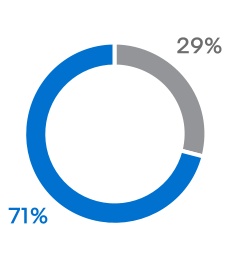
| | | | | |
n | $90,000 |
| Cash retainer |
n | $220,000 |
| Restricted Stock Units (RSUs) |
Independent Board
Chair Fee
| | | | | | | | |
RSUs in Lieu of Cash. Under the “RSUs in Lieu of Cash” program, non-employee directors can elect to receive all of their cash compensation (only 100%) in the form of RSUs (RSUs in Lieu of Cash), which generally vest one-year from the grant date. For 2023, the RSUs in Lieu of Cash were granted on May 11, 2023, taking into account the reduced cash retainer for the year. Additional RSUs in Lieu of Cash were granted on November 30, 2023 to impacted non-employee directors, representing the fact that the cash retainer for the period October 1, 2023 to fiscal year-end was not subject to the 25% reduction and was paid at 100%. These additional RSUs in Lieu of Cash vest at the same time as the other RSUs in Lieu of Cash granted in May 2023. Annual Equity Awards. Each non-employee director re-elected in 2023 received annual grants of RSUs with the above approximate target value on the grant date. The RSU’s fair value for accounting purposes is discounted for the present value of dividends not paid prior to vesting. The RSUs’ grant date and vesting align with the intended Board service, from election at the annual stockholders’ meeting (ASM) to the date that is the earlier of the one-year anniversary of the grant date or next ASM. All unvested RSU shares are payable upon retirement from the Board if a director is 75 years old (or 72 years for RSU awards granted before May 2022) or has at least seven years of Board service. Unvested RSUs do not accrue dividend equivalent rights. | | |
| Non-Employee Director Stock Ownership Guidelines ≥5x of annual cash retainer within five years of joining the Board; includes deferred RSUs once vested but not unvested RSUs As of December 30, 2023, all non-employee directors met the guidelines or still had time to do so. |
|
|
| |
| |
| | |
Deferred Compensation Program. Non-employee directors can defer their cash and equity compensation. Under the cash deferral program, directors may: defer up to 100% of their cash compensation and receive an investment return on the deferred funds as if they were invested in Intel common stock; and receive credit for dividends reinvested. Participants must elect irrevocably to receive the deferred funds either in a lump sum or in equal annual installments over five or 10 years, and to begin receiving distributions at retirement or at a future date not less than 24 months from the election date. This deferred cash compensation is an unsecured Intel obligation. The equity deferral program allows directors to defer the settlement of their vested equity awards until termination of service. Directors do not receive dividends on deferred vested equity awards. |
Corporate Governance Matters
Director Compensation Table
The following table details our non-employee directors’ compensation for fiscal year (FY) 2023 and the outstanding equity awards held at fiscal year-end (FYE) 2023 by the non-employee directors who served during such period, which excludes Stacy J. Smith who was appointed on March 12, 2024. Market value is determined by multiplying the number of shares by the Intel common stock closing price on Nasdaq on the last trading day of the FY unless otherwise specified.
| | | | | | | | | | | | | | | | | | | | | | | |
| | Total Compensation for FY 2023 | Outstanding Equity Awards at FYE 2023 |
| Name | | Fees Earned
or Paid in Cash
($) | Stock
Awards
($) | All Other
Compensation
($) | Total
($) | Outstanding Equity Awards
(#) | Market Value of
Outstanding Equity Awards
($) |
| James J. Goetz | | — | | 374,400 | | — | | 374,400 | | 13,135 | | 660,000 | |
| Andrea J. Goldsmith | | 91,900 | | 205,700 | | — | | 297,600 | | 7,152 | | 359,400 | |
| Alyssa H. Henry | | — | | 372,100 | | — | | 372,100 | | 13,069 | | 656,700 | |
| Omar Ishrak | | 132,000 | | 205,700 | | 2,000 | | 339,700 | | 7,152 | | 359,400 | |
| Risa Lavizzo-Mourey | | 121,900 | | 205,700 | | — | | 327,600 | | 13,298 | | 668,200 | |
| Tsu-Jae King Liu | | 76,900 | | 205,700 | | — | | 282,600 | | 7,152 | | 359,400 | |
| Barbara G. Novick | | — | | 387,600 | | 2,000 | | 389,600 | | 10,419 | | 523,600 | |
| Gregory D. Smith | | 111,900 | | 205,700 | | 2,000 | | 319,600 | | 26,111 | | 1,312,100 | |
| Lip-Bu Tan | | — | | 791,500 | | — | | 791,500 | | 24,462 | | 1,229,200 | |
| Dion J. Weisler | | — | | 409,500 | | — | | 409,500 | | 14,401 | | 723,700 | |
| Frank D. Yeary | | 246,400 | | 205,700 | | — | | 452,100 | | 25,603 | | 1,286,600 | |
| | | | | | | |
Fees Earned or Paid in Cash & Stock Awards. Dr. Andrea J. Goldsmith, Gregory D. Smith, and Frank D. Yeary deferred their 2023 annual cash compensation until their retirement from the Board.
Barbara G. Novick was granted an annual equity award of 3,174 RSUs on January 30, 2023 in connection with her appointment to the Board on December 2022 with a grant date fair value computed in accordance with Financial Accounting Standards Board Accounting Standards Codification (ASC) Topic 718 and an assumed 4.77% risk-free rate of return and a 5.20% dividend yield.
With respect to the annual equity award to all directors on May 11, 2023 of 7,152 RSUs, the grant date fair value was computed in accordance with ASC Topic 718 and an assumed 4.98% risk-free rate of return and a 1.71% dividend yield.
With respect to directors who elected RSUs in Lieu of Cash, the grant date fair value of the awards granted on the following dates were computed in accordance with ASC Topic 718 and the following assumptions:
▪for 2022 annual cash fees, RSUs were granted on January 30, 2023 to James J. Goetz (3,203), Alyssa H. Henry (3,462), Lip-Bu Tan (779), and Dion J. Weisler (3,982), with a 4.77% risk-free rate of return and a 5.20% dividend yield;
▪for 2023 annual cash fees , RSUs were granted on May 11, 2023 to James J. Goetz (2,642), Alyssa H. Henry (2,317), Barbara G. Novick (3,129), Lip-Bu Tan (2,317), and Dion J. Weisler (3,129), with a 4.98% risk-free rate of return and a 1.71% dividend yield; and
▪for 2023 additional annual cash fees (additional cash fees for fourth quarter 2023 resulting from Austerity Measures ending on September 30, 2023), RSUs were granted on November 30, 2023 to James J. Goetz (138), Alyssa H. Henry (138), Barbara G. Novick (138), Lip-Bu Tan (138), and Dion J. Weisler (138) with a 5.46% risk-free rate of return and a 1.12% dividend yield.
In consideration for substantial additional responsibilities he assumed at the request of the Board, Lip-Bu Tan received an additional RSU award granted in two installments. Because of Mr. Tan's extensive semiconductor industry experience as well as significant senior leadership, financial and investment, sales and marketing, and human capital expertise, the Board requested Mr. Tan provide expanded oversight and engagement with Intel Foundry for a period of 12 months. This additional time commitment from Mr. Tan comes during a time when the company seeks to accelerate its transition to an internal foundry business model and transform Intel Foundry into a world -class, full-service technology, manufacturing, and systems foundry. Mr. Tan's additional responsibilities include advising and providing guidance to the company's CEO and Intel Foundry leadership on: (i) strategy and key focus areas within Intel Foundry; (ii) customer and service centricity and outside-in perspectives thereof; (iii) key customer and supplier engagements to establish a vibrant ecosystem in support of the Intel Foundry business; (iv) the Intel Foundry talent pipeline and development; (v) external financial perspectives of Intel Foundry’s income statement; and (vi) other matters relating to the Intel Foundry business that may be requested from time to time by the Chair of the Board. He received the first installment of 14,076 RSUs on October 30, 2023 (with the grant date fair value computed in accordance with ASC Topic 718 and assuming a 5.54% risk-free rate of return and a 1.41% dividend yield), which is in addition to his annual director compensation. The second installment of the RSU award was granted to Mr. Tan on January 30, 2024 and will be disclosed in next year's Director Compensation Table for Fiscal Year 2024.
All Other Compensation. Represents matching charitable contributions from the Intel Foundation on behalf of each noted director to schools and universities that meet the guidelines of Intel’s employee charitable matching gift program and are eligible for matching funds.
Outstanding Equity Awards. Includes (i) unvested RSUs and (ii) vested but deferred equity awards for the following directors: Frank D. Yeary (18,451), Gregory D. Smith (18,959), and Dr. Risa Lavizzo-Mourey (6,146). Awards in this column may become payable upon the director’s retirement from the Board, depending on the director’s age or length of service.
Corporate Governance Matters
Certain Relationships and Related Transactions
The Board’s Audit Committee is responsible for the review, approval, or ratification of “related-person transactions” involving Intel or its subsidiaries and related persons (i.e., a director, executive officer, director nominee since the beginning of the previous fiscal year, or a greater than 5% company beneficial owner at the time of the applicable transaction, and their immediate family members). Intel has written policies and procedures applicable to any transaction or series of transactions in which the company or a subsidiary participates, the amount involved exceeds $120,000, and a related person has a direct or indirect material interest.
Review Process. Intel personnel in the Legal and Finance departments review transactions involving related persons that are not included in one of the pre-cleared transaction categories listed in “Appendix C: Independence Related Matters; Related Party Transactions” on page C-1. If they determine that a related person could have a significant interest in such a transaction, information regarding the transaction is shared with the Audit Committee for review. The committee determines whether the related person has a material interest in a transaction and may approve, ratify, rescind, or take other action with respect to the transaction in its discretion. For additional information with respect to the list of transactions that have been pre-cleared as not involving material interests see “Appendix C: Independence Related Matters; Related Party Transactions” on page C-1. The Audit Committee reviews all material facts related to the transaction and takes into account, among other factors it deems appropriate, whether the transaction is on terms no more favorable than terms generally available to an unaffiliated third party under the same or similar circumstances; the extent of the related person’s interest in the transaction; and, if applicable, the availability of other sources of comparable products or services. Transactions in 2023. Since the beginning of 2023, the only related-person transactions under the relevant standards are the following, which were reviewed and approved by the Audit Committee:
▪Nicole Schlappi, the sister of Michelle Johnston Holthaus, the company’s Executive Vice President and GM of CCG, is employed by the company as a non-technical program manager. In fiscal year 2023, the aggregate compensation paid to Nicole Schlappi, including base salary, incentive compensation, and long-term incentive equity awards was approximately $252,900. We compensate this individual in a manner consistent with our practices that apply to other similarly situated company employees.
Corporate Governance Matters
Security Ownership of Certain Beneficial Owners and Management
The following table presents the beneficial ownership of our common stock by beneficial owners of more than 5% of our common stock, each of our directors (including Stacy J. Smith who was appointed to the Board on March 12, 2024), our NEOs, and all of our current directors and executive officers as a group. This information is as of March 1, 2024, except beneficial ownership information for Stacy J. Smith that is shown as of March 12, 2024, his Board appointment date, and except as otherwise indicated below. Amounts reported under “Shares Beneficially Owned” include the number of shares subject to RSUs and stock options that become exercisable or vest within 60 days of such date (which are shown in the paragraphs that follow). Our NEOs are the four current executive officers and one former executive officer identified below in the “Compensation Discussion and Analysis” section of this proxy statement.
Except as otherwise indicated and subject to applicable community property laws, each owner has sole voting and investment power with respect to the securities listed.
| | | | | | | | |
Directors (not NEOs) | Shares Beneficially Owned | Percentage of Class |
| James J. Goetz | 213,606 | | * |
| Andrea J. Goldsmith | 7,621 | | * |
| Alyssa Henry | 36,356 | | * |
| Omar Ishrak | 54,858 | | * |
| Risa Lavizzo-Mourey | 28,766 | | * |
| Tsu-Jae King Liu | 27,472 | | * |
| Barbara G. Novick | 3,174 | | * |
| Gregory D. Smith | 34,162 | | * |
| Stacy J. Smith | 42,495 | | * |
| Lip-Bu Tan | 172,803 | | * |
| Dion J. Weisler | 38,043 | | * |
| Frank D. Yeary | 84,411 | | * |
| | | | | | | | |
NEOs | | |
| Patrick P. Gelsinger | 592,820 | | * |
| Michelle Johnston Holthaus | 265,011 | | * |
| Sandra L. Rivera | 325,196 | | * |
| David A. Zinsner | 133,849 | | * |
| Christoph Schell | 44,126 | | * |
| | | | | | | | |
Current Directors and Executive Officers |
| Current Directors and Executive Officers as a group (18 individuals) | 1,801,651 | | * |
| | | | | | | | |
5% Beneficial Owners | (as of December 31, 2023) |
The Vanguard Group, Inc. 100 Vanguard Blvd., Malvern, PA 19355 | 385,750,808 | | 9.06 | % |
BlackRock, Inc. 50 Hudson Yards New York, NY 10001 | 341,067,967 | | 8.01 | % |
* Less than 1%
For our directors and NEOs, the table includes
▪RSUs that vested but are deferred: Risa Lavizzo-Mourey (6,146), Gregory D. Smith (18,959), and Frank D. Yeary (18,451);
▪RSUs that will vest in 60 days: Frank D. Yeary (7,152), Patrick P. Gelsinger (19,843), Michelle Johnston Holthaus (8,119), Sandra L. Rivera (78,672), David A. Zinsner (6,502), and Christoph Schell (8,063); and
▪shares over which the named individual has shared voting and/or investment power through individual, family and/or spousal trusts or other accounts: Omar Ishrak (86), Gregory D. Smith (14,793), Stacy J. Smith (42,495), Lip-Bu Tan (166,000), Frank D. Yeary (57,998), and Patrick P. Gelsinger (488,190).
The table excludes shares of Class A common stock of Mobileye Global Inc., an Intel subsidiary, held by our directors and NEOs: James G. Goetz (100,000), Omar Ishrak (18,000), Tsu-Jae King Liu (2,500), Lip-Bu Tan (50,000), Frank D. Yeary (42,209), Patrick P. Gelsinger (129,095), Michelle Johnston Holthaus (30,000), Sandra L. Rivera (2,500), and David A. Zinsner (2,500).
For our current directors and executive officers, the table includes 131,074 RSUs that may vest in 60 days.
For our 5% beneficial owners, the table includes:
| | | | | | | | |
(# of shares) | Vanguard | BlackRock |
Sole voting power | — | | 309,980,092 | |
Shared voting power | 5,253,785 | | — | |
Sole investment power | 367,966,292 | | 341,067,967 | |
Shared investment power | 17,784,516 | | — | |
Information based solely on SEC Filing | Schedule 13G/A | Schedule 13G/A |
Filing date | February 13, 2024 | January 25, 2024 |
Audit Matters
| | | | | |
| |
Proposal 2 Ratification of Selection of Independent Registered Public Accounting Firm | ▪Robust independence controls and objectivity; high audit quality; and reasonable fees ▪Deep company-industry knowledge, experience, and expertise ▪Audit Committee annually evaluates EY and determined that EY’s retention continues to be in the best interests of Intel and its stockholders |
|
|
The Audit Committee evaluates the independent auditor selection each year and selected EY for the current year. EY has served in this role since Intel was incorporated in 1968. EY representatives attended all of the Audit Committee’s meetings in 2023 except those meetings subject to attorney-client privilege. Why We Are Asking Stockholders to Ratify Our Selection of EY As a matter of good governance, the Board submits the independent audit firm selection for stockholder ratification. If the selection is not ratified by a majority of the voted shares, the Audit Committee will review its future independent registered public accounting firm selection in light of that vote result. Even if the selection is ratified, the Audit Committee in its discretion may appoint a different firm at any time during the year if the Audit Committee determines that such a change would be appropriate. EY Independence In order to ensure continued auditor independence, the Audit Committee periodically considers whether there should be a regular rotation of our independent registered public accounting firm. The Audit Committee concluded that many factors contribute to the continued support of EY’s independence, such as oversight by the Public Company Accounting Oversight Board (PCAOB) through the establishment of audit, quality, ethics, and independence standards in addition to conducting audit inspections; the mandating of reports on internal control over financial reporting; PCAOB requirements for audit partner rotation; and limitations imposed by regulation and by the Audit Committee on non-audit services provided by EY. The Audit Committee has established, and monitors, limits on the amount of non-audit services that Intel may obtain from EY. Under the auditor independence rules, EY reviews its independence each year and delivers to the Audit Committee a letter addressing matters prescribed under those rules. Regular Rotation of Primary Engagement Partner In accordance with applicable rules on partner rotation, EY’s lead partner for our audit was changed in 2020, while EY’s engagement quality review partner for our audit was most recently changed in 2024. The Audit Committee, including the Audit Committee Chair, is involved in considering the selection of EY’s primary engagement partner when there is a rotation, which is typically every five years. The process for selecting a primary engagement partner is fulsome and allows for thoughtful consideration of multiple candidates, each of whom has met a list of specified professional, industry, and personal criteria, including among others diversity of thought and background, experience with complex global clients, and industry specific experience. The Audit Committee is involved in determining the final selection. Pre-Approval Policies The Audit Committee pre-approves and reviews audit and non-audit services performed by EY, as well as the fees charged by EY for such services. In its pre-approval and review of non-audit service fees, the Audit Committee considers, among other factors, the possible effect of the performance of such services on the auditors’ independence. |
|
|
The Board recommends that you vote “FOR” the ratification of the selection of Ernst & Young LLP (EY) as our independent registered public accounting firm for fiscal year 2024. |
|
|
Factors the Audit Committee Considered in Deciding to Re-Engage EY Include
| | | | | | | | | | | | | | |
| | | | |
Close alignment of EY’s global footprint and resources with our geographies and global business ▪EY staffing presence, depth, and expertise both across the 150 countries in which reviews are required and in the geographies with the greatest accounting/finance focus | | EY’s high audit quality, performance, and results ▪evaluations of the nature and quality of EY communications and engagement ▪quality reviews - e.g., PCAOB inspections, and peer reviews | | EY’s track record ▪accounting and auditing field competence ▪nature of legal or disciplinary actions affecting EY ▪commitment to diversity and inclusion |
| | | | |
| | | | |
| | | | |
Robust independence controls and objectivity ▪annual independence evaluations, partner rotations, and pre-approval policies and controls ▪EY’s rigorous internal independence monitoring and maintenance process; Intel account personnel adequacy assessments; and key partner (on the engagement) rotations consistent with PCAOB and SEC independence and rotation requirements ▪Audit Committee involvement in and oversight of EY independence ▪EY’s professional skepticism and objectivity shown in reports/presentations | | Benefits of longer-tenured auditor ▪enhanced audit quality: deeper institutional knowledge and expertise, better geographic overlap and limited other options due to Intel’s size, complexity, and geography ▪continuity and avoidance of switching costs: management time to bring new auditors up to speed generally, but also with respect to the hundreds of countries that require review ▪no disruption of non-audit workflows: conflicts from consulting contracts on other matters ▪competitive fees: due to efficiencies and familiarity | | EY’s deep institutional company and industry knowledge, experience, and expertise ▪EY’s and key engagement team members’ extensive professional qualifications, experience, and expertise ▪EY’s depth and breadth of understanding of the technology and semiconductor industries, and Intel’s unique business model (global integrated device manufacturer and foundry service provider), and complex accounting policies and practices |
| | | | |
| | | | |
| | | | |
Length of EY’s service ▪potential positive and negative impact on independence and objectivity ▪more effective audit plans and better EY audit service quality and productivity due to greater industry, business, segments, and policies and procedures familiarity | | Impact of engaging a new auditor ▪significant costs, time commitments, continuity disruption, and management distraction associated with bringing on and extensively educating a new auditor Appropriateness of EY’s fees ▪EY’s longer tenure offers us an efficient fee structure and more competitive fees relative to our peers as supported by benchmarking and reviews | | Non-audit service projects performed by other multinational public accounting & auditing firms ▪nature, scope, length, complexity, required knowledge, and other public accounting firm non-audit service costs ▪impact (e.g., significant disruption, lost cumulative knowledge, time to properly onboard, and higher fees) of any needed changes to such service providers from a change in our independent auditor |
| | | | |
Based on the factors listed above, the Audit Committee and Board believe that EY’s continued retention as our independent registered public accounting firm is in the company’s and our stockholders’ best interests.
EY Expected to Attend Annual Meeting
We expect an EY representative to attend the 2024 Annual Stockholders’ Meeting, to have an opportunity to make a statement if the representative so chooses, and to be available to respond to appropriate stockholders’ questions.
For additional information regarding the Audit Committee and its activities with EY, see “Corporate Governance Matters; Board Structure and Engagement; Board Committees; Audit & Finance Committee” on page 34 and “Report of the Audit & Finance Committee” on page 50.
EY’s Billed Fees for Fiscal Years 2023 and 2022 Services
The following table shows EY billed fees (net of value-added tax and other similar taxes assessed by non-US jurisdictions on EY billed amounts) for services approved per the Audit Committee’s pre-approval process described in the below report.
| | | | | | | | | | | | | | | | | |
Fiscal Year | Audit Fees ($) | Audit-related Fees ($) | Tax Fees ($) | All Other Fees ($) | Total ($) |
| 2023 | 23,999,800 | | 128,500 | | 416,000 | | 20,000 | | 24,564,300 | |
| 2022 | 18,747,000 | | 98,000 | | 1,271,000 | | 20,000 | | 20,136,000 | |
Services Associated with Fees. Audit Fees relate to professional services provided in connection with the audit of our financial statements and internal control over financial reporting, the review of our quarterly financial statements, registration statements, and audit services provided in connection with other statutory or regulatory filings. Audit-related Fees relate to the performance of the audit or review of our financial statements, and are not included in Audit Fees. Tax Fees relate to services provided for tax compliance and planning. All Other Fees relate to professional fees not included in the categories above.
Report of the Audit & Finance Committee
During 2023, only non-management directors (each determined by the Board to be independent under the Nasdaq listing standards) comprised the Audit & Finance Committee (Committee). The Committee operates under a Board-adopted written charter with a purpose to: (i) assist the Board in its general oversight of Intel’s accounting and financial reporting processes; audits of the financial statements, internal control and audit functions; compliance with legal and regulatory requirements and Intel adopted ethical standards; and (ii) represent and assist the Board in its general oversight of Intel’s: treasury activities; financing requirements; capital structure and capital allocation strategies; insurance programs; and tax strategies and compliance.
Management Responsibilities
Management is responsible for the preparation, presentation, and integrity of Intel’s financial statements; accounting and financial reporting principles; internal controls; and procedures designed to reasonably assure compliance with accounting standards, applicable laws and regulations, and the company’s ethical standards. Intel has a full-time Internal Audit department that reports to the Committee and to management that is responsible for objectively reviewing and evaluating the adequacy, effectiveness, and quality of Intel’s system of internal controls related to, for example, the reliability and integrity of Intel’s financial information and the safeguarding of Intel’s assets.
Independent Auditor Responsibilities
EY, Intel’s independent registered public accounting firm, is responsible for performing an independent audit of Intel’s consolidated financial statements in accordance with generally accepted auditing standards and expressing an opinion on the effectiveness of Intel’s internal control over financial reporting. In accordance with applicable law, the Committee has ultimate authority and responsibility for selecting, compensating, evaluating, and, when appropriate, replacing Intel’s independent audit firm, and evaluates its independence. The Committee has the authority to engage its own outside advisors, including experts in particular areas of accounting, as it determines appropriate, apart from counsel or advisors hired by management.
Committee Responsibilities
Committee members are not professional accountants or auditors, and their functions are not intended to duplicate or to certify management’s and the independent audit firm’s activities; nor can the Committee certify that the independent audit firm is “independent” under applicable rules. The Committee serves a Board-level oversight role to help establish the appropriate “tone at the top” and provide advice, counsel, and direction to management and the auditors on the basis of the information it receives, discussions with management and the auditors, and the experience of Committee members in business, financial, and accounting matters.
Committee Oversight of Financial Reporting
The Committee’s annual agenda includes reviewing Intel’s financial statements, internal control over financial reporting, and audit and other matters. The Committee meets quarterly with EY, Intel’s Chief Audit Executive (CAE), and management to review Intel’s interim financial results (including the use of any non-GAAP measures) before the publication of Intel’s quarterly earnings releases. Management’s and the independent audit firm’s presentations to, and discussions with, the Committee cover various topics and events that may have significant financial impact or are the subject of discussions between management and the independent audit firm (including, for example, significant accounting policy changes). The Committee reviews and discusses with management and the CAE Intel’s major financial risk exposures and the steps management has taken to monitor and control such exposures. In accordance with applicable law, the Committee is responsible for establishing procedures for the receipt, retention, and treatment of Intel received complaints regarding accounting, internal accounting controls, or auditing matters, including confidential, anonymous Intel employee submissions, received through established procedures, of any concerns regarding questionable accounting or auditing matters.
Committee Oversight of Internal Auditor and Independent Audit Firm
Among other matters, the Committee monitors the activities and performance of Intel’s internal auditors and independent registered public accounting firm, including the audit scope, external audit fees, auditor independence matters, and the extent to which the independent audit firm can be retained to perform non-audit services.
In accordance with Committee policy and legal requirements, the Committee pre-approves all services to be provided by EY, including audit services, audit-related services, tax services, and other services. In some cases, the full Committee provides pre-approval for as long as a year related to a particular category of service, or a particular defined scope of work subject to a specific budget. In other cases, the Committee has delegated authority to its chair to pre-approve additional services, and the chair then communicates such pre-approvals to the full Committee. The Committee is responsible for overseeing the fee negotiations associated with the retention of our independent audit firm. The Committee believes that the continued retention of EY as our independent audit firm is in the best interests of our stockholders.
Committee Oversight of Internal Control Over Financial Reporting
The Committee has reviewed and discussed with management our management’s assessment of and report on the effectiveness of Intel’s internal control over financial reporting as of December 30, 2023, which it made based on criteria established in Internal Control—Integrated Framework issued by the Committee of Sponsoring Organizations of the Treadway Commission (2013 framework). The Committee also has reviewed and discussed with EY its review and report on Intel’s internal control over financial reporting. Intel published these reports in its 2023 Annual Report on Form 10-K, which Intel filed with the SEC on January 26, 2024.
Required Committee Discussions and Communications
The Committee has reviewed and discussed the audited financial statements for fiscal year 2023 with management and EY, and management represented to the Committee that Intel’s audited financial statements were prepared in accordance with US generally accepted accounting principles. In addition, the Committee has discussed with EY, and EY represented that its presentations to the Committee included, the matters required to be discussed with the independent registered public accounting firm by applicable PCAOB and SEC rules. This review included a discussion with management and EY of the quality, not merely the acceptability, of Intel’s accounting policies, the reasonableness of significant estimates and judgments, and the clarity of disclosure in Intel’s financial statements, including the disclosures related to critical accounting estimates and critical audit matters. EY has provided the Committee with the written disclosures and the letter required by the PCAOB regarding the independent accountant’s communications with the Committee concerning independence, and the Committee has discussed with the independent audit firm and management that firm’s independence.
Recommendation
In reliance on these reviews and discussions, and EY’s reports, the Committee recommended to the Board, and the Board approved, the audited financial statements’ inclusion in Intel’s 2023 Annual Report on Form 10-K.
Audit & Finance Committee, as of February 15, 2024
| | | | | | | | | | | |
Gregory D. Smith, Chair | Andrea J. Goldsmith | Omar Ishrak | Barbara G. Novick |
Compensation Matters
| | | | | |
| |
Proposal 3 Advisory Vote to Approve Executive Compensation of Our Named Executive Officers (NEOs) | Best Practices ▪Our executive compensation programs are tied to financial and operational performance metrics that further short- and long-term strategic objectives and support our commitment to strong compensation governance. ▪The Talent and Compensation Committee (Compensation Committee) led a comprehensive stockholder engagement program around compensation. ▪The Board is committed to on-going, constructive dialogue with our stockholders regarding our executive compensation programs. |
|
|
We are asking stockholders to approve, on an advisory basis, the executive compensation of Intel’s NEOs disclosed in the “Compensation Discussion and Analysis,” “Executive Compensation Tables,” and the related notes, and narrative in this proxy statement on pages 55-93. Background Intel voluntarily began providing stockholders with an advisory Say-on-Pay vote on executive compensation as early as 2009. Section 14A of the Securities Exchange Act of 1934, as amended (Exchange Act), made this practice mandatory for US public companies starting in 2011. At Intel’s 2023 Annual Stockholders’ Meeting, a majority of our stockholders voted in favor of holding an advisory vote to approve the executive compensation of our NEOs every year. The Board considered these voting results and decided to adopt (and maintain) a policy providing for an annual advisory stockholder vote to approve our NEOs’ compensation. We are therefore holding this year’s advisory vote in accordance with this policy. Why You Should Support This Proposal Intel’s executive compensation programs are designed to support our business goals and promote our short-term and long‑term profitable growth. Intel’s equity plans are intended to align the compensation of our NEOs with the long‑term interests of our stockholders. We encourage stockholders to read the “Compensation Discussion and Analysis” section of this proxy statement, which describes in more detail how our executive compensation policies and practices operate and are designed to achieve our compensation objectives. We also encourage our stockholders to review the Summary Compensation Table and other related compensation tables and narratives, which provide detailed information on the compensation of our NEOs. The Board and the Compensation Committee believe that the policies and practices described and explained in the “Compensation Discussion and Analysis” reflect our competitive pay positioning strategy, emphasis on incentive-driven pay, and effective use of goals aligned with our business strategy. The compensation of our NEOs reported in this proxy statement is appropriately tied to our financial, operational, and stock price performance, supports our commitment to strong compensation governance, and provides market-based opportunities to attract, retain, and motivate our executive officers in an intensely competitive market for qualified talent. How We Consider Stockholder Feedback Although this advisory vote to approve the executive compensation of our NEOs is non-binding, the Compensation Committee will carefully assess the voting results. The “Compensation Discussion and Analysis” in this proxy statement discusses our stockholder engagement efforts over the past year and reflects our commitment to consult directly with stockholders to better understand any significant views expressed in the context of matters voted upon at our annual stockholders’ meetings. Unless the Board modifies its policy on frequency of holding Say-on-Pay advisory votes, the next Say-on-Pay advisory vote will occur at the 2025 Annual Stockholders’ Meeting. |
|
|
The Board recommends that you vote “FOR” approval of the executive compensation of Intel’s NEOs on an advisory basis. |
|
|
Letter from the Talent and Compensation Committee
Dear Fellow Stockholders,
The Talent and Compensation Committee of the Board (Compensation Committee), along with the entire Board, was pleased to see our Say-on-Pay vote pass with 91.2% support at the 2023 Annual Stockholders’ Meeting. This result followed a detailed and comprehensive series of engagements with our stockholders, culminating in responsive changes to our executive compensation programs that were introduced in late 2022. We are confident that this result indicates that our executive compensation programs meet investor expectations, and we commit to continue including the feedback of our stockholders as we design and employ our executive compensation programs.
We would like to share our perspective on the environment in which we operated during fiscal year 2023 and how that impacted our compensation decisions and incentive outcomes, which will provide important context for the full Compensation Discussion and Analysis that follows.
Strong Performance in a Challenging Environment
Intel faced a difficult operating and macroeconomic environment entering 2023, with multiple factors driving uncertainty and heightened risk globally. We anticipated continued impacts on Intel both directly and in the context of these broader forces on our customers and suppliers. Given the challenges faced by the company and our industry due to material weakness in our PC and data center markets driven by industry-wide inventory corrections, the Compensation Committee set financial targets for several metrics in our incentive plans at levels that, while rigorous, were lower than our actual results in 2022. Targets were set based on our operating plan, the broader macroeconomic environment, and the expectations of our stockholders, and the Compensation Committee is confident that the goals set a high bar for achievement and properly incentivized our executives to drive outperformance.
We were greatly pleased that these demanding standards translated into strong corporate performance in 2023 despite the challenging environment. Through the hard work of the entire Intel team, the company delivered on multiple fronts throughout 2023 by executing on key milestones towards achieving our strategy to re-establish our process leadership, building out our capacity and foundry plans, improving product execution, and beginning to bring AI everywhere across our product segments. These actions were recognized by investors and translated directly into value for our stockholders, reflected in our TSR of 94.6% for the year.
As a result, our annual incentive program paid out at 98.29% for our Chief Executive Officer (CEO) and an average of 101.38% for our other named executive officers (NEOs), with payouts varying for our non-CEO NEOs due to the inclusion of individual performance goals. However, the PSUs granted in 2021 to be earned based on 2021-2023 performance were not earned. These divergent outcomes accurately reflect our strong 2023 performance in the context of a difficult three-year period, and the link between our pay outcomes, our performance, and the experience of our stockholders, which indicates to us that our compensation design is working as intended. We believe that our success in 2023 positions us well to continue to deliver results for our stockholders.
Letter from the Talent and Compensation Committee
Positioning Intel for the Long-Term
Cost reduction and cash preservation were two of our top strategic goals for the year. In an effort to reduce costs across the company in 2023, we made the difficult decision to implement reductions to our 2023 employee compensation. These reductions were designed to most significantly impact our executives. Notably, these included a 25% base salary reduction for our CEO and a 15% base salary reduction for our other NEOs, for the period from March 1, 2023 through September 30, 2023. These reductions also had the effect of lowering 2023 target bonuses for our executives, which are calculated as a function of base salary paid. In addition, the Board decided to temporarily reduce the cash retainer portion of our directors’ fees by 25%, and our Board Chair Frank Yeary also decided to temporarily reduce his additional Chair cash retainer fee by 25%. Effective October 1, 2023, we restored our NEOs’ base salaries and director cash retainers to the levels in place at the beginning of the year. In recognition of the efforts and sacrifices of our employees, we granted “Austerity RSU” awards to impacted employees (other than the CEO) in December 2023. The Compensation Committee believes that these actions, in the aggregate, have positioned the company to continue building on our strong momentum, by being thoughtful about our overall spend while also investing in the talent that is going to drive Intel forward.
Continued Engagement with Stockholders
We were pleased to see high support for our 2023 Say-on-Pay proposal. We believe this is a direct function of our history of stockholder engagement and our consideration of stockholder concerns when designing our executive compensation programs. Following the 2023 Annual Stockholders’ Meeting, we again conducted comprehensive stockholder engagement on executive compensation and other key topics, reaching out to and meeting with a significant number of our institutional stockholders. As in years past, our Board Chair, Frank Yeary, and/or our Compensation Committee Chair, Dion Weisler, led a substantial number of these meetings. The feedback received in these meetings was shared with the full Compensation Committee and the Board, and served as valuable input for Board discussions.
As we continue to make progress with our IDM 2.0 strategy, we see compensation as a key component in attracting, retaining, and incentivizing our executives talent. The talent market remains fiercely competitive, and a strong compensation design is an important factor in the retention of key talent to deliver results for our stockholders. We look forward to our ongoing dialogue and maintaining executive compensation programs that are responsive to your feedback and aligned with your expectations.
Sincerely,
The Talent and Compensation Committee
| | | | | | | | |
| | Dion J. Weisler Chair |
| | |
| | James J. Goetz Member |
| | |
| | Alyssa H. Henry Member (effective February 1, 2024) |
| | |
| | Risa Lavizzo-Mourey Member |
| | |
| | Barbara G. Novick Former Member (through January 31, 2024) |
Compensation Discussion and Analysis
This section of the proxy statement explains how the Talent and Compensation Committee (Compensation Committee) oversees our executive compensation programs, and discusses the compensation earned by Intel’s named executive officers (NEOs), as presented in the “Executive Compensation Tables” section.
This Compensation Discussion and Analysis has been organized into three sections:
▪Executive Summary—Provides an overview of our executive compensation programs, highlighting:
▪Stockholder engagement. Building on momentum from our successful 2023 Annual Stockholders’ Meeting and track record of engagement and open communication, the Compensation Committee led a comprehensive stockholder engagement program to proactively seek feedback on our executive compensation programs; we continue to consider stockholder feedback as a key input in our decision making process.
▪2023 austerity measures addressed macroeconomic headwinds. Our CEO’s and other NEOs’ base salaries were reduced 25% and 15%, respectively, for the period from March 1, 2023 through September 30, 2023 alongside reductions for other employees, reflecting the need to cut costs in the current operating environment; and our NEOs, other than our CEO, were granted additional restricted stock units (RSUs) to make up for the forgone compensation once the company succeeded in its broader cost-saving initiatives.
▪Pay-for-performance alignment. Our executive compensation programs are designed to link pay to performance and recent performance-based pay outcomes demonstrate our commitment to pay for performance: our performance stock units (PSUs) granted in 2021 (with a three-year performance period ending at the end of fiscal year 2023), tied to goals set before changes to our leadership and the establishment of our transformation strategy, did not pay out; our annual cash bonus plan paid out at 98.29% for our CEO and an average of 101.38% for our other NEOs, reflecting strong annual performance in a challenging macroeconomic environment; and the performance-based components of our CEO new-hire equity awards currently have no “in the money” value because the grants are tied to stock price achievement targets that have not been reached.
▪2023 Compensation of Our NEOs—Details our compensation philosophy and framework, design of pay programs that tie pay and performance, and individual compensation of our NEOs and 2023 pay outcomes.
▪Other Aspects of Our Executive Compensation Programs—Provides details on other policies and practices related to our 2023 executive compensation programs.
2023 NEOs
| | | | | |
| Patrick P. Gelsinger Chief Executive Officer (CEO) |
| |
| Michelle Johnston Holthaus Executive Vice President and General Manager (GM), Client Computing Group (CCG) |
| |
| Sandra L. Rivera Former Executive Vice President and GM, Data Center and AI Group (DCAI) (through 2023 fiscal year-end) |
| |
| David A. Zinsner Executive Vice President and Chief Financial Officer (CFO) |
| |
| Christoph Schell Executive Vice President, Chief Commercial Officer (CCO), and GM, Sales, Marketing and Communications Group (SMG) |
Compensation Discussion and Analysis
Executive Summary
Business Performance
The graphs below show our turnaround progress under our CEO’s leadership as measured by three-year and one-year TSR performance:
Three- and One-Year Total Stockholder Return (TSR)
| | | | | |
Three-Year TSR Reflects Turnaround Under Pat Gelsinger's Leadership | One-Year TSR Reflects Our Execution Amidst a Challenging Environment |
| |
| | | | | | | | | | | | | | | | | | | | | | | |
n | Intel | | n | S&P 500 | | n | S&P 500 IT |
2023
Heading into the year, all our markets were being impacted to various degrees by macro uncertainty, rising interest rates, geopolitical tensions in Europe, and COVID impacts in Asia, especially China. These challenging conditions faced by the company and our industry were predicted to continue throughout the year, with the possibility of some improvement in the second half.
We exceeded expectations for four quarters in a row in 2023 and consistently executed on our plan to re-establish process leadership, further built out our capacity and foundry plans, greatly improved product execution, and began to execute on our mission to bring AI everywhere across our product segments. The company made significant progress towards our “IDM 2.0” strategy, including strong execution against our 2023 financial commitments, despite macroeconomic headwinds. As committed at our first-quarter 2023 earnings call, we delivered revenue, gross margin, operating margin, and EPS growth each quarter. Despite significant investments in future growth and continued progression through our five nodes in four years strategy, we achieved our 2023 commitment of $3 billion of cost savings.
2023 vs. 2022
Results shown below are our reported GAAP results:
| | | | | | | | | | | | | | |
| 2023 | 2022 | Change |
| Revenue | $54.2 billion | | $63.1 billion | down 14% |
| Gross margin | 40.0 | % | | 42.6 | % | down 2.6 ppts |
| Operating income | $93 million | | $2.3 billion | down 96% |
| Net income attributable to Intel | $1.7 billion | | $8.0 billion | down 79% |
| Earnings per share attributable to Intel—diluted | $0.40 | | | $1.94 | down 79% |
For key highlights of the results of our operations, see “Our Financial Highlights” on page 9. In addition, details regarding our corporate social responsibility efforts can be found in “Corporate Responsibility Initiatives” on page 10 and “Human Capital Management” on page 11.
Compensation Discussion and Analysis
2023 Say-on-Pay Vote and Stockholder Engagement
At our 2023 Annual Stockholders’ Meeting, we were pleased that our Say-on-Pay vote received over 91% support after extensive efforts to implement stockholder feedback in 2022. We continue to prioritize regular dialogue with our stockholders through a year-round engagement cycle. In 2023, we engaged with stockholders in the Spring leading up to our 2023 Annual Stockholders’ Meeting, and again in the Fall. Outreach was led by our Board Chair and/or our Compensation Committee Chair, supported by our Chief People Officer, Investor Relations, Corporate Secretary Office, Total Rewards, and Corporate Responsibility Office. Details on our engagements in 2023 are shown in the table below.
| | | | | | | | | | | | | | |
Who we met with in 2023 Regular Engagement |
| | | | |
Total Contacted | | Total Engaged | | Director Engaged |
~68% | 36 | ~49% | 34 | ~48% |
Inst O/S | stockholders | Inst O/S | separate meetings | Inst O/S |
Percentage of Inst O/S, or Intel’s institutionally held shares, was calculated as of September 30, 2023.
In the Spring, our efforts were focused on confirming we had adequately addressed stockholders’ concerns regarding executive compensation and the responsive actions we have taken to further align our compensation programs with stockholders’ long-term interests. We were pleased to see this result in strong support for our 2023 Say-on-Pay proposal, and that in the subsequent Fall engagement discussions, stockholder feedback on compensation was positive and acknowledged our strong executive compensation program design, as well as the recent responsive actions we have taken, such as increasing PSU weighting, removing NEOs’ eligibility to participate in our broad-based quarterly performance bonus program, and both increasing the rigor of our CEO’s new hire awards and making them more challenging to achieve. While our stockholder base is diverse and has varying perspectives on many issues, our stockholders were generally supportive of our current program design, and there were no common requests for changes to our executive compensation programs. Due to this widespread support of our compensation practices, stockholders instead sought to focus the majority of these Fall meetings on other topics. A few refinements were nevertheless made to our programs for 2024 to align compensation to our strategy, strengthen our pay-for-performance linkage, and provide further alignment with stockholders’ long-term interests, the details for which are described under “2024 NEO Compensation Program Changes” on page 75. Detail on all feedback received in stockholder engagements, including items unrelated to compensation, is included in “Stockholder Engagement” on page 36. We look forward to continuing an ongoing dialogue on compensation, and greatly value stockholders’ feedback. 2023 NEO Pay Overview
Intel’s Austerity Measures
In early 2023, we took decisive steps to help navigate macroeconomic headwinds as part of our long-term strategy while still protecting investments critical to our long-term strategy. This included making a commitment to deliver $3 billion in cost savings to meaningfully reduce the ongoing cost base of the company as well as implementing temporary austerity measures (Austerity Measures) to preserve cash. In an effort to reduce costs across the company, we made several adjustments to our 2023 employee pay and compensation programs, which were designed to most significantly affect the executive population, including our NEOs.
The specific Austerity Measures implemented in 2023 include the following:
▪Base salaries were reduced for exempt employees for the period from March 1, 2023 through September 30, 2023, with our CEO’s and other NEOs’ base salaries reduced 25% and 15%, respectively;
▪The broad-based quarterly performance bonus program (QPB) was suspended for the first two quarters of the year (our NEOs were not eligible to participate in the QPB);
▪Target annual bonus opportunities were reduced as a result of the reductions in 2023 base salaries; and
▪The US 401(k) match was reduced from 5% to 2.5%, from March 1, 2023 through the end of the year.
In addition, the Board decided to temporarily reduce the cash retainer portion of their directors’ fees by 25%, and the Board Chair Frank Yeary also decided to temporarily reduce his additional Chair cash retainer fee by 25%.
Effective October 1, 2023, we restored base salaries for all impacted employees, including our NEOs, and director cash retainers to the levels in place at the beginning of the year. We were able to effectuate this before year-end because we returned to profitability and were strongly on track to meet our cost-saving goal at the time the decision was made; we ultimately achieved that goal.
Compensation Discussion and Analysis
In recognition of our employees’ contributions and sacrifices in 2023 in connection with the Austerity Measures and as a reward for their commitment to Intel, employees, including our NEOs other than our CEO, were granted additional RSU awards in December 2023 with a value designed to offset the forgone base salary and bonus. The RSU awards vest in full on the one-year anniversary of the grant date. For additional details on these RSU awards, see “Austerity RSU Awards” on page 75. 2023 Elements of Pay
The following table lists the pay elements of our 2023 programs and the purpose each served:
| | | | | | | | | | | | | | | | | | | | |
| Pay Element | Purpose | 2023 Austerity Measures | Performance Period | 2023 Performance Metric |
| | | | | | |
Base Salary | Designed to be market-competitive and attract and retain talent | Our CEO’s and other NEOs’ base salaries were reduced 25% and 15%, respectively, for the period from 3/1/2023 through 9/30/2023 | Annual | — |
| | | | | | |
| Annual Cash Bonus | Incentivize achievement of Intel’s near-term financial and operational objectives, consistent with Intel’s longer-term goals | 2023 base salary reductions decreased each NEO’s target bonus opportunity | Annual | New metric mix for 2023: For CEO: ▪Revenue (25%) ▪Gross Margin Percentage (25%) ▪Spending Reduction Goal (25%) ▪One Intel Operational Goals (25%) For other NEOs: ▪Same four metrics that apply to CEO (each 20%), plus ▪Individual Objectives and Key Results (20%) |
| | | | | |
| | | | | |
Performance Stock Units (PSUs) (80% of long-term incentive (LTI) mix for CEO, 60% for other NEOs) | Designed to reward long-term profitability and long-term performance relative to peers, create alignment with stockholders, and facilitate executive retention | | Three Years | ▪Revenue growth percentage (weighted 60%) ▪Cash flow from operations (weighted 40%) ▪Three-year TSR modifier relative to S&P 500 Index (+/- 25 percentage points (ppts)) ▪Three-year Revenue CAGR modifier (+/- 25 ppts) ▪Cap at target if our TSR negative |
| | | | | |
| | | | | |
Restricted Stock Units (RSUs) (20% of LTI mix for CEO, 40% for other NEOs) | Facilitates stock ownership, executive retention, and stockholder alignment | | Over Three Years (with annual vesting) | ▪Stock Price |
| | | | | | |
Long-Term Incentive Equity Award Values Stayed Consistent Year-Over-Year
The Compensation Committee reviews the NEO compensation practices of companies in our peer group to inform its determination of NEO pay structure and target compensation values with support from its independent compensation consultant, Semler Brossy. In 2023, there were no changes to our NEOs’ annual target LTI equity award values, which were maintained at the same level as 2022. In response to stockholder feedback, the Compensation Committee changed the LTI mix for 2023 of our NEOs (other than our CEO) to be more performance based such that the LTI awards were granted 60% in the form of PSUs and 40% in the form of RSUs. Our CEO continued to receive 80% of his LTI award in the form of PSUs.
Compensation Discussion and Analysis
The table below shows each NEO’s annual target LTI values for 2022 and 2023:
NEO Annual Target LTI Values
| | | | | | | | | | | | | | |
Name | Year | Restricted Stock Units ($) | Performance Stock Units ($) | Total ($) |
| Patrick P. Gelsinger | 2023 | 4,300,000 | 17,200,000 | 21,500,000 |
| 2022 | 4,300,000 | 17,200,000 | 21,500,000 |
| Michelle Johnston Holthaus | 2023 | 4,120,000 | 6,180,000 | 10,300,000 |
| 2022 | 5,150,000 | 5,150,000 | 10,300,000 |
| Sandra L. Rivera | 2023 | 4,120,000 | 6,180,000 | 10,300,000 |
| 2022 | 5,150,000 | 5,150,000 | 10,300,000 |
| David A. Zinsner | 2023 | 3,300,000 | 4,950,000 | 8,250,000 |
| 2022 | 4,125,000 | 4,125,000 | 8,250,000 |
| Christoph Schell | 2023 | 3,720,000 | 5,580,000 | 9,300,000 |
| 2022 | 4,650,000 | 4,650,000 | 9,300,000 |
The design of our PSU program also remained unchanged from 2022 to 2023: the Compensation Committee sets the goals for the revenue growth percentage and CFFO financial metrics annually, and there are two modifiers (relative TSR and revenue compounded annual growth rate (CAGR)) with three-year goals that can each impact the two financial metric results plus or minus 25 points at the end of the three-year performance period. The LTI target values set forth above differ from the amounts shown in the Summary Compensation Table and Grant of Plan Based Awards Table for 2023 below due to the SEC rules and accounting standards and its treatment of this PSU design, which require us to report the value of our PSUs in the year in which the performance goals were set by the Compensation Committee, rather than the year in which the awards were initially approved. Accordingly, the Summary Compensation Table and Grant of Plan Based Awards Table for 2023 under reports the grant values the Compensation Committee established for the 2022 PSUs and 2023 PSUs. Additionally, the value of the RSUs set forth above differs from the amounts included in the Summary Compensation Table and Grant of Plan Based Awards Table for 2023 because the amount included in such tables under SEC rules and accounting standards is based on the grant date fair value of our common stock on the date of grant reduced by the lack of dividends on unvested RSUs. Thus, the Compensation Committee feels that the target LTI value table above is a more accurate reflection of the established LTI values granted in each year to our NEOs.
2023 Incentive Program Results
As discussed in greater detail in “2023 Compensation of Our NEOs” on page 61, our 2023 executive compensation programs were structured to provide strong pay-for-performance alignment as evidenced by recent payouts. As shown on the following table, below-target performance on revenue and gross margin percentage combined with meeting the spend reduction goal and above-target operational performance contributed to annual cash bonus payouts near target, and strong performance on net cash provided by operating activities (cash flow from operations, or CFFO) contributed to above-target results for year 2023 of the three-year performance period for the 2022 PSUs and 2023 PSUs. None of the PSUs granted in 2021 with a three-year performance period paid out at the end of the performance period in 2023 as a result of below-threshold performance on the two financial metrics, relative TSR and EPS growth percentage. | | | | | | | | | | | | | | |
| Pay Element | | 2023 Results | | Performance Summary |
| | | | |
2023 Annual Cash Bonus | | 98.29% CEO | | CEO and other NEOs. Payout reflects (i) below-target financial results for revenue and gross margin; (ii) meeting spend reduction goal of $3B; and (iii) performance achieved at 118.04% on One Intel operational goals, excluding the RISE 2030 scores (see “One Intel Operational Goals” on page 66 for more detail) |
| | | | |
| | 101.38% Average for Other NEOs | | Other NEOs. Also reflects performance achieved at an average of 113.75% for individual objectives and key results that place greater emphasis on achieving long-term strategic transformation initiatives rather than achieving annual financial targets (see “Individual Performance Goals” on page 69 for more detail) |
| | | | |
PSUs Granted in 2021 (vest date 1/31/2024) | | 0% | | Payout at 0% of target reflects below-threshold performance for both of Intel’s three-year relative TSR (weighted 50%) and Intel’s three-year EPS growth rate percentage (weighted 50%) |
| | | | |
| | | | |
Year 2 of PSUs Granted in 2022 (vest date 1/31/2025) and Year 1 of PSUs Granted in 2023 (vest date 1/31/2026) | | 133.3% | | Performance for the 2022 PSUs’ second year and 2023 PSUs’ first year, of the three-year performance period resulted in a 133.3% score for 2023 as to the revenue growth percentage and cash flow from operations metrics; the 2022 PSUs and 2023 PSUs are each subject to two modifiers that can each impact the final results of the two financial metrics at the end of the respective three-year performance period by plus or minus 25 points |
Compensation Discussion and Analysis
Update on CEO New-Hire Equity Awards
In 2021, our CEO received a package of new-hire equity awards intended to induce him to join Intel, replace forfeited equity at his prior employer, and align his incentives with stockholders. The majority of the awards require significant value creation in order to vest in the next two years, and their terms have become even more challenging following amendments made in response to stockholder feedback. As of December 30, 2023, our stock price was materially below the price initially used to set the new-hire equity award thresholds. Additionally, the relative TSR PSUs (368,965 shares) granted as part of his new-hire package with an intended grant value of $20 million were forfeited on March 15, 2024 due to below-threshold performance on the relative TSR metric. See Appendix B for details on the current status of all the CEO new-hire awards, as well as the increase to stock price and market cap that would be required for threshold vesting of the awards subject to stock price growth.
Intel’s Executive Compensation Best Practices
Intel has long employed a number of practices that reflect the company’s commitment to good compensation governance:
| | | | | | | | |
| | |
| What We Do | | What We Don’t Do |
| | |
 We award performance-based compensation that uses a variety of performance measures and performance periods We award performance-based compensation that uses a variety of performance measures and performance periods We have a substantial majority of executive pay “at risk,” based on a mix of absolute and relative financial, operational, and stock price performance metrics We have a substantial majority of executive pay “at risk,” based on a mix of absolute and relative financial, operational, and stock price performance metrics We have robust stock ownership guidelines for all executive leadership team members We have robust stock ownership guidelines for all executive leadership team members We have clawback policies that apply to our Annual Cash Bonus Plan, equity incentive plans, and other incentive compensation and forfeiture provisions that can be triggered by certain detrimental conduct We have clawback policies that apply to our Annual Cash Bonus Plan, equity incentive plans, and other incentive compensation and forfeiture provisions that can be triggered by certain detrimental conduct We conduct an annual Say-on-Pay vote and frequent votes on our 2006 Equity Incentive Plan We conduct an annual Say-on-Pay vote and frequent votes on our 2006 Equity Incentive Plan  We require stockholder approval for any cash severance payments to executive officers in excess of 2.99 times base salary plus target bonus opportunity We require stockholder approval for any cash severance payments to executive officers in excess of 2.99 times base salary plus target bonus opportunity  We conduct comprehensive and regular stockholder engagement We conduct comprehensive and regular stockholder engagement We impose limits on maximum incentive award payouts We impose limits on maximum incentive award payouts We incorporate relevant corporate social responsibility metrics in our executive compensation program We incorporate relevant corporate social responsibility metrics in our executive compensation program | |  No change in control compensation arrangements or excise tax gross-ups No change in control compensation arrangements or excise tax gross-ups No perquisite-related tax gross-ups for executive officers (except for company-wide benefits such as reimbursement of relocation and housing costs) No perquisite-related tax gross-ups for executive officers (except for company-wide benefits such as reimbursement of relocation and housing costs) No hedging or pledging of Intel common stock by executives or directors No hedging or pledging of Intel common stock by executives or directors No special retirement plans exclusively for executive officers No special retirement plans exclusively for executive officers No liberal share recycling under the equity incentive plans No liberal share recycling under the equity incentive plans No repricing or exchange of underwater stock options without stockholder approval No repricing or exchange of underwater stock options without stockholder approval No excessive executive perquisites No excessive executive perquisites |
Our strong governance practices extend beyond our executive compensation programs. With respect to our company-wide compensation and human capital management practices, we focus on continuing to build an inclusive culture and advancing pay equity. See “Introduction to our Business; Human Capital Management” on page 11 and “Board Oversight; Human Capital Management” on page 39 for details of our human capital management practices. We also perform an annual review of our compensation programs to assess whether the programs’ provisions and operations create undesired or unintentional material risk. For 2023, the Compensation Committee concluded that our compensation policies and practices do not create risks that are reasonably likely to have a material adverse effect on the company. See “Board Oversight; Enterprise Risk Management Oversight” on page 40 for details on the compensation-related risk assessments.
Compensation Discussion and Analysis
2023 Compensation of Our NEOs
Pay Philosophy and Elements of Compensation
The principal elements of our pay-for-performance philosophy include a competitive pay positioning strategy, a heavy emphasis on incentive-driven pay, and goals that are appropriately aligned with our business strategy (in terms of both selection and attainability), as evidenced by the following program components.
▪Despite an increase in available talent in some skill sets in the technology industry in 2023, the competition for executive talent in the technology sector continued to intensify through a multi-year cycle that brought advanced nodes to market, expanded chip use-cases, and new entrants to semiconductor design and manufacturing. In addition to continuing to compete for talent against other successful, established technology companies, we increasingly face an even more competitive landscape as some of our largest customers have begun using their own silicon designs and as a wide range of smaller, high-growth companies focused on emerging technologies continue to develop. The Compensation Committee believes that a competitive, target total direct compensation opportunity is critical to attract, retain, and reward the executive talent crucial to driving value for our stockholders. To that end, total compensation is designed to be competitive with a peer group of companies all vying for the top technical and leadership talent in the world. Adjustments to each individual’s pay position take into account our desire to compensate our executive officers based upon performance, criticality of role, and experience, while fairly balancing internal and external pay equity considerations among executive roles.
▪Total direct compensation opportunities are designed so that a substantial portion of executive pay is variable or “at risk,” based primarily on specific financial metrics or stock price performance over the long term.
▪To further align our executive officers’ interests with those of our stockholders, the Compensation Committee has structured compensation so that the proportion of variable cash and equity-based pay increases with higher levels of responsibility.
▪By using financial, operational, and stock price measures such as revenue, gross margin, spend reduction, cash flows from operations, One Intel goals, and TSR, our incentive plans provide a clear and quantifiable link to operational performance with the goal of creating long-term stockholder value.
Our executive compensation elements for 2023 included base salary, an annual cash bonus, long-term incentive equity awards consisting of annual RSUs and PSUs and for NEOs other than our CEO an additional award consisting of RSUs to offset the forgone salary and bonus under the Austerity Measures. Details of each of these pay elements are provided below in “Cash Compensation” on page 63 and “Equity Incentives” on page 71. We also provide a competitive benefits package that includes health care, retirement benefits, financial planning, life insurance, and other programs that are designed to allow our executive officers to maximize time and attention on activities designed to increase stockholder value.
We believe that the sum of these components provides highly motivational incentives that link the pay of our executive officers to the performance of our company and enables Intel to attract and retain the very best talent in a highly competitive market.
Intel’s Executive Compensation Governance Process
The Compensation Committee determines the compensation for our executive officers. It also designs executive compensation programs and reviews and determines all components of each executive officer’s compensation. The Compensation Committee consults an independent compensation consultant. See below in “Use of Independent Compensation Consultant” for more information. The Compensation Committee also consults with management and Intel’s Compensation and Benefits Group regarding executive and non-executive employee compensation plans and programs, including administration of our equity incentive plans. Our Compensation Committee Chair, Dion Weisler, regularly meets with stockholders to understand their perspectives and shares their feedback with the Compensation Committee and full Board to inform compensation decisions.
Executive officers do not propose or seek approval for their own compensation. Our CEO makes a recommendation to the Compensation Committee on the base salary, annual incentive cash compensation targets, and equity awards for each executive officer other than himself, based on his assessment of each executive officer’s performance during the year and our CEO’s review of, among other things, competitive data gathered from peer group data and executive compensation surveys. Our CEO documents each executive officer’s performance during the year, detailing accomplishments, areas of strength, and areas for development. He then bases his evaluation on his knowledge of the executive officer’s performance, a self-
Compensation Discussion and Analysis
assessment completed by the executive officer, and input from employees who report directly to the executive officer. Intel’s Chief People Officer and the Compensation and Benefits Group assist our CEO in developing the executive officers’ performance reviews and reviewing market compensation data to determine the compensation recommendations.
Annual performance reviews of our CEO are conducted by the non-employee directors acting as a committee of the whole Board. For our CEO’s review, formal input is received from the non-employee directors and senior management. Our CEO also submits a self-assessment focused on pre-established objectives agreed upon with the Board. The non-employee directors meet as a group in executive sessions to prepare the review, which is completed and presented to our CEO. The Compensation Committee uses this evaluation to determine in executive session our CEO’s base salary, annual incentive cash compensation target, and equity awards.
Performance reviews for our CEO and our other executive officers consider these and other relevant topics that may vary depending on the role of the individual officer:
▪Strategic Capability. How well does the executive officer identify and develop relevant business strategies and plans?
▪Execution. How well does the executive officer execute strategies and plans?
▪Leadership Capability. How well does the executive officer lead and develop the organization and people?
▪Cultural Attributes. How well does the executive officer demonstrate strong cultural attributes?
Use of Independent Compensation Consultant
The Compensation Committee began engaging Semler Brossy throughout 2023 as its independent executive compensation consultant. Semler Brossy advises the Compensation Committee on all matters related to the compensation of our executive leadership team. The consultant’s advisory services include providing benchmarking analysis for our peer group and other relevant market data in our industry and helping the Compensation Committee interpret this data, as well as providing advice and analysis on executive compensation strategy and design.
The consultant reported directly to the Compensation Committee and interacted with management at the Compensation Committee’s direction. Semler Brossy did not perform work for Intel in 2023 except under its engagement by the Compensation Committee and the Governance Committee (advising on director compensation). The Compensation Committee assessed its consultant under factors set forth in the SEC’s rules and concluded that Semler Brossy was independent, and that the firm’s work in 2023 for the Compensation Committee did not raise any conflicts of interest.
External Competitive Considerations for 2023
To assist the Compensation Committee in its review of executive compensation in early 2023, Semler Brossy, in conjunction with Intel’s Compensation and Benefits Group, provided compensation data compiled from executive compensation surveys, as well as data gathered from annual reports and proxy statements from companies that the Compensation Committee selected as a peer group for executive compensation analysis purposes. The historical compensation data was adjusted to arrive at current-year estimates for the peer group. The Compensation Committee used this data to compare the compensation of our NEOs to that of the individuals holding comparable positions at the companies in the peer group and make informed decisions.
Peer Group
The peer group used for benchmarking compensation is focused exclusively on technology companies, as we primarily compete for talent with other technology companies. There were no changes to our peer group from the peer group that was used for the end of 2022. Our 2023 compensation peer group consisted of 17 technology companies. The Compensation Committee selected our peers based on size, strategic relevance, business scope and comparability, and R&D investment. The Compensation Committee focused on a pure technology peer group because of their greater relevance, the fact that pay practices at technology companies differ from those of non-technology companies, and because our talent pool movement is primarily within the technology industry. While no one individual company is a perfect match for Intel’s size and business, the peer group on aggregate reflects a snapshot of the market Intel competes with for executive talent.
Compensation Discussion and Analysis
The table below shows information for our 2023 technology peer group:
| | | | | | | | | | | |
| Company | Reported
Fiscal Year | Revenue
($ in billions) | Net Income
(Loss)
($ in billions) |
| Intel 2023 | 12/30/2023 | 54.2 | | 1.7 | |
| Intel 2023 Percentile | | 44 | % | 9 | % |
| Technology Peer Group | | | |
| Advanced Micro Devices, Inc. | 12/30/2023 | 22.7 | | 0.9 | |
| Alphabet Inc. | 12/31/2023 | 307.4 | | 73.8 | |
| Amazon.com Inc. | 12/31/2023 | 574.8 | | 30.4 | |
| Apple Inc. | 9/30/2023 | 383.3 | | 97.0 | |
| Applied Materials, Inc. | 10/29/2023 | 26.5 | | 6.9 | |
| Broadcom, Inc. | 10/29/2023 | 35.8 | | 14.1 | |
| Cisco Systems, Inc. | 7/29/2023 | 57.0 | | 12.6 | |
| Dell Technologies, Inc. | 2/3/2023 | 102.3 | | 2.4 | |
| HP Inc. | 10/31/2023 | 53.7 | | 3.3 | |
| International Business Machines Corporation | 12/31/2023 | 61.9 | | 7.5 | |
| Meta Platforms, Inc. | 12/31/2023 | 134.9 | | 39.1 | |
| Micron Technology, Inc. | 8/31/2023 | 15.5 | | (5.8) | |
| Microsoft Corporation | 6/30/2023 | 211.9 | | 72.4 | |
| NVIDIA Corporation | 1/28/2024 | 60.9 | | 29.8 | |
| Oracle Corporation | 5/31/2023 | 50.0 | | 8.5 | |
| Qualcomm Incorporated | 9/24/2023 | 35.8 | | 7.2 | |
| Texas Instruments Incorporated | 12/31/2023 | 17.5 | | 6.5 | |
Summary of Our Cash and Equity Incentive Compensation
Our NEO executive compensation programs consist of several different elements that serve to attract, retain, and motivate our executives. They align pay with performance and award executives in the form of cash and equity incentives as explained in detail below.
Cash Compensation
The Compensation Committee’s decisions related to base salary and annual incentive cash compensation are focused on ensuring pay is aligned to the market and reflective of company and individual experience and performance. Some of the committee’s considerations include the executive officer’s pay relative to the market, internal pay equity, criticality of role, experience, and an assessment of the executive’s performance across our three key measures: results, culture, and learning.
Base Salary
The table below shows the base salary for our NEOs for 2023. For 2023, approved base salaries were maintained at the same level as 2022, although actual base salaries paid in 2023 were lower due to the Austerity Measures implemented from March 1, 2023 through September 30, 2023, as discussed on page 57. | | | | | | | | |
| Name | January 2023 Beginning Base Salary ($) | 2023 Final Base Salary with Austerity Impact ($) |
| Patrick P. Gelsinger | 1,250,000 | | 1,067,700 | |
| Michelle Johnston Holthaus | 825,000 | | 752,800 | |
| Sandra L. Rivera | 825,000 | | 752,800 | |
| David A. Zinsner | 825,000 | | 752,800 | |
| Christoph Schell | 825,000 | | 752,800 | |
Compensation Discussion and Analysis
Annual Incentive Cash Compensation
In February 2023, the Compensation Committee approved the 2023 performance metrics and the goals under the Intel Corporation Executive Annual Performance Bonus Plan (Annual Cash Bonus Plan). In determining the performance metrics and the goals under the Annual Cash Bonus Plan, the Compensation Committee considered whether the existing performance metrics were adequately linked to corporate strategy and drove appropriate incentives and whether any other metrics would be appropriate to add. The Compensation Committee decided to add a new spend reduction performance metric to align the Annual Cash Bonus Plan with our cost-saving strategy for 2023. Additionally, the approved target 2023 annual cash bonus opportunity for the CEO did not increase as compared to the prior year. The approved target 2023 annual cash bonus opportunities for the other NEOs increased by the amount of their prior QPB target opportunity as they were no longer eligible to participate in the broad-based QPB program in 2023, thereby consolidating their cash bonus opportunities into one program with the same total target cash incentive opportunity as in 2022. However, the target 2023 annual cash bonus opportunities for all of our NEOs was reduced due to the impact of the Austerity Measures.
The table below shows the target opportunities for our NEOs under the 2023 Annual Cash Bonus Plan. In January 2023, target opportunities were set at 275% of base salary for our CEO and 171% of base salary for the other NEOs. Subsequently, the target opportunities for the NEOs other than the CEO were reduced by 10.49% as a result of the Austerity Measures.
| | | | | | | | | | | |
| Name | January 2023
Beginning Annual
Cash Bonus
Target Amount ($) | 2023 Final Annual Cash Bonus Target Amount with Austerity Impact ($) | % Change |
| Patrick P. Gelsinger | 3,437,500 | | 2,936,200 | | -14.58 | % |
| Michelle Johnston Holthaus | 1,410,800 | | 1,262,800 | | -10.49 | % |
| Sandra L. Rivera | 1,410,800 | | 1,262,800 | | -10.49 | % |
| David A. Zinsner | 1,410,800 | | 1,262,800 | | -10.49 | % |
| Christoph Schell | 1,410,800 | | 1,262,800 | | -10.49 | % |
For 2023, we had two Annual Cash Bonus Plan designs:
CEO
| | | | | | | | | | | | | | | | | | | | | | | | | | | | | | | | |
| | | | | | | | | | |
Annual Cash Bonus Plan Payout | = | Financial:
Revenue
(Non-GAAP)
(25%) | + | Financial:
Gross Margin
Percentage
(Non-GAAP)
(25%) | + | Financial:
Spend Reduction
(25%) | + | One Intel Operational Goals (25%) | | |
| | | | | | | | | | |
Other NEOs
| | | | | | | | | | | | | | | | | | | | | | | | | | | | | | | | |
| | | | | | | | | | |
Annual Cash Bonus Plan Payout | = | Financial:
Revenue
(Non-GAAP)
(20%) | + | Financial:
Gross Margin
Percentage
(Non-GAAP)
(20%) | + | Financial:
Spend Reduction
(20%) | + | One Intel Operational Goals
(20%) | + | Individual Performance Goals
(20%) |
| | | | | | | | | | |
Our CEO does not have an individual performance component to his annual cash bonus because he was responsible for all the key objectives for 2023 as our company’s CEO.
Compensation Discussion and Analysis
2023 Annual Cash Bonus Plan Metrics
A summary of the metrics and how they align to our long-term strategy is presented below.
| | | | | | | | | | | |
| Metric | CEO Weight | Other NEO
Weight | Why Included in our Annual Cash Bonus Plan |
| Revenue | 25% | 20% | ▪Aligns to our growth strategy and gives us the ability to measure our progress against our financial plans set early in the year |
Gross Margin Percentage | 25% | 20% | ▪Ensures that growth is additive to the bottom line and gives us the ability to measure our progress against our financial plans set early in the year |
Spend Reduction | 25% | 20% | ▪Metric reflects our commitment on company cost savings in 2023 |
One Intel Operational Goals | 25% | 20% | ▪Goals represent key deliverables or milestones that position the company to successfully execute our long-term strategic objectives ▪Includes six operational goal categories that apply across all business groups to promote a “One Intel” mindset ▪The six categories include: financial stability, product leadership, scale growth engines, process leadership, culture, and RISE 2030 related goals. These goals are highly specific and extremely strategic. They cascade throughout our organization and are a core aspect of how we manage the company |
Individual Performance Goals | — | 20% | ▪Provides ability to further promote strong execution of our strategy and drive differentiation in the plan results based on our NEOs’ individual contributions to Intel during the performance period ▪Each executive’s performance is assessed against the individual’s 2023 pre-established objectives ▪Our CEO does not have an individual performance element to his Annual Cash Bonus Plan as he is ultimately accountable for the financial and operational performance of the company |
Each of the Annual Cash Bonus Plan metrics is measured and scored independently and then added together to determine the final Annual Cash Bonus Plan payout. Each of the performance metrics has a possible payout of 0-200% (up to 240% for the One Intel operational metric), and the maximum total payout remains capped at 200% of the executive’s target opportunity.
Financial Metrics and Goals
The Compensation Committee strives to set challenging yet realistic performance goals for incentive compensation. The threshold, target, and maximum goals for the performance metrics under the Annual Cash Bonus Plan were established at the start of 2023. When setting targets, the Compensation Committee consults with management and external advisors, and considers our operating plan, the broader macroeconomic environment, and the expectations of our stockholders. In particular, the Compensation Committee considered that all our markets were being impacted to various degrees by macro uncertainty due to material weakness in our PC and Datacenter markets driven by industry-wide inventory corrections, rising interest rates, geopolitical tensions in Europe, and COVID impacts in Asia, especially China, and that these challenging conditions were predicted to continue throughout the year, with the possibility of some improvement in the second half of the year. Due to this projected challenging operating environment, 2023 targets for revenue and gross margin percentage were set lower than actual results for these metrics in 2022 as indicated by the lower guidance for the first quarter in 2023. The Compensation Committee is confident that the goals set remained challenging and properly incentivized our executives to drive outperformance. In order to increase rigor of the revenue and gross margin percentage metrics, the Compensation Committee included “break points” equal to 2022 actual performance in revenue and gross margin percentage, where performance at the break point would pay out at 110% of target and the payout slope from target to the break point was made significantly flatter to minimize payouts for achieving consistent year-over-performance and the rate of increase in payout greatly increases for performance above the break point. In addition, the Compensation Committee decided to add a new spend reduction performance metric to align the Annual Cash Bonus Plan with our cost-saving strategy for 2023. The graphs below provide details on the targets set— linear interpolation is used for performance between listed outcomes—and actual performance results.
Compensation Discussion and Analysis
| | | | | | | | | | | | | | | | | |
Payout Percentage | Threshold | Target 100% | Break Point 110% | Maximum 200% | |
Revenue (Non-GAAP)1 | | Actual 88.92% |
| | | | | |
| | | | | |
Gross Margin Percentage (Non-GAAP) 1 | | Actual 86.19% |
| | | | | |
| | | | | |
Spend Reduction | | Actual 100.00% |
| | | | | |
1See “Appendix A: Non-GAAP Financial Measures” on page A-1 for a reconciliation to the comparable GAAP measure. One Intel Operational Goals
As an industry leader and a catalyst for technology innovation and products that operates its own manufacturing facilities, we must focus on product development and production innovations that entail multi-year pipelines, particularly in the context of our transformational strategy. Our One Intel operational goals are established to reflect these critical business priorities and leading indicators measuring our progress toward our long-term transformational strategy. For 2023, there were six operational goal categories. The operational goals apply across all business groups to promote a “One Intel” mindset and fall into six categories: financial stability, product leadership, scale growth engines, process leadership, culture, and RISE 2030 related goals. Within each of the six key categories, there were another three to five specific and measurable objectives.
Five of the operational categories—financial stability, product leadership, scale growth engines, process leadership, and culture—can score at target 20 points, 25 points, 20 points, 22.5 points, and 12.5 points, respectively, in determining the final payout. The RISE 2030 related goals category overlays the outcome of those five operational categories and together can increase the total One Intel operational score earned by a total of 20 points at target. Since 2008, we have integrated our strategy-aligned commitment to corporate social responsibility into our compensation program in addition to our business operations throughout our company.
Scoring Methodology
The six One Intel operational categories consist of specific, measurable objectives, which together comprise a “balanced scorecard” framework for measuring our operational performance. The goals under the objectives represent key deliverables or milestones that position the company to successfully execute our long-term strategic objectives. Each of the objectives has a number of sub-goals that are weighted based on priority. A scoring factor ranging from 0x to 2x can be earned for each sub-goal, with a score of 1x indicating on-target completion of our goals. A score of 0.5 may be awarded for partial completion, whereas a score of 2x indicates exceptional achievement.
Each of the objectives is intended to be rigorous to incentivize our NEOs and employees to achieve results that drive our long-term strategic objectives. Additionally, circumstances can change rapidly throughout the year, so results below target can still represent very meaningful progress towards our long-term strategic goals.
These objectives are reviewed and approved at the beginning of the year by the Compensation Committee. Progress against the objectives is reviewed quarterly at the executive leadership meetings and regularly shared with the Compensation Committee throughout the year. At the conclusion of the fiscal year, scores are tabulated based on performance as determined and assessed by our CEO and management and presented to the Compensation Committee for final review and approval.
Competitive Concerns
Certain One Intel operational goals represent highly confidential information. The company transacts business in the highly competitive semiconductor industry, and disclosure of the continued forward-looking targets and product-specific operational goals could cause irreparable competitive harm to the company by providing competitors insight into the internal goals related to the company’s products and business initiatives, particularly as many of our product and technology goals are based on milestones that are part of a capital intensive, multi-year R&D effort. Disclosure would allow competitors to more effectively glean specific strategies and adjust their own operational objectives or take other measures, such as modifying the
Compensation Discussion and Analysis
timing of competing product launches or commercialization strategies, or instituting particular sales or marketing programs, which could hinder, delay, or frustrate the achievement of the company’s strategic operational objectives. We do not elsewhere publicly disclose the specifics of these operational goals that involve products that have not been qualified for production or release, cost, manufacturing targets and dates, and product release dates.
Consequently, in the table below, we have strived to provide stockholders with greater visibility into the One Intel operational goals where practical, while balancing the competitive concerns noted above. Stockholders we engaged with through our 2023 engagement meetings have provided feedback that they understand and support this balanced approach.
Summary of Results
After assessing the 2023 below-target revenue and gross margin percentage financial results, management recommended, and the Compensation Committee agreed, to exclude the RISE 2030 related scores in the final calculations of the One Intel operational goals for the company’s executive leadership team, which resulted in a final scoring for them of 118.04%. All other employees received a final scoring of 144.29%.
The following table summarizes the categories of our One Intel operational goals (and their importance to our strategy), the high-level objectives of each of the goals under the categories, our 2023 achievements, and the points scored for each goal for the NEOs.
| | | | | | | | |
| | |
1.Rebuild Financial Strength and Predictability Goals related to rebuilding our financial stability | Score/Target Points 25.0/20.0 |
| | |
High Level Objectives | Key Results | Score/Target Points |
| | |
| | |
Execute IDM 2.0 Acceleration Office (IAO) to create a simple, efficient interface | Exceeded. Achieved readiness for January 2024 external reporting of Intel Foundry. | 9.38/7.5 |
| | |
| | |
Drive operational efficiencies and structural cost savings with benchmarking | Significantly Exceeded. Greatly outperformed savings goal from structural cost initiatives while meeting aggressive spend reduction target of $3 billion. | 11.25/7.5 |
| | |
| | |
Deliver on smart capital offsets, value creation for owners, and capital returns | Met Most. Greatly outperformed relative TSR target to semiconductor companies, achieving top quartile relative TSR in 2023. Did not meet aggressive goals for capital offsets and ROIC for 2023. | 4.38/5.0 |
| | |
| | | | | | | | |
| | |
2.Deliver on Product Leadership Goals related to product leadership, platform differentiation, and deepening our relationships with industry partners and customers to co-engineer and deliver leading innovation that enables us to continue to fuel innovation across Intel | Score/Target Points 30.88/25.0 |
| | |
High Level Objectives | Key Results | Score/Target Points |
| | |
| | |
Expand leadership client products to revitalize the PC ecosystem with top tier user experiences | Significantly Exceeded. Greatly outperformed market segment share (MSS) growth goals and achieved readiness milestones ahead of schedule for key client product platforms (Intel® Core™ Ultra and Lunar Lake). | 10.31/7.5 |
| | |
| | |
Enable the data center of the future with leadership products and platform differentiation | Met Most. Met product readiness milestones for several key future platforms. Slightly missed on shipping volume goals for some DCAI products and drop in MSS. | 6.56/7.5 |
| | |
| | |
Engineering efficiency and execution | Significantly Exceeded. Met or exceeded all goals related to predictable product execution, including on target or ahead of schedule product readiness for all key client and data center platforms. | 7.50/5.0 |
| | |
| | |
| Transform Intel Go-To- Market Model | Exceeded. Slightly missed on annual revenue target, but significantly outperformed go-to-market objectives for strategic customer wins, supply chain resilience, and execution using modern digital scale. | 6.50/5.0 |
| | |
| | |
Compensation Discussion and Analysis
| | | | | | | | |
| | |
3.Scale Growth Engines: Artificial Intelligence, Network/Edge, Graphics (Gfx)/High Performance Computing (HPC), Software (SW) Goals related to our five Technology Superpowers (see page 6) that combine to amplify and reinforce each other and will exponentially increase the world’s need for computing by packing even more processing capability into even-smaller microchips | Score/Target Points 24.67/20.0 |
| | |
High Level Objectives | Key Results | Score/Target Points |
| | |
| | |
Transform network into software and drive leadership at the edge | Did Not Meet. Achieved goals to reduce time to market and design win and deal win goals related to establishing edge software leadership, but did not meet MSS or volume goals. | 3.75/5.0 |
| | |
| | |
Execute AI strategy | Exceeded. Greatly outperformed all goals related to acceleration of AI software capabilities and delivery of AI product features on Xeon platforms. Delivered first AI PC, with launch of Intel® Core™ Ultra. | 7.50/5.0 |
| | |
| | |
Ramp discrete graphics business | Exceeded. Outperformed customer acquisition goals for Xeon Max, GPU Max, and GPU Flex. | 6.25/5.0 |
| | |
| | |
Build SaaS business; drive OneAPI, Dev Cloud, and developer engage | Exceeded. Greatly outperformed customer acquisition and revenue generation targets for software and services businesses. Significantly outperformed all goals related to OneAPI and Developer Cloud engagement, user base growth, and user satisfaction. | 7.17/5.0 |
| | |
| | | | | | | | |
| | |
4.Regain Process Leadership Goals related to the execution of IDM 2.0, which is the next evolution and expansion of our integrated device manufacturer (IDM) model and includes significant manufacturing expansions, plans to become a major US and Europe foundry capacity provider to serve customers globally, and expansion of our use of external foundries for some of our products. These goals all reflect in-year efforts toward longer-term objectives that enable our IDM 2.0 evolution. | Score/Target Points 23.75/22.5 |
| | |
High Level Objectives | Key Results | Score/Target Points |
| | |
| | |
Achieve five nodes in four years with unquestioned leadership | Met. Achieved all development and production goals related to Intel 3, Intel 4, Intel 20A, and advanced packaging. Intel 18A went to process design kit. | 7.50/7.5 |
| | |
| | |
Achieve manufacturing leadership for IDM and Foundry | Met. Met manufacturing and foundry goals related to output, yield, and quality. | 7.50/7.5 |
| | |
| | |
Become leading systems foundry with leading and mature node offerings | Exceeded. Outperformed all goals related to design wins on leading and mature nodes. Greatly outperformed goals to strengthen and expand system foundry ecosystem. | 8.75/7.5 |
| | |
| | |
| | |
5.Accelerate and be known for our Execution Excellence and Groveian culture Goals related to attracting, developing, and retaining top talent from around the world while fostering a culture of empowerment, inclusion, and accountability | Score/Target Points 13.75/12.5 |
| | |
| High Level Objectives | Key Results | Score/Target Points |
| | |
| | |
Restore employee performance management to drive accountability | Met Most. Met goals related to strengthening performance management discipline, continuing with “objectives and key results” discipline, and a more rigorous performance management system. | 6.25/7.5 |
| | |
| Live our values to win with our customers as One Intel; promote our reputation | Exceeded. Met goals for Customer Index Score, exceeded company reputation and customer sentiment goals, and significantly exceeded employee sentiment goals. | 7.50/5.0 |
| | |
| | |
Compensation Discussion and Analysis
| | | | | | | | |
| | |
6.Creating more responsible, inclusive, and sustainable future enabled by technology and our collective actions Goals related to building a diverse, inclusive, and safe work environment that allows us to attract, develop, and retain the talent Intel needs to remain at the forefront of innovation | Score/Target Points N/A |
| | |
| High Level Objectives | Key Results1 | Score/Target Points |
| | |
| | |
Drive adoption of inclusive business practices in support of our RISE 2030 goals | Did Not Meet. Met the goal of representation of technical women in global hiring but did not meet hiring and workforce inclusion goals for Black/African American in senior roles. | N/A |
| | |
Demonstrate sustainability leadership | Significantly Exceeded. Achieved aggressive sustainability goals related to renewable energy, reduction of carbon emissions, water conservation, and waste reduction. | N/A |
| | |
Deliver sustainability-optimized leadership products | Significantly Exceeded. Greatly outperformed all product sustainability goals to deliver leadership in platform power efficiency. | N/A |
| | |
Drive diverse, sustainable supply chains and resiliency practices | Exceeded. Outperformed goals related to building resilient supply chains, while meeting spending goals for supply chain diversity. | N/A |
| | |
| | |
Final Score for Executive Leadership Team | | 118.04 |
| | |
1Additional information and details about our corporate responsibility initiatives will be reported in our 2023-2024 Corporate Responsibility Report.
Individual Performance Goals
Individual performance goals or “objectives and key results” (OKRs) were included in the Annual Cash Bonus Plan (other than for our CEO) for the first time in 2022 to further promote strong execution of our strategy and drive differentiation in the payout results based on our NEOs’ individual contributions to Intel during the performance period. The Compensation Committee approved the OKRs for each NEO, which included objectives critical to our strategy and transformation, at the beginning of 2023. The CEO’s Annual Cash Bonus Plan did not include an individual performance metric, as he was responsible for all the key objectives for 2023 as Intel’s CEO.
This approach of establishing individual OKRs is part of the company’s broader effort to return to a culture with clear and explicit performance management through OKRs that are separate from the immediate financial results.
Our CEO assessed each of the other NEO’s performance against the individual’s 2023 pre-established OKRs, and then his assessments and recommendations of the performance score for each NEO were presented to the Compensation Committee. The Compensation Committee concurred with the CEO’s assessments and recommendations for the individual scores.
Below are the key objectives and performance highlights for each NEO as well as their final individual scores, and within each of the objectives, there were another three to five specific and measurable objectives. As described above in the One Intel operational goals section, we have strived to provide stockholders with greater visibility into the performance goals where practical, while balancing the competitive concerns noted above.
Compensation Discussion and Analysis
The following table summarizes each NEO’s objectives, performance achievements, and individual score:
| | | | | | | | | | | |
| Name | Individual Objectives | Individual Performance Highlights | Individual Score |
| | | |
| | | |
| Michelle Johnston Holthaus | ▪Achieve committed business objectives, including annual revenue and spending reduction targets ▪Execute business roadmap and expand beyond core CPU/chipset business ▪Engage CCG employees through diverse and inclusive culture | ▪Delivered to all revenue, MSS, and margin commitments ▪Defined and launched the AI PC category ▪Maintained strong culture and talent base to drive CCG capabilities forward | 135 | % |
| | | |
| | | |
| Sandra L. Rivera | ▪Execute the roadmap on critical Xeon and PSG product lines ▪Execute AI strategy and roadmap, drive growth in accelerator business ▪Acquire and retain world-class talent and reduce undesired attrition for critical talent through organization changes | ▪Successful sales ramp of 4th Gen Intel® Xeon® Scalable processors in 2023 ▪Strong accelerator pipeline built with multiple strategic deal wins. Successful China Gaudi launch ▪Strategic launch of Altera, an Intel company (formerly PSG), and standing up leadership team ▪Successful transition of DCAI to new leadership | 100 | % |
| | | |
| | | |
David A. Zinsner | ▪Meet 2023 financial objectives and drive stockholder value ▪Modernize financial and operating systems and processes to ready for the launch of IDM 2.0 Acceleration Office (IAO) financial reporting in 2024 | ▪Outstanding leadership during a pivotal year ensuring financial plans achieved including the delivery of $3 billion in cost savings in 2023 ▪Successfully completed preparations of IAO financials ▪Built upon SMART capital strategy including bond offering and dividend reduction | 120 | % |
| | | |
| | | |
| Christoph Schell | ▪Achieve committed business objectives, including annual revenue and spending reduction targets ▪Execute an integrated “go to market” (GTM) plan across sales, marketing, communications, and operations ▪Build on transactional selling & develop outcomes-based GTM motions | ▪Solid execution in each quarter exceeding revenue guidance resulting in 2023 Intel revenue of $54.2 billion and achieved operating expense targets ▪Execution of transformational strategy of Intel’s sales and marketing organization ▪Successful implementation of outcomes-based sales plan. Built a strong pipeline by winning significant deals across all business units | 100 | % |
| | | |
Final 2023 Annual Cash Bonus Plan Payout
The following table summarizes the different performance results for each NEO under the Annual Cash Bonus Plan for 2023.
| | | | | | | | | | | | | | | | | | | | |
| Name | Revenue (weighted 20%) | Gross Margin Percentage (weighted 20%) | Spend Reduction (weighted 20%) | One Intel Operational Goals (weighted 20%) | Individual Performance Goals (weighted 20%) | Final Payout |
Patrick P. Gelsinger1 | 88.92 | % | 86.19 | % | 100 | % | 118.04 | % | N/A | 98.29% |
| Michelle Johnston Holthaus | 88.92 | % | 86.19 | % | 100 | % | 118.04 | % | 135 | % | 105.63 | % |
| Sandra L. Rivera | 88.92 | % | 86.19 | % | 100 | % | 118.04 | % | 100 | % | 98.63 | % |
David A. Zinsner | 88.92 | % | 86.19 | % | 100 | % | 118.04 | % | 120 | % | 102.63 | % |
| Christoph Schell | 88.92 | % | 86.19 | % | 100 | % | 118.04 | % | 100 | % | 98.63 | % |
1 The Annual Cash Bonus Plan design for our CEO does not include an individual performance goals, and each of the four metrics—revenue, gross margin percentage, spend reduction, and One Intel operational goals—are weighted 25% for our CEO.
Compensation Discussion and Analysis
The following table sets forth the target 2023 annual cash bonus opportunity for each NEO (with and without austerity impact) as well as their actual cash payments for 2023.
| | | | | | | | | | | | | | |
| Name | January 2023 Beginning Annual Cash Bonus Target Amount ($) | 2023 Final Annual Cash Bonus Target Amount with Austerity Impact ($) | Final Payout | 2023 Annual Cash Bonus Payment Based on Final Target Amount with Austerity Impact ($) |
| Patrick P. Gelsinger | 3,437,500 | | 2,936,200 | | 98.29 | % | 2,886,000 | |
| Michelle Johnston Holthaus | 1,410,800 | | 1,262,800 | | 105.63 | % | 1,333,800 | |
| Sandra L. Rivera | 1,410,800 | | 1,262,800 | | 98.63 | % | 1,245,400 | |
| David A. Zinsner | 1,410,800 | | 1,262,800 | | 102.63 | % | 1,296,000 | |
| Christoph Schell | 1,410,800 | | 1,262,800 | | 98.63 | % | 1,245,400 | |
2023 Final Annual Cash Bonus Target Amount with Austerity Impact. The amounts included in this column are based on a percentage of base salary, which amount reflects the reductions in the base salaries of the NEOs, and for the NEOs other than our CEO, a reduction due to the suspension of the QPB program, during the period from March 1, 2023 through September 30, 2023 as part of the Austerity Measures. For more information regarding the Austerity Measures, see above “Intel’s Austerity Measures” on page 57. Equity Incentives
The Compensation Committee’s decisions related to annual LTI equity awards are largely based on an executive’s potential and sustained performance, as well as succession planning, business need and criticality, internal parity, consideration of a competitive market analysis, and our CEO’s recommendations (for executives that report to him).
The table below shows the annual target LTI equity award values approved by the Compensation Committee for our NEOs in 2023, based on its annual review of these factors, which were the same year-over-year as the annual equity award values approved for the NEOs in 2022.
In 2023, the annual LTI equity awards granted to the CEO were composed of approximately 80% PSUs and 20% RSUs and to the other NEOs were composed of approximately 60% PSUs and 40% RSUs.
| | | | | | | | |
| Name | 2023 Approved Value of Annual LTI Equity Awards ($) | 2022 Approved Value of Annual LTI Equity Awards ($) |
| Patrick P. Gelsinger | 21,500,000 | | 21,500,000 | |
| Michelle Johnston Holthaus | 10,300,000 | | 10,300,000 | |
| Sandra L. Rivera | 10,300,000 | | 10,300,000 | |
| David A. Zinsner | 8,250,000 | | 8,250,000 | |
| Christoph Schell | 9,300,000 | | 9,300,000 | |
2023 Approved Value of Annual LTI Equity Awards. The amounts reported in the “Summary Compensation Table” and the “Grants of Plan-Based Awards in Fiscal Year 2023 Table” on pages 80 and 86, respectively, differ from these values due primarily to: (i) SEC rules and accounting standards under which a grant is deemed to occur (and thus to be reportable under the SEC’s proxy rules) only when the performance goals are established and since the 2023 PSUs (and 2022 PSUs) have performance goals with annually set objectives, only 1/3 of the target number of 2023 PSUs will be deemed granted in 2023 for purposes of the Summary Compensation Table and 1/3 of the target number of 2022 PSUs will also be deemed granted in 2023 for purposes of the Summary Compensation Table, and (ii) the conversion method we apply when granting awards compared to that used for valuing them under applicable SEC rules and accounting standards (utilizing a 30-day trailing average stock price rather than a closing stock price on the grant date). In addition, the fair value of an RSU award for financial reporting purposes is discounted for the present value of dividends that are not paid on RSUs prior to vesting, but NEOs do not get the benefit of this discount when their award values are converted into a number of RSUs at grant.
Compensation Discussion and Analysis
2023 PSU Awards
PSUs are performance stock units or performance-based RSUs, under which the number of shares of Intel common stock earned is based on our achievement measured against specified performance metrics over a three-year period. For 2023, our PSU awards may be earned based on achievement of two performance metrics, which have goals with annually set objectives: revenue growth percentage (weighted 60%) and CFFO (weighted 40%); and two three-year modifiers that can each impact the financial score percentages by plus or minus 25 points: three-year relative TSR (target payout to require above-median performance relative to the S&P 500 Index) and three-year revenue compounded annual growth rate (CAGR). The two modifiers ensure an alignment with the capital allocation strategy and focus on growth, in addition to providing long-term three-year goals. The payout opportunity for the executives is 0% to 200% of the target number of PSUs granted; however, if our TSR for the three-year performance period is negative, the payout opportunity may not exceed 100% of the target number of PSUs granted.
| | | | | | | | | | | | | | | | | | | | | | | | | | | | | | | | |
| Weight | 2023 | 2024 | 2025 | Final Score | | Modifier 1 | | Modifier 2 | | |
60% | Revenue Growth % | Revenue Growth % | Revenue Growth % | Average of the Annual Scores | | TSR | | Revenue CAGR | | Final Score (capped at 200%) |
| 40% | CFFO | CFFO | CFFO | +/- 25 points | | +/- 25 points | |
| Annual Score (0-200) | Annual Score (0-200) | Annual Score (0-200) | 3-year TSR relative to S&P 500 Index | | 3-year Revenue CAGR | |
Revenue growth percentage is included as a performance metric for our PSU program while revenue, a related but distinct metric, is used in our Annual Cash Bonus Plan. Delivering strong top-line performance is key to both our short- and long-term strategy as we intend to get back to financial resiliency and see the rewards of our strategic initiatives. Revenue is measured as a set goal in the Annual Cash Bonus Plan and a CAGR percentage in the PSU program.
The goals for revenue growth percentage and CFFO metrics are set annually by the Compensation Committee and the three annual results are averaged at the end of the three-year performance period. The Compensation Committee changed from setting three-year goals to setting annual objectives for the two financial metrics beginning in fiscal year 2022 because it determined annual objectives were necessary at this time given the goal of accelerating Intel’s ongoing transformation while maintaining the ability to adapt to challenges in our industry; however, in response to feedback from stockholders, the Compensation Committee has committed to return to multi-year goal setting by fiscal year 2025.
Design of PSU Awards and Reconciliation with Compensation Tables
As explained above in “Long-Term Incentive Equity Award Values Stayed Consistent Year-Over-Year” on page 58, we did not increase the approved grant date fair values of our annual LTI equity awards granted to our NEOs in 2023, but the Summary Compensation Table and Grant of Plan Based Awards Table for 2023 on pages 80 and 86 (collectively, Comp Tables) show higher values for equity awards from 2022. Under the SEC rules and accounting standards, the grant date for PSUs is deemed to occur (and thus to be reportable under the SEC’s proxy rules) when the goals for a period are set by the Compensation Committee. Since the PSUs granted beginning in 2022 have two financial metrics with goals set annually by the Compensation Committee, only 1/3 of the target number of PSUs is deemed “granted” for each year of the three-year performance period.
Therefore, for 2023 the Comp Tables reflect only 1/3 of the grant date fair value of the target number of 2023 PSUs, plus the grant date fair value of 1/3 of the target number of 2022 PSUs (reflecting the second year of the three-year performance period because the goals for such year were set in 2023), and the Comp Tables in future years will reflect additional years of “grants” for each of the 2022, 2023, and 2024 PSUs as the goals are set for years 2024, 2025, and 2026, as applicable, by the Compensation Committee in accordance with the terms of the awards. This is illustrated in the graphic below.
Compensation Discussion and Analysis
| | | | | | | | | | | | | | | | | | | | | | | | | | | | | | | | |
| | 2022 Fiscal Year | | 2023 Fiscal Year | | 2024 Fiscal Year | | 2025 Fiscal Year | | 2026 Fiscal Year |
| | | | | | | | | | |
2022 PSUs | | Year 1 1/3 of Grant included in Comp Tables | | Year 2 1/3 of Grant included in Comp Tables | | Year 3 1/3 of Grant included in Comp Tables | | | | |
| | Revenue Growth % Goal CFFO Goal | | Revenue Growth % Goal CFFO Goal | | Revenue Growth % Goal
CFFO Goal | | | | |
| | 3- year relative TSR and Revenue CAGR Goals | | | | |
| | | | | | | | | |
| | 2023 PSUs | | Year 1 1/3 of Grant included in Comp Tables | | Year 2 1/3 of Grant included in Comp Tables | | Year 3 1/3 of Grant included in Comp Tables | | |
| | | | Revenue Growth % Goal CFFO Goal | | Revenue Growth % Goal
CFFO Goal | | Revenue Growth % Goal
CFFO Goal | | |
| | | | 3- year relative TSR and Revenue CAGR Goals | | |
| | | | | | | | | |
| | | | 2024 PSUs | | Year 1 1/3 of Grant included in Comp Tables | | Year 2 1/3 of Grant included in Comp Tables | | Year 3 1/3 of Grant included in Comp Tables |
| | | | | | Revenue Growth % Goal CFFO Goal | | Revenue Growth % Goal
CFFO Goal | | Revenue Growth % Goal
CFFO Goal |
| | | | | | 3- year relative TSR and Revenue CAGR Goals |
At the end of the three-year performance period, the annual results for the two financial metrics will be averaged and subject to two modifiers (relative TSR and revenue CAGR) with three-year goals that can each impact the financial score percentages by plus or minus 25 points. Further, the final payout cannot exceed 100% of the target number of PSUs granted if our TSR is negative.
PSU Awards Goal-Setting
The Compensation Committee strives to set challenging yet realistic performance goals for incentive compensation. The committee considers our operating plan, the broader macroeconomic environment, the expectations of our stockholders, and consults with management and external advisors when setting targets. In particular, the committee considered that all our markets were being impacted to various degrees by macro uncertainty, rising interest rates, geopolitical tensions in Europe, and COVID impacts in Asia, especially China, and that these challenging conditions were predicted to continue throughout the year, with the possibility of some improvement in the second half. Due to this challenging operating environment, 2023 targets for revenue growth percentage and CFFO were set lower than the actual results for those metrics in 2022 as indicated by the lower guidance for the first quarter in 2023. The Compensation Committee is confident that the goals set remained challenging and properly incentivized our executives to drive outperformance. In order to increase the rigor of the revenue growth percentage metric, the Compensation Committee included a “break point” equal to 2022 actual performance in the payout curve for revenue growth percentage, where performance at the break point would payout at 110% of target and the payout slope from target to the break point was made significantly flatter to minimize payouts for achieving consistent year-over-performance. The rate of increase in payout greatly increases for performance above the break point. There is no similar break point equal to 2022 actual performance for the CFFO metric. CFFO targets are made based on expectations and business plans for a given year, and as a result, there can be significant variation from year to year based on a number of factors including our product/manufacturing cycles, the demand environment, and the timing of customer orders and payment. The Compensation Committee sets CFFO targets with a goal of maintaining rigor year-over-year, and due to the inherent volatility in CFFO during our ongoing transformation, we would not necessarily expect CFFO to be higher than the prior year, even in years when revenue and profitability metrics are higher. Further, beginning with the 2023 PSUs, the final payout cannot exceed 100% of the target number of PSUs granted if our TSR is negative.
Compensation Discussion and Analysis
2023 Year Performance Under 2022 PSUs and 2023 PSUs. The table below provides details on the targets set – linear interpolation is used for performance between listed outcomes - for the 2023 performance period set by the Compensation Committee for both the second year of the 2022 PSUs and the first year of the 2023 PSUs as well as actual performance results and payout percentage earned for 2023 as to the revenue growth percentage (weighted 60%) and CFFO (weighted 40%) financial metrics. In 2023, Intel prioritized cost-saving measures as part of a broader focus on profitability to offset cyclical pressures in our end market. The success of these measures allowed us to outperform our projections on CFFO.
| | | | | | | | | | | | | | | | | | | | | | | |
| Performance Period | Metric | Threshold | Target (100% Payout) | Break Point 2022 Result (110% Payout) | Maximum (200% Payout) | Actual | Payout Per Metric |
| 2023 | Revenue Growth %1 (Non-GAAP) | -24.0 | % | -13.0 | % | 0 | % | 3.0 | % | -14.0 | % | 89 | % |
| CFFO | $5.4B | $8.4B | | $11.4B | $11.5B | 200 | % |
2023 Payout % | | | | | | | 133.3 | % |
1See “Appendix A: Non-GAAP Financial Measures” on page A-1 for a reconciliation to the comparable GAAP measure. 2022 Year Performance Under 2022 PSUs. As previously disclosed, the table below provides details on the targets set, actual performance results, and payout percentages as to the revenue growth percentage (weighted 60%) and CFFO (weighted 40%) financial metrics for the first year of the performance period of the 2022 PSUs.
| | | | | | | | | | | | | | | | | | | | |
| Performance Period | Metric | Threshold | Target | Maximum | Actual | Payout Per Metric |
2022 | Revenue Growth % (Non-GAAP) | -8.5 | % | 1.7 | % | 7.1 | % | -15.6 | % | 0 | % |
| CFFO1 | $24B | $27B | $30B | $15.42 | 0 | % |
2022 Payout % | | | | | | 0 | % |
1In our 2023 Proxy Statement, we referred to the CFFO performance metric as a non-GAAP financial metric, even though the GAAP CFFO financial measure was actually used and no reconciliation was necessary.
2In our 2023 Proxy Statement, we incorrectly reported CFFO for 2022 of $13.5 billion, but the correct CFFO for 2022 was $15.4 billion as indicated on Page 79 of our 2022 Annual Report on Form 10-K. The corrected CFFO nevertheless was below the threshold performance and did not change the payout of 0% of target for the CFFO metric in 2022.
Payout of 2021 PSU Awards
Our PSUs are designed with the intention of challenging executives to reach rigorous long-term goals, and to link our executives’ compensation with the performance of the company. The PSUs granted in January 2021 with a January 2021 through December 2023 performance period were earned at 0% of the target number of shares granted based on a relative TSR metric (weighted 50%) and cumulative EPS growth percentage metric (weighted 50%) that both performed at below threshold as shown in the table below.
As performance did not reach the threshold levels for the 2021 PSU awards, our 2021 PSUs did not pay out. Only Mses. Johnston Holthaus and Rivera had outstanding 2021 PSU awards, for which they received no payout.
| | | | | | | | | | | | | | | | | |
| Metric | Threshold | Target | Maximum | Actual | Payout Per Metric |
TSR Performance (vs. S&P 500 IT Index) | (25%) below Index | Equal to Index | 25 | % | -64.5% | 0 | % |
| EPS Growth % | 1.1 | % | 6.9 | % | 10.2 | % | -34.5% | 0 | % |
2021 PSU Aggregate Payout Percentage | | | | | 0 | % |
2023 Annual RSU Awards
For 2023, RSUs made up 20% of the annual LTI award for our CEO, and 40% of the annual LTI award for our other NEOs. These awards are intended to support our efforts to provide competitive compensation packages to retain executive officers and to reward them for absolute long-term stock price appreciation. RSUs also serve to balance the performance-based nature of PSUs, facilitate stock ownership, and provide a significant incentive to stay with the company. Annual RSUs granted to our NEOs in 2023 vest in substantially equal installments on the first three anniversaries of the grant date.
Compensation Discussion and Analysis
Austerity RSU Awards
In November 2023, consistent with the approach taken for other affected Intel employees, the Compensation Committee decided to make additional one-time grants of RSUs (Austerity RSU Awards) to the NEOs, other than the CEO, in recognition of their commitment to the company in 2023 and to restore the compensation that was forgone as a result of the Austerity Measures. The Austerity RSU Awards vest in full on the first anniversary of the grant date, subject to continued employment on the vesting date to incentivize retention. The table below shows the approved value of the Austerity RSU Awards granted to our NEOs.
| | | | | |
Name | Approved Value of Austerity RSU Award ($) |
| Michelle Johnston Holthaus | 220,200 | |
Sandra L. Rivera | 220,200 | |
David A. Zinsner | 220,200 | |
Christoph Schell | 220,200 | |
The value of the Austerity RSU Awards granted to the NEOs was determined by the Compensation Committee based on the amount of compensation forfeited as a result of the Austerity Measures (i.e., the difference between the amount of the NEO’s annual base salary and target bonus opportunity without the impact of the Austerity Measures and the amount of the NEO’s actual annual base salary and target bonus opportunity with the impact of the Austerity Measures).
2024 NEO Compensation Program Changes
After adopting major changes last year to our executive compensation programs in response to stockholder feedback, the Compensation Committee made only a few refinements to the design of our 2024 compensation programs. These changes were designed to continue to align compensation to our strategy, strengthen our pay-for-performance linkage, and provide further alignment with stockholders’ long-term interests.
2024 Annual Cash Bonus Plan Design:
▪Added a group operating profit metric to replace the spend reduction metric, and employees will be subject to the goals of one of three designated business groups
▪Added a requirement for the NEOs that the scores of the RISE 2030 related operational goals may be included in the final One Intel operational results only if the average of the revenue and gross margin percentage performance results is equal to or greater than 100%
Long-Term Incentive Equity Program Design—2024 PSUs:
▪Reduced the potential cumulative impact of the two three-year modifiers—relative TSR and revenue CAGR—on the final payout score to plus or minus 25 points
2024 Changes to Executive Leadership
At the beginning of 2024, Ms. Rivera, former Executive Vice President and GM, Data Center and AI Group, assumed the role of Chief Executive Officer of Altera, an Intel company (formerly Programmable Solutions Group), and ceased to serve as an executive officer of Intel as of the end of our 2023 fiscal year. In connection with her appointment as Chief Executive Officer of Altera, we entered into an offer letter with Ms. Rivera setting forth the terms of her employment with Altera, which were described in a Form 8-K that was filed on October 5, 2023.
Justin Hotard joined Intel as Executive Vice President and GM, Data Center and AI Group on February 1, 2024. He has more than 20 years of experience driving transformation and growth in computing and data center businesses and is a leader in delivering scalable AI systems for the enterprise. He will play an integral role in driving the company’s mission to bring AI everywhere.
Compensation Discussion and Analysis
Other Aspects of Our Executive Compensation Programs
Post-Employment Compensation Arrangements
Intel does not provide change in control payments or benefits to our executive officers, and generally provides limited post-employment compensation arrangements to our executive officers. To attract and retain the best talent in the technology sector, we have provided for certain post-employment separation payments and benefits to certain NEOs in their offer letters. In 2024, Intel adopted an Executive Officer Cash Severance Policy, which provides that the company will not enter into arrangements or agreements with executive officers that provide for cash severance payments exceeding 2.99 times the sum of their base salary plus target annual bonus opportunity without stockholder approval.
Generally Available
The limited post-employment compensation arrangements made generally available to our executive officers, including the NEOs, consist of:
▪a 401(k) savings plan;
▪a discontinued discretionary company-funded retirement contribution plan, and a company-funded pension plan, each of which is intended to be tax-qualified;
▪a non-tax-qualified supplemental deferred compensation plan for certain highly compensated employees;
▪retirement, death, and disability acceleration provisions for equity awards; and
▪retirement and death provisions under the Annual Cash Bonus Plan.
Retirement Benefits. The Compensation Committee allows the NEOs to participate in post-employment compensation plans to encourage them to save for retirement and to assist the company in retaining the NEOs. The terms governing the retirement or deferred compensation benefits under these plans for the NEOs are the same as those available to other eligible employees in the US.
Intel makes matching contributions up to 5% based on the amount of employee contributions under the 401(k) savings plan (reduced to 2.5% effective March 1, 2023 as part of the Austerity Measures and temporarily increased up to 7% for 2024). To the extent that the amount of the matching contribution is limited by the Internal Revenue Code of 1986, as amended, Intel credits the additional match amount to the non-tax-qualified supplemental deferred compensation plan. Since January 1, 2015, plan assets contributed for US participants and employer contributions have been participant-directed.
Starting January 1, 2011, the company-funded pension plan was closed to new hires. Effective January 1, 2015, future benefit accruals were frozen for all employees at or above a specific grade level, including all NEOs, and frozen for all employees effective January 1, 2020.
Equity Awards. Our equity awards generally have the following post-employment provisions:
▪Unvested PSUs are canceled upon termination of employment for any reason other than retirement, death, or disability. In the event the holder meets the definition of “retirement” under the “Rule of 75” (when the holder’s age plus years of service equal at least 75) or the Rule of Age 60 (reaching age of 60 for grandfathered employees), the number of PSUs eligible for accelerated vesting will be prorated by the number of months employed during the 36-month performance period if the retirement (voluntary or involuntary) occurs within the first calendar year of the grant date; if retirement occurs after the first calendar year of the grant date, then the PSUs are fully vested. In the event of retirement under the Rule of 75 or reaching age of 60 with five years of service for new employees as of 2019 or employees who did not receive performance-based RSUs in 2018 (i.e., non-grandfathered), the number of PSUs eligible for accelerated vesting will be prorated by the number of months employed during the 36-month performance period. PSUs are not settled into shares of our common stock until after the end of the performance period based on actual performance results, even if the holder qualifies for early vesting.
▪RSUs are subject to retirement vesting under the rule of Age 60 or the Rule of 75, but not both. Upon retirement under the rule of Age 60, the holder receives one additional year of vesting for every five years of service. Upon retirement under the Rule of 75, the holder receives one additional year of vesting. Additional years of vesting means that any RSUs scheduled to vest within the number of years from the retirement date determined under the rule of Age 60 or Rule of 75 will be vested on the holder’s retirement date.
▪Upon disability or death, all unvested RSUs become 100% vested, and unvested PSUs will become vested subject to actual performance.
Compensation Discussion and Analysis
Annual Cash Bonus Plan. The Annual Cash Bonus Plan has the following post-employment provisions, unless the Compensation Committee determines otherwise:
▪In the event a participant retires in accordance with the company’s US retirement eligibility rules, the participant will be eligible for a prorated portion of the annual cash bonus, based on the number of months of employment during the year and payable at the times other participants under the plan receive payout of their annual cash bonus.
▪In the event of a participant’s death, the participant’s estate will be eligible to receive the annual cash bonus the participant would have otherwise received if the participant had remained employed for the full performance period, payable at the times other participants under the plan receive payout of their annual cash bonus.
Specific Arrangements
Mr. Gelsinger’s offer letter provides that in the event his employment is terminated by the company without cause or he resigns for good reason (as each of those terms is defined in Mr. Gelsinger’s offer letter), and he signs and does not revoke a release of claims in favor of Intel, Mr. Gelsinger will receive a cash severance payment equal to the sum of (i) 18 months of his then-base salary and (ii) 1.5 times his then-target bonus, payable over a period of 18 months in accordance with Intel’s regular payroll practices.
Personal Benefits/Perquisites
Intel provides perquisites to executive officers when the Compensation Committee determines that such arrangements are appropriate and consistent with Intel’s business objectives. Intel offers the NEOs certain financial planning services, health evaluations, and certain transportation costs.
In addition, our Board determined to maintain personal security for certain NEOs, including a car and security-trained driver for Mr. Gelsinger. We do not consider these additional security measures to be a personal benefit for our NEOs, but rather appropriate expenses for the benefit of Intel that arise out of our executives’ employment responsibilities and that are necessary to their job performance as well as their safety. In determining to authorize these arrangements and expenses, the Board and Compensation Committee have taken specific steps to ensure that such measures are appropriately tailored, including providing enhanced security for certain individuals in response to specific incidents and threats; not providing enhanced security for all executive officers generally; and ensuring that the Board and/or Compensation Committee, comprised solely of independent directors, authorizes continuation of each arrangement (with no executive officer participating in the decision to approve enhanced security measures for himself or herself). Taking into consideration a number of factors, including public prominence, visibility, and accessibility, as well as trends in the overall security climate, the Board and Compensation Committee believe that providing these personal security benefits for certain of our NEOs, including Mr. Gelsinger, continue to be the right approach for executive safety and for Intel and its stockholders. The Board and Compensation Committee have a process for periodic oversight of the nature and cost of security measures and will discontinue, adjust, or enhance security arrangements for our executive officers as appropriate.
In connection with Mr. Zinsner joining Intel in 2022, he received relocation assistance benefits consistent with company-wide policy for relocation costs.
Compensation Discussion and Analysis
Stock Ownership Guidelines
Purpose
Because our Board prioritizes the alignment of our senior management and stockholders’ interests, the Board amended our stock ownership guidelines effective January 1, 2024 to expand stockholding requirements to our entire Executive Leadership Team and not just our executive officers.
Ownership Definition
The following Intel shares will be counted towards meeting the stock ownership guidelines:
▪Shares held in trust for the individual or his/her immediate family
▪Shares held directly by immediate family members who share the individual’s household
▪Shares held in a business or partnership where the individual is the majority owner
▪Shares held in the individual’s 401(k) plan account
Unvested PSUs, RSUs, and unexercised stock options do not count toward satisfying these ownership guidelines.
Measurement of Stock Ownership Compliance
The following is a summary of our robust stock ownership guidelines. Intel’s executive officers must accumulate and hold shares of Intel common stock based on a multiple of base salary within five years of their appointment as an executive officer or promotion. There are internal target thresholds for those executive officers who are on track but have not yet met their stock ownership requirements. Compliance with the stock ownership requirements is measured, and presented to the Board, at least four times a year, using the average stock price of the 30 days prior to and including the measurement date (Measurement Price), which is the same method used to convert RSUs granted to our NEOs. If the NEO meets his or her stock ownership requirement at any measurement point, the individual is deemed to satisfy the guideline regardless of any subsequent stock price decline so long as the individual continues to hold at least a number of shares equal to the individual’s guidelines based on the Measurement Price for that measurement date.
As of December 30, 2023, each of our NEOs had either met their respective ownership guideline in advance of the deadline or still had time to do so. The following table lists the specific ownership requirements for our NEOs, their status in meeting the guidelines, and their deadlines to meet the current requirements.
| | | | | | | | | | | |
| Name | Multiple of Base Salary Requirement | Status | Deadline |
| Patrick P. Gelsinger | 10x | Met | Feb 2026 |
| Michelle Johnston Holthaus | 5x | Met | April 2027 |
| Sandra L. Rivera | 5x | Met | Jan 2027 |
| David A. Zinsner | 5x | On track | Jan 2027 |
| Christoph Schell | 5x | On track | April 2027 |
Intel Policies Regarding Hedging, Derivatives, “Short Sales”, or Pledging
Intel prohibits directors, NEOs, executives, and all other employees from engaging in short sales or other short-position transactions in Intel common stock, transactions in publicly traded options and other derivatives based on the value of Intel common stock, or any hedging and monetization transactions that serve to insulate or mitigate against a potential change in Intel’s common stock price, including through the use of financial instruments such as prepaid forwards, equity swaps, collars, and exchange funds. This policy does not restrict ownership of, or transactions related to, company-granted awards, such as PSUs, RSUs, employee stock options, and other securities issued by Intel. Holding Intel common stock in a margin account and pledging Intel stock as collateral for a loan is prohibited for directors, executive officers, and other senior executives.
Compensation Discussion and Analysis
Intel Policies Regarding Clawbacks
The Compensation Committee adopted the Intel Corporation Compensation Recoupment Policy, effective as of October 2, 2023, which is available as an exhibit to our 2023 Annual Report on Form 10-K. This policy was adopted to comply with Section 10D of the Exchange Act and the Nasdaq listing standards adopted in 2023 as mandated by the Dodd-Frank Act. Under the policy, which applies to the company’s current and former “officers” under Rule 16a-1(f) of the Exchange Act, Intel must recover erroneously awarded incentive-based compensation on a pre-tax basis, subject to very limited exceptions to the extent the applicable financial reporting measure was attained during the three-year period preceding the date the company is required to prepare an accounting restatement. Recovery is triggered by accounting restatements that correct errors that are material to previously issued financial statements (“Big R” restatements), as well as restatements that correct errors that are not material to previously issued financial statements but would result in a material misstatement if (a) the errors were left uncorrected in the current report or (b) the error correction was recognized in the current period (“little r” restatements). The policy requires recovery regardless of whether a covered person engaged in any misconduct or is at fault.
In addition, both Intel’s Annual Cash Bonus Plan and equity plans, under which annual incentive cash payments and equity awards, respectively, are made include provisions for seeking the return (clawback) from executive officers of incentive cash payments and stock sale proceeds in the event that those amounts had been inflated due to financial results that later had to be restated. In addition, the equity plans provide that, before seeking recovery, the Compensation Committee must first determine that the applicable executive officer engaged in conduct contributing to the reason for the restatement.
Report of the Talent and Compensation Committee
The Talent and Compensation Committee, which is composed solely of independent directors of the Board of Directors, assists the Board in fulfilling its responsibilities with regard to compensation matters, and is responsible under its charter for determining the compensation of Intel’s executive officers. The Talent and Compensation Committee has reviewed and discussed the “Compensation Discussion and Analysis” section of this proxy statement with management. Based on this review and discussion, the Talent and Compensation Committee recommended to the Board of Directors that the “Compensation Discussion and Analysis” section be included in this proxy statement and incorporated by reference into Intel’s 2023 Annual Report on Form 10-K.
Talent and Compensation Committee, as of March 13, 2024
| | | | | | | | | | | |
Dion J. Weisler, Chair | James J. Goetz | Alyssa H. Henry | Risa Lavizzo-Mourey |
Executive Compensation Tables
The following table lists the annual compensation for our 2023 named executive officers (NEOs) for fiscal years 2023, 2022, and 2021 to the extent that they were NEOs during those years.
Summary Compensation Table
| | | | | | | | | | | | | | | | | | | | | | | | | | | | | |
Name and
Principal Position | Year | Salary ($) | Bonus
($) | Stock
Awards
($) | Option
Awards
($) | Non-Equity Incentive Plan Compensation ($) | Change in Pension Value and Non- Qualified Deferred Compensation Earnings ($) | All Other Compensation ($) | Total
($) |
| Patrick P. Gelsinger | 2023 | 1,067,700 | | — | | 12,426,800 | | | 2,886,000 | | 112,000 | | 362,900 | | 16,855,400 | |
| CEO | 2022 | 1,302,100 | | — | | 8,869,600 | | — | | 945,900 | | — | | 497,100 | | 11,614,700 | |
| 2021 | 1,098,500 | | 1,750,000 | | 140,433,000 | | 29,108,400 | | 5,113,900 | | 685,000 | | 401,600 | | 178,590,400 | |
| Michelle Johnston Holthaus | 2023 | 752,800 | | — | | 7,033,000 | | — | | 1,333,800 | | — | | 79,100 | | 9,198,700 | |
| EVP and GM, CCG | 2022 | 856,300 | | — | | 5,997,400 | | — | | 666,000 | | — | | 114,200 | | 7,633,900 | |
| Sandra L. Rivera | 2023 | 752,800 | | — | | 7,033,000 | | — | | 1,245,400 | | — | | 97,800 | | 9,129,000 | |
| Former EVP and GM, DCAI | 2022 | 856,300 | | — | | 5,997,400 | | — | | 649,000 | | — | | 157,400 | | 7,660,100 | |
| 2021 | 724,400 | | 1,000,000 | | 6,130,200 | | — | | 1,813,300 | | — | | 130,200 | | 9,798,100 | |
| David A. Zinsner | 2023 | 752,800 | | — | | 6,334,400 | | — | | 1,296,000 | | — | | 73,700 | | 8,456,900 | |
| EVP and CFO | 2022 | 790,600 | | 2,000,000 | | 16,560,600 | | — | | 634,700 | | — | | 340,700 | | 20,326,600 | |
| Christoph Schell | 2023 | 752,800 | | — | | 6,433,300 | | — | | 1,245,400 | | — | | 45,000 | | 8,476,500 | |
| EVP, CCO and GM, SMG | 2022 | 659,400 | | 20,000,000 | | 6,478,000 | | — | | 518,300 | | — | | 23,100 | | 27,678,800 | |
Period in Principal Position. The following individuals assumed their NEO positions with Intel on the following dates: Mr. Gelsinger on February 15, 2021, Ms. Johnston Holthaus on March 14, 2022, Ms. Rivera on July 6, 2021, Mr. Zinsner on January 17, 2022, and Mr. Schell on March 14, 2022. Ms. Rivera ceased to be an executive officer of Intel as of 2023 fiscal year-end, and she assumed the role of Chief Executive Officer of Altera, an Intel company (formerly PSG), on January 1, 2024.
Fiscal Years. Intel has a 52- or 53-week fiscal year that ends on the last Saturday in December. Fiscal year 2022 was a 53-week fiscal year, which resulted in an extra pay cycle for our NEOs as compared to both fiscal years 2023 and 2021. The 2023 base salaries reflect the reduction in base salaries of 25% for the CEO and 15% for the other NEOs during the period from March 1, 2023 through September 30, 2023 as part of our austerity measures implemented in 2023 (Austerity Measures). For more information regarding the Austerity Measures, see above “Intel’s Austerity Measures” on page 57.
Executive Compensation Tables
CEO Year-Over-Year Compensation. Our CEO’s originally approved base salary, annual cash bonus target opportunity, and annual target long-term incentive (LTI) equity award value did not change from 2022 to 2023. The following chart explains the changes in our CEO’s compensation amounts from 2022 to 2023 as seen in the Summary Compensation Table:
| | | | | | | | | | | | | | |
Base Salary | Annual Cash Bonus | LTI Awards | | |
| Base Salary Paid |
| |
| |
| ▪2023 base salary was initially set at the same value as 2022 ▪Actual base salary paid was lower in 2023 due to Austerity Measures, including a 25% reduction to our CEO’s base salary from March 1, 2023 through September 30, 2023 |
| |
| |
| |
| Annual Cash Bonus Payment |
| |
| |
| ▪Annual cash bonus in 2022 paid out at 27.52% of target bonus opportunity based on company performance results ▪Target bonus opportunity in 2023 was set at the beginning of the year at the same value as 2022 and then decreased due to Austerity Measures, as annual cash bonus is calculated as a percentage of base salary. 2023 annual cash bonus paid out at 98.29% of target based on our CEO’s reduced base salary; the payout was 83.96% of the target bonus opportunity originally set in January 2023 |
| |
| |
| |
| Annual LTI Equity Awards |
| |
| |
| ▪Approved LTI value in 2023 remained flat year-over-year ▪SEC and accounting rules require the company to report PSU values in the year targets were set. Thus, the 2023 Summary Compensation Table shows an increase. The chart on the left shows that the same values were approved for grant in 2022 and 2023 by the Talent and Compensation Committee. See below in “Equity Awards” for more details on the equity treatment in the Summary Compensation Table |
| |
Stock Awards. Under SEC rules, the values reported in the “Stock Awards” column of the Summary Compensation Table reflect the aggregate grant date fair value, computed in accordance with Financial Accounting Standards Board Accounting Standards Codification Topic 718 (FASB ASC Topic 718), of grants of stock awards to each of the NEOs.
The amounts in the “Stock Awards” column of the Summary Compensation Table for 2023 include the grant date fair value of (i) 1/3 of the target number of 2022 performance stock units (PSUs), (ii) 1/3 of the target number of 2023 PSUs, (iii) the 2023 restricted stock units (RSUs), and (iv) the “Austerity RSU Awards” (for the NEOs other than the CEO), as shown in the Grants of Plan-Based Awards table below.
The grant date fair values of the PSUs granted with a relative TSR performance condition and CEO new-hire awards (including the PSUs with a TSR component, strategic growth PSUs, outperformance PSUs, and performance-based stock options) are determined using the Monte Carlo simulation valuation method.
The approved annual target LTI values of the RSUs and PSUs granted to our NEOs in 2023 remained the same as in 2022, but the amounts shown in the “Stock Awards” column for 2023 are higher than those from 2022 because under the SEC rules and accounting standards for the executive compensation tables, the grant date for PSUs is deemed to occur (and thus to be reportable under the SEC’s proxy rules) when the performance goals for a performance period are set by the Talent and Compensation Committee (Compensation Committee). Since the 2022 PSUs and 2023 PSUs have performance goals with annually set objectives, the only PSUs shown in the “Stock Awards” column for 2022 was 1/3 of the target number of 2022 PSUs, and the PSUs in the “Stock Awards” column for 2023 include 1/3 of the target number of 2022 PSUs plus 1/3 of the target number of 2023 PSUs. The table below shows the approved annual target LTI values of the RSUs and PSUs awarded to our NEOs in each of 2022 and 2023. Further, in 2023, the LTI mix for our NEOs other than our CEO was changed to increase the portion awarded in the form of PSUs to 60% (from 50%) to further emphasize performance-based awards. Our CEO continued to receive 80% of his LTI award granted in the form of PSUs.
Executive Compensation Tables
NEO Annual Target LTI Values
| | | | | | | | | | | | | | |
Name | Year | Restricted Stock Units ($) | Performance Stock Units ($) | Total Target LTI Value ($) |
| Patrick P. Gelsinger | 2023 | 4,300,000 | 17,200,000 | 21,500,000 |
| 2022 | 4,300,000 | 17,200,000 | 21,500,000 |
| Michelle Johnston Holthaus | 2023 | 4,120,000 | 6,180,000 | 10,300,000 |
| 2022 | 5,150,000 | 5,150,000 | 10,300,000 |
| Sandra L. Rivera | 2023 | 4,120,000 | 6,180,000 | 10,300,000 |
| 2022 | 5,150,000 | 5,150,000 | 10,300,000 |
| David A. Zinsner | 2023 | 3,300,000 | 4,950,000 | 8,250,000 |
| 2022 | 4,125,000 | 4,125,000 | 8,250,000 |
| Christoph Schell | 2023 | 3,720,000 | 5,580,000 | 9,300,000 |
| 2022 | 4,650,000 | 4,650,000 | 9,300,000 |
We calculate the grant date fair value of an RSU by taking the average of the high and low trading prices of Intel common stock on the grant date and reducing it by the present value of dividends expected to be paid on Intel common stock before the RSU vests, because we do not pay or accrue dividends or dividend-equivalent amounts on unvested RSUs.
The grant date fair value of the EPS growth component of the PSUs are determined using the same methodology as for RSUs and applied to the respective target number of PSUs granted.
The following table includes the assumptions used to calculate the aggregate grant date fair value of awards reported for each of 2021, 2022, and 2023, on a grant-date by grant-date basis.
| | | | | | | | | | | | | | | | | |
| Assumptions |
Grant Date | Award Type | Volatility | Expected Life (Years) | Risk-Free Interest Rate | Dividend Yield |
| 12/3/2023 | Austerity RSU | N/A | 1.0 | | 5.3 | % | 1.1 | % |
| 5/30/2023 | RSU | N/A | 3.0 | | 4.9 | % | 1.7 | % |
| 5/30/2023 | 2023 PSU | 35.5 | % | 3.0 | | 4.2 | % | 1.7 | % |
| 2/16/2023 | 2022 PSU | 34.0 | % | 2.0 | | 4.6 | % | 5.2 | % |
| 3/30/2022 | 2022 PSU | 40.6 | % | 3.0 | | 2.4 | % | 2.8 | % |
| 3/30/2022 | RSU | N/A | 3.0 | | 1.7 | % | 2.8 | % |
| 1/31/2022 | 2022 PSU | 39.8 | % | 3.0 | | 1.4 | % | 3.0 | % |
| | | | | |
| 1/31/2022 | RSU | N/A | 3.0 | | 0.9 | % | 3.0 | % |
| 11/30/2021 | RSU | N/A | 3.0 | | 0.4 | % | 2.8 | % |
| 3/22/2021 | Invest RSU | N/A | 3.0 | | 0.1 | % | 2.1 | % |
| 2/15/2021 | SG PSU | 33.8 | % | 5.0 | | 0.5 | % | 2.3 | % |
| 2/15/2021 | OUT PSU | 33.8 | % | 5.0 | | 0.5 | % | 2.3 | % |
| 2/15/2021 | Perf SO | 29.3 | % | N/A | 1.2 | % | 2.3 | % |
| 2/15/2021 | RSU | N/A | 3.0 | | 0.1 | % | 2.3 | % |
| 2/15/2021 | TSR PSU | 40.3 | % | 3.0 | | 0.2 | % | 2.3 | % |
| 1/30/2021 | RSU | N/A | 3.0 | | 0.1 | % | 2.5 | % |
| 1/30/2021 | PSU-TSR | 40.5 | % | 3.0 | | 0.2 | % | 2.5 | % |
| 1/30/2021 | PSU-EPS | N/A | 3.0 | | 0.2 | % | 2.5 | % |
| | | | | |
| | | | | |
| | | | | |
| | | | | |
| | | | | |
| | | | | |
| | | | | |
| | | | | |
| | | | | |
Award Type. The award types are as follows:
| | | | | | | | | | | | | | | | | |
Austerity RSU | Austerity RSUs granted in 2023 | 2023 PSU | PSUs granted in 2023 | 2022 PSU | PSUs granted in 2022 |
| | | | | |
| Perf SO | Performance-based stock options granted to our CEO | RSU | Restricted stock units | Invest RSU | Matching RSUs granted to our CEO |
| | | | | |
| PSU-EPS | Annually granted PSUs with an EPS performance condition | SG PSU | Strategic growth PSUs granted to our CEO | OUT PSU | Outperformance PSUs granted to our CEO |
| | | | | |
PSU-TSR | Annually granted PSUs with a relative TSR performance condition | TSR PSU | PSUs with relative TSR performance condition granted to our CEO | | |
| | | | | |
Executive Compensation Tables
Volatility. The Monte Carlo simulation valuation for (i) 2022 PSUs and 2023 PSUs assumed a stock price volatility for the S&P 500 Index and a correlation coefficient between Intel and the S&P 500 Index over the Volatility Period, and (ii) PSU-TSR awards and TSR PSU awards granted in 2021 assumed a stock price volatility for the S&P 500 IT Index and a correlation coefficient between Intel and the S&P 500 IT Index over the Volatility Period; each of the assumptions and correlation coefficients for (i) and (ii) were as follows:
| | | | | | | | | | | |
| Grant Date | Volatility Period | Volatility | Correlation Coefficient |
| 5/30/2023 | 2.6 | | 35.5 | % | 0.6388 | |
| 2/16/2023 | 1.9 | | 34.0 | % | 0.6932 | |
| 3/30/2022 | 2.8 | | 23.8 | % | 0.6930 | |
| 1/31/2022 | 2.9 | | 22.9 | % | 0.6808 | |
| 2/15/2021 | 3.0 | | 29.1 | % | 0.7332 | |
| 1/30/2021 | 2.9 | | 29.3 | % | 0.7325 | |
Expected Life Years. For the 2023 PSUs, this reflects three years from the start of the performance period; for the portion of the 2022 PSUs deemed granted in February 2023, this reflects two years from the beginning of fiscal year 2023 through the end of the applicable performance period; and for the RSUs, this reflects the three-year vesting period from the grant date for the annual RSUs and a one-year vesting period for the Austerity RSUs. For Perf SO, no single assumption is used and the expected life calculated in Monte Carlo simulations is assumed based on the midpoint between the later of the vesting period or the time until the stock hurdle is achieved under each simulation, and the 10-year term of the option.
Because the performance-related component of both the 2022 PSUs and 2023 PSUs is based on separate measurements of our performance for each year in the three-year performance period, FASB ASC Topic 718 requires the grant date fair value to be calculated with respect to 1/3 of each of the target number of 2022 PSUs and 2023 PSUs in each year of the three-year performance period, with the value for each year based on the probable outcomes of the revenue growth percentage and cash flow from operations performance conditions against the goals set for that year, and for the 2022 PSUs, the grant date fair value also takes into consideration the performance of the three-year relative TSR performance modifier for the performance period as of the applicable grant date. The table below sets forth the grant date fair value for 1/3 of each of the target number of 2022 PSUs and 2023 PSUs that are eligible to vest based on 2023 performance, determined in accordance with FASB ASC Topic 718 principles (i) based on the probable outcome at target of the performance-related component as of the grant date, (ii) based upon achieving the maximum level of performance under the performance-related component in 2023, and (iii) based on the grant date fair value.
| | | | | | | | | | | | | | | | | |
| Name | Award Type | Target Outcome of Performance-Related Component Grant Date Fair Value ($) | Maximum Outcome of Performance-Related Component Grant Date Fair Value ($) | Target Outcome of Performance-Related Component Grant Date Number of Shares (#) | Maximum Outcome of Performance-Related Component Grant Date Number of Shares (#) |
| Patrick P. Gelsinger | 2023 Annual PSU | 6,037,300 | | 12,074,500 | | 192,884 | | 385,768 | |
| 2022 Annual PSU | 2,255,900 | | 4,511,700 | | 108,455 | | 216,910 | |
| Michelle Johnston Holthaus | 2023 Annual PSU | 2,169,200 | | 4,338,400 | | 69,304 | | 138,608 | |
| 2022 Annual PSU | 675,400 | | 1,350,900 | | 32,473 | | 64,946 | |
| Sandra L. Rivera | 2023 Annual PSU | 2,169,200 | | 4,338,400 | | 69,304 | | 138,608 | |
| 2022 Annual PSU | 675,400 | | 1,350,900 | | 32,473 | | 64,946 | |
| David A. Zinsner | 2023 Annual PSU | 1,737,500 | | 3,474,900 | | 55,510 | | 111,020 | |
| 2022 Annual PSU | 541,000 | | 1,082,000 | | 26,010 | | 52,020 | |
| Christoph Schell | 2023 Annual PSU | 1,958,600 | | 3,917,200 | | 62,575 | | 125,150 | |
| 2022 Annual PSU | 670,800 | | 1,341,600 | | 32,251 | | 64,502 | |
Component Grant Date Fair Value and Number of Shares. The number of shares in the table represent the target and the maximum number of shares that each NEO could receive based on assumptions as of the applicable grant date. However, the value ultimately received by the executives is dependent upon Intel’s stock price at the time of payout as well as the satisfaction of the performance conditions. The grant date used to determine the target and the maximum number of shares and grant date fair value is February 16, 2023 for the 2022 Annual PSUs (the date the performance goals for 2023 were approved by the Compensation Committee) and May 30, 2023 for the 2023 Annual PSUs (the grant date of the awards).
Executive Compensation Tables
Non-Equity Incentive Plan Compensation. The amounts in the “Non-Equity Incentive Plan Compensation” column of the Summary Compensation Table include annual incentive cash payments made under the Intel Corporation Executive Annual Performance Bonus Plan (Annual Cash Bonus Plan) and for fiscal years 2022 and 2021 also include the quarterly incentive cash payments made under the quarterly performance bonus (QPB) program. Effective as of fiscal year 2023 (2022 for our CEO), none of the NEOs participate in the QPB program. The allocation of payments was as follows:
| | | | | | | | | | | | | | |
| Name | Year | Annual Incentive
Cash Payments
($) | Quarterly Incentive
Cash Payments
($) | Total Incentive
Cash Payments
($) |
| Patrick P. Gelsinger | 2023 | 2,886,000 | | — | | 2,886,000 | |
| 2022 | 945,900 | | — | | 945,900 | |
| 2021 | 4,904,300 | | 209,600 | | 5,113,900 | |
| Michelle Johnston Holthaus | 2023 | 1,333,800 | | — | | 1,333,800 | |
| 2022 | 621,300 | | 44,700 | | 666,000 | |
| Sandra L. Rivera | 2023 | 1,245,400 | | — | | 1,245,400 | |
| 2022 | 604,300 | | 44,700 | | 649,000 | |
| 2021 | 1,705,400 | | 107,900 | | 1,813,300 | |
| David A. Zinsner | 2023 | 1,296,000 | | — | | 1,296,000 | |
| 2022 | 600,700 | | 34,000 | | 634,700 | |
| Christoph Schell | 2023 | 1,245,400 | | — | | 1,245,400 | |
| 2022 | 503,500 | | 14,800 | | 518,300 | |
| | | | |
Change in Pension Value and Non-Qualified Deferred Compensation Earnings. Amounts reported represent the actuarial change of the benefit that the NEOs (other than Messrs. Zinsner and Schell) have in the tax-qualified pension plan and, for certain individuals, the supplemental benefit under the plan that offsets certain amounts under the non-qualified deferred compensation plan. Year-to-year differences in the present value of the accumulated benefit arise mainly from changes in the interest rate used to calculate present value and the participant’s age approaching 65. The NEOs generally had an overall increase in 2023 compared to 2022 because the interest rate used to calculate present value decreased from 5.6% for 2022 to 5.3% for 2023. Prior to the plan’s closure to new employees in 2011, when Mr. Gelsinger was previously an Intel employee, he was a participant in the tax-qualified pension plan and the supplemental benefit. Upon rehire in 2021, Mr. Gelsinger was not eligible for additional pension benefits. In 2023, the change in pension value and non-qualified deferred compensation for Mr. Gelsinger was tied to the benefits that were earned when he was previously an Intel employee prior to 2011. Ms. Johnston Holthaus is a participant in the tax-qualified pension plan; however, she was not eligible for the supplemental benefit under the plan. Ms. Johnston Holthaus' pension value did not change in 2023. Ms. Rivera is a participant in the tax-qualified pension plan and is eligible for the supplemental benefit under the plan. In 2023, she had a loss in pension value of $30,000. Messrs. Zinsner and Schell were not eligible for pension benefits as they were hired after January 1, 2011. For more information about the pension plan benefits, see “Pension Benefits for Fiscal Year 2023” on page 90.
Executive Compensation Tables
All Other Compensation for 2023. The amounts in the “All Other Compensation” column of the Summary Compensation Table include tax-qualified matching company contributions to the 401(k) savings plan, matching company contributions to the non-qualified deferred compensation plan, and payments for perquisites, as detailed in the table below. Perquisites for 2023 include financial planning, eligibility for health evaluations, company-provided transportation, security, and company-matched charitable contributions.
| | | | | | | | | | | | | | | | | | | | | | |
| Name | Year | Retirement Plan Contributions ($) | Deferred Compensation Plan Contributions ($) | | Financial Planning and Physicals ($) | Company- Provided Transportation ($) | | Other
($) |
| Patrick P. Gelsinger | 2023 | 16,500 | | 84,200 | | | 27,500 | | 227,200 | | | 7,500 | |
| Michelle Johnston Holthaus | 2023 | 16,500 | | 52,200 | | | 10,400 | | — | | | — | |
| Sandra L. Rivera | 2023 | 14,900 | | 51,400 | | | 27,500 | | — | | | 4,000 | |
| David A. Zinsner | 2023 | 16,500 | | 25,500 | | | 27,500 | | — | | | 4,200 | |
| Christoph Schell | 2023 | 16,500 | | — | | | 27,500 | | — | | | 1,000 | |
Retirement Plan Contributions. The amounts included in this column become payable only upon the earliest to occur of retirement, termination of employment, disability, or death (receipt may be deferred following retirement or termination of employment but no later than reaching age 70.5).
Deferred Compensation Plan Contributions. The amounts included in this column will be paid to the NEOs after a fixed period of years or upon termination of employment, in accordance with irrevocable elections made in the calendar year before the calendar year in which that compensation is deferred.
Company-provided Transportation (car service). As our CEO, Mr. Gelsinger is provided a car and security-trained driver. The car service has both business and non-business use. The amount reported for Mr. Gelsinger represents the cost to Intel of the non-business component of the service. We do not consider these additional security measures to be a personal benefit for our CEO, but rather appropriate expenses for the benefit of Intel that arise out of our CEO’s employment responsibilities and that are necessary to his job performance as well as his safety.
Other. Amounts represent payments to Mr. Gelsinger ($1,500) and Mr. Zinsner ($1,500 ) for residential security; and payments made by the Intel Foundation for matching charitable contributions on behalf of Mr. Gelsinger ($6,000), Ms. Rivera ($4,000), Mr. Zinsner ($2,700), and Mr. Schell ($1,000), in line with the guidelines of Intel’s employee charitable matching gift program and donation campaigns.
Executive Compensation Tables
Grants of Plan-Based Awards in Fiscal Year 2023
The following table presents equity awards granted under the 2006 Equity Incentive Plan and awards granted under our Annual Cash Bonus Plan in 2023. Under SEC rules, the values reported in the “Grant Date Fair Value of Stock Awards” column reflect the grant date fair value of grants of stock awards determined under accounting standards applied by Intel, as discussed above.
| | | | | | | | | | | | | | | | | | | | | | | | | | | | | | | | | | | | |
| | | | Estimated Future Payouts Under Non-Equity Incentive Plan Awards | | Estimated Future Payouts Under Equity Incentive Plan Awards | All Other Stock Awards: Number of Shares of Stock or Units (#) | Exercise or Base Price of Option Awards ($/Sh) | | Grant Date Fair Value of Stock Awards ($) |
| Name | Grant
Date | Approval
Date | Award Type | Target ($) | Maximum
($) | | Target
(#) | Maximum
(#) |
| Patrick P. Gelsinger | 2/16/2023 | 1/31/2022 | PSU | | | | 108,455 | | 216,910 | | | | | 2,255,900 | |
| 5/30/2023 | 5/11/2023 | PSU | | | | 192,884 | | 385,768 | | | | | 6,037,300 | |
| 5/30/2023 | 5/11/2023 | RSU | | | | | | 144,663 | | | | 4,133,600 | |
| | | | | | | | | | | | |
| | | | | | | | | | | | |
| | | | | | | | | | | | |
| | | Annual Cash | 2,936,200 | | 5,872,400 | | | | | | | | |
| | | | | | | | | | | | |
| Michelle Johnston Holthaus | 2/16/2023 | 1/31/2022 | PSU | | | | 32,473 | | 64,946 | | | | | 675,400 | |
| 5/30/2023 | 5/11/2023 | PSU | | | | 69,304 | | 138,608 | | | | | 2,169,200 | |
| 5/30/2023 | 5/11/2023 | RSU | | | | | | 138,608 | | | | 3,960,600 | |
| 12/3/2023 | 11/28/2023 | Austerity RSU | | | | | | 5,283 | | | | 227,800 | |
| | Annual Cash | 1,262,800 | | 2,525,600 | | | | | | | | |
| Sandra L. Rivera | 2/16/2023 | 1/31/2022 | PSU | | | | 32,473 | | 64,946 | | | | | 675,400 | |
| 5/30/2023 | 5/11/2023 | PSU | | | | 69,304 | | 138,608 | | | | | 2,169,200 | |
| 5/30/2023 | 5/11/2023 | RSU | | | | | | 138,608 | | | | 3,960,600 | |
| 12/3/2023 | 11/28/2023 | Austerity RSU | | | | | | 5,283 | | | | 227,800 | |
| | | Annual Cash | 1,262,800 | | 2,525,600 | | | | | | | | |
| | | | | | | | | | | | |
| | | | | | | | | | | | |
| | | | | | | | | | | | |
| | | | | | | | | | | | |
| | | | | | | | | | | | |
| David A. Zinsner | 2/16/2023 | 1/2/2022 | PSU | | | | 57,537 | | 115,074 | | | | | 1,196,800 | |
| 5/30/2023 | 5/11/2023 | PSU | | | | 55,510 | | 111,020 | | | | | 1,737,500 | |
| 5/30/2023 | 5/11/2023 | RSU | | | | | | 111,021 | | | | 3,172,300 | |
| 12/3/2023 | 11/28/2023 | Austerity RSU | | | | | | 5,283 | | | | 227,800 | |
| | | Annual Cash | 1,262,800 | | 2,525,600 | | | | | | | | |
| | | | | | | | | | | | |
| | | | | | | | | | | | |
| Christoph Schell | 2/16/2023 | 2/11/2022 | PSU | | | | 32,251 | | 64,502 | | | | | 670,800 | |
| 5/30/2023 | 5/11/2023 | PSU | | | | 62,575 | | 125,150 | | | | | 1,958,600 | |
| 5/30/2023 | 5/11/2023 | RSU | | | | | | 125,151 | | | | 3,576,100 | |
| 12/3/2023 | 11/28/2023 | Austerity RSU | | | | | | 5,283 | | | | 227,800 | |
| | | Annual Cash | 1,262,800 | | 2,525,600 | | | | | | | | |
| | | | | | | | | | | | |
| | | | | | | | | | | | |
| | | | | | | | | | | | |
| | | | | | | | | | | | |
| | | | | | | | | | | | |
| | | | | | | | | | | | |
| | | | | | | | | | | | |
Award Types. The equity award type abbreviations are as follows: PSU—performance-based restricted stock units or performance stock units that vest based on performance results of two financial metrics (revenue growth percentage and cash flow from operations) and two modifiers (relative TSR and revenue compounded annual growth rate (CAGR)); RSU—restricted stock units, Austerity RSU—RSUs granted in 2023 in connection with the company’s Austerity Measures.
Estimated Future Payouts Under Non-Equity Incentive Plan Awards. The “Target” amounts reported in the “Annual Cash” rows are the NEOs’ annual incentive cash bonus target opportunities (including the impact of the “Intel’s Austerity Measures” (see page 57)). Actual 2023 annual incentive cash payments are reported under the heading “Non-Equity Incentive Plan Compensation” in the Summary Compensation Table. There is no threshold amount for the Annual Cash awards granted in 2023. Estimated Future Payouts Under Equity Incentive Plan Awards. These columns represent the target and maximum number of shares that could be received by each NEO; however, the value ultimately received by the NEO is dependent upon Intel’s stock price at the time of payout (as well as satisfaction of the performance conditions). In accordance with FASB ASC Topic 718, the grant date for performance-based awards is established when the performance objectives are set by the Compensation Committee. Because the Compensation Committee sets annual performance objectives for two of the financial metrics for both the 2022 PSUs and the 2023 PSUs, the reported target number of shares for the 2022 PSUs and 2023 PSUs reflect the portion of the PSUs for which performance objectives were set in fiscal year 2023, or 1/3 of each of the target number of 2022 PSUs and 2023 PSUs. There is no minimum number of shares that can be earned for the 2022 PSUs or 2023 PSUs.
Grant Date Fair Value of Stock Awards. Amounts reported in this column are calculated in accordance with FASB ASC Topic 718 using the same assumption methodologies used to calculate the grant date fair value of awards for purposes of the Summary Compensation Table (see page 80). For both the 2022 PSUs and 2023 PSUs, because the performance-related component is based on separate measurements of our performance for each year in the three-year performance period, FASB ASC Topic 718 requires the grant date fair value to be calculated with respect to 1/3 of each of the target number of 2022 PSUs and 2023 PSUs in each year of the three-year performance period, with the grant date fair value for each year based on the probable outcomes of the revenue growth percentage and cash flow fr
Executive Compensation Tables
om operations performance conditions against the goals set for that year, and for the 2022 PSUs, the grant date fair value also takes into consideration the performance of the three-year relative TSR performance modifier for the performance period as of the applicable grant date.
Annual PSU Awards. The “Grant of Plan-Based Awards in Fiscal Year 2023” table above includes the 1/3 of the target number of 2022 PSUs and 1/3 of the target number of 2023 PSUs that are eligible to vest based on 2023 performance. The 2022 PSUs and 2023 PSUs each have a three-year performance period and vest on January 31, 2025 and January 31, 2026, respectively. The number of shares of Intel common stock to be received at vesting will range from 0% to 200% of the total target number of PSUs granted, based on our average achievement of annual performance objectives set by the Compensation Committee for each fiscal year during the respective performance period as to two financial metrics—revenue growth percentage (weighted 60%) and cash flow from operations (weighted 40%), with two modifiers that can each impact the overall score by plus or minus 25 points based on our achievement of three-year performance objectives for relative TSR (where target payout requires above median performance compared to the S&P 500 Index) and three-year performance objectives for revenue compounded annual growth rate (CAGR). Further, the final payout for the 2023 PSUs cannot exceed 100% of the target number of PSUs granted if our TSR for the performance period is negative.
Annual RSU Awards. RSUs granted to the NEOs in 2023 vest on an annual basis over three years following the grant date.
Austerity RSU Awards. RSUs granted to the NEOs (other than the CEO) on December 3, 2023 vest in full on the first anniversary of the grant date.
Annual Cash Bonus Plan. Payout under the Annual Cash Bonus Plan ranges from 0% to 200% of the NEO’s target opportunity. For more Annual Cash Bonus Plan details, see “Annual Incentive Cash Compensation” beginning on page 64. Stock Option Exercises and Stock Vested in Fiscal Year 2023
The following table provides information on NEOs’ stock option exercises and RSU and PSU vesting during fiscal year 2023.
| | | | | | | | | | | | | | | | | | | | | | | |
| | | Option Awards | | Stock Awards |
| Name | Grant Type | Number of Shares Acquired on Exercise (#) | Value Realized on Exercise ($) | | Number of Shares Acquired on Vesting (#) | Value Realized on Vesting ($) | Total Value Realized on Exercise and Vesting ($) |
| Patrick P. Gelsinger | Option | — | | — | | | — | | — | | — | |
| PSU | — | | — | | | — | | — | | — | |
| RSU | — | | — | | | 219,908 | | 7,446,100 | | 7,446,100 | |
| Total | | — | | — | | | 219,908 | | 7,446,100 | | 7,446,100 | |
| Michelle Johnston Holthaus | Option | — | | — | | | — | | — | | — | |
| PSU | — | | — | | | — | | — | | — | |
| RSU | — | | — | | | 120,576 | | 4,866,900 | | 4,866,900 | |
| Total | | — | | — | | | 120,576 | | 4,866,900 | | 4,866,900 | |
| Sandra L. Rivera | Option | — | | — | | | — | | — | | — | |
| PSU | — | | — | | | — | | — | | — | |
| RSU | — | | — | | | 41,340 | | 1,347,400 | | 1,347,400 | |
| Total | | — | | — | | | 41,340 | | 1,347,400 | | 1,347,400 | |
| David A. Zinsner | Option | — | | — | | | — | | — | | — | |
| PSU | — | | — | | | — | | — | | — | |
| RSU | — | | — | | | 101,668 | | 2,964,700 | | 2,964,700 | |
| Total | | — | | — | | | 101,668 | | 2,964,700 | | 2,964,700 | |
| Christoph Schell | Option | — | | — | | | — | | — | | — | |
| PSU | — | | — | | | — | | — | | — | |
| RSU | — | | — | | | 32,251 | | 1,054,000 | | 1,054,000 | |
| Total | | — | | — | | | 32,251 | | 1,054,000 | | 1,054,000 | |
2020–2023 PSU Payout. In 2023, the payout for the PSUs granted in 2020, with a January 2020 through December 2022 performance period, was 0% of the target number of shares. The performance metrics for the PSUs were relative TSR measured against the S&P 500 IT Index and cumulative three-year EPS growth percentage. Intel’s TSR was -49.23%, which was 91.2 percentage points below the median TSR of the S&P 500 IT Index of 41.97% over the performance period. As a result, the relative TSR metric achieved 0% of target. The three-year EPS growth percentage was -19.75%, which was below the target goal of 6.1%. As a result, the cumulative EPS growth percentage metric achieved 0% of target.
Executive Compensation Tables
Outstanding Equity Awards at Fiscal Year-End 2023
The following table provides information regarding outstanding equity awards held by the NEOs as of December 30, 2023. Unless otherwise specified, market value for stock awards (PSUs, RSUs, and Options) is determined by multiplying the number of shares by the closing price of Intel common stock on Nasdaq on the last trading day of the fiscal year (December 29, 2023).
| | | | | | | | | | | | | | | | | | | | | | | | | | | | | | | | | | | | | | | | | |
| Stock Option Awards | | Stock Awards |
| Name | Grant Date | Number of Securities Underlying Unexercised Options Exercisable (#) | Equity Incentive Plan Awards: Number of Securities Underlying Unexercised Unearned Options (#) | Option Exercise Price ($) | Option Expiration Date | Market Value of Unexercised Options ($) | | Grant Date | Award | Number of Shares or Units of Stock That Have Not Vested (#) | Market Value of Shares or Units of Stock That Have Not Vested ($) | Equity Incentive Plan Awards: Number of Unearned Shares, Units, or Other Rights That Have Not Vested (#) | Equity Incentive Plan Awards: Market or Payout Value of Unearned Shares, Units, or Other Rights That Have Not Vested ($) |
| Patrick P. Gelsinger | 2/15/2021 | | 2,083,638 | | 61.81 | | 2/15/2031 | — | | | 2/15/2021 | RSU | 35,135 | | 1,765,500 | | | |
| | | | | | | | 3/22/2021 | Invest RSU | 13,064 | | 656,500 | | | |
| | | | | | | | 2/15/2021 | TSR PSU | — | | — | | 368,965 | | 18,540,500 | |
| | | | | | | | 2/15/2021 | OUT PSU | — | | — | | 3,275,199 | | 164,578,700 | |
| | | | | | | | 2/15/2021 | SG PSU | — | | — | | 457,789 | | 23,003,900 | |
| | | | | | | | 1/31/2022 | RSU/PSU | 33,892 | | 1,703,100 | | 325,366 | | 16,349,600 | |
| | | | | | | | 5/30/2023 | RSU/PSU | 144,663 | | 7,269,300 | | 1,157,304 | | 58,154,500 | |
| Total | | | 2,083,638 | | | | | | | | 226,754 | | 11,394,400 | | 5,584,623 | | 280,627,200 | |
| Michelle Johnston Holthaus | 3/13/2019 | | 225,000 | | 54.11 | | 3/13/2029 | — | | | 3/13/2019 | PU | | | 28,125 | | 1,413,300 | |
| | | | | | | | 1/30/2021 | RSU/PSU | 2,264 | | 113,800 | | 108,684 | | 5,461,400 | |
| | | | | | | | 11/30/2021 | RSU | 77,179 | | 3,878,200 | | | |
| | | | | | | | 1/31/2022 | RSU/PSU | 40,592 | | 2,039,700 | | 97,421 | | 4,895,400 | |
| | | | | | | | 5/30/2023 | RSU/PSU | 138,608 | | 6,965,100 | | 415,822 | | 20,895,100 | |
| | | | | | | | 12/3/2023 | RSU | 5,283 | | 265,500 | | | |
| Total | | | 225,000 | | | | | | | | 263,926 | | 13,262,300 | | 650,052 | | 32,665,200 | |
| Sandra L. Rivera | 3/13/2019 | | 225,000 | | 54.11 | | 3/13/2029 | — | | | 3/13/2019 | PU | | | 28,125 | | 1,413,300 | |
| | | | | | | | 1/30/2021 | RSU/PSU | 1,811 | | 91,000 | | 86,947 | | 4,369,100 | |
| | | | | | | | 1/31/2022 | RSU/PSU | 40,592 | | 2,039,700 | | 97,421 | | 4,895,400 | |
| | | | | | | | 5/30/2023 | RSU/PSU | 138,608 | | 6,965,100 | | 415,822 | | 20,895,100 | |
| | | | | | | | 12/3/2023 | RSU | 5,283 | | 265,500 | | | |
| Total | | | 225,000 | | | | | | | | 186,294 | | 9,361,300 | | 628,315 | | 31,572,900 | |
| David A. Zinsner | | | | | | | | 1/31/2022 | RSU/PSU | 183,854 | | 9,238,700 | | 172,614 | | 8,673,900 | |
| | | | | | | | 5/30/2023 | RSU/PSU | 111,021 | | 5,578,800 | | 333,062 | | 16,736,400 | |
| | | | | | | | 12/3/2023 | RSU | 5,283 | | 265,500 | | | |
| | | | | | | | | | | | | |
| | | | | | | | | | | | | |
| | | | | | | | | | | | | |
| | | | | | | | | | | | | |
| Total | | | | | | | | | | 300,158 | | 15,083,000 | | 505,676 | | 25,410,300 | |
| Christoph Schell | | | | | | | | 3/30/2022 | RSU/PSU | 40,314 | | 2,025,800 | | 96,753 | | 4,861,800 | |
| | | | | | | | 5/30/2023 | RSU/PSU | 125,151 | | 6,288,800 | | 375,452 | | 18,866,500 | |
| | | | | | | | 12/3/2023 | RSU | 5,283 | | 265,500 | | | |
| | | | | | | | | | | | | |
| | | | | | | | | | | | | |
| | | | | | | | | | | | | |
| Total | | | | | | | | | | 170,748 | | 8,580,100 | | 472,205 | | 23,728,300 | |
| | | | | | | | | | | | | |
| | | | | | | | | | | | | |
| | | | | | | | | | | | | |
| | | | | | | | | | | | | |
Executive Compensation Tables
Equity Incentive Plan Awards: Number of Securities Underlying Unexercised Unearned Options. The CEO Performance Stock Options (Perf SO) vest in four equal installments on each anniversary of the grant date, and become exercisable only upon achieving the threshold stock price hurdle and maintaining the price for 90 consecutive calendar days by February 15, 2026. The Perf SO have a 10-year expiration date. Other Options vest in four equal installments, with the first vesting commencing on the first anniversary of the grant date, the second vesting on February 1, 2021, the third vesting on February 1, 2022, and the last vesting on February 1, 2023, and become exercisable only upon achieving the threshold stock price hurdle and maintaining the price for 30 consecutive trading days by February 1, 2024. The other Options have a 10-year expiration date. The threshold stock price was not achieved by February 1, 2024 and as a result, the other Options were forfeited on February 1, 2024.
Market Value of Unexercised Options. The market value of unexercised Options is determined by multiplying the number of unvested stock options by the closing price of Intel common stock on Nasdaq on the last trading day of the fiscal year (December 29, 2023) minus the option’s exercise price. None of the Options are “in the money.”
Award. RSUs, PSUs, Performance Units (PU), CEO Strategic Growth PSUs (SG PSU), CEO TSR PSUs (TSR PSU), CEO Outperformance PSUs (OUT PSU), and CEO Investment RSUs (Invest RSU) are shown at their target amount. Unless otherwise noted and in each case, subject to continued employment through the applicable vest dates:
▪The Annual RSUs granted in 2022 and 2021 vest quarterly over a three-year period from the grant date.
▪The Annual RSUs granted on May 30, 2023 vest in annual installments over a three-year period from the grant date.
▪The Austerity RSU Awards granted on December 3, 2023 vest on the first anniversary of the grant date.
▪The 2022 PSUs and 2023 PSUs have a three-year performance period from the start of the fiscal year of the grant date and will vest on January 31, 2025 and January 31, 2026, respectively, based on our average achievement of annual performance objectives set by the Compensation Committee for each fiscal year during the performance period as to two financial metrics—revenue growth percentage (weighted 60%) and cash flow from operations (weighted 40%), with two modifiers that can each impact the overall score by plus or minus 25 points based on our achievement of three-year performance objectives for relative TSR (where target payout requires above median performance compared to the S&P 500 Index) and three-year performance objectives for revenue CAGR. Further, beginning with the 2023 PSUs, the final payout cannot exceed 100% of the target number of PSUs granted if our TSR for the performance period is negative. The 2022 PSUs are shown above at the target amount because the performance for the first two years of the three-year performance period did not exceed target and the 2023 PSUs are shown above at the maximum amount because the performance for the first year of the three-year performance period exceeded target. However, in accordance with SEC rules and accounting standards, only 1/3 of each of the target number of 2022 PSUs and 2023 PSUs are shown in the Summary Compensation Table and Grants of Plan-Based Awards in Fiscal Year 2023 table above.
▪The PSUs granted in 2021 have a three-year performance period from the start of the fiscal year of the grant date and will vest on the 37th month anniversary of the start of the performance period, based on Intel’s TSR performance relative to the S&P 500 IT Index (50%) and Intel’s cumulative EPS growth against an EPS growth target over the three-year performance period (50%). Actual payout for the 2021 PSUs was zero.
▪The Performance Units vest based on certain stock price hurdles over a five-year period and 50% of any vested PUs would have settled on February 1, 2022 and the remaining vested PUs would have settled on February 1, 2024. The PUs are shown above at the threshold amount (50% of target). Actual payout for the PUs was zero on February 1, 2024.
▪The TSR PSUs have a three-year performance period from the start of the fiscal year of the grant date and will vest on March 15, 2024 based on Intel’s TSR performance relative to the S&P 500 IT Index over a three-year performance period. Actual payout for the TSR PSUs was zero on March 15, 2024.
▪The OUT PSUs will vest based on certain stock price hurdles over a five-year period.
▪The SG PSUs will vest based on certain stock price hurdles over a five-year period.
▪The Invest RSUs vest quarterly over a three-year period from the grant date.
Executive Compensation Tables
Pension Benefits for Fiscal Year 2023
The following table shows the estimated present value of accumulated pension benefits for the NEOs.
| | | | | | | | | | | | |
| Name | Plan Name | Number of Years of
Credited Service
(#) | Present Value of Accumulated Benefit ($) | |
| Patrick P. Gelsinger | Pension Plan | N/A | 1,347,000 | |
| Michelle Johnston Holthaus | Pension Plan | N/A | — | |
| Sandra L. Rivera | Pension Plan | N/A | 15,000 | |
| David A. Zinsner | Pension Plan | N/A | N/A | |
| Christoph Schell | Pension Plan | N/A | N/A | |
Present Value of Accumulated Benefit. Until distribution, these benefits are also reflected in the NEO’s balance reported in the Non-Qualified Deferred Compensation table. The amounts of these tax-qualified pension plan arrangements are not tied to years of credited service. Upon termination, the amount that the NEO receives under the non-qualified deferred compensation plan will be reduced by the amount received under the tax-qualified pension plan arrangement.
Mr. Gelsinger has pension benefits, which were earned when he was previously an Intel employee prior to the plan’s closure to new employees in 2011. Ms. Johnston Holthaus’ present value of accumulated benefit was zero as of 2023 fiscal year-end. Messrs. Zinsner and Schell are not eligible for pension benefits as they were hired after January 1, 2011.
The US Intel Minimum Pension Plan is a tax-qualified defined benefit plan with two components. The first component provides participants with retirement income that is determined by a pension formula based on final average compensation, Social Security-covered compensation, and length of service upon separation not to exceed 35 years. It provides pension benefits only if the annuitized value of a participant’s account balance in Intel’s tax-qualified retirement contribution plan is less than the pension plan benefit, in which case the pension plan funds a net benefit that makes up the difference. As of December 30, 2023, Ms. Rivera’s amount included in the table above has a portion associated with this component. Effective January 1, 2015, compensation earned and service accruals were frozen as of December 31, 2014 in the US Intel Minimum Pension Plan for all employees at or above a specific grade level, including all NEOs.
The second component is an arrangement under which pension benefits offset amounts that otherwise would be paid under the non-qualified deferred compensation plan described below. Employees who were participants in the non-qualified deferred compensation plan as of December 31, 2003 were able to consent to a one-time change to the non-qualified deferred compensation plan’s benefit formula. This change reduces the employee’s distribution amount from the non-qualified deferred compensation plan by the lump sum value of the employee’s tax-qualified pension plan arrangement at the time of distribution. Each participant’s pension plan arrangement was established as a fixed, single-life annuity amount based on assumed retirement at age 65. Each participant’s benefit was set based on a number of elements, including his or her non-qualified deferred compensation plan balance as of December 31, 2003, IRS pension rules that consider age and other factors, and limits that Intel sets for equitable administration. Mr. Gelsinger elected to participate when he was previously an Intel employee. As of December 30, 2023, Ms. Rivera's amount included in the table above has a portion associated with this component. Ms. Johnston Holthaus and Messrs. Zinsner and Schell were not eligible to participate in these arrangements.
The benefit under both components of the plan are frozen, and accordingly, year-to-year differences in the present value of the accumulated benefit arise mostly from changes in the interest rate used to calculate present value and the participant’s age becoming closer to age 65. We calculated the present value assuming that the NEOs will remain in service until age 65, using the interest rate and other assumptions used by Intel for financial statement accounting, as reflected in Note 17 to the financial statements in our 2023 Annual Report on Form 10-K for the year-ended December 30, 2023. An officer who terminates service before age 65 can elect to receive his or her benefits at any time following termination of employment, but not later than age 65. If such officer works past age 65, then his or her benefits must start upon termination of employment. Distributions before age 55 may be subject to a 10% federal penalty tax.
Executive Compensation Tables
Non-Qualified Deferred Compensation for Fiscal Year 2023
The following table shows the non-qualified deferred compensation activity for each NEO during fiscal year 2023. Mr. Schell did not elect to defer into the plan in 2023. | | | | | | | | | | | | | | | |
| Name | Executive Contributions in Last Fiscal Year ($) | Intel Contributions in Last Fiscal Year ($) | Aggregate Earnings (Losses) in Last Fiscal Year ($) | | Aggregate Balance at Last Fiscal Year-End ($) |
| Patrick P. Gelsinger | 289,900 | | 84,200 | | 213,500 | | | 1,463,600 | |
| Michelle Johnston Holthaus | 83,800 | | 52,200 | | 103,800 | | | 787,900 | |
| Sandra L. Rivera | 566,100 | | 51,400 | | 1,971,900 | | | 9,981,300 | |
| David A. Zinsner | 25,500 | | 25,500 | | 4,900 | | | 38,700 | |
Christoph Schell | — | | — | | — | | | — | |
Executive Contributions in Last Fiscal Year. Amounts included in the Summary Compensation Table in the “Salary” and “Non-Equity Incentive Plan Compensation” columns for 2023.
Intel Contributions in Last Fiscal Year. These amounts, which accrued during fiscal year 2023 and were credited to the participants’ accounts in 2024, are included in the Summary Compensation Table in the “All Other Compensation” column for 2023.
Aggregate Earnings (Losses) in Last Fiscal Year. These amounts are not included in the Summary Compensation Table because plan earnings were not preferential or above market.
Aggregate Balance at Last Fiscal Year-End. These amounts are as of December 30, 2023 and do not take into account the amounts in the "Intel Contributions in Last Fiscal Year" column in the table above that were accrued during fiscal year 2023 but were credited to the participants' accounts in 2024. The following amounts are included in the fiscal year-end balance and previously were reported as compensation to the NEOs in the Summary Compensation Table for 2021 through 2023 (except for Ms. Johnston Holthaus who was not a NEO prior to 2022 and Messrs. Zinsner and Schell who joined Intel in 2022): Mr. Gelsinger $1,026,000, Ms. Johnston-Holthaus $197,800, Ms. Rivera $3,046,400, and Mr. Zinsner $8,250.
Intel will distribute the balances reported in the Non-Qualified Deferred Compensation table (plus any future contributions or earnings) to the NEOs in the manner that the officers have chosen under the plan’s terms. Some balances reported in the table above include the offset amount that the employee would receive under the tax-qualified pension plan arrangement; the actual amount distributed under this plan will be reduced by the benefit under the pension plan arrangement. See the Pension Benefits table on page 90 for these amounts. The following table summarizes the total contributions made by the participant and Intel, including gains, losses, and distributions attributable to such contributions, that were previously reported (or that would have been reported had the participant been a NEO for all years) in the Summary Compensation Table over the life of the plan. The amounts in the table are as of December 30, 2023 and do not take into account any amounts that were accrued during fiscal year 2023 but were credited to the participants’ accounts in 2024.
| | | | | | | | |
| Name | Aggregate Executive Deferrals over Life of Plan ($) | Aggregate Intel Contributions over Life of Plan ($) |
| Patrick P. Gelsinger | 1,096,100 | | 367,500 | |
| Michelle Johnston Holthaus | 211,800 | | 576,100 | |
| Sandra L. Rivera | 9,208,300 | | 773,000 | |
| David A. Zinsner | 34,000 | | 4,700 | |
| Christoph Schell | — | | — | |
Intel’s non-qualified deferred compensation plan allows certain highly compensated employees, including NEOs, to defer up to 60% of their salary and up to 75% of their annual incentive cash payment. Gains on equity compensation are not eligible for deferral. Beginning in 2020, Intel began making matching contributions on employee deferrals into the plan. Matching contributions are 100% vested. All NEOs who made deferral contributions received matching contributions. Mr. Schell did not elect to defer into the plan, so he did not receive matching contributions. For 2019 and earlier, Intel made company contributions to the employee’s account representing the portion of Intel’s retirement contribution on eligible compensation (consisting of base salary and annual and quarterly incentive cash payments) earned in excess of the tax code annual compensation limit. These company contributions are subject to the six-year graded vesting provisions in the retirement contribution plan. In addition, these contributions vest upon death, disability, or reaching age 60. Mr. Gelsinger and Mses. Johnston Holthaus and Rivera are fully vested in the value of company contributions, as they have each completed more than six years of service or reached the age of 60. Messrs. Zinsner and Schell were not eligible for company contributions, as they joined Intel in January 2022 and March 2022, respectively.
Executive Compensation Tables
Employment Contracts and Change in Control Arrangements
All of Intel’s NEOs are employed at will, and we do not maintain any payment arrangements that would be triggered by a “change in control” of Intel. Mr. Gelsinger is eligible for cash severance benefits in the event of a termination of employment without cause by Intel or a resignation by Mr. Gelsinger for good reason. See “Compensation Discussion and Analysis; Other Aspects of Our Executive Compensation Programs; Post-Employment Compensation Arrangements; Specific Arrangements” on page 77 for the details of these arrangements with Mr. Gelsinger. The Compensation Committee adopted the Executive Officer Cash Severance Policy in February 2024 that provides Intel will not enter into any new employment agreement or severance agreement with any of our executive officers or establish any new severance plan or policy covering any of our executive officers that provides for cash severance benefits exceeding 2.99 times the sum of the executive officer’s base salary plus target annual bonus opportunity, without seeking stockholder ratification of such agreement, plan, or policy. Other Potential Post-Employment Payments
SEC rules require companies to report the amounts of benefits that are triggered by termination of employment. These amounts are reported in the following tables under the heading “Payment/Benefit.” As noted above, we do not maintain arrangements for NEOs that are triggered by a change in control.
The table below reports the value of payments and benefits available to each of the NEOs upon the following specified events: voluntary separation or retirement, involuntary termination, or death or disability, assuming that the triggering events occurred on December 30, 2023, based on the price per share of Intel common stock on the last trading day of the fiscal year ($50.25 on December 29, 2023). Mr. Gelsinger is eligible for a cash severance payment pursuant to his offer letter in the event of an involuntary termination of employment (termination without cause by Intel or for good reason by the executive). Amounts actually received if any of the NEOs cease to be employed will vary based on factors such as the timing during the year of any such event, the company’s stock price, the NEO’s age, performance under the terms of applicable performance-based awards, and any changes to our benefit arrangements and policies.
Amounts shown do not include: (i) benefits earned during the term of the NEO’s employment that are available to all benefit-eligible salaried employees, (ii) the value of vested equity awards that the NEO is entitled to regardless of whether employment is terminated, and (iii) the value of vested deferred compensation and retirement benefits that are also reported in the tables above.
Executive Compensation Tables
| | | | | | | | | | | | | | | | | |
| Name | | Payment/Benefit | Voluntary Separation or Retirement
($) | Involuntary Termination
($) | Death or Disability
($) |
| Patrick P. Gelsinger | | Valuation of RSUs Vesting Acceleration | — | | — | | 11,394,400 | |
| | Valuation of PSUs/OSUs Vesting Acceleration | — | | — | | 45,426,900 | |
| | Other | — | | 7,031,300 | | — | |
| | Total | — | | 7,031,300 | | 56,821,300 | |
| Michelle Johnston Holthaus | | Valuation of RSUs Vesting Acceleration | 4,067,000 | | 4,067,000 | | 13,262,300 | |
| Valuation of PSUs/OSUs Vesting Acceleration | 8,377,900 | | 8,377,900 | | 26,649,200 | |
| | Other | — | | — | | — | |
| | Total | 12,444,900 | | 12,444,900 | | 39,911,500 | |
| Sandra L. Rivera | | Valuation of RSUs Vesting Acceleration | 4,044,300 | | 4,044,300 | | 9,361,300 | |
| | Valuation of PSUs/OSUs Vesting Acceleration | 8,377,900 | | 8,377,900 | | 26,649,200 | |
| | Other | — | | — | | — | |
| | Total | 12,422,200 | | 12,422,200 | | 36,010,500 | |
| David A. Zinsner | | Valuation of RSUs Vesting Acceleration | — | | — | | 15,082,900 | |
| | Valuation of PSUs/OSUs Vesting Acceleration | — | | — | | 17,042,000 | |
| | Other | — | | — | | — | |
| | Total | — | | — | | 32,124,900 | |
| Christoph Schell | | Valuation of RSUs Vesting Acceleration | — | | — | | 8,580,100 | |
| | Valuation of PSUs/OSUs Vesting Acceleration | — | | — | | 14,295,100 | |
| | Other | — | | — | | — | |
| | Total | — | | — | | 22,875,200 | |
Payment/Benefits. For the valuation of the following awards that vested as of the date of this proxy statement, the actual payout amounts were 0%: (i) the PSUs granted in 2021 that vested on January 31, 2024, (ii) the PUs granted in 2019 that vested on February 1, 2024, and (iii) the relative TSR PSUs granted to Mr. Gelsinger in 2021 that vested on March 15, 2024. The other outstanding PSUs are valued at target amount and the actual shares will not be known until the time of the applicable payout date after the end of the applicable performance period based on actual performance results.
Vesting Acceleration—Retirement Eligibility. Mses. Johnston Holthaus and Rivera are retirement eligible under the Rule of 75 under our equity program. This means they will receive certain accelerated vesting of their equity awards in the event of their respective voluntary retirement or an involuntary termination.
Equity Award Termination Provisions
▪Unvested PSUs are canceled upon termination of employment for any reason other than retirement, death, or disability. In the event of retirement under the Rule of 75 (when the holder’s age and years of service equal at least 75) or reaching the age of 60 for grandfathered employees, the number of PSUs eligible for accelerated vesting will be prorated by the number of months employed during the 36-month performance period if the retirement occurs within the first calendar year of the grant date; if retirement occurs after the first calendar year, then the PSUs are fully vested. In the event of retirement under the Rule of 75 or reaching the age of 60 with five years of services for non-grandfathered employees, the number of PSUs eligible for accelerated vesting will be prorated by the number of months employed during the 36-month performance period. Any vested PSUs are settled into shares of Intel common stock based on actual performance results after the end of the performance period.
▪RSUs are subject to retirement vesting under the rule of Age 60 or the Rule of 75, but not both. Upon retirement under the rule of Age 60, the holder receives one additional year of vesting for every five years of service. Upon retirement under the Rule of 75, the holder receives one additional year of vesting. Additional years of vesting means that any RSUs scheduled to vest within the number of years from the retirement date determined under the rule of Age 60 or Rule of 75 will be vested on the holder’s retirement date.
▪Upon disability or death, all unvested annual PSUs and RSUs become 100% vested.
Additional Compensation Matters
CEO Pay Ratio
In accordance with SEC rules, we are providing the ratio of the annual total compensation of our CEO to the annual total compensation of our median employee. The 2023 annual total compensation of our CEO Mr. Gelsinger is $16,855,400, the 2023 annual total compensation of our median compensated employee is $100,100, and the ratio of these amounts is 168 to 1.
This pay ratio is a reasonable estimate calculated in a manner consistent with SEC rules based on our human resources system of record and the methodology described below. Because the SEC rules for identifying the median compensated employee and calculating the pay ratio based on that employee’s annual total compensation allow companies to adopt a variety of methodologies, to apply certain exclusions, and to make reasonable estimates and assumptions that reflect their compensation practices, the pay ratio reported by other companies may not be comparable to the pay ratio reported above, as other companies may have different employment and compensation practices and types of workforces, may operate in different countries, and may utilize different methodologies, exclusions, estimates, and assumptions in calculating their own pay ratios. We are a global company with more than 56% of our employees located outside the US and significant manufacturing operations. As a result, our employee population is different than that of other companies.
Our median employee works in Malaysia as a full-time design methodology engineer manager. For purposes of identifying our median compensated employee as of our measuring date of December 30, 2023 (the last day of our fiscal year for 2023), we used total direct compensation as our consistently applied compensation measure. In this context, total direct compensation means the applicable annual base salary determined as of December 30, 2023, the annual incentive cash target amount or commission target amount payable for service in 2023, and the approved value of the annual equity awards granted during 2023, which we annualized for all permanent employees who did not work for the entire year. To identify our median compensated employee, we then calculated the total direct compensation for our global employee population and used the foreign currency exchange rates in effect at the end of the fiscal year 2023.
As of 2023 fiscal year-end, we had 124,800 worldwide employees, and approximately 78% of our US employees’ total direct compensation exceeds our median employee’s total direct compensation.
Pay Versus Performance
This disclosure has been prepared in accordance with the SEC’s pay versus performance rules in Item 402(v) of Regulation S-K under the Exchange Act, and does not necessarily reflect the value of compensation actually realized by the NEOs or how the Compensation Committee evaluates compensation decisions. Amounts included as “compensation actually paid” do not represent the value of cash compensation and equity awards actually received by the NEOs, but rather is an amount calculated under SEC rules that includes, among other things, the year-over-year changes in the “fair value” of unvested equity-based awards. For discussion of how the Compensation Committee seeks to align pay with performance when making compensation decisions, please review the Compensation Discussion and Analysis beginning on page 55. The 2023 “compensation actually paid” amounts for our principal executive officer (PEO) and our NEOs other than our PEO (Non-PEO NEOs) were significantly higher than both the 2023 Summary Compensation Table total compensation amounts and the 2022 “compensation actually paid” amounts primarily due to the fair values attributed to outstanding equity awards as a result of our significantly higher stock price as of the last day of fiscal year 2023 ($50.25), from both the stock price as of the last day of fiscal year 2022 ($26.43) and from the stock price on the dates on which equity awards were granted in 2023 (February 16, 2023 ($28.20) and May 30, 2023 ($29.99)).
The following table shows the information for the past four fiscal years of: (i) the Summary Compensation Table total compensation amount (see page 80) for our PEO and, on an average basis, our Non-PEO NEOs, (ii) the “compensation actually paid” amount for our PEO(s) and, on an average basis, our Non-PEO NEOs (in each case, as determined in accordance with SEC rules), (iii) our TSR, (iv) our peer group TSR (Peer Group TSR), (v) our net income, and (vi) our revenue.
Additional Compensation Matters
Pay for Performance Table
| | | | | | | | | | | | | | | | | | | | | | | | | | | | | | | | |
Year1 | Summary Compensation Table Total for PEO Robert H. Swan ($) | Compensation Actually Paid to PEO Robert H. Swan2 ($) | Summary Compensation Table Total for PEO Patrick P. Gelsinger ($) | Compensation Actually Paid to PEO Patrick P. Gelsinger2,3 ($) | Average Summary Compensation Table Total for Non-PEO NEOs ($) | Average Compensation Actually Paid to Non-PEO NEOs2,3 ($) | Value of Initial Fixed $100 Investment Based On:4 | Net Income (in billions) ($) |
Revenue (Non-GAAP)* (in billions)5 ($) |
TSR ($) | Peer Group TSR ($) |
2023 | N/A | N/A | 16,855,400 | | 82,484,119 | | 8,815,275 | | 23,524,978 | | 93.55 | | 218.92 | | 1.7 | | 54.2 | |
| 2022 | N/A | N/A | 11,614,700 | | (78,501,522) | | 12,812,380 | | 5,207,059 | | 48.06 | | 138.70 | | 8.0 | | 63.1 | |
2021 | 605,300 | | (26,428,474) | | 178,590,400 | | 124,177,488 | | 10,538,800 | | 2,003,497 | | 89.75 | | 192.25 | | 19.9 | | 74.7 | |
| 2020 | 22,389,500 | | (41,412,608) | | N/A | N/A | 10,896,140 | | (10,755,073) | | 80.28 | | 142.28 | | 20.9 | | 72.9 | |
* See “Appendix A: Non-GAAP Financial Measures” on page A-1 for a reconciliation to the comparable GAAP measure. 1The following table shows the PEO(s) and Non-PEO NEOs for each of 2020, 2021, 2022, and 2023.
| | | | | | | | |
| PEO | Non-PEO NEOs |
| 2023 | Patrick P. Gelsinger | Michelle Johnston Holthaus, Sandra L. Rivera, David A. Zinsner, and Christoph Schell |
| 2022 | Patrick P. Gelsinger | Michelle Johnston Holthaus, Sandra L. Rivera, David A. Zinsner, Christoph Schell, and George S. Davis |
| 2021 | Robert H. Swan; Patrick P. Gelsinger† | Sandra L. Rivera, Steven R. Rodgers, George S. Davis, Gregory M. Bryant, and Navin Shenoy |
| 2020 | Robert H. Swan | George S. Davis, Navin Shenoy, Steven R. Rodgers, Gregory M. Bryant, and Venkata Renduchintala |
† Mr. Swan ceased being Intel’s CEO effective as of February 15, 2021, and Mr. Gelsinger was appointed Intel’s CEO effective as of February 15, 2021.
2The dollar amounts reported represent the “compensation actually paid,” as calculated in accordance with SEC rules. The dollar amounts do not reflect the actual amounts of compensation paid to our executives during the applicable year. In accordance with SEC rules, certain adjustments were made to the Summary Compensation Table total compensation to determine the amount of “compensation actually paid,” including adding (i) the year-end value of equity awards granted during the reported year, and (ii) the change in the value of equity awards that were unvested at the end of the prior year, measured through the date the awards vested or were forfeited, or through the end of the reported fiscal year. For purposes of calculating “compensation actually paid,” the fair value of equity awards is calculated in accordance with Financial Accounting Standards Board Accounting Standards Codification Topic 718 (FASB ASC Topic 718) using the same assumption methodologies used to calculate the grant date fair value of awards for purposes of the Summary Compensation Table (see beginning on page 81 for additional information). 3The following table shows the amounts deducted from and added to the Summary Compensation Table total compensation to calculate “compensation actually paid” to Mr. Gelsinger for 2023 and the average “compensation actually paid” to our Non-PEO NEOs for 2023.
| | | | | | | | | | | | | | | | | | | | | | | | | | | | | | | | | | | | | | |
| Amounts Deducted from Summary Compensation Table Total | | Amounts Added to Summary Compensation Table Total |
| Fair Value of Equity Awards | Pension Service Cost† ($) |
Stock Awards ($) | Change in Pension Value ($) | | (+) Year End Fair Value of Equity Awards Granted in the Year and Unvested at Year End
($) | (+) Year over Year Change in Fair Value of Outstanding and Unvested Equity Awards ($) | (+) Fair Value as of Vesting Date of Equity Awards Granted and Vested in the Year
($) | (+) Year over Year Change in Fair Value of Equity Awards Granted in Prior Years that Vested in the Year ($) | (-) Fair Value at the End of the Prior Year of Equity Awards that Failed to Meet Vesting Conditions in the Year
($) | (+) Value of Dividends or other Earnings Paid on Stock or Option Awards not Otherwise Reflected in Fair Value ($) |
Patrick P. Gelsinger | 12,426,800 | 112,000 | 39,256,959 | | 37,053,600 | | N/A | 1,856,960 | | N/A | N/A | 0 | |
| Non-PEO NEOs | 6,708,425 | — | | 17,298,652 | | 3,402,670 | | N/A | 716,805 | | N/A | N/A | 0 | |
† The pension plan benefit that the NEOs participate in was frozen effective in January 2020 so there is no ongoing service cost.
4Pursuant to the SEC rules, company TSR and Peer Group TSR is determined based on the value of an initial fixed investment of $100 on December 29, 2019, the first day of fiscal year 2020, through the end of the listed year. The Peer Group TSR set forth in this table utilizes the S&P 500 IT Index, which we also utilize in the stock performance graph required by Item 201(e) of Regulation S-K under the Exchange Act, and included in our 2023 Annual Report on Form 10-K.
5Revenue is the financial measure that was determined to be the most important financial performance measure linking “compensation actually paid” to our NEOs to company performance for 2023 and therefore was selected as the 2023 “Company-Selected Measure” as defined in Item 402(v) of Regulation S-K under the Exchange Act.
Additional Compensation Matters
2023 Performance Measures
In accordance with SEC rules, the following table lists the three financial performance measures that, in the company’s assessment, represent the most important financial performance measures used to link “compensation actually paid” to our NEOs to company performance for 2023, as further described in our Compensation Discussion and Analysis within the sections titled “Annual Incentive Cash Compensation” (see page 64) and “2023 PSU Awards” (see page 72). | | |
Three Most Important Performance Measures |
Revenue (Non-GAAP) |
| Gross Margin Percentage (Non-GAAP) |
Cash Flow from Operations |
Relationship Between “Compensation Actually Paid” and Performance Measures
In accordance with SEC rules, the charts below illustrate how “compensation actually paid” (CAP) to our NEOs aligns with our company’s financial performance as measured by our TSR, our Peer Group TSR, our net income, and our revenue.
Compensation Actually Paid vs. Intel TSR and S&P 500 IT Index TSR
| | | | | | | | | | | | | | | | | | | | | | | | | | | | | | | | | | | | | | | | | |
| Swan CAP ($M) | | | Average NEO CAP ($M) | | | Gelsinger CAP ($M) | | | INTC | | | S&P 500 IT Index TSR |
Compensation Actually Paid vs. Net Income and Revenue (Non-GAAP)
| | | | | | | | | | | | | | | | | | | | | | | | | | | | | | | | | | | | | | | | | |
| Swan CAP ($M) | | | Average NEO CAP ($M) | | | Gelsinger CAP ($M) | | | Net Income ($B) | | | Non-GAAP Revenue ($B) |
Additional Compensation Matters
Equity Compensation Plan Information
Information as of December 30, 2023 regarding equity compensation plans approved and not approved by stockholders is summarized in the following table (shares of common stock in millions):
| | | | | | | | | | | |
| Plan Category | (A) Number of Shares to Be Issued Upon Exercise of Outstanding Options and Rights | (B) Weighted Average Exercise Price of Outstanding Options ($) | (C) Number of Shares Remaining Available for Future Issuance under Equity Incentive Plans (Excluding Shares Reflected in Column A) |
| Equity Compensation Plans Approved by Stockholders | 186.3 | | 48.89 | | 338.7 | |
Equity Compensation Plans Not Approved by Stockholders | 6.4 | | 59.82 | | — | |
| Total | 192.7 | | 52.19 | | 338.7 | |
Number of Shares to Be Issued Upon Exercise of Outstanding Options and Rights. Includes 181 million shares granted under the 2006 EIP that are issuable upon RSUs and PSUs vesting, including a maximum of 13 million additional shares that could be issued for outstanding PSUs. The remaining balance consists of outstanding stock option grants.
Weighted Average Exercise Price of Outstanding Options. The weighted average exercise price does not take into account the shares issuable upon vesting of outstanding RSUs and PSUs, which have no exercise price. The weighted average remaining term of the outstanding stock options is 5.6 years.
Number of Shares Remaining Available for Future Issuance under Equity Incentive Plans. Includes 157 million shares available for issuance under the 2006 Employee Stock Purchase Plan, including 20.1 million shares subject to purchase during the purchase period in effect as of December 30, 2023, and 181.8 million shares available under the 2006 EIP, assuming shares will be issued at the maximum vesting amount for outstanding PSUs. If it is assumed that shares will be issued at the target vesting amount for outstanding PSUs, an additional 13 million shares would be included in the shares available for future issuance under the 2006 EIP, for a total of 194 million shares. This 194 million shares is the number reported in Note 18 to the financial statements in our 2023 Annual Report on Form 10-K for the year ended December 30, 2023.
Equity Compensation Plans Not Approved by Stockholders. Includes shares issuable under outstanding options and RSUs that were originally granted under plans that we assumed in connection with acquisitions and 6.2 million shares that are issuable to Mr. Gelsinger under the 2021 Inducement Plan. No future grants will be made under these assumed plans or the 2021 Inducement Plan. In February 2021, the Board adopted the 2021 Inducement Plan which, subject to the adjustment provisions thereof, reserved 8 million shares of our common stock for issuance. The 2021 Inducement Plan was adopted without stockholder approval pursuant to Rule 5635(c)(4) of the Nasdaq Listing Rules (Rule 5635(c)(4)). The 2021 Inducement Plan provides for the grant of stock options, stock appreciation rights, restricted stock, and restricted stock units, and contains terms and conditions intended to comply with the inducement award exception under the Nasdaq rules and otherwise has substantially similar terms as our 2006 EIP including a clawback provision. In accordance with Rule 5635(c)(4), awards under the 2021 Inducement Plan may only be made to individuals not previously employees of Intel as an inducement material to such individuals entering into employment with Intel. Mr. Gelsinger is the only participant in the 2021 Inducement Plan, and the new-hire awards granted to him in connection with his commencement of employment are the only awards that will be granted under the 2021 Inducement Plan. The new-hire awards granted to Mr. Gelsinger consisted of: (i) relative TSR PSUs with a three-year performance period (forfeited as of March 15, 2024), (ii) strategic growth PSUs with a five-year performance period and performance stock options that vest over four years and expire after 10 years, each of which require stock price appreciation to vest and become payable or exercisable, as applicable, (iii) outperformance PSUs requiring 200% stock price appreciation during a five-year performance period in order to vest, and (iv) RSUs, with quarterly vesting over three years (fully vested as of February 15, 2024). For more information regarding Mr. Gelsinger’s new-hire equity awards granted under the 2021 Inducement Plan, please see Appendix B beginning on page B-1 of this proxy statement.
Stockholder Proposals
| | | | | |
| |
Proposal 4 Requests a Corporate Financial Sustainability Board Committee | The following stockholder proposal will be voted on at the 2024 Annual Stockholders’ Meeting if properly presented by or on behalf of the stockholder proponent. Proponent: The National Center for Public Policy Research, 2005 Massachusetts Ave. NW, Washington, DC 20036, is the owner of no less than $2,000 in market value of shares of Intel common stock and proposes the following resolution: Whereas: The Company’s policy positions, advocacy, partnerships and charitable giving on significant social policy and political matters should not alienate consumers, decrease sales, or diminish shareholder value. The Company is apparently a Gold Partner1 of the Human Rights Campaign (HRC) and has a 100 percent rating on HRC’s “Corporate Equality Index.”2 Earning that score arguably requires spending shareholder assets to embrace highly partisan positions on hot-button issues, such as supporting legislation that eliminates religious liberties and discriminates against girls and women while opposing legislation to protect children from adult materials. In his 2021 book The Dictatorship of Woke Capital, Stephen Soukup describes HRC as “influencing businesses by employing a ‘soothsayer’s trick’” that boils down to increasing the radicalization of businesses by way of a strategy to “simply keep moving the goalposts.”3 The Company has been rated a “medium risk” by the 1792 Exchange on its “Spotlight Bias Report,”4 which is published to “shed light on corporate activism”5 and lists the following as potential concerns for Intel: (1) Intel “does not provide its employees with protections against viewpoint discrimination,”6 and (2) “Intel vets vendors according to LGBTQ policies,”7 which may result in discriminating against religious vendors. The Company has taken public and politically divisive positions over issues of significant social policy concern, including apparently supporting the ill-named Equality Act8 even though “scholars and legal experts [argue] that the law would eviscerate female sports and cancel federal religious freedom protections.”9 The Company has apparently contributed $7,800,000.00 to the BLM (Black Lives Matter) movement and related causes since 2020,10 despite the fact that these causes have been accused of squandering assets11 and supporting racism and antisemitism and highly divisive and dangerous programs such as police-defunding and “anti-racist” racial discrimination.12 Supporting Statement: Recent events have made clear that company bottom-lines, and therefore value to shareholders, drop when companies take overtly political and divisive positions that alienate consumers. Following Bud Light’s embrace of partisanship and disparagement of its customer base, its revenue fell $395 million in North America when compared to the same time a year ago.13 This amounts to roughly 10 percent of its revenue in the months following its leap into contentious politics.14 Target Corporation’s market cap fell over $15 billion amid backlash for similar actions.15 And Disney stock fell 44 percent in 2022 – its worst performance in nearly 50 years – amid its decision to put extreme partisan agendas ahead of parents’ rights.16 Resolved: Shareholders request that the Board of Directors create a board committee on corporate financial sustainability to oversee and review the impact of the Company’s policy positions, advocacy, partnerships and charitable giving on social and political matters, and the effect of those actions on the Company’s financial sustainability. The Company should issue a public report on the committee’s findings by the end of 2024. |
|
|
The Board recommends that you vote “AGAINST” this proposal. |
| |
1 https://www.hrc.org/about/corporate-partners
2 https://www.hrc.org/resources/buyers-guide/intel-corp.
3 https://dcjournal.com/the-hypothetical-conflict-that-may-be-at-the-root-of-disneys-woes/
4 https://1792exchange.com/company/intel/
5 https://1792exchange.com/spotlight-reports/
6,7,8 https://1792exchange.com/company/intel/
9 https://nationalcenter.org/ncppr/2021/05/04/bristol-myers-squibb-slammed-for-efforts-to-destroy-womens-sports-and-religious-freedom/
10 https://dc.claremont.org/blm-funding-database/
11 https://www.cnn.com/2022/09/04/us/black-lives-matter-executive-lawsuit/index.html
12 https://www.wsj.com/articles/black-lives-matter-and-the-worlds-oldest-hatred-anti-semitism-0e0c324e
13 https://www.cnn.com/2023/08/03/business/anheuser-busch-revenue-bud-light-intl-hnk/index.html
14 https://www.theguardian.com/business/2023/aug/03/bud-light-revenue-sales-anheuser-busch
15 https://www.foxbusiness.com/media/target-market-cap-losses-hit-15-7-billion-share-near-52-week-low-amid-woke-backlash; https://nypost.com/2023/05/23/target-to-remove-some-lgbtq-merchandise-after-facing-customer-backlash/
16 https://www.washingtonexaminer.com/policy/economy/disney-has-lost-50-billion-in-value-since-war-with-florida-began; https://www.hollywoodreporter.com/business/business-news/disney-stock-2022-1235289239/; https://markets.businessinsider.com/news/stocks/disney-stock-price-decline-bob-iger-pandemic-inflation-recession-streaming-2022-12; https://www.foxnews.com/media/disneys-decline-shows-woke-focus-alienating-fans-wsj-column
Board Recommendation and Supporting Discussion
The Board recommends you vote AGAINST this proposal.
Intel already provides thorough and transparent reporting on our corporate sustainability and public policy
Our existing corporate responsibility reporting is overseen by our Board and built on a foundation of transparency, governance, ethics, and respect for human rights, and has been recognized as setting a standard both within the technology industry and among public companies generally. Intel was named a “Trendsetter” company in the 2023 CPA-Zicklin Index of Corporate Political Disclosure and Accountability.1
Intel has publicly released corporate responsibility reports containing extensive information about the sustainability-related risks and opportunities we face as a global company since 2001. Through these reports we provide relevant information to our investors and other stakeholders. We have continued to enhance this reporting over the years. Since 2021, we have advanced our integrated reporting strategy to include corporate responsibility information in our annual reports and proxy statements.
We work to make our priorities and positions on key issues clear through our Public Policy website. In 2023, we published statements on our Public Policy blog covering a range of issues important to our business and industry.
The Intel Political Accountability Guidelines outline our approach to making political contributions and our goal of transparency. It covers senior management and Board-level review processes for and reporting on political contributions by both Intel and the Intel Political Action Committee (IPAC) for consistency with these guidelines. The Governance Committee annually reviews both Intel corporate and IPAC political activities and contributions, as well as the company’s guidelines and policies for political activities and expenditures. We publish reports on our corporate contributions, IPAC contributions, and trade association membership dues on our Corporate Responsibility Report Builder website.
Decisions on political contributions consider Intel’s business objectives, corporate policies, and the public policy priorities outlined on our Public Policy and Corporate Responsibility websites. We regularly evaluate our political spending for effectiveness and alignment with such objectives, policies, priorities, as well as our long-term strategy and stockholder interests. In response to stakeholder feedback, we have further enhanced our political contributions process by adding reviews by our Global Public Affairs and Global Government Affairs teams of public statements made by contribution recipients to better assess alignment with our values. Under our policies, if we identify some degree of misalignment with our values, we are to communicate directly with contribution recipients regarding our views. In cases of significant misalignment with an individual or organization across multiple key public policy issues, our policies guide us to take action to realign future funding decisions.
Intel has a robust governance process in place to oversee public policy matters and related risks
The Board believes that establishing a separate corporate sustainability committee is not necessary to achieve effective Board oversight of these matters. The charter for the Governance Committee expressly addresses the committee’s responsibility in assisting the Board in overseeing the effectiveness of the company’s political activities and expenditures and corporate responsibility efforts, and the committee regularly discusses and receives reports from management on these matters. The Board also regularly discusses the company’s positions on matters significant to Intel, our operations, our partners, our customers, and our stockholders.
The Board believes this committee and report is unnecessary and a costly diversion of corporate resources
As described above, Intel already provides detailed information in our corporate responsibility reporting and elsewhere and the Governance Committee already oversees the company’s political activities and expenditures and corporate responsibility efforts. As we respond to the current economic environment by taking aggressive actions to reduce costs, we are especially mindful of our obligation to our stockholders to be good stewards of their capital. Given the extensive information that we already disclose, our existing policies, and our active Board-level oversight, the Board believes that the additional committee and report requested by this proposal is unnecessary, would be a costly diversion of corporate resources, and is not in the best interest of our stockholders.
1 https://www.politicalaccountability.net/wp-content/uploads/2023/10/2023-CPA-Zicklin-Index.pdf
| | | | | |
| |
Proposal 5 Requests a Risk Report of Opposing State Abortion Regulation | The following stockholder proposal will be voted on at the 2024 Annual Stockholders’ Meeting if properly presented by or on behalf of the stockholder proponent. Proponent: American Family Association, P.O. Drawer 2440 Tupelo, Mississippi 38803, is the owner of 1,000 shares of Intel common stock and has authorized Bowyer Research Inc. to propose on its behalf the following resolution: Resolved: Shareholders request the Board of Intel Corporation (the “Company”) issue a public report prior to December 31, 2024, omitting confidential and privileged information and at a reasonable expense, detailing the known and reasonably foreseeable risks and costs to the Company caused by opposing or otherwise altering Company policy in response to enacted or proposed state policies regulating abortion, and detailing any strategies beyond litigation and legal compliance that the Company may deploy to minimize or mitigate these risks. Supporting Statement: In 2022, shortly before the Supreme Court’s 2022 decision in Dobbs v. Jackson Women’s Health Organization that overturned Roe v. Wade, Intel Corporation voiced its opinion on the possibility of new abortion restrictions in America. “We believe health-related decisions are among the most personal, and it is important to us that Intel employees have access to safe, timely healthcare,” the Company wrote in a public statement1 at the time. “Our U.S. health care options cover a wide range of medical treatments, including abortion where permitted, as part of our overall family planning benefits and we respect the rights and privacy of our employees to choose what best meets their health needs.” Despite the language in its regard to Dobbs, however, the Company’s behavior seems to indicate a belief that medical decisions related to abortion ought to involve patients, physicians, and also the opinions of Intel Corporation. Intel remains one of the biggest corporate donors2 to Planned Parenthood—in its statement, Intel pledged to continue to support abortion “where permitted,” indicating that the bounds of healthcare are not in fact moral issues for the Company but conveniently determined entirely by state jurisdiction. Furthermore, Intel has pledged3 itself to cover costs of “medically necessary transition-related care” for employees and children. The Company has staked out a position on gender dysphoria/confusion which affirms that sufferers can transition to a different sex, both psychologically and physically. Yet an increasing body of scientific evidence shows harms resulting from such “transition” treatments—do the Company’s employees victimized by such treatments deserve healthcare benefits too? Abortion and gender-related care are indeed deeply “personal” issues—views on such topics are often rooted in an individual’s core belief system, making taking a position on it a potential reputational, legal, and financial liability for a company—yet Intel Corporation has insisted on doing just that. This positioning is particularly troubling considering the Company’s emphasis on Diversity & Inclusion.4 Does their embrace of ideological diversity extend to all views on contentious issues, or merely the opinions the Company deems to be politically in vogue/convenient to advocate for? Taking positions on issues the Company admits are “personal” can only serve to alienate consumers, employees, and investors and impact the Company’s bottom line. The Company should instead focus on its fiduciary duty to shareholders, a fiduciary duty likely to be violated by engaging in politically divisive rhetoric and/or actions. |
|
|
The Board recommends that you vote “AGAINST” this proposal. |
|
|
1 https://oregonbusiness.com/19563-intel-says-it-will-cover-employee-abortions-where-permitted/
2 https://www.christianpost.com/voices/meet-the-biggest-planned-parenthood-supporter-in-corporate-america.html
3 https://1792exchange.com/company/intel/
4 https://www.intel.com/content/www/us/en/diversity/diversity-at-intel.html
Board Recommendation and Supporting Discussion
The Board recommends you vote AGAINST this proposal.
Intel seeks to build an inclusive workplace
Our people are at the heart of our transformation journey—building our technology, unlocking new business opportunities, and working with our stakeholders and customers to create world-changing technology to improve the lives of every person on the planet.
At Intel, we strive for an inclusive and fully engaged workforce that is reflective of the best and brightest talent in our industry. We continue to work toward giving employees a voice and a sense of belonging, which in turn can help Intel be more innovative, agile, and competitive. We believe that an inclusive culture that welcomes all perspectives is critical to attracting, retaining, and developing top talent, and top talent has a direct impact on innovation and our products. Intel is committed to providing a work environment where employees from all backgrounds are valued, respected, challenged, acknowledged, and rewarded so they can achieve their full potential.
Our values guide how we make decisions, treat each other, and serve our customers and communities. Inclusion is one of our seven core values and is at the heart of our culture. We seek to build inclusive teams where everyone does their best work and celebrates one another.
Intel offers competitive compensation, healthcare coverage, and other benefits for employees
Intel structures pay, benefits, and services responsive to what our employees are seeking and to meet their varying needs. Our total rewards package includes comprehensive and holistic healthcare and retirement benefits, which may include paid time off and family leave, parent reintegration, fertility assistance, adoption expense support, flexible work schedules, sabbaticals, and on-site services. Our US health care options also cover a wide range of medical treatments, including reproductive healthcare, as part of our overall family planning benefits. We believe health-related decisions are among the most personal, and it is important to us that Intel employees have access to safe, timely healthcare. We respect the rights and privacy of our employees to choose what best meets their health needs.
We believe the healthcare coverage options offered to our employees are competitive in the markets in which we operate and necessary to attract and retain critical talent to execute on our strategy. We review benefit offerings frequently for compliance with applicable law and to be responsive to the needs of our current employees as well as those we are seeking to recruit.
Intel has a robust governance process in place to oversee risk and compliance
The Board and its committees receive regular updates from management, including related to human resources and compliance, and discuss management’s assessments coming out of the company’s enterprise risk management process. See “Enterprise Risk Management Oversight” on page 40 for additional information. In addition, the company’s Talent and Compensation Committee oversees the effectiveness of human capital management matters, including employee engagement, diversity and inclusion, and employee compensation and benefits, and the committee regularly discusses and receives reports from management on these matters. We believe these processes are reasonable and appropriate to assess and respond to potential risks from any specific benefit policy without the need to commission the report requested by the proposal. We believe the proposed report is unnecessary and a costly diversion of corporate resources
We do not believe that the proposed report will provide information that is useful for investors, and developing the report would be costly. The scope of the requested report for the known and reasonably foreseeable risks and costs caused by opposing or otherwise altering company policy in response to enacted or opposed state policies is so broad that it would involve a complex review – beyond what is typically required from a legal compliance standpoint – of the current and ever-evolving proposed laws and regulations in the numerous states in which we operate and/or have employees. Moreover, it is not clear what data could be consistently evaluated to measure the risks or costs to the company of such policies. Generating such a report would consequently constitute a costly diversion of corporate resources and management’s valuable time and attention away from our efforts to execute on our critical transformation agenda.
Intel is committed to complying with any existing or future laws that apply to our company. We believe the company’s resources are better focused on its day-to-day review and design of our benefits plans and programs to remain competitive in our industry and in compliance with applicable regulatory requirements in the jurisdictions where we operate.
| | | | | |
| |
Proposal 6 Requests an Excessive Golden Parachute Approval Policy | The following stockholder proposal will be voted on at the 2024 Annual Stockholders’ Meeting if properly presented by or on behalf of the stockholder proponent. Proponent: John Chevedden, 2215 Nelson Ave., No. 205, Redondo Beach, CA 90278, is the owner of 100 shares of Intel common stock and proposes the following resolution: Proposal 6—Shareholder Opportunity to Vote on Excessive Golden Parachutes Shareholders request that the Board adopt a policy to seek shareholder approval of senior managers' new or renewed pay package that provides for golden parachute payments with an estimated value exceeding 2.99 times the sum of the executive's base salary plus target short-term bonus. This proposal only applies to Named Executive Officers. Golden parachute payments include cash, equity or other compensation that is paid out or vests due to a senior executive's termination for any reason. Payments include those provided under employment agreements, severance plans, and change-in-control clauses in long-term equity plans, but not life insurance, pension benefits, or deferred compensation earned and vested prior to termination. "Estimated total value" includes: lump-sum payments; payments offsetting tax liabilities; perquisites or benefits not vested under a plan generally available to management employees; post-employment consulting fees or office expense; and equity awards if vesting is accelerated, or a performance condition waived, due to termination. The Board shall retain the option to seek shareholder approval at an annual meeting after material terms are agreed upon. Generous performance-based pay can sometimes be justified but shareholder ratification of golden parachutes better aligns management pay with shareholder interests. This proposal is relevant even if there are current golden parachute limits. A limit on golden parachutes is like a speed limit. A speed limit by itself does not guarantee that the speed limit will never be exceeded. Like this proposal the rules associated with a speed limit provide consequences if the limit is exceeded. With this proposal the consequences are a non-binding shareholder vote is required for unreasonably high golden parachutes. This proposal places no limit on long-term equity pay or any other type pay. This proposal thus has no impact on the ability to attract executive talent or discourage the use of long-term equity pay because it places no limit on golden parachutes. It simply requires that extra large golden parachutes be subject to a non-binding shareholder vote at a shareholder meeting already scheduled for other matters. This proposal is relevant because the annual say on executive pay vote does not have a separate section for approving or rejecting golden parachutes. The topic of this proposal received and between 51 % and 65% support at: FedEx Spirit AeroSystems Alaska Air Fiserv Please vote yes:
Shareholder Opportunity to Vote on Excessive Golden Parachutes—Proposal 6 |
|
|
The Board recommends that you vote “AGAINST” this proposal. |
|
|
Board Recommendation and Supporting Discussion
The Board recommends you vote AGAINST this proposal.
The proposal is unnecessary because Intel already implemented a Cash Severance Policy
Intel’s Talent and Compensation Committee (Compensation Committee) has already adopted an Executive Officer Cash Severance Policy (Cash Severance Policy), which requires stockholder ratification of any future executive officer arrangements, plans, or policies providing for cash severance benefits exceeding 2.99 times the sum of the executive officer’s base salary plus target annual bonus opportunity. The policy was carefully tailored to further our overall compensation philosophy of aligning executives’ interests with those of stockholders and providing for appropriate stockholder oversight, while balancing the need to preserve our competitive footing in attracting and retaining talented executive officers. The Board believes that our tailored policy is the appropriate approach in aligning our executive compensation programs with stockholder value creation, rather than the overly broad policy requested by the proposal. A copy of the Cash Severance Policy was publicly filed on February 15, 2024 with the SEC as an exhibit to a Current Report on Form 8-K, which is also available on our Investor Relations website at www.intc.com. Stockholders already have opportunities to express their views on our post-termination compensation policies through our annual Say-on-Pay votes and robust stockholder outreach
The Board and company remain deeply committed to engaging with our investors in an ongoing, constructive dialogue around executive compensation and other important corporate governance matters. For example, for several years our Compensation Committee has maintained an engagement program that specifically seeks to identify potential program changes that are directly responsive to stockholder feedback and further align our programs with stockholder expectations. In the course of those conversations, our post-termination compensation policies have not been identified by stockholders as an area of concern.
Our annual say-on-pay vote (SOP) coupled with our robust, year-round investor outreach program provides opportunities for stockholders to share their feedback on our executive compensation programs. Reflective of this, at our last annual meeting, stockholders overwhelmingly supported our executive compensation programs with our SOP receiving over 91% support.
The proposal may restrict the flexibility of our Compensation Committee and discourage the use of at-risk, long-term incentive equity awards
Intel’s executive compensation programs are thoughtfully designed by our Compensation Committee to link pay to performance. Intel does this, in part, by giving considerable weight toward long-term equity incentive awards that are “at risk” and based on our stock price performance over the long term and, with PSUs, specific financial metrics. The Board believes long-term incentive equity awards are an important element of our executive compensation program as they help focus our executives on increasing stockholder value by incentivizing their contribution to Intel’s long-term growth and performance. Long-term incentive equity awards typically vest over a period of three years or longer and comprise a sizable portion of our executives’ total compensation.
A primary difference between the Cash Severance Policy recently adopted by Intel and the policy detailed in this proposal is that the broad policy in the proposal would include the value of equity that is realized upon termination, even in the event of death, disability, or retirement, in determining whether stockholder approval is required. As a result, the Board believes that adopting the requested policy could have the effect of discouraging or limiting the use of long-term incentive equity awards, in direct conflict with our executive compensation programs’ objectives —namely, stockholder and executive interest alignment. This would also serve to impose an undue restriction on the ability of our Compensation Committee to thoughtfully design compensation programs that align with the interests of our stockholders.
The overly broad policy requested by the proposal may diminish Intel’s competitiveness as an employer and limit our ability to attract and retain highly qualified executive talent
Intel’s equity awards and severance practices align our executive team’s interests with those of our stockholders by enabling Intel to attract and retain top talent through competitive, market-appropriate compensation packages. Consistent with market practices, Intel’s programs require execution of certain releases in exchange for the severance benefits.
Implementing the proposal, which would subject long-term incentive equity awards to the proposed limit, would require certain aspects of employment offers to be contingent on subsequent stockholder approval. Such a requirement would put us at a competitive disadvantage in the labor market because the types of termination payments and benefits implicated by the proposal may be raised by candidates when negotiating employment offers for senior leadership positions. Additionally, this type of a policy (i.e., requiring stockholder approval of cash, equity, and all other forms of termination payments) is rare among our peer group, and top candidates may seek employment from a direct competitor or elsewhere once they learn that key aspects of their employment offer would require stockholder approval. As a result, this proposal would interfere with our ability to make timely competitive offers of employment for highly qualified executive talent, which would negatively impact our efforts to enhance stockholder value and drive execution of our strategy and our critical transformation agenda.
For the reasons stated above, the Board believes that the policy requested by this stockholder proposal is not necessary and not in the best interest of our stockholders.
Additional Meeting Information
How will the 2024 Annual Stockholders’ Meeting be conducted?
We are pleased this year to again conduct the 2024 Annual Stockholders’ Meeting solely online on May 7, 2024 via the Internet through a live webcast and online stockholder tools. We continue to use the virtual annual meeting format to facilitate stockholder attendance and participation by leveraging technology to communicate more effectively and efficiently with our stockholders. This format empowers stockholders to participate fully from any location around the world, at no cost. We have designed the virtual format to enhance stockholder access and participation and protect stockholder rights. For example:
▪We Encourage Questions. Our stockholders have multiple opportunities to submit questions for the meeting. Stockholders may submit a question online in advance or live during the meeting, following the instructions below. During the meeting, we will answer as many stockholder-submitted questions as time permits. We have committed to publishing answers following the meeting to questions received that comply with the meeting rules of conduct.
▪We Believe in Transparency. Although participation in the live webcast (i.e., ability to vote and ask questions) is available only to stockholders as of the record date, anyone (whether or not a stockholder) can view the live webcast and, following completion of the 2024 Annual Stockholders’ Meeting, a webcast replay, final report of the inspector of election, and answers to questions asked by investors in connection with the annual meeting will be posted to our Investor Relations website at www.intc.com and will remain posted for at least one year.
▪We Proactively Take Steps to Facilitate Your Participation. During the annual meeting, proponents of the stockholder proposals included in this proxy statement will have a dedicated call-in line designed to facilitate their ability to present their proposals. In addition, we offer live technical support for all stockholders attending the meeting.
How do I attend the meeting?
You are entitled to attend and participate in the virtual 2024 Annual Stockholders’ Meeting by visiting www.virtualshareholdermeeting.com/Intel24 only if you were an Intel stockholder as of the close of business on March 11, 2024 or if you hold a valid proxy for the annual meeting. If you do not comply with the procedures described here for attending the annual meeting online or are not an Intel stockholder, you may still view, but you may not participate in, the meeting online at www.virtualshareholdermeeting.com/Intel24. If you plan to attend the annual meeting online, please be aware of what you will need to gain admission, as described below.
| | | | | |
| |
Stockholders of Record If you are a stockholder of record, you will need to use your control number on your Notice of Internet Availability or proxy card to log into www.virtualshareholdermeeting.com/Intel24. Stockholders of record—those holding shares directly with Computershare Trust Company, N.A.—will be on a list maintained by the inspector of elections. | Beneficial Stockholder If you are a beneficial stockholder and your voting instruction form or Notice of Internet Availability (Notice) indicates that you may vote those shares through the www.proxyvote.com website, then you may access, participate in, and vote at the annual meeting with the 16-digit access code indicated on that voting instruction form or Notice. Otherwise, beneficial stockholders who do not have a control number or access code should contact their bank, broker, or other nominee (preferably at least five days before the annual meeting) and obtain a "legal proxy" in order to be able to attend, participate in, or vote at the annual meeting. “Beneficial” or “street name” stockholders—those holding shares through a broker, bank, or other nominee. |
We encourage you to access the meeting prior to the start time. Please allow ample time for online check-in, which will begin at 8:45 a.m. Pacific Time. If you have difficulties during the check-in time or during the annual meeting, we will have technicians ready to assist you with any difficulties you may have accessing the virtual meeting. If you encounter any difficulties accessing the virtual meeting during the check-in or course of the annual meeting, please call toll free (844) 976-0738 (US) or (303) 562-9301 (International).
Additional Meeting Information
Asking Questions. Stockholders have multiple opportunities to submit questions to Intel for the annual meeting. Stockholders who wish to submit a question in advance may do so at either www.proxyvote.com or on our annual meeting website, www.virtualshareholdermeeting.com/Intel24. Stockholders also may submit questions live during the meeting at the meeting website. Stockholders can also access copies of the proxy statement and annual report at our annual meeting website.
If you cannot attend, following the meeting, a replay of our annual meeting webcast will be available on our Investor Relations website at www.intc.com and will remain posted for at least one year.
Answers to investors’ questions that comply with our meeting rules of conduct, received both before and during the annual meeting, will be available at the same website.
Who Counts the Votes?
Broadridge Financial Solutions, Inc. has been engaged as our independent inspector of elections to tabulate stockholder votes for the annual meeting.
How Do I Vote?
Whether you are a stockholder of record or a beneficial stockholder, you may direct how your shares are voted without participating in the annual meeting. We encourage stockholders to vote well before the annual meeting, even if they plan to attend the virtual meeting, by completing proxies in any of the following ways:
| | | | | | | | | | | | | | | | | | | | | | | | | | | | | | | | | | | |
| | | | | | | | | | | |
| | | | | | | | | | | |
| | | | | | | | | | | |
| | | | | | | | | | | |
| Go to www.proxyvote.com and follow the instructions provided. | | | Call the applicable number and follow the instructions provided. For stockholders of record: (800) 690-6903 For beneficial stockholders: (800) 454-8683 | | | Mail, complete, sign, date, and mail the proxy card in the return envelope provided to you if you have received a printed version of these proxy materials. | | | Scan this code to your phone to receive all of the meeting details. | |
| | | | | | | | | | | |
Stockholders can vote via the Internet in advance of or during the meeting. Stockholders who attend the virtual annual meeting should follow the instructions at www.virtualshareholdermeeting.com/Intel24 to vote or submit questions during the meeting.
Voting online during the meeting will replace any previous votes.
Revoking Your Proxy or Changing Your Vote. Stockholders of record may revoke their proxy at any time before the electronic polls close by submitting a later-dated vote online during the annual meeting, via the Internet, by telephone, by mail, or by delivering instructions to our Corporate Secretary before the annual meeting commences. Beneficial stockholders may revoke any prior voting instructions by contacting the broker, bank, or other nominee that holds their shares or by voting online during the meeting.
Voting Standards. On March 11, 2024, the record date for the annual meeting, 4,256,872,276 shares of Intel common stock were outstanding. In order to have a quorum at the meeting, a majority of the shares outstanding entitled to vote on the record date must be present at the scheduled time of the meeting in person or by proxy. Each share of our common stock outstanding on the record date is entitled to one vote on each of the director nominees and one vote on each other matter. To be elected, each director nominee must receive a majority of the votes cast with respect to that director nominee (the number of shares voted “for” a director nominee must exceed the number of votes cast “against” that nominee). Approval of each of the other matters on the agenda requires the affirmative vote of a majority of the shares of common stock present or represented by proxy during the meeting.
Effect of Abstentions and Broker Non-Votes. Abstentions and shares not represented at the meeting have no effect on the election of directors. For each of the other proposals, abstentions have the same effect as “against” votes. If you are a beneficial holder and do not provide specific voting instructions to your broker, the organization that holds your shares will not be authorized to vote your shares with respect to proposals considered to be “non-routine,” resulting in a “broker non-vote.” Any shares represented by “broker non-votes” are not considered votes cast or entitled to vote and therefore will not impact the outcome of any proposal. We encourage you to vote promptly, even if you plan to attend the virtual annual meeting.
Additional Meeting Information
The following chart describes the proposals to be considered at the meeting, the vote required to elect directors and to adopt each other proposal, and the manner in which votes will be counted:
| | | | | | | | | | | | | | |
| Proposal | Voting Options | Vote Required to
Adopt the Proposal | Effect of
Abstentions | Effect of “Broker
Non-Votes” if Any* |
Election of directors | For, against, or abstain on each nominee. | Majority of votes cast.** | No effect. | No effect. |
Ratification of selection of Ernst & Young LLP as our independent registered public accounting firm for 2024 | For, against, or abstain. | Majority of shares present or represented.*** | Counted as vote. Same effect as votes against. | No effect. |
Advisory vote to approve executive compensation of our named executive officers (Say-on-Pay) | For, against, or abstain. | Majority of shares present or represented.*** | Counted as vote. Same effect as votes against. | No effect. |
Stockholder Proposals, if properly presented at the annual meeting | For, against, or abstain. | Majority of shares present or represented.*** | Counted as vote. Same effect as votes against. | No effect. |
* If you are a beneficial holder and do not provide specific voting instructions to the holder’s broker, the organization that holds the beneficial owner’s shares may not be authorized to vote your shares, which would result in “broker non-votes.”
** A nominee for director will be elected if the votes cast for such nominee exceed the votes cast against such nominee.
*** The affirmative vote of a majority of the shares of common stock represented at the annual meeting and entitled to vote thereon.
Voting Instructions. If you complete and submit your proxy voting instructions, the individuals named as proxies will follow your instructions. If you are a stockholder of record and you submit proxy voting instructions but do not direct how to vote on each item, the individuals named as proxies will vote as the Board recommends on each proposal. The individuals named as proxies will vote on any other matters properly presented at the annual meeting or any adjournment or postponement thereof in accordance with their best judgment. Our Bylaws set forth requirements for advance notice of any nominations or agenda items to be brought up for voting at the annual meeting, and we have not received timely notice of any such matters that we expect to be presented at the annual meeting other than the items described in this proxy statement.
How are Proxies Solicited and What is the Cost?
We will bear the expense of soliciting proxies, and we have retained D.F. King & Co., Inc. to solicit proxies for a fee of approximately $30,000, plus a reasonable amount to cover expenses. Our directors, officers, and other employees, without additional compensation, may also solicit proxies personally or in writing, by telephone, e-mail, or otherwise. We are required to request brokers, banks, and other nominees that hold stock in their names to furnish our proxy materials to the beneficial owners of the stock, and we must reimburse these brokers, banks, and other nominees for the expenses of doing so, in accordance with statutory fee schedules.
Will the Company Make a List of Stockholders Entitled to Vote at the 2024 Annual Stockholders’ Meeting Available?
Intel’s list of stockholders as of March 11, 2024 will be available for inspection at our headquarters for the 10 days prior to the annual meeting. If you want to inspect the stockholder list, call our Investor Relations department at (408) 765-1480 to schedule an appointment.
When Will the Company Announce the Voting Results?
We will announce preliminary results during the annual meeting. We will report final results at www.intc.com and in a filing with the SEC on Form 8-K.
Other Matters
2025 Stockholder Proposals or Nominations
Stockholder proposals to be included in the proxy statement. Pursuant to Rule 14a-8 under the Exchange Act, stockholder proposals that comply with applicable requirements and conditions established by the SEC, including Rule 14a-8 of the Exchange Act, are eligible for inclusion in our 2025 proxy statement. These stockholder proposals must be submitted to our principal executive offices in care of our Corporate Secretary by one of the means discussed below in the “Communicating with Us” section on page 110. Failure to deliver a proposal in accordance with this procedure may result in the proposal not being deemed timely received. We must receive all submissions no later than the close of business (5:00 p.m. Pacific Time) on November 28, 2024. We strongly encourage any stockholder interested in submitting a proposal to contact our Corporate Secretary in advance of this deadline to discuss the proposal, and stockholders may find it helpful to consult knowledgeable counsel with regard to the detailed requirements of applicable securities laws. Submitting a stockholder proposal does not guarantee that we will include it in our proxy statement. Our Governance Committee reviews all stockholder proposals and makes recommendations to the Board for action on such proposals. For information on recommending individuals for consideration as director nominees, see the “Corporate Governance Matters; Corporate Governance Roadmap; 3. Board Composition and Refreshment; Annual Nomination Process; 2. Obtain Candidates from Various Sources” section on page 23. Intel engages in a continuous quality improvement approach to corporate governance practices. We monitor and evaluate trends and events in corporate governance and compare and evaluate new developments against our current practices; we understand that corporate governance is not static. We seek and receive input from stockholders and other commentators on our practices and policies, and our Board and the Board’s Governance Committee consider this input when reviewing proposals to change practices or policies.
Director nominations to be included in the proxy statement (Proxy Access). We have adopted proxy access, whereby a stockholder (or a group of up to 20 stockholders) who has held at least 3% of our stock for three years or more may nominate a director and have that nominee included in our proxy materials, provided that the stockholder and nominee satisfy the requirements specified in our Bylaws. Any stockholder who intends to use these procedures to nominate a candidate for election to the Board for inclusion in our 2025 proxy statement must satisfy the requirements specified in our Bylaws and must provide notice to our Corporate Secretary, which must be received no earlier than the close of business on October 29, 2024 and no later than the close of business on November 28, 2024. The notice of proxy access must include information specified in our Bylaws, including information concerning the nominee and information about the stockholder’s ownership of and agreements related to our stock. If the 2025 annual meeting is advanced or delayed more than 30 days from the anniversary of the 2024 Annual Stockholders’ Meeting, a stockholder seeking to nominate a candidate for election to the Board pursuant to the proxy access provisions of the Bylaws must submit notice of any such nomination no earlier than the close of business on the 150th day prior to such annual meeting and not later than the close of business on the later of the 120th day prior to such annual meeting or the 10th day following the day Intel first publicly announces such meeting date.
Other business and director nominations to be presented at the annual meeting. In addition, under our Bylaws, a stockholder who intends to nominate a candidate for election to the Board or to propose any business for presentation at our 2025 Annual Stockholders’ Meeting (other than precatory (non-binding) proposals presented under Rule 14a-8) pursuant to the advance notice provisions of the Bylaws, must give notice to our Corporate Secretary between December 8, 2024 and the close of business on January 7, 2025. The notice must comply with our Bylaws (which includes the information required under Rule 14a-19). If the 2025 Annual Stockholders’ Meeting is advanced or delayed more than 30 days from the anniversary of the 2024 Annual Stockholders’ Meeting, a stockholder seeking to nominate a candidate for election to the Board or propose any business at our 2025 Annual Stockholders’ Meeting pursuant to the advance notice provisions of the Bylaws must submit notice of any such nomination and of any such proposal that is not made pursuant to Rule 14a-8 by the close of business on the later of the 60th day before the 2025 Annual Stockholders’ Meeting or the 10th day following the day on which the date of such meeting is first publicly announced by Intel.
We will not entertain any proposals or nominations at the annual meeting that do not meet the requirements set forth in our Bylaws or Rule 14a-8 of the Exchange Act, as applicable. If the stockholder does not also comply with the requirements of Rule 14a-4(c)(2) under the Exchange Act, we may exercise discretionary voting authority under proxies that we solicit to vote in accordance with our best judgment on any such stockholder proposal or nomination. The Bylaws are posted on our website at www.intc.com. To make a submission or to request a copy of our Bylaws, stockholders should contact our Corporate Secretary. We strongly encourage stockholders to seek advice from knowledgeable counsel before submitting a proposal or a nomination.
Legal Matters
Forward-looking statements. This proxy statement contains forward-looking statements that involve a number of risks and uncertainties. Words such as "accelerate", "achieve", "aim", "ambitions", "anticipate", "believe", "committed", "continue", "could", "designed", "estimate", "expect", "forecast", "future", "goals", "grow", "guidance", "intend", "likely", "may", "might", "milestones", "next generation", "objective", "on track", "opportunity", "outlook", "pending", "plan", "position", "possible", "potential", "predict", "progress", "ramp", "roadmap", "seek", "should", "strive", "targets", "to be", "upcoming", "will", "would", and variations of such words and similar expressions are intended to identify such forward-looking statements, which may include statements regarding:
▪our business plans and strategy and anticipated benefits therefrom, including with respect to our IDM 2.0 strategy, our Smart Capital strategy, our partnership with Brookfield, the transition to an internal foundry model, updates to our reporting structure, and our AI strategy;
▪projections of our future financial performance, including future revenue, gross margins, capital expenditures, and cash flows;
▪projected costs and yield trends;
▪future cash requirements, the availability, uses, sufficiency, and cost of capital resources, and sources of funding, including for future capital and R&D investments and for returns to stockholders, such as stock repurchases and dividends, and credit ratings expectations;
▪future products, services, and technologies, and the expected goals, timeline, ramps, progress, availability, production, regulation, and benefits of such products, services, and technologies, including future process nodes and packaging technology, product roadmaps, schedules, future product architectures, expectations regarding process performance, per-watt parity, and metrics, and expectations regarding product and process leadership;
▪investment plans and impacts of investment plans, including in the US and abroad;
▪internal and external manufacturing plans, including future internal manufacturing volumes, manufacturing expansion plans and the financing therefor, and external foundry usage;
▪future production capacity and product supply;
▪supply expectations, including regarding constraints, limitations, pricing, and industry shortages;
▪plans and goals related to Intel's foundry business, including with respect to anticipated customers, future manufacturing capacity and service, technology, and IP offerings;
▪expected timing and impact of acquisitions, divestitures, and other significant transactions, including our plans to drive toward a partial sale and/or an initial public offering of Altera and the sale of our NAND memory business;
▪expected completion and impacts of restructuring activities and cost-saving or efficiency initiatives;
▪future social and environmental performance goals, measures, strategies, and results;
▪our anticipated growth, future market share, and trends in our businesses and operations;
▪projected growth and trends in markets relevant to our businesses;
▪anticipated trends and impacts related to industry component, substrate, and foundry capacity utilization, shortages, and constraints;
▪expectations regarding government incentives;
▪future technology trends and developments, such as AI;
▪future macro environmental and economic conditions;
▪geopolitical tensions and conflicts and their potential impact on our business;
▪tax- and accounting-related expectations;
▪expectations regarding our relationships with certain sanctioned parties;
▪future changes to our Board, corporate governance practices, executive and director compensation programs, equity plan usage, and related goals and disclosures; and
▪other characterizations of future events or circumstances.
Such statements involve many risks and uncertainties that could cause our actual results to differ materially from those expressed or implied, including those associated with:
▪the high level of competition and rapid technological change in our industry;
▪the significant long-term and inherently risky investments we are making in R&D and manufacturing facilities that may not realize a favorable return;
▪the complexities and uncertainties in developing and implementing new semiconductor products and manufacturing process technologies;
▪our ability to time and scale our capital investments appropriately and successfully secure favorable alternative financing arrangements and government grants;
▪implementing new business strategies and investing in new businesses and technologies;
▪changes in demand for our products;
▪macroeconomic conditions and geopolitical tensions and conflicts, including geopolitical and trade tensions between the US and China, the impacts of Russia's war on Ukraine, tensions and conflict affecting Israel, and rising tensions between China and Taiwan;
▪the evolving market for products with AI capabilities;
▪our complex global supply chain, including from disruptions, delays, trade tensions and conflicts, or shortages;
▪product defects, errata and other product issues, particularly as we develop next-generation products and implement next-generation manufacturing process technologies;
▪potential security vulnerabilities in our products;
▪increasing and evolving cybersecurity threats and privacy risks;
▪IP risks including related litigation and regulatory proceedings;
▪the need to attract, retain, and motivate key talent;
▪strategic transactions and investments;
▪sales-related risks, including customer concentration and the use of distributors and other third parties;
▪our significantly reduced return of capital in recent years;
▪our debt obligations and our ability to access sources of capital;
▪complex and evolving laws and regulations across many jurisdictions;
▪fluctuations in currency exchange rates;
▪changes in our effective tax rate;
▪catastrophic events;
▪environmental, health, safety, and product regulations;
▪our initiatives and new legal requirements with respect to corporate responsibility matters; and
▪other risks and uncertainties described in our Annual Report on Form 10-K and our other filings with the SEC.
Given these risks and uncertainties, readers are cautioned not to place undue reliance on such forward-looking statements. Readers are urged to carefully review and consider the various disclosures made in our Annual Report on Form 10-K and in other documents we file from time to time with the SEC that disclose risks and uncertainties that may affect our business.
Unless specifically indicated otherwise, the forward-looking statements in this proxy statement do not reflect the potential impact of any divestitures, mergers, acquisitions, or other business combinations that have not been completed as of the date of this filing. In addition, the forward-looking statements in this proxy statement are based on management's expectations as of the date of this filing, unless an earlier date is specified, including expectations based on third-party information and projections that management believes to be reputable. We do not undertake, and expressly disclaim any duty, to update such statements, whether as a result of new information, new developments, or otherwise, except to the extent that disclosure may be required by law.
Website references. Website references throughout this document are provided for convenience only, and the content on the referenced websites is not incorporated herein by reference and does not constitute a part of this proxy statement.
Use of trademarks. Intel, the Intel logo, Intel Agilex, Altera, Arc, Intel Core, Intel Evo, Gaudi, OpenVINO, the OpenVINO logo, Intel Optane and Xeon are trademarks of Intel Corporation or its subsidiaries.
* Other names and brands may be claimed as the property of others.
Financial Statements
Our financial statements for the year ended December 30, 2023 are included in our 2023 Annual Report on Form 10-K, which we provide to our stockholders at the same time as this proxy statement. Our annual report and this proxy statement are also posted on our website at www.intc.com. If you have not received or do not have access to the annual report, call our Investor Relations department at (408) 765-1480, and we will send a copy to you without charge, or send a written request to Intel Corporation, Attn: Investor Relations, M/S RNB-4-148, 2200 Mission College Blvd., Santa Clara, California 95054-1549.
Communicating with Us
Visit our main website at www.intel.com for information on our products and technologies, marketing programs, worldwide locations, customer support, job listings, and other company-related topics. Our Investor Relations website at www.intc.com contains information regarding our recent and historical financial and operational results, strategic priorities, operating segments, news, investor events and webcasts, stock information, corporate governance and corporate social responsibility initiatives, as well as links to our SEC filings and our Governance and Corporate Responsibility site.
Stockholders may communicate with the Board or a particular director, suggest a director candidate, make a stockholder proposal, provide notice of an intention to nominate candidates (including proxy access candidates) or introduce business at the annual meeting, or revoke a prior proxy instruction, by contacting our Corporate Secretary via e-mail at corporate.secretary@intel.com, or by mail to April Miller Boise, Stockholder Correspondence, Intel Corporation, M/S RNB-4-151, 2200 Mission College Blvd., Santa Clara, California 95054-1549. The Board has instructed our Corporate Secretary to review correspondence directed to the Board and, at the Corporate Secretary’s discretion, to forward items that she deems to be appropriate for the Board’s consideration.
| | | | | |
For questions regarding: | Contact: |
| Annual meeting | Intel Investor Relations (408) 765-1480 investor.relations@intel.com |
Stock ownership for stockholders of record | Computershare Trust Company, N.A. www.computershare.com/contactus (800) 298-0146 (within the US and Canada); (312) 360-5123 (worldwide) |
Stock ownership for beneficial holders | Your broker, bank, or other nominee |
| Voting | D.F. King (866) 356-7813 (within the US and Canada); (212) 269-5550 (worldwide) |
Delinquent Section 16(a) Reports
Section 16(a) of the Exchange Act requires our directors and executive officers, among others, to file with the SEC an initial report of ownership of our stock on Form 3 and reports of changes in ownership on Form 4 or Form 5. As a matter of practice, our administrative staff assists our executive officers and directors in preparing initial ownership reports and reporting ownership changes, and typically files those reports on their behalf. Based solely on a review of reports filed with the SEC and on written representations from reporting individuals, we believe that all of our officers and directors filed the required reports on a timely basis under Section 16(a) for fiscal year 2023, except that, due to administrative error, a late Form 4 reporting an omitted purchase by a managed living trust for the benefit of Mr. Ishrak was filed after the applicable Form 4 deadline.
Stockholders Sharing the Same Last Name and Address
To reduce the expense of delivering duplicate proxy materials to stockholders who may have more than one account holding Intel stock but who share the same address, we have adopted an SEC-approved procedure called “householding.” Under this procedure, certain stockholders of record who have the same address and last name, and who do not participate in electronic delivery of proxy materials, will receive a single copy of our Notice of Internet Availability of Proxy Materials and, as applicable, any additional proxy materials that are delivered until such time as one or more of these stockholders notify us that they want to receive separate copies. This procedure reduces duplicate mailings and saves printing costs and postage fees, as well as natural resources. Stockholders who participate in householding will continue to have access to and utilize separate proxy voting instructions.
If you receive a single set of proxy materials as a result of householding and you would like to have separate copies of our Notice of Internet Availability of Proxy Materials, annual report, or proxy statement mailed to you, please submit a request to our Corporate Secretary at the address specified above under “Other Matters; Communicating with Us,” or call our Investor Relations department at (408) 765-1480, and we will promptly send you the requested materials. However, please note that if you want to receive a paper proxy or voting instruction form or other proxy materials for this year’s annual meeting, you will need to follow the instructions included in the Notice of Internet Availability of Proxy Materials that was sent to you. You can also contact our Investor Relations department if you received multiple copies of the annual meeting materials and would prefer to receive a single copy in the future, or if you would like to opt out of householding for future mailings.
If you are a beneficial stockholder and you share an address with other beneficial stockholders, your broker, bank, or other institution is permitted to deliver a single copy of the proxy materials and Notice of Internet Availability of Proxy Materials to your address, unless you otherwise request separate copies.
By Order of the Board of Directors
April Miller Boise
Corporate Secretary
Santa Clara, California
March 28, 2024
Appendix A
Non-GAAP Financial Measures
In addition to disclosing financial results in accordance with US GAAP, this document contains references to the non-GAAP financial measures below. We believe these non-GAAP financial measures provide investors with useful supplemental information about our operating performance, enable comparison of financial trends and results between periods where certain items may vary independent of business performance, and allow for greater transparency with respect to key metrics used by management in operating our business and measuring our performance. These non-GAAP financial measures are used in our performance-based RSUs and our cash bonus plans.
Our non-GAAP financial measures reflect adjustments based on one or more of the following items, as well as the related income tax effects. Beginning in 2023, income tax effects are calculated using a fixed long-term projected tax rate of 13% across all adjustments. We project this long-term non-GAAP tax rate on an annual basis using a five-year non-GAAP financial projection that excludes the income tax effects of each adjustment. The projected non-GAAP tax rate also considers factors such as our tax structure, our tax positions in various jurisdictions, and key legislation in significant jurisdictions where we operate. This long-term non-GAAP tax rate may be subject to change for a variety of reasons, including the rapidly evolving global tax environment, significant changes in our geographic earnings mix, or changes to our strategy or business operations. Management uses this non-GAAP tax rate in managing internal short- and long-term operating plans and in evaluating our performance; we believe this approach facilitates comparison of our operating results and provides useful evaluation of our current operating performance. Prior-period non-GAAP financial measures have been retroactively adjusted to reflect this updated approach.
Our non-GAAP financial measures should not be considered a substitute for, or superior to, financial measures calculated in accordance with US GAAP, and the financial results calculated in accordance with US GAAP and reconciliations from these results should be carefully evaluated.
| | | | | | | | |
| Non-GAAP Adjustment or Measure | Definition | Usefulness to Management and Investors |
| | |
NAND memory business | We completed the first closing of the divestiture of our NAND memory business to SK hynix on December 29, 2021 and fully deconsolidated our ongoing interests in the NAND memory technology and manufacturing business in Q1 2022. | We exclude the impact of our NAND memory business in certain non-GAAP measures. While the second closing of the sale is still pending and subject to closing conditions, we deconsolidated this business in Q1 2022 and management does not view the historical results of the business as a part of our core operations. We believe these adjustments provide investors with a useful view, through the eyes of management, of our core business model and how management currently evaluates core operational performance. In making these adjustments, we have not made any changes to our methods for measuring and calculating revenue or other financial statement amounts. |
| | |
| | |
Acquisition-related adjustments | Amortization of acquisition-related intangible assets consists of amortization of intangible assets such as developed technology, brands, and customer relationships acquired in connection with business combinations. Charges related to the amortization of these intangibles are recorded within both cost of sales and marketing, general, and administrative expenses in our US GAAP financial statements. Amortization charges are recorded over the estimated useful life of the related acquired intangible asset, and thus are generally recorded over multiple years. | We exclude amortization charges for our acquisition-related intangible assets for purposes of calculating certain non-GAAP measures because these charges are inconsistent in size and are significantly impacted by the timing and valuation of our acquisitions. These adjustments facilitate a useful evaluation of our current operating performance and comparison to our past operating performance and provide investors with additional means to evaluate cost and expense trends. |
| | |
Appendix A Non-GAAP Financial Measures
| | | | | | | | |
| Non-GAAP Adjustment or Measure | Definition | Usefulness to Management and Investors |
| | |
| Shared-based compensation | Share-based compensation consists of charges related to our employee equity incentive plans. | We exclude charges related to share-based compensation for purposes of calculating certain non-GAAP measures because we believe these adjustments provide better comparability to peer company results and because these charges are not viewed by management as part of our core operating performance. We believe these adjustments provide investors with a useful view, through the eyes of management, of our core business model, how management currently evaluates core operational performance, and additional means to evaluate expense trends, including in comparison to other peer companies. |
| | |
| | |
Patent settlement | A portion of the charge from our IP settlements represents a catch-up of cumulative amortization that would have been incurred for the right to use the related patents in prior periods. This charge related to prior periods is excluded from our non-GAAP results; amortization related to the right to use the patents in the current and ongoing periods is included. | We exclude the catch-up charge related to prior periods for purposes of calculating certain non-GAAP measures because this adjustment facilitates comparison to past operating results and provides a useful evaluation of our current operating performance. |
| | |
| | |
| Optane inventory impairment | A charge in 2022 as we initiated the wind-down of our Intel® Optane™ memory business. | We exclude these impairments for purposes of calculating certain non-GAAP measures because these charges do not reflect our current operating performance. This adjustment facilitates a useful evaluation of our current operating performance and comparisons to past operating results. |
| | |
| | |
| Restructuring and other charges | Restructuring charges are costs associated with a formal restructuring plan and are primarily related to employee severance and benefit arrangements. Other charges may include periodic goodwill and asset impairments, certain pension charges, and costs associated with restructuring activity. 2023 includes a benefit as a result of developments in the VLSI litigation in Q4 2023, an EC-imposed fine, and a fee related to the termination of our agreement to acquire Tower. 2022 includes a benefit related to the annulled EC fine and 2021 includes a charge related to the VLSI litigation. | We exclude restructuring and other charges, including any adjustments to charges recorded in prior periods, for purposes of calculating certain non-GAAP measures because these costs do not reflect our core operating performance. These adjustments facilitate a useful evaluation of our core operating performance and comparisons to past operating results and provide investors with additional means to evaluate expense trends. |
| | |
| | |
| (Gains) losses on equity investments, net | (Gains) losses on equity investments, net consists of ongoing mark-to-market adjustments on marketable equity securities, observable price adjustments on non-marketable equity securities, related impairment charges, and the sale of equity investments and other. | We exclude these non-operating gains and losses for purposes of calculating certain non-GAAP measures because it provides better comparability between periods. The exclusion reflects how management evaluates the core operations of the business. |
| | |
| | |
Appendix A Non-GAAP Financial Measures
| | | | | | | | |
| Non-GAAP Adjustment or Measure | Definition | Usefulness to Management and Investors |
| | |
(Gains) losses from divestiture | (Gains) losses are recognized at the close of a divestiture, or over a specified deferral period when deferred consideration is received at the time of closing. Based on our ongoing obligation under the NAND wafer manufacturing and sale agreement entered into in connection with the first closing of the sale of our NAND memory business on December 29, 2021, a portion of the initial closing consideration was deferred and will be recognized between first and second closing. | We exclude gains or losses resulting from divestitures for purposes of calculating certain non-GAAP measures because they do not reflect our current operating performance. These adjustments facilitate a useful evaluation of our current operating performance and comparisons to past operating results. |
| | |
| | |
| | |
| | |
| | |
Adjusted free cash flow | We reference a non-GAAP financial measure of adjusted free cash flow, which is used by management when assessing our sources of liquidity, capital resources, and quality of earnings. Adjusted free cash flow is operating cash flow adjusted for (1) additions to property, plant and equipment, net of proceeds from capital-related government incentives and partner contributions, (2) payments on finance leases, and (3) proceeds from the McAfee equity sale in 2022. | This non-GAAP financial measure is helpful in understanding our capital requirements and sources of liquidity by providing an additional means to evaluate the cash flow trends of our business. Since the 2017 divestiture, McAfee equity distributions and sales have contributed to operating and free cash flow, and while the McAfee equity sale in Q1 2022 would typically be excluded from adjusted free cash flow as an equity sale, we believe including the sale proceeds in adjusted free cash flow facilitates a better, more consistent comparison to past presentations of liquidity. |
| | |
| | |
| | |
Appendix A Non-GAAP Financial Measures
Following are the reconciliations of our most comparable US GAAP measures to our non-GAAP measures presented:
| | | | | | | | | | | | | | |
Years Ended (In Millions) | Dec. 30, 2023 | Dec. 31, 2022 | Dec. 25, 2021 | Dec. 26, 2020 |
| Net revenue | $54,228 | | $63,054 | | $79,024 | | $77,867 | |
| NAND memory business | — | | — | | (4,306) | | (4,967) | |
| Non-GAAP net revenue | $54,228 | | $63,054 | | $74,718 | | $72,900 | |
| | | | | | | | | | | |
| Years Ended (In Millions, Except Per Share Amounts) | Dec. 30, 2023 | Dec. 31, 2022 | Dec. 25, 2021 |
| Gross margin percentage | 40.0 | % | 42.6 | % | 55.4 | % |
| Acquisition-related adjustments | 2.3 | % | 2.1 | % | 1.6 | % |
| Shared-based compensation | 1.3 | % | 1.0 | % | 0.4 | % |
| Patent settlement | — | | 0.3 | % | — | |
| Optane inventory impairment | — | | 1.1 | % | — | |
| NAND memory business | — | | — | | 0.6 | % |
| Non-GAAP gross margin percentage | 43.6 | % | 47.3 | % | 58.1 | % |
| | | |
Earnings per share attributable to Intel—diluted | $0.40 | | $1.94 | | $4.86 | |
| Acquisition-related adjustments | 0.33 | | 0.37 | | 0.36 | |
| Share-based compensation | 0.77 | | 0.76 | | 0.50 | |
| Patent settlement | — | | 0.05 | | — | |
| Optane inventory impairment | — | | 0.18 | | — | |
| Restructuring and other charges | (0.01) | | — | | 0.65 | |
| (Gains) losses on equity investments, net | (0.01) | | (1.04) | | (0.67) | |
| (Gains) losses from divestiture | (0.04) | | (0.28) | | — | |
| NAND memory business | — | | — | | (0.33) | |
Adjustments attributable to non-controlling interest | (0.02) | | — | | — | |
| Income tax effects | (0.37) | | (0.31) | | (0.32) | |
Non-GAAP earnings per share attributable to Intel—diluted | $1.05 | | $1.67 | | $5.05 | |
| | | |
| Net cash provided by operating activities | $11,471 | | $15,433 | | $29,456 | |
| Net additions to property, plant and equipment | (23,228) | | (23,724) | | (18,567) | |
| Payments on finance leases | (96) | | (345) | | — | |
| Sale of equity investment | — | | 4,561 | | — | |
| Adjusted free cash flow | ($11,853) | | ($4,075) | | $10,889 | |
| Net cash used for investing activities | ($24,041) | | ($10,231) | | ($24,283) | |
| Net cash provided by (used for) financing activities | $8,505 | | $1,115 | | ($6,211) | |
Appendix B
Additional Executive Compensation Information
Update on CEO New-Hire Equity Awards
| | |
|
Because Intel’s stock price has yet to achieve the threshold goal required, none of our CEO’s new-hire awards tied to stock price growth have earned any value to date; Relative TSR PSUs with an intended grant value of $20 million were forfeited in March 2024 due to below-threshold performance |
|
In 2021, our CEO received a package of new-hire equity awards intended to induce him to join Intel, replace forfeited equity at his prior employer, and align his incentives with stockholders. The majority of the awards require significant value creation in order to vest in the next two years, and their terms have become more challenging following amendments made in response to stockholder feedback. In addition, our current stock price is materially below the price initially used to set the equity award thresholds. The below tables detail the status of these awards as of February 15, 2024 (unless otherwise noted below), as well as the increase to stock price and market capitalization (Market Cap) that would be required for threshold vesting.
Outstanding Awards
| | | | | | | | | | | | | | | | | | | | | | | |
| Award Type |
Accounting Value Established at Grant Date ($) | Current Intrinsic Value ($) | Stock Price Growth Required for Threshold Vesting | Compound Annual Stock Price Growth Rate Required for Threshold Vesting | Market Cap Increase Required for Threshold Vesting ($) |
($) | | (%) |
| Performance Stock Options | 29,108,400 | 0 | 74.47 | or | 69% | 30 | % | 128.8 billion |
| Strategic Growth PSUs | 34,224,300 | 0 | 64.54 | or | 47% | 21 | % | 86.7 billion |
| Outperformance PSUs | 45,721,800 | 0 | 148.95 | or | 238% | 84 | % | 444.0 billion |
Stock Price Growth Required for Threshold Vesting and Compound Annual Stock Price Growth Rate Required for Threshold Vesting. Calculated using closing price of Intel common stock on Nasdaq on February 15, 2024 ($44.05).
Market Cap Increase Required for Threshold Vesting. Calculated using closing price of Intel common stock on Nasdaq on February 15, 2024 ($44.05), and the number of outstanding shares of common stock as of February 15, 2024 (4.233 billion).
Matured Awards
| | | | | | | | | | | |
| Award Type | Make-Whole Award |
Accounting Value Established at Grant Date ($) | Value of Shares Vested ($) |
Matching RSUs | | 9,909,700 | 6,905,454 |
RSUs | | 25,107,500 | 18,572,361 |
Relative TSR PSUs | | 25,469,700 | 0 |
Value of Shares Vested. Calculated using closing price of Intel common stock on Nasdaq on February 15, 2024 ($44.05).
Matching RSUs. Reflects portion of company-granted Matching RSUs, which vested quarterly over a three-year period. Mr. Gelsinger was eligible to receive the Matching RSU grant because he purchased $10 million of Intel shares (156,764 shares) with his own funds in the first 30 days of employment. Those shares are currently worth $6,905,454 as of February 15, 2024. In addition to that purchase, he has bought additional Intel stock, demonstrating his commitment and confidence in the company and value creation opportunity for stockholders.
RSUs. RSUs vested quarterly over a three-year period, ending February 15, 2024.
Relative TSR PSUs. Mr. Gelsinger forfeited the Relative TSR PSUs on March 15, 2024, when the PSUs did not vest due to below-threshold performance on the TSR metric.
Appendix C
Independence Related Matters
Transactions Considered in Independence Determinations
In making its determination that each non-employee director, other than Mr. Tan, is independent, the Board reviewed and discussed additional information provided by the directors and the company with regard to each director’s business and personal activities as they may relate to Intel and Intel’s management and considered transactions that occurred since the beginning of 2021 between Intel and entities associated with the directors or members of their immediate families. The Board considered the transactions in the context of the Nasdaq objective standards and the special standards established by the SEC and Nasdaq for members of audit and compensation committees. Based on this review, as required by the Nasdaq rules, the Board made a subjective determination that, based on the nature of the directors’ relationships with the entity and/or the amount involved, no relationships exist that, in the opinion of the Board, impair the directors’ independence. The Board’s independence determinations took into account the following transactions:
Business Relationships
Each of our non-employee directors (or one of his or her immediate family members) is a non-management director, trustee, advisor, or executive or serving in a similar position at another entity that did business with Intel at some time during the previous three fiscal years. The business relationships were ordinary course dealings as a supplier or purchaser of goods or services; licensing or research arrangements; facility, engineering, and equipment fees; or commercial paper or similar financing arrangements in which Intel or an affiliate participated as a creditor. Payments to or from each of these entities constituted less than the greater of $200,000 or 1% of each of Intel’s and the recipient’s annual revenue, respectively, in each of the past three years.
Charitable Contributions
Dr. Goldsmith, Dr. Lavizzo-Mourey, Dr. Liu, Mr. G. Smith, Mr. S. Smith, Mr. Tan or one of their immediate family members is serving, or has served during the previous three fiscal years, as an executive, professor, or other employee for one or more colleges or universities or as a director, executive, or employee of a charitable entity that received matching or other charitable contributions from Intel during those years. Charitable contributions to each of these entities (including matching and discretionary contributions by Intel and the Intel Foundation) constituted less than the greater of $120,000 or 1% of the recipient’s annual revenues in each of the past three fiscal years, as discussed below.
▪Dr. Goldsmith is Dean of Engineering and Applied Science and Professor of Engineering at Princeton University. The Intel Foundation contributed less than $11,000 in each of the past three years to match Intel employee charitable contributions, amounting to less than 0.001% of Princeton University’s consolidated annual revenue in each of the past three years, and in 2023, Intel made a charitable contribution to Princeton University, amounting to less than 0.01% of Princeton University’s consolidated annual revenue in each of the past three years.
▪Dr. Goldsmith was a Professor of Engineering at Stanford University. The Intel Foundation contributed less than $56,000 in each of the past three years to match Intel employee charitable contributions, amounting to less than 0.002% of Stanford University’s consolidated annual revenue in each of the past three years, and in 2023, Intel made a charitable contribution to Stanford University, amounting to less than 0.002% of Stanford University’s consolidated annual revenue in each of the past three years.
▪Dr. Lavizzo-Mourey retired in January 2021 after serving as the Robert Wood Johnson Foundation PIK Professor of Population Health and Health Equity at the University of Pennsylvania (UPenn). The Intel Foundation contributed less than $5,000 in each of the past three years to match Intel employee charitable contributions to the UPenn, amounting to less than 0.0001% of UPenn’s consolidated annual revenue for each of the past three years.
▪Dr. Lavizzo-Mourey is a member of the Board of Regents of the Smithsonian Institution. The Intel Foundation contributed less than $11,200 in each of the past three years to match Intel employee charitable contributions to the Smithsonian Institution, amounting to less than 0.02% of the Smithsonian Institution’s consolidated annual revenue for each of the past three years.
▪Dr. Liu has been a member of the Directorate for Engineering Advisory Committee Member for the National Science Foundation (NSF) since April 2022. In 2023, Intel made a charitable contribution to the NSF, amounting to less than 0.03% of NSF’s consolidated annual revenue for each of the past three years.
▪Dr. Liu is Dean and Roy W. Carlson Professor of Engineering in the College of Engineering at UC Berkeley. The Intel Foundation contributed less than $51,000 in each of the past three years to match Intel employee charitable contributions to UC Berkeley, amounting to less than 0.003% of UC Berkeley’s consolidated annual revenue for each of the past three years.
▪Mr. G. Smith is a member of the Board of Directors and Finance Committee of Northwestern Memorial Healthcare, a non-profit healthcare organization. The Intel Foundation contributed less than $6,000 in each of the past three years to match Intel employee charitable contributions to Northwestern Memorial Healthcare, amounting to less than 0.0001% of Northwestern Memorial Healthcare’s consolidated annual revenue for each of the past three years.
▪Mr. S. Smith is a member of the Board of Trustees of The Nature Conservancy California Chapter, a non-profit environmental organization. The Intel Foundation contributed less than $41,000 in each of the past three years to match Intel employee charitable contributions to The Nature Conservancy, amounting to less than 0.01% of The Nature Conservancy’s consolidated annual revenue for each of the past three years.
▪Mr. Tan is a member of the Board of Trustees and the School of Engineering’s Council for Carnegie Mellon University. The Intel Foundation contributed less than $17,000 in each of the past three years to match Intel employee charitable contributions to Carnegie Mellon University, amounting to less than 0.002% of Carnegie Mellon University’s consolidated annual revenue for each of the past three years, and in 2023, Intel made a charitable contribution to Carnegie Mellon University, amounting to less than 0.04% of Carnegie Mellon University’s consolidated annual revenue in each of the past three years.
Related Party Transactions
Pre-Cleared Transaction Categories. The Audit Committee has determined that, barring additional facts or circumstances, a related person does not have a direct or indirect material interest in the following categories of transactions:
▪any transaction with another company for which a related person’s only relationship is as an employee (other than an executive officer), director, or beneficial owner of less than 10% of that company’s shares, if the amount involved does not exceed the greater of $1 million or 2% of that company’s total annual revenue;
▪any charitable contribution, grant, or endowment by Intel or the Intel Foundation to a charitable organization, foundation, or university for which a related person’s only relationship is as an employee (other than an executive officer) or a director, if the amount involved does not exceed the lesser of $1 million or 2% of the charitable organization’s total annual receipts, or any matching contribution, grant, or endowment by the Intel Foundation;
▪compensation to executive officers or directors determined by the Compensation Committee or Board, as applicable;
▪transactions in which all security holders receive proportional benefits; and
▪banking-related services involving bank depository funds, a transfer agent, registrar, trust indenture trustee, or similar service.
Helpful Resources
| | | | | | | | |
| Annual Meeting | | |
| Proxy and supplemental materials | | www.proxyvote.com |
Online voting for registered/beneficial holders | | www.proxyvote.com |
Webcast – live meeting or replay | | www.virtualshareholdermeeting.com/Intel24 |
| SEC website on proxy matters | | www.sec.gov/spotlight/proxymatters |
| Electronic delivery of future proxy materials | | www.proxyvote.com |
| | |
| Board of Directors | | |
| Intel Board | | www.intc.com/board-and-governance/board-of-directors |
| Board Committees | | www.intc.com/board-and-governance/board-committees |
Audit & Finance (Audit) Committee Charter | | www.intc.com/board-and-governance/governance-documents |
Talent and Compensation (Compensation) Committee Charter | | www.intc.com/board-and-governance/governance-documents |
Corporate Governance and Nominating (Governance) Committee Charter | | www.intc.com/board-and-governance/governance-documents |
| M&A Committee Charter | | www.intc.com/board-and-governance/governance-documents |
| Board of Directors Charter of the Lead Director | | www.intc.com/board-and-governance/governance-documents |
| Contact the Board | | www.intc.com/board-and-governance/contact-the-board |
| | |
| Financial Reporting | | |
| Annual report | | www.intc.com/filings-report/annual-reports |
| Filings and reports | | www.intc.com/filings-reports |
| | |
Additional Company Information | | |
| Corporate website | | www.intel.com/content/www/us/en/homepage.html |
| Management Team | | www.intc.com/about-intel/management-team |
| Investor Relations | | www.intc.com/ |
Corporate Social Responsibility | | www.intel.com/responsibility |
| | |
| Governance Documents | | |
| Certificate of Incorporation | | www.intc.com/board-and-governance/governance-documents |
| Bylaws | | www.intc.com/board-and-governance/governance-documents |
| Intel Code of Conduct | | www.intc.com/board-and-governance/governance-documents |
| Corporate Governance Guidelines | | www.intc.com/board-and-governance/governance-documents |
Stock Ownership Guidelines | | www.intc.com/board-and-governance/governance-documents |
| | | | | | | | | | | |
| Acronyms Used |
AI | Artificial Intelligence | PSG | Programmable Solutions Group |
| CAGR | Compounded annual growth rate | RAI | Responsible AI |
CFFO | Net cash provided by operating activities (cash flow from operations) | ROIC | Return on Invested Capital |
| R&D | Research and development |
CPU | Central processing unit | SEC | Securities and Exchange Commission |
CSR | Corporate social responsibility | SoC | A system on a chip, which integrates most of the components of a computer or other electronic system into a single silicon chip. |
| EPS | Earnings per share |
| ESG | Environmental, social, and governance |
EUV | Extreme ultraviolet lithography | STEM | Science, technology, engineering, and mathematics |
GAAP | Generally Accepted Accounting Principles | TSR | Total stockholder return |
GHG | Greenhouse gases | xPU | A term for processors that are designed for one of four major computing architectures: CPU, GPU, AI accelerator, and FPGA |
GPU | Graphics processing unit |
FPGA | Field-programmable gate array |
IDM | Integrated device manufacturer, a semiconductor company that both designs and builds chips | | |
| |
| | |
This proxy statement utilizes paper certified to Forest Stewardship Council (FSC®) standards, which promote environmentally appropriate, socially beneficial, and economically viable management of the world’s forests, and is printed at a facility that uses exclusively vegetable based inks, runs on 100% renewable wind energy, and releases zero VOCs into the environment. |

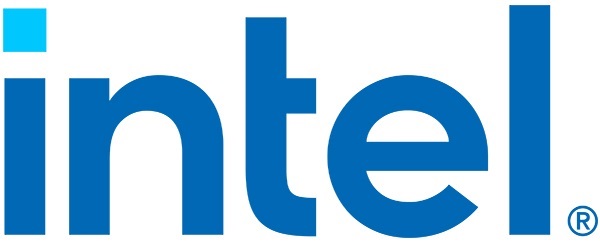

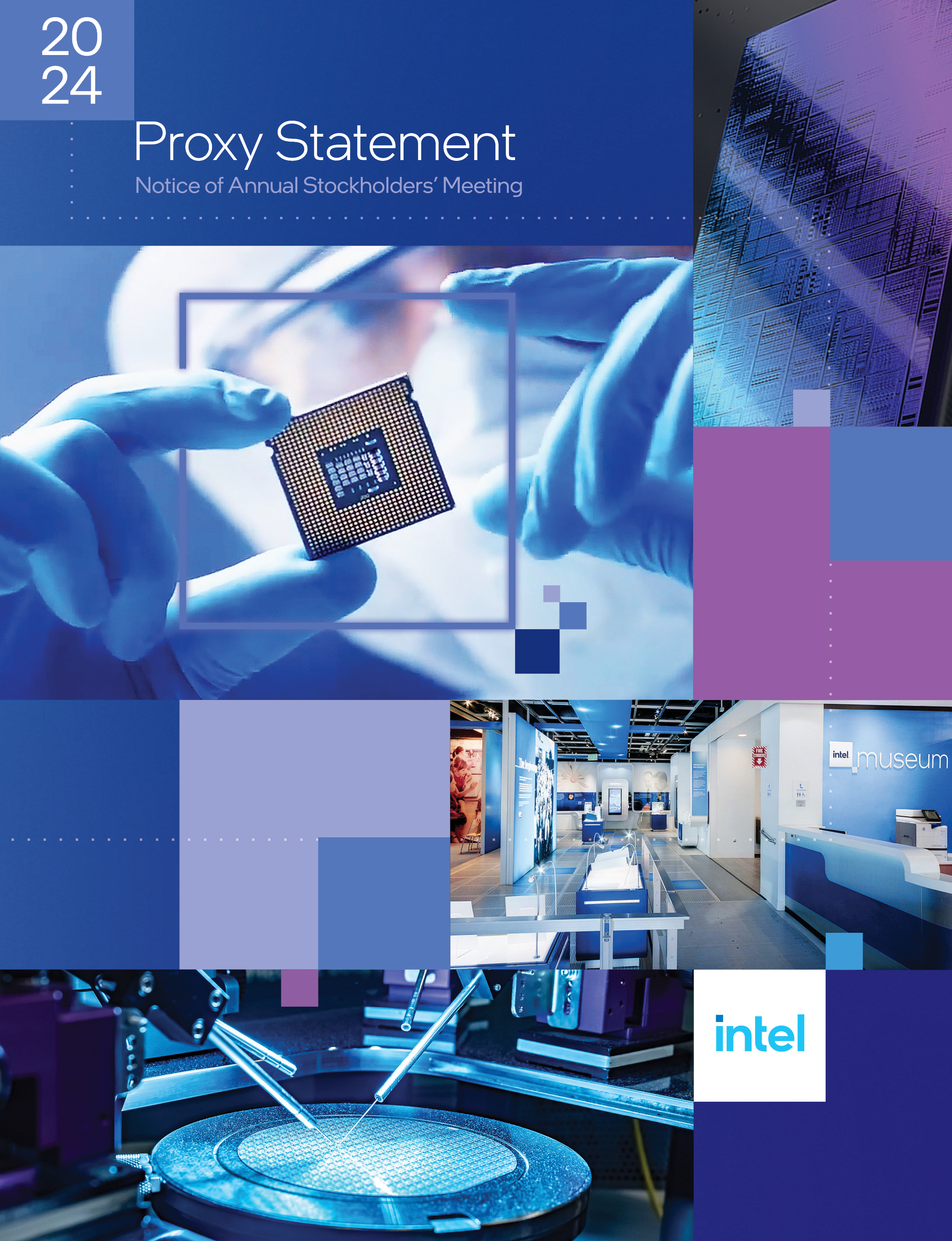
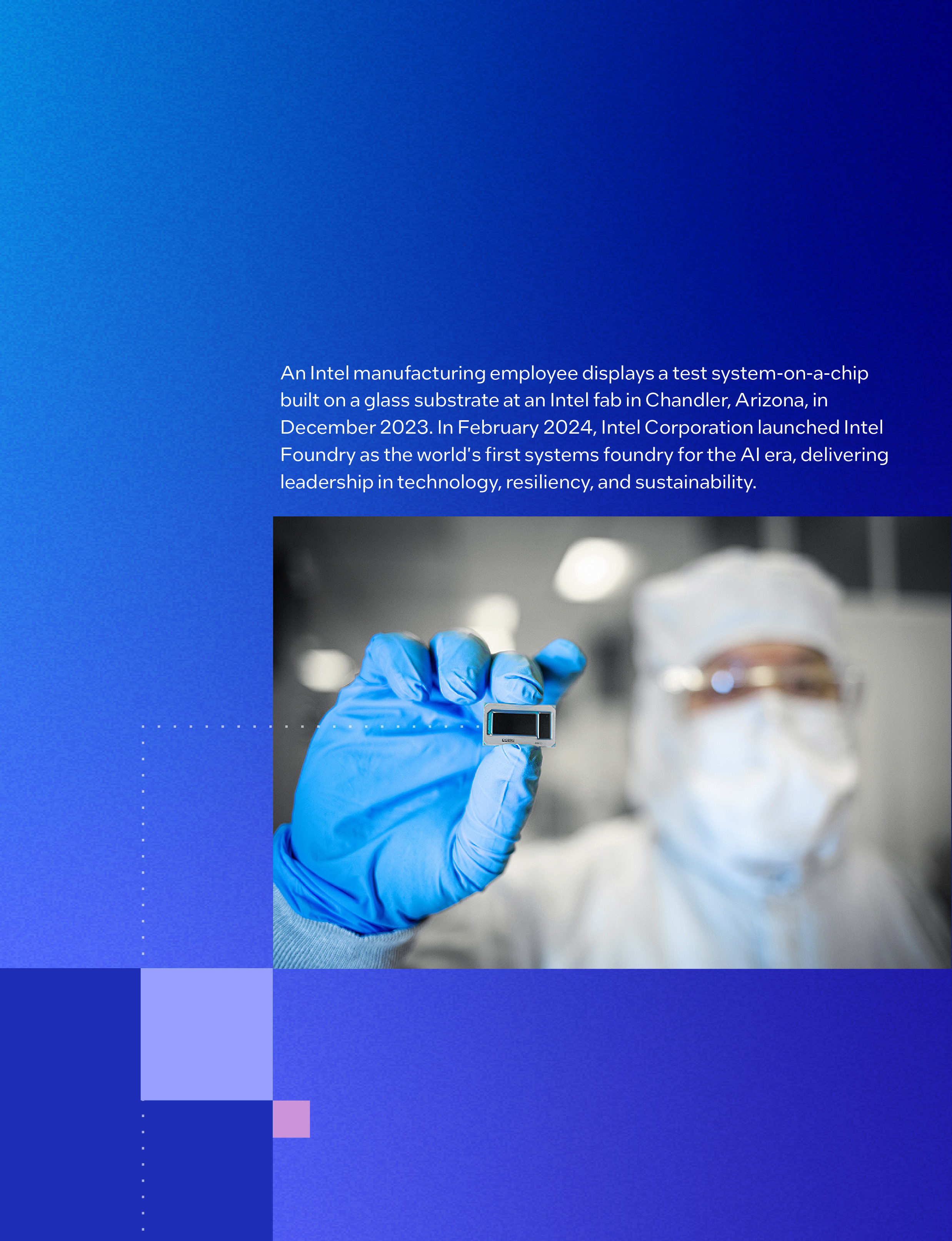



 Products
Products Foundry
Foundry














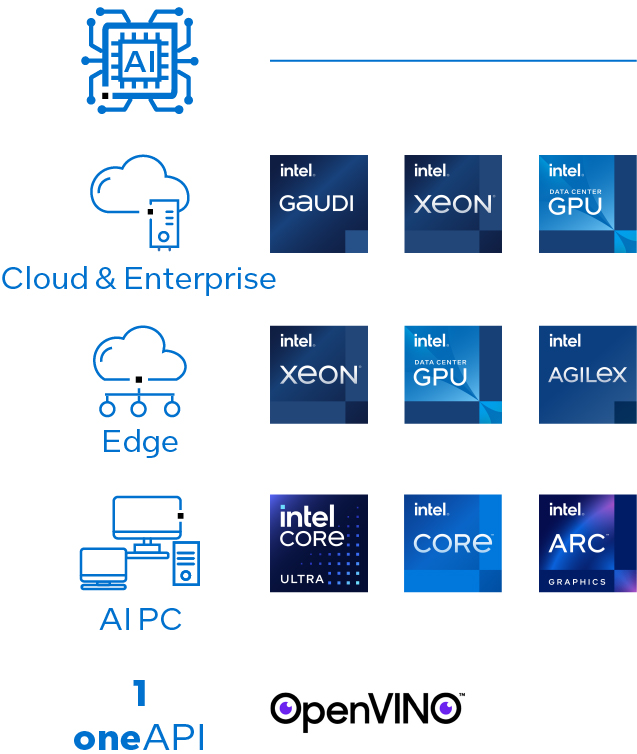


















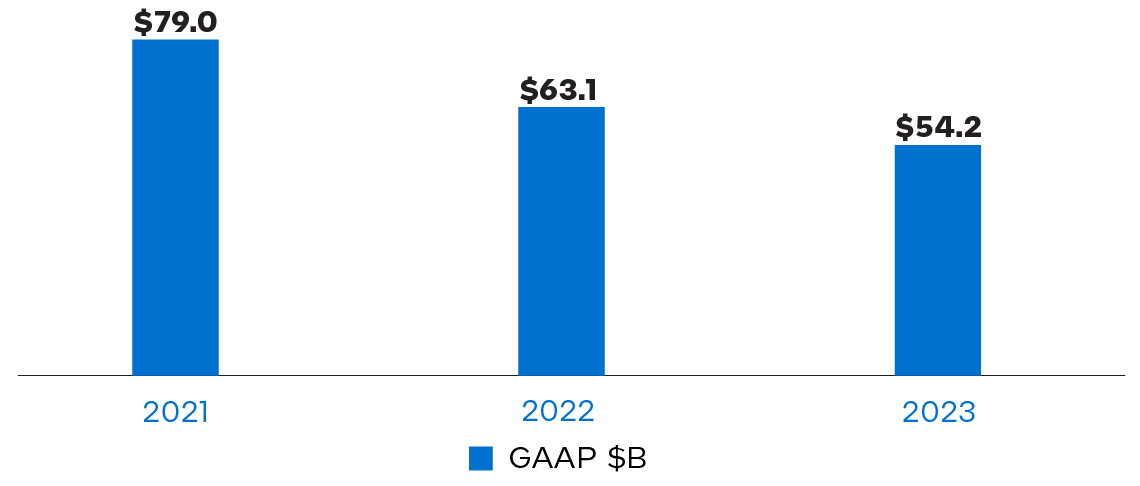
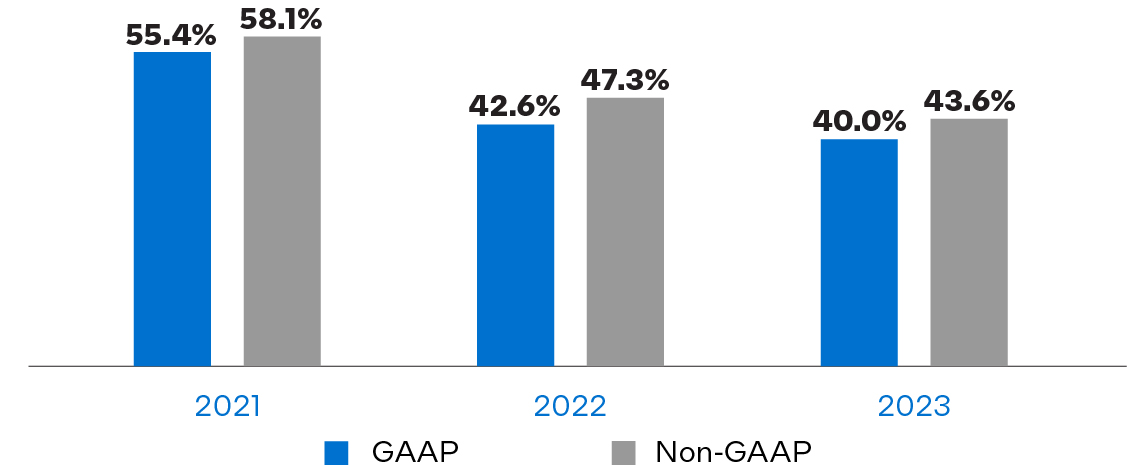
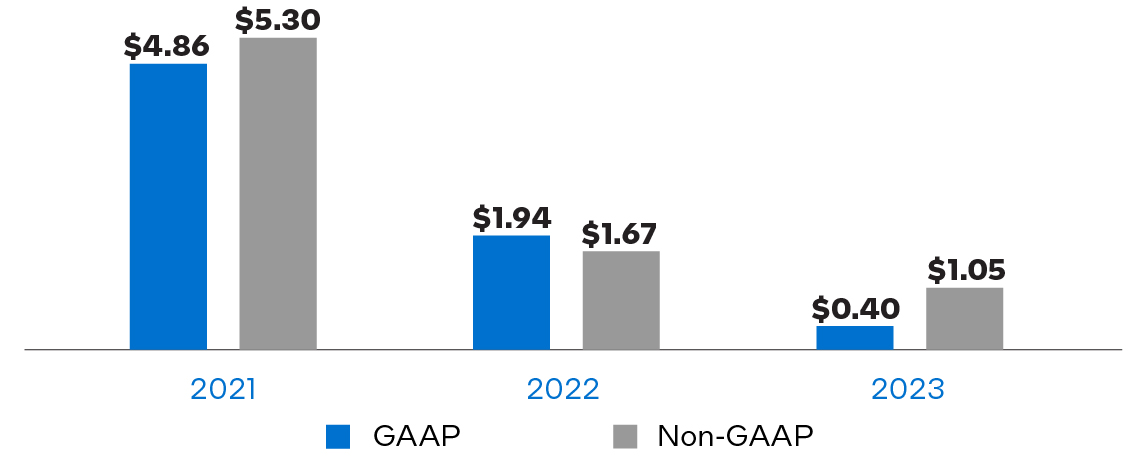
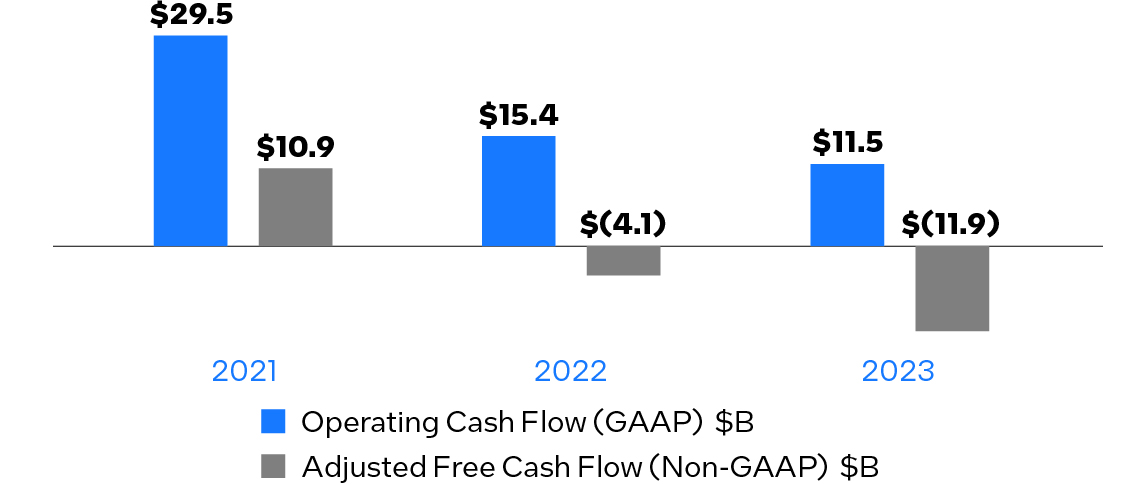













































































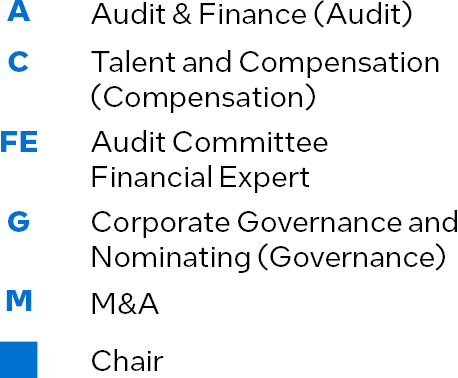
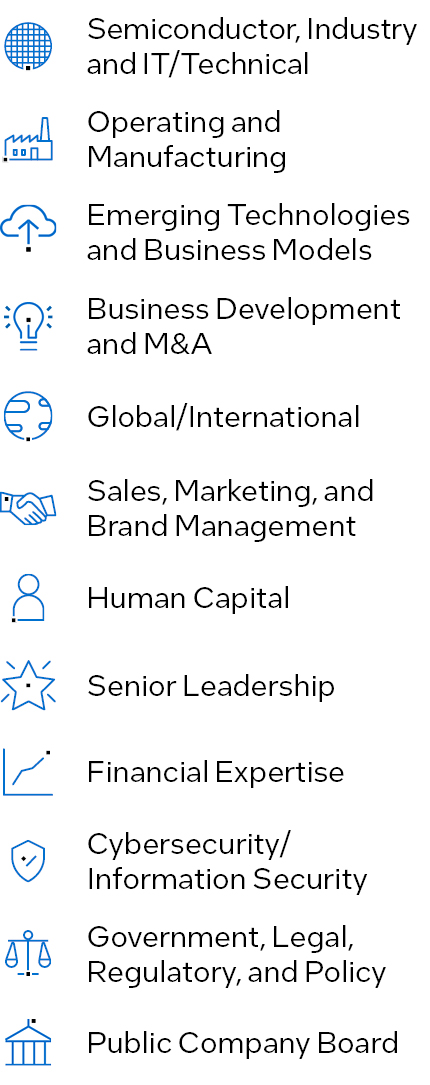








































































































































































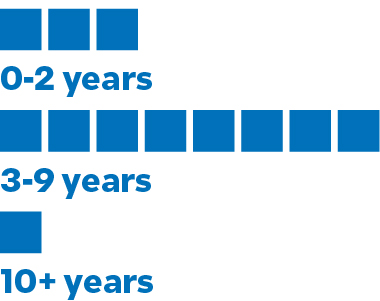







































































 Report annually and as needed to the Board and its committees
Report annually and as needed to the Board and its committees Develop mitigation plans for high-risk items
Develop mitigation plans for high-risk items Incorporate high-risk profiles into annual audit plan
Incorporate high-risk profiles into annual audit plan Disclose high-risk profiles as Risk Factors reported in the company’s Annual Report on Form 10-K
Disclose high-risk profiles as Risk Factors reported in the company’s Annual Report on Form 10-K




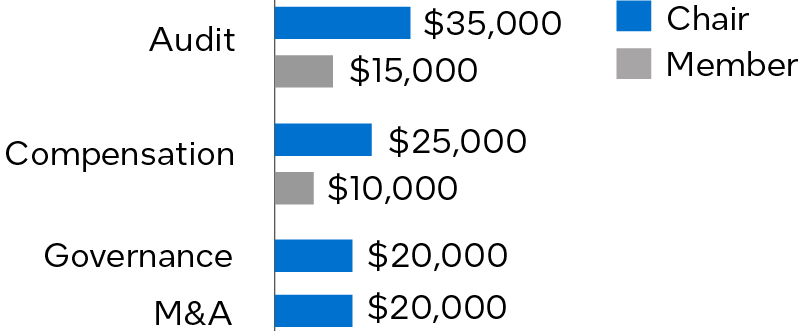


















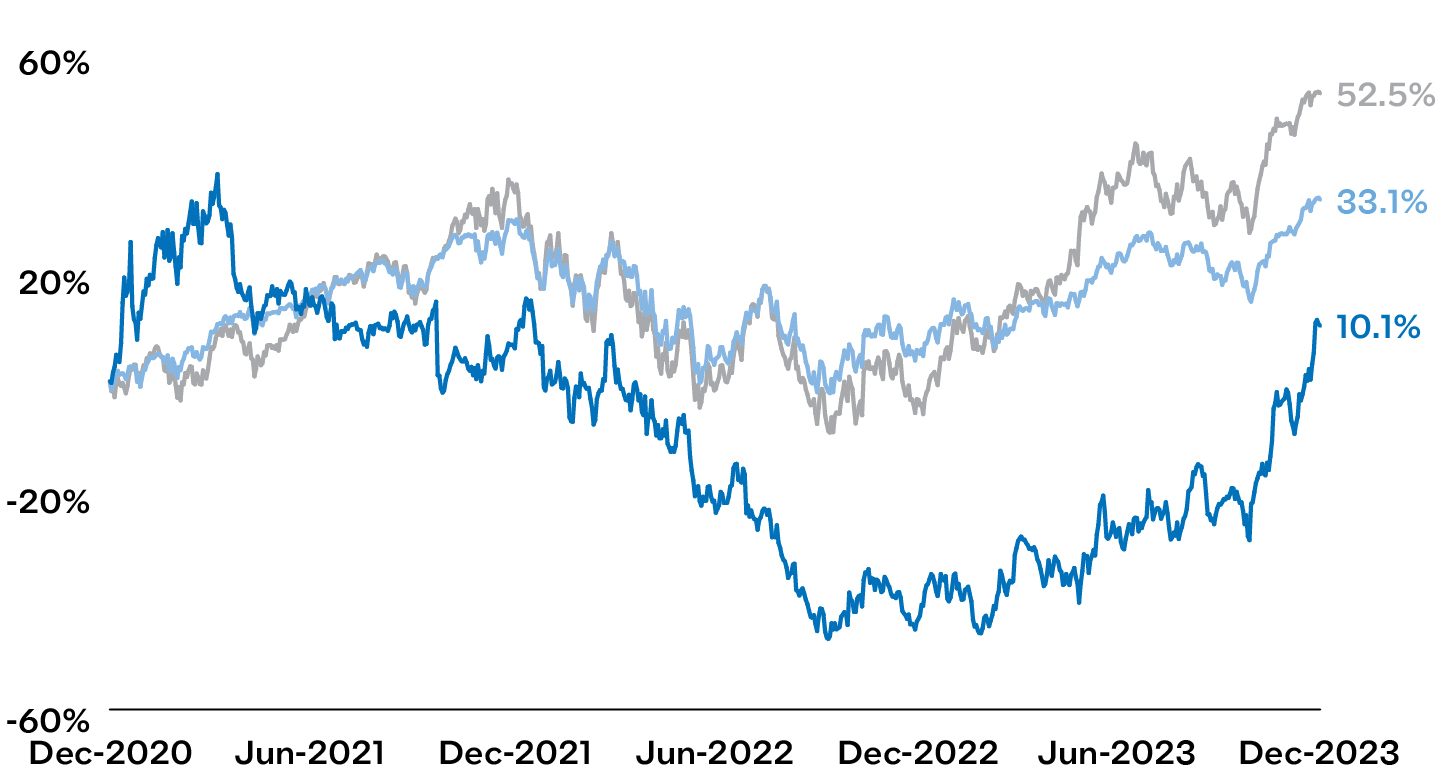
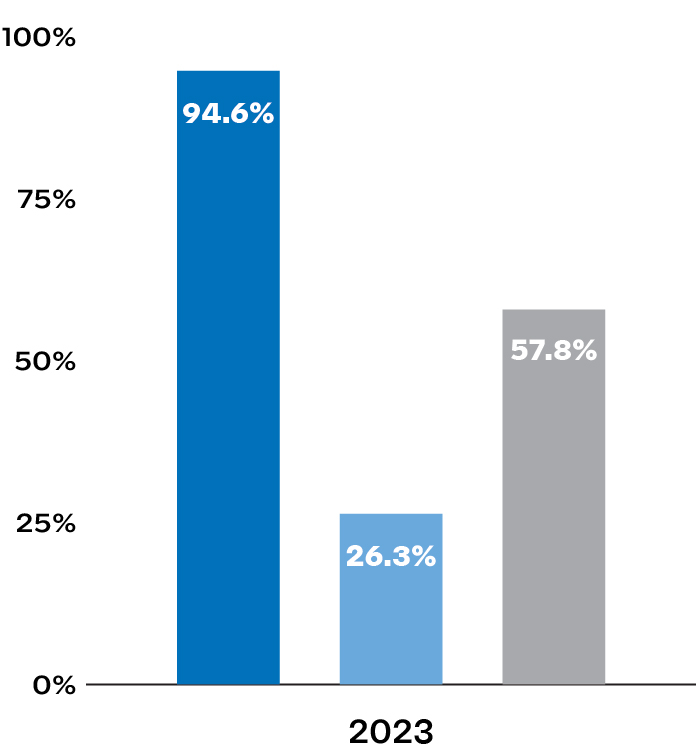




 We award performance-based compensation that uses a variety of performance measures and performance periods
We award performance-based compensation that uses a variety of performance measures and performance periods We have a substantial majority of executive pay “at risk,” based on a mix of absolute and relative financial, operational, and stock price performance metrics
We have a substantial majority of executive pay “at risk,” based on a mix of absolute and relative financial, operational, and stock price performance metrics We have robust stock ownership guidelines for all executive leadership team members
We have robust stock ownership guidelines for all executive leadership team members We have clawback policies that apply to our Annual Cash Bonus Plan, equity incentive plans, and other incentive compensation and forfeiture provisions that can be triggered by certain detrimental conduct
We have clawback policies that apply to our Annual Cash Bonus Plan, equity incentive plans, and other incentive compensation and forfeiture provisions that can be triggered by certain detrimental conduct We conduct an annual Say-on-Pay vote and frequent votes on our 2006 Equity Incentive Plan
We conduct an annual Say-on-Pay vote and frequent votes on our 2006 Equity Incentive Plan  We require stockholder approval for any cash severance payments to executive officers in excess of 2.99 times base salary plus target bonus opportunity
We require stockholder approval for any cash severance payments to executive officers in excess of 2.99 times base salary plus target bonus opportunity  We conduct comprehensive and regular stockholder engagement
We conduct comprehensive and regular stockholder engagement We impose limits on maximum incentive award payouts
We impose limits on maximum incentive award payouts We incorporate relevant corporate social responsibility metrics in our executive compensation program
We incorporate relevant corporate social responsibility metrics in our executive compensation program No change in control compensation arrangements or excise tax gross-ups
No change in control compensation arrangements or excise tax gross-ups No perquisite-related tax gross-ups for executive officers (except for company-wide benefits such as reimbursement of relocation and housing costs)
No perquisite-related tax gross-ups for executive officers (except for company-wide benefits such as reimbursement of relocation and housing costs) No hedging or pledging of Intel common stock by executives or directors
No hedging or pledging of Intel common stock by executives or directors No special retirement plans exclusively for executive officers
No special retirement plans exclusively for executive officers No liberal share recycling under the equity incentive plans
No liberal share recycling under the equity incentive plans No repricing or exchange of underwater stock options without stockholder approval
No repricing or exchange of underwater stock options without stockholder approval No excessive executive perquisites
No excessive executive perquisites


























